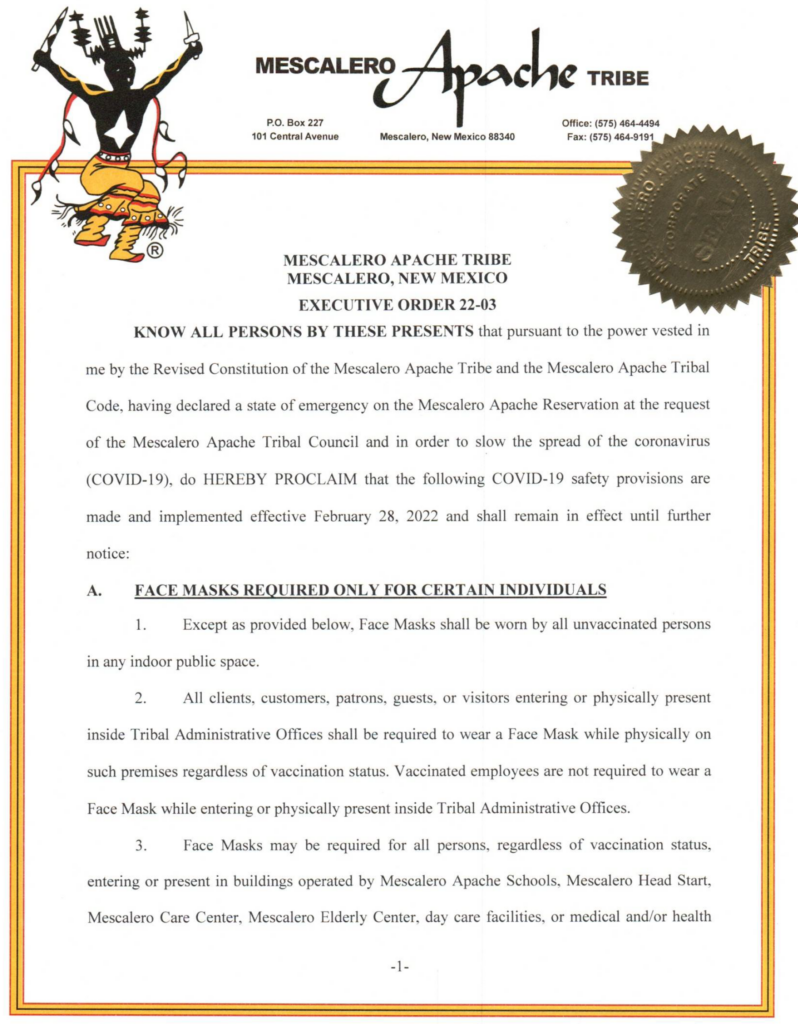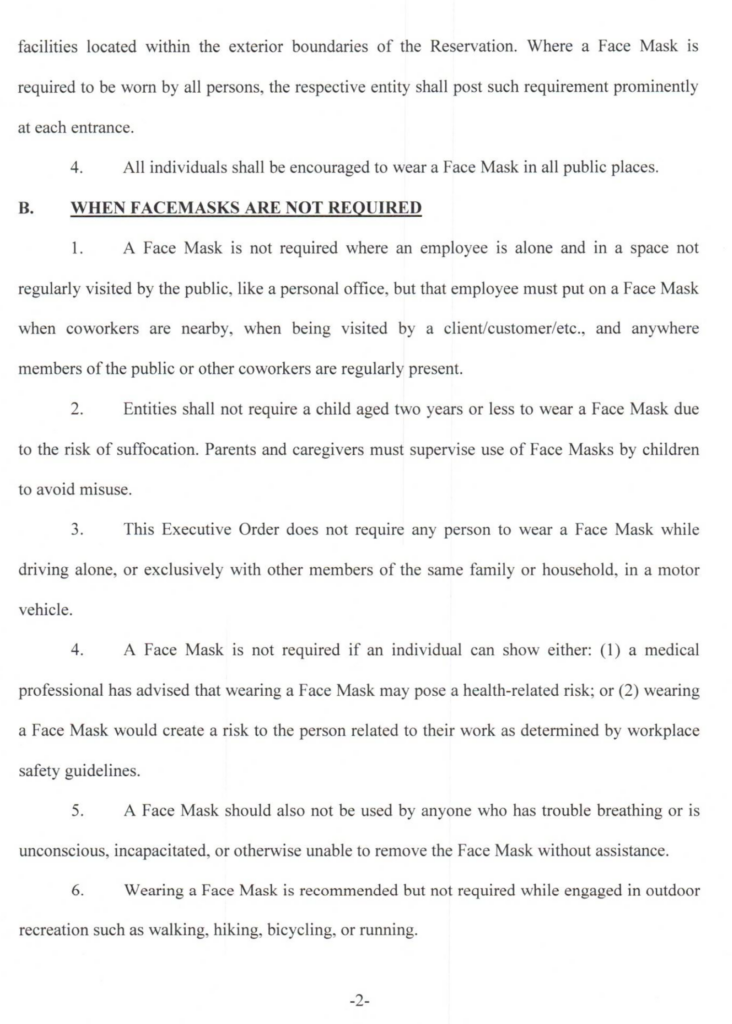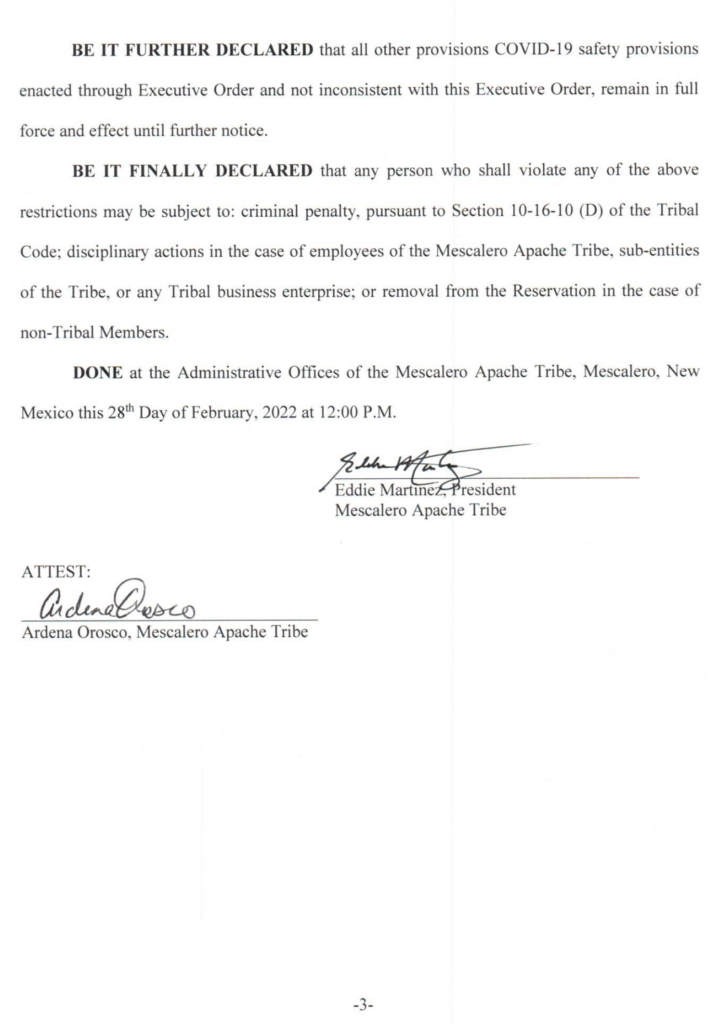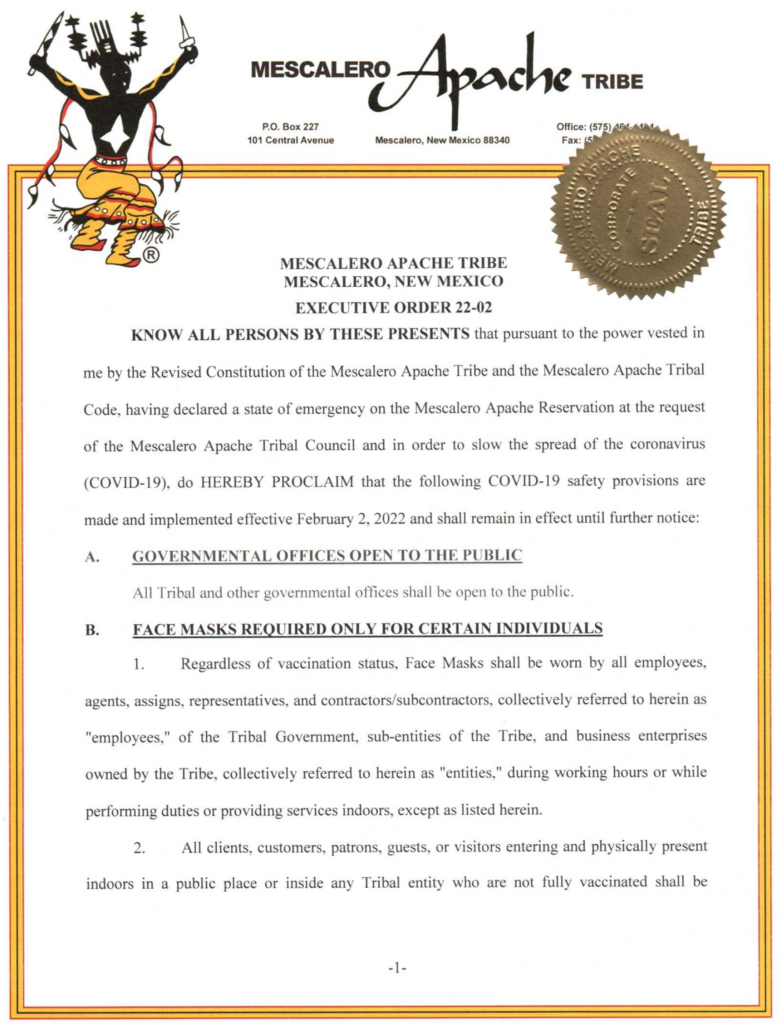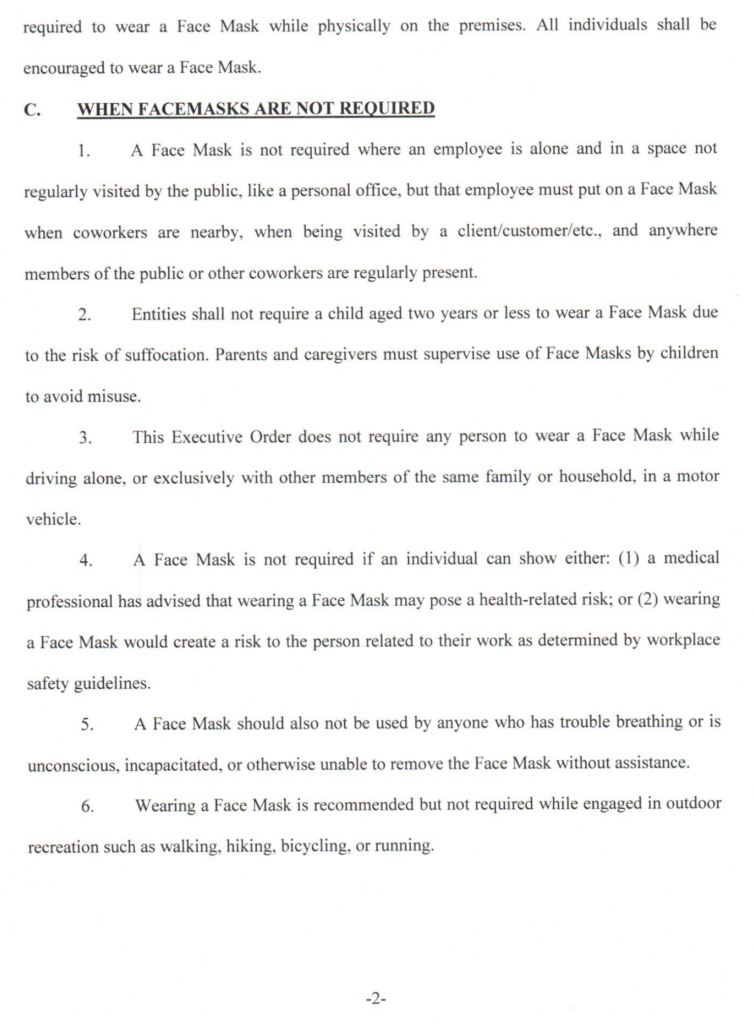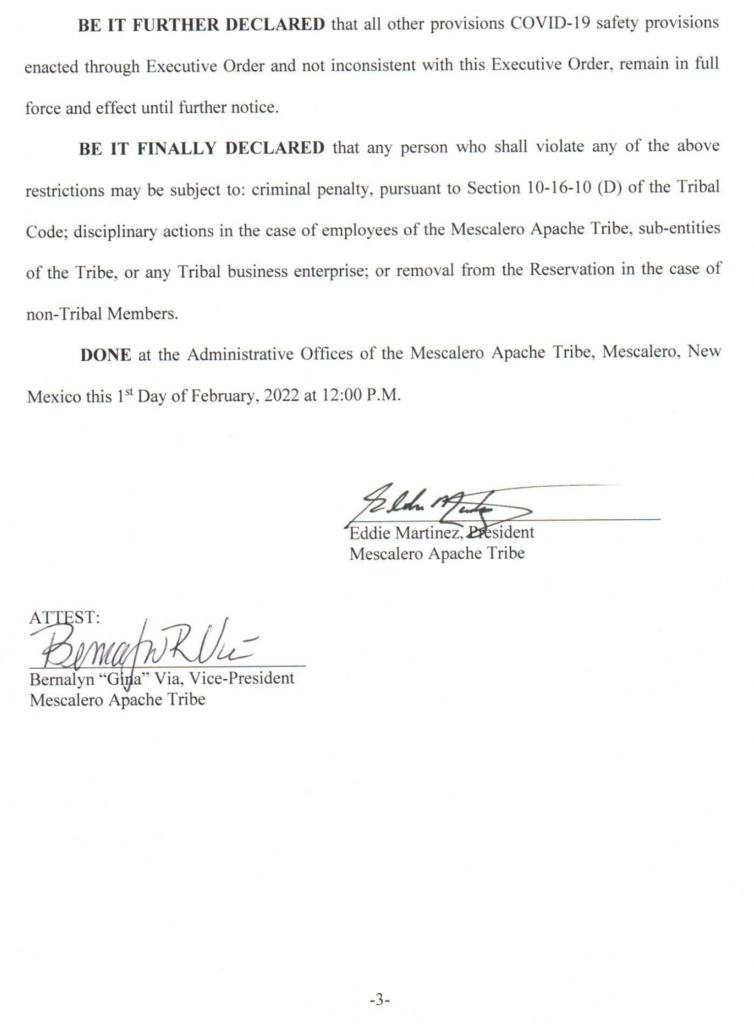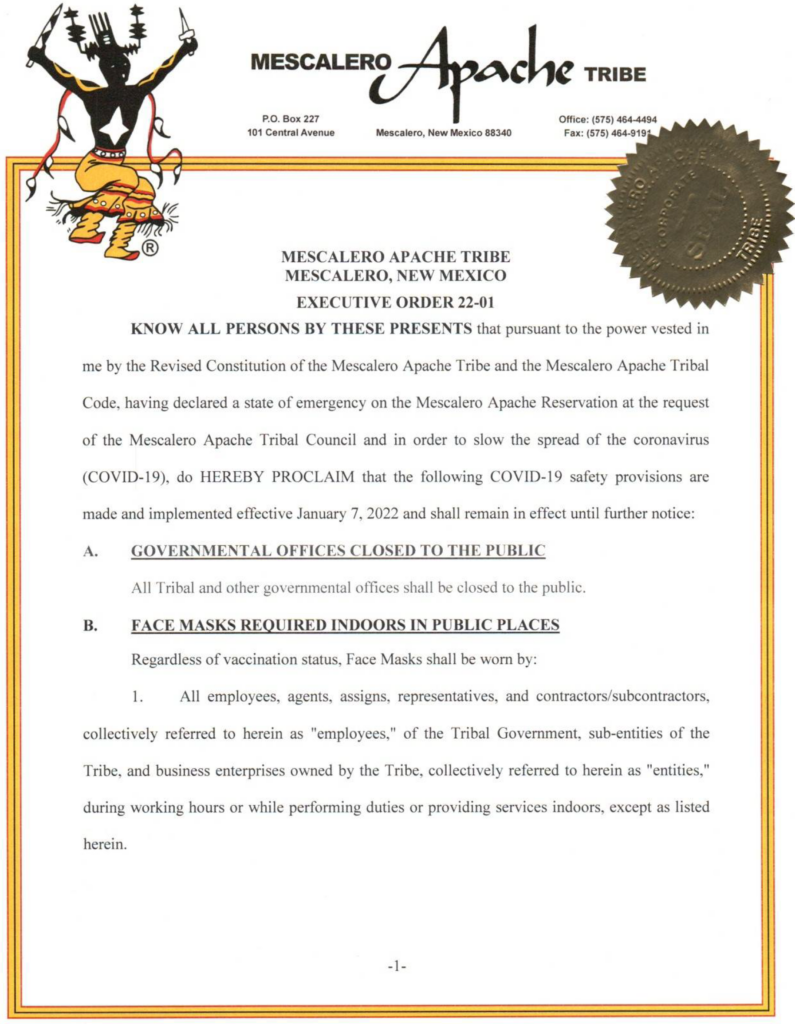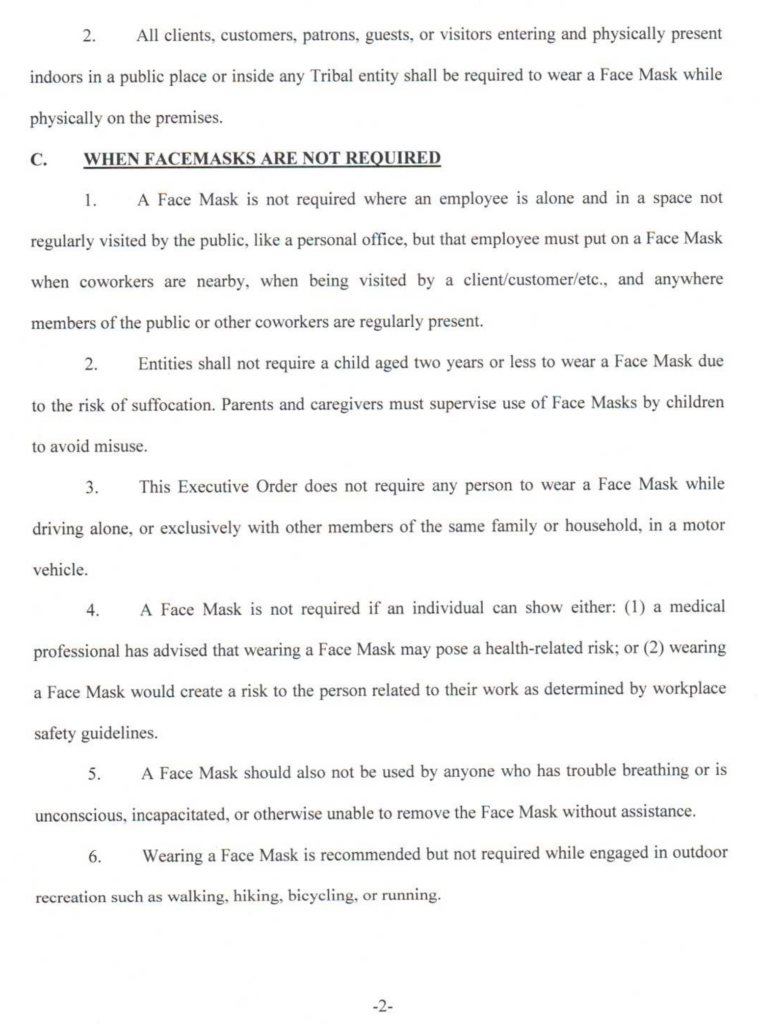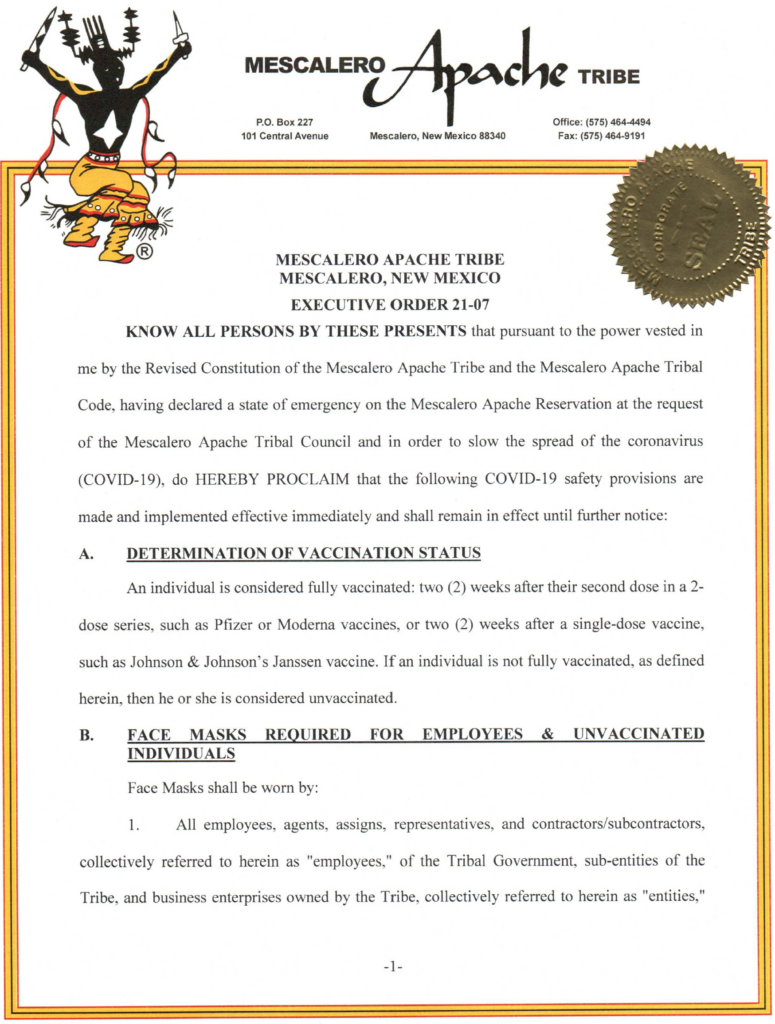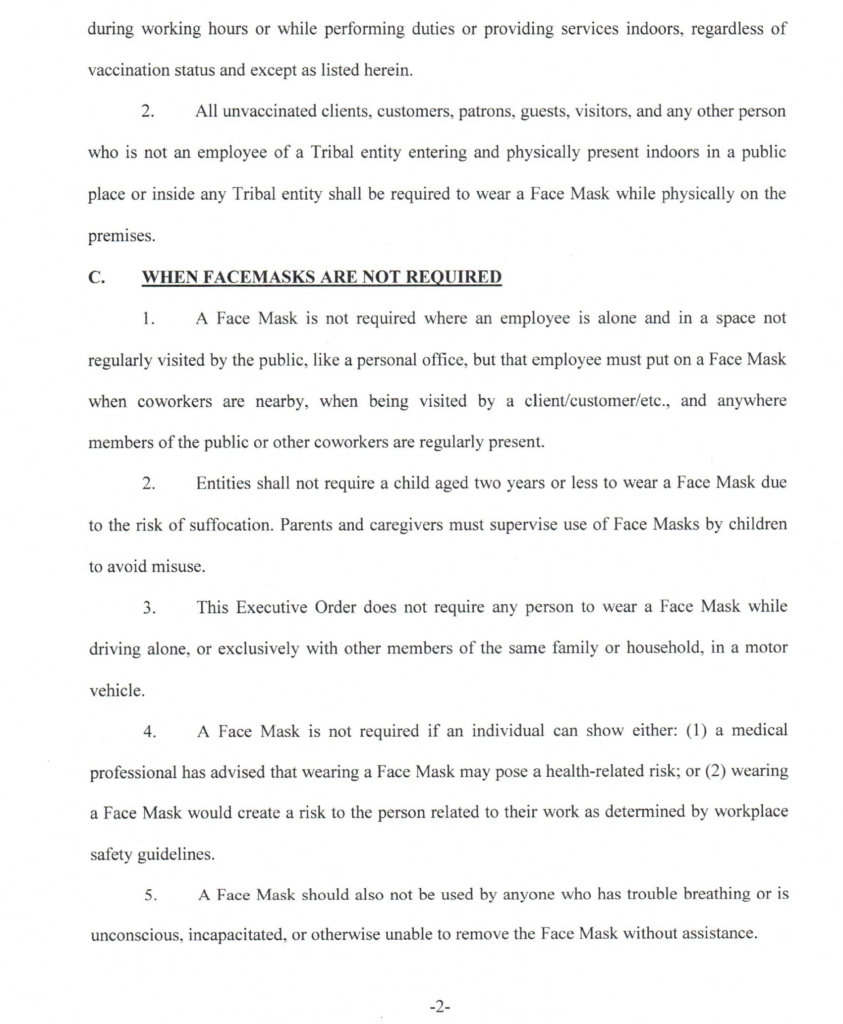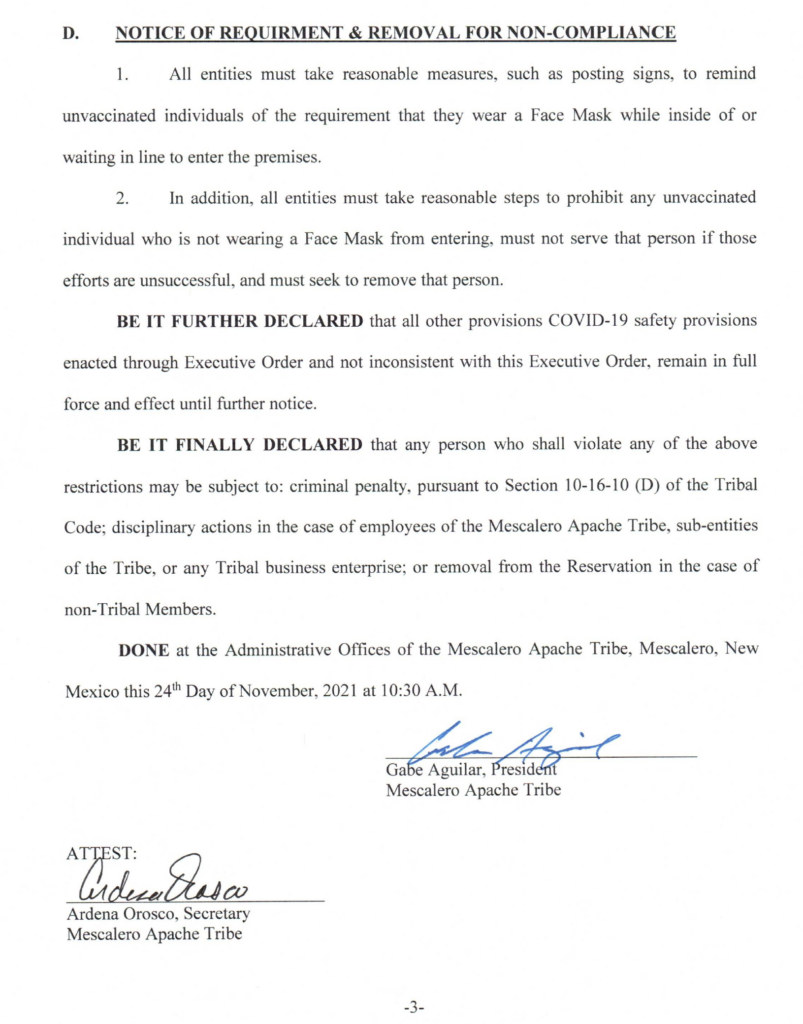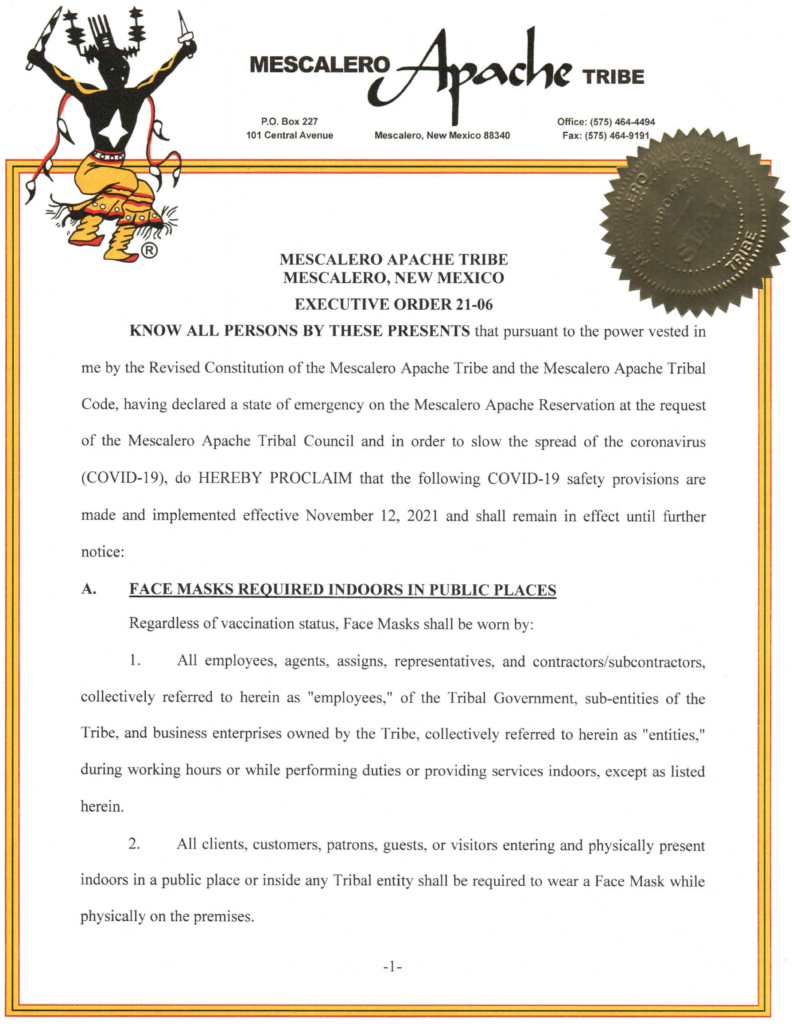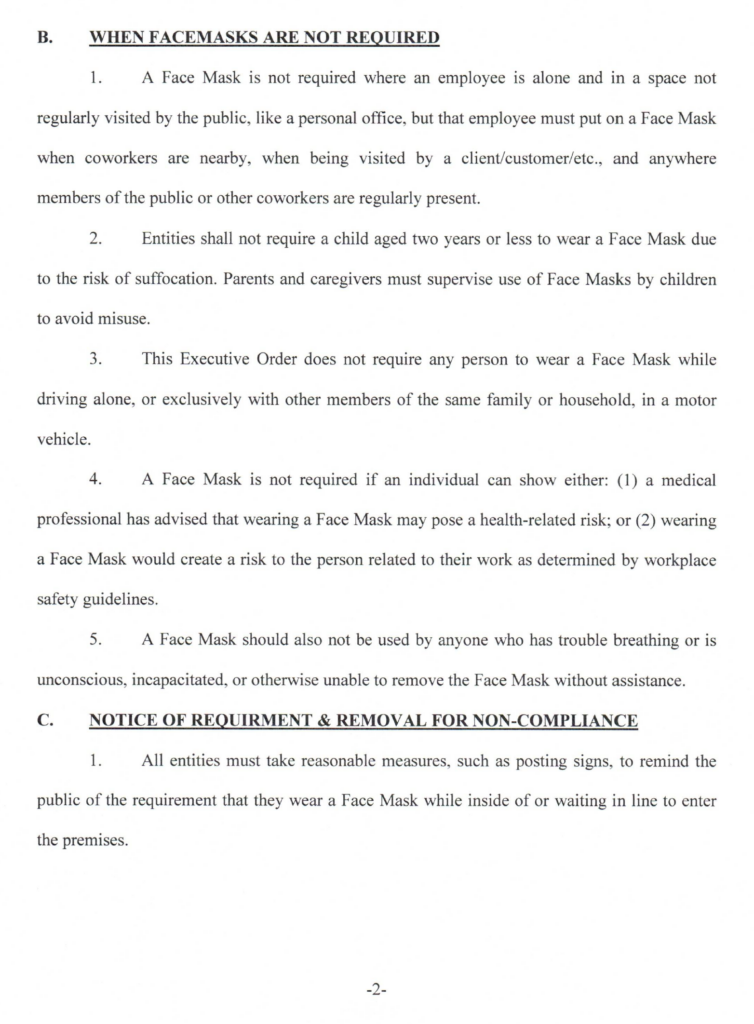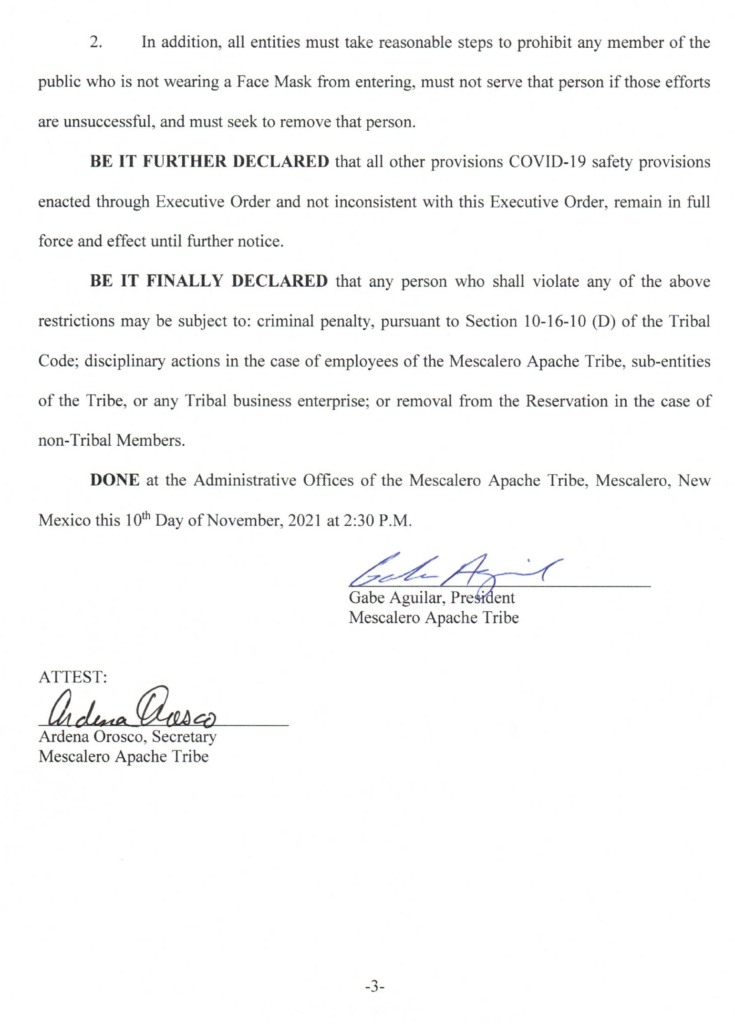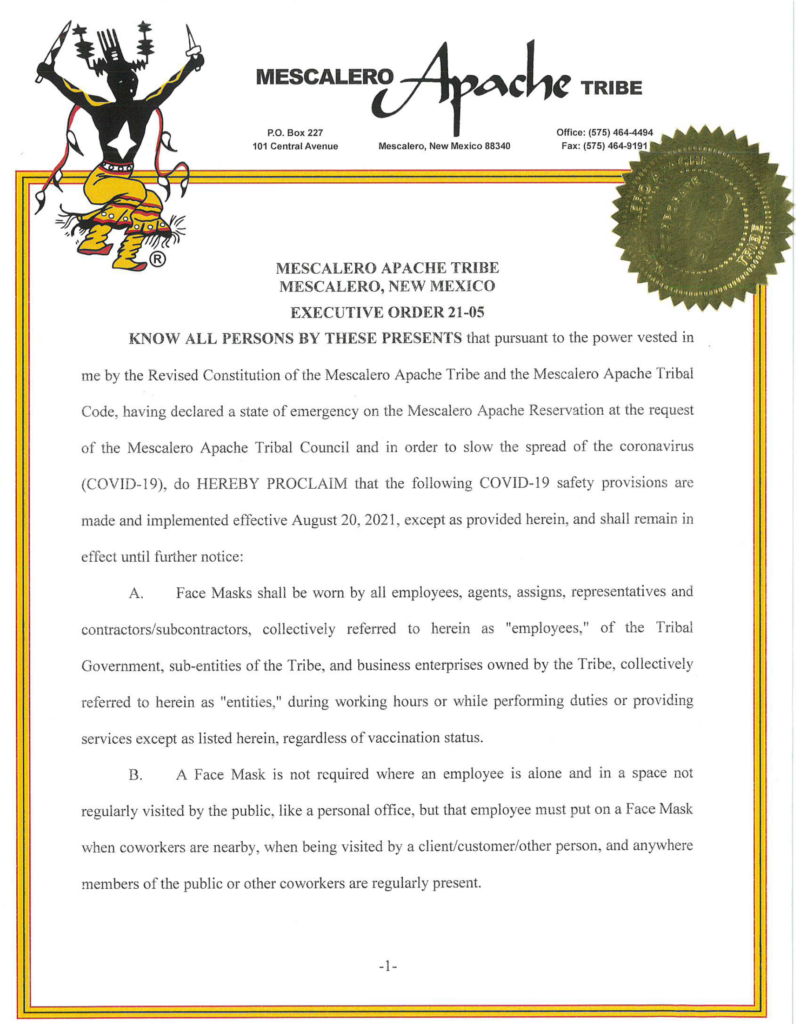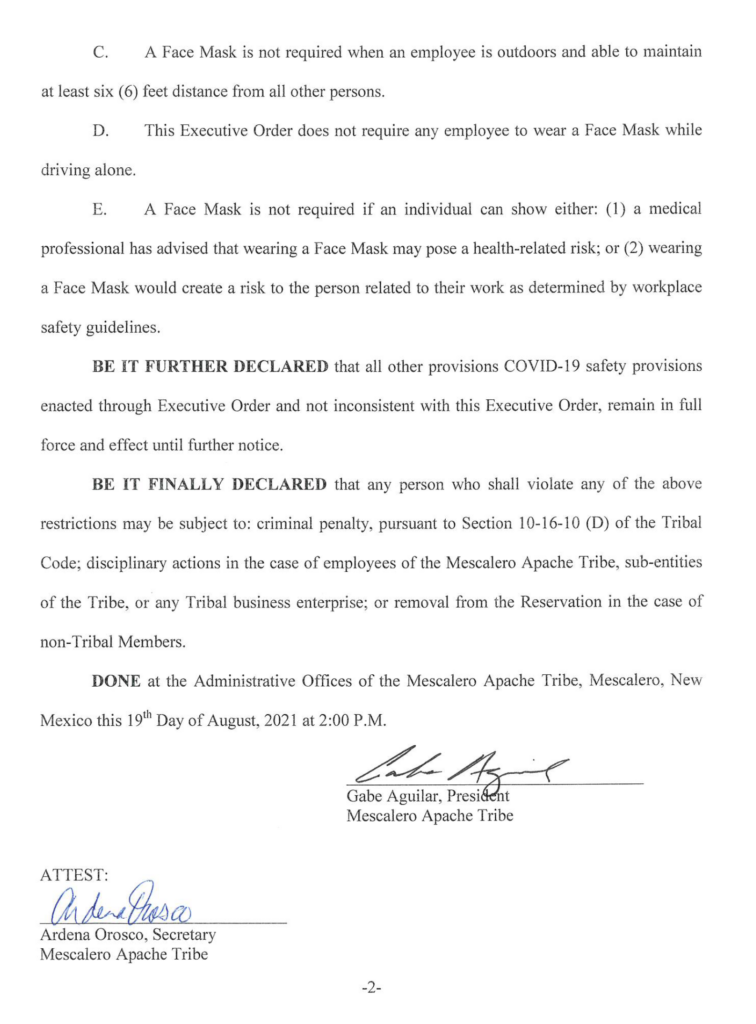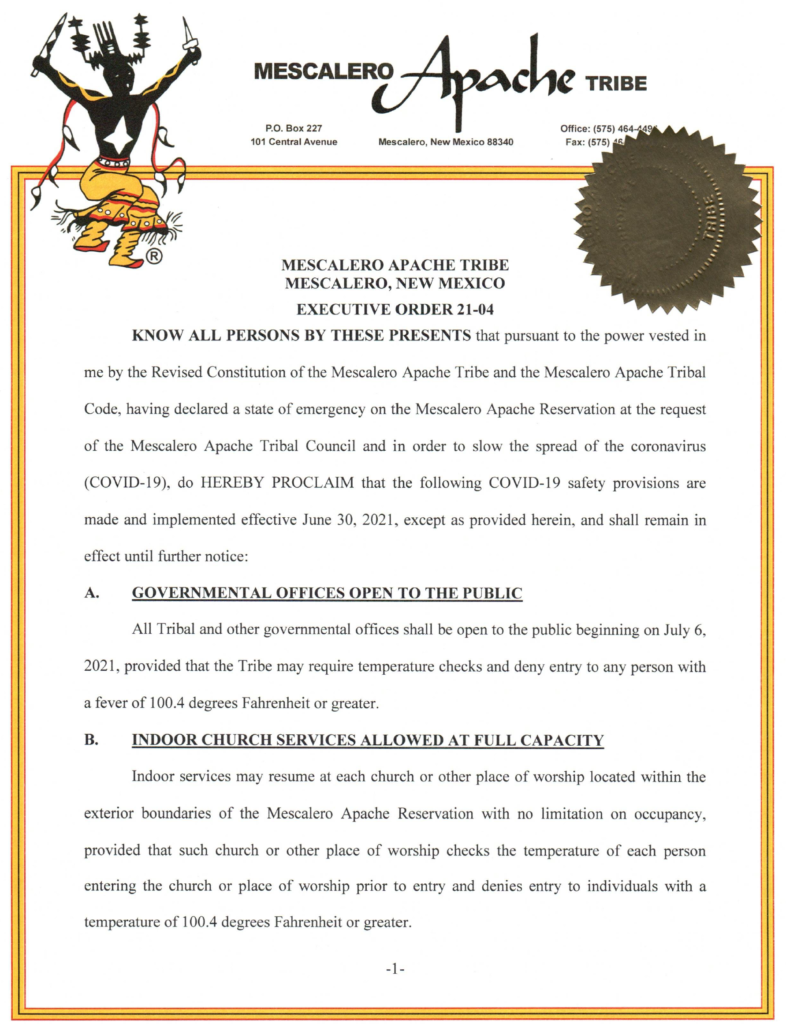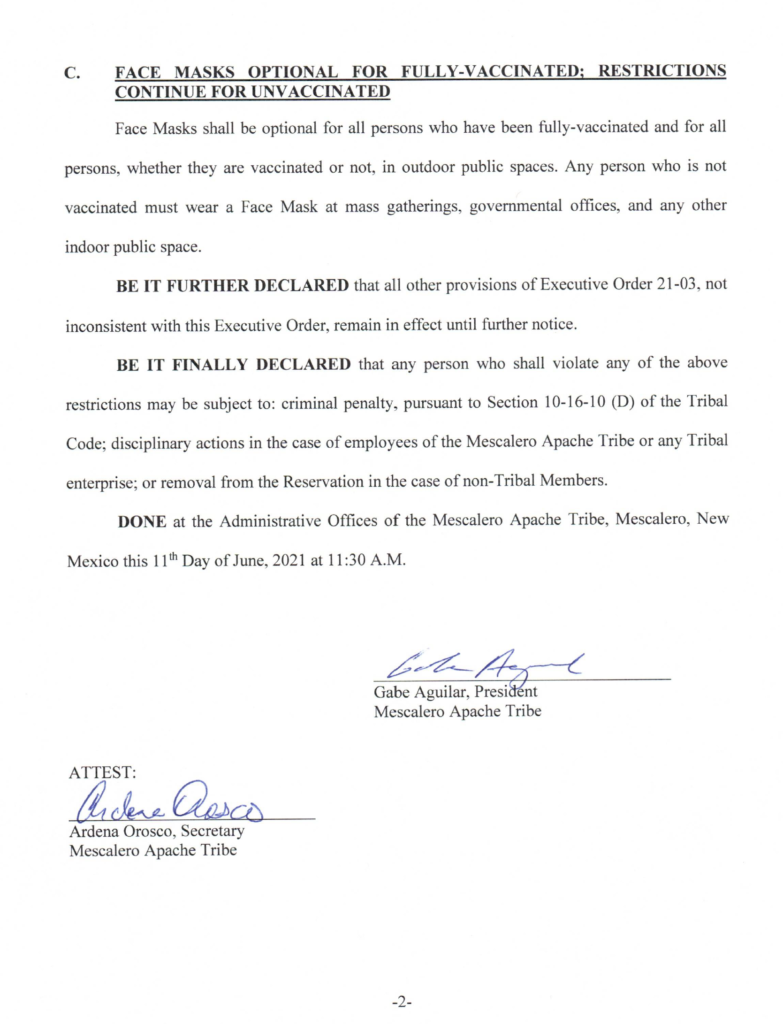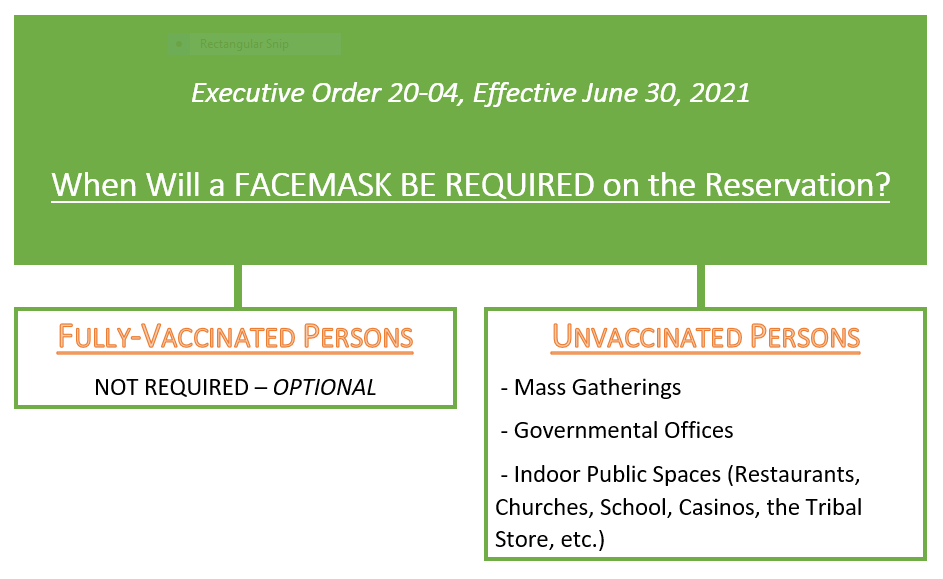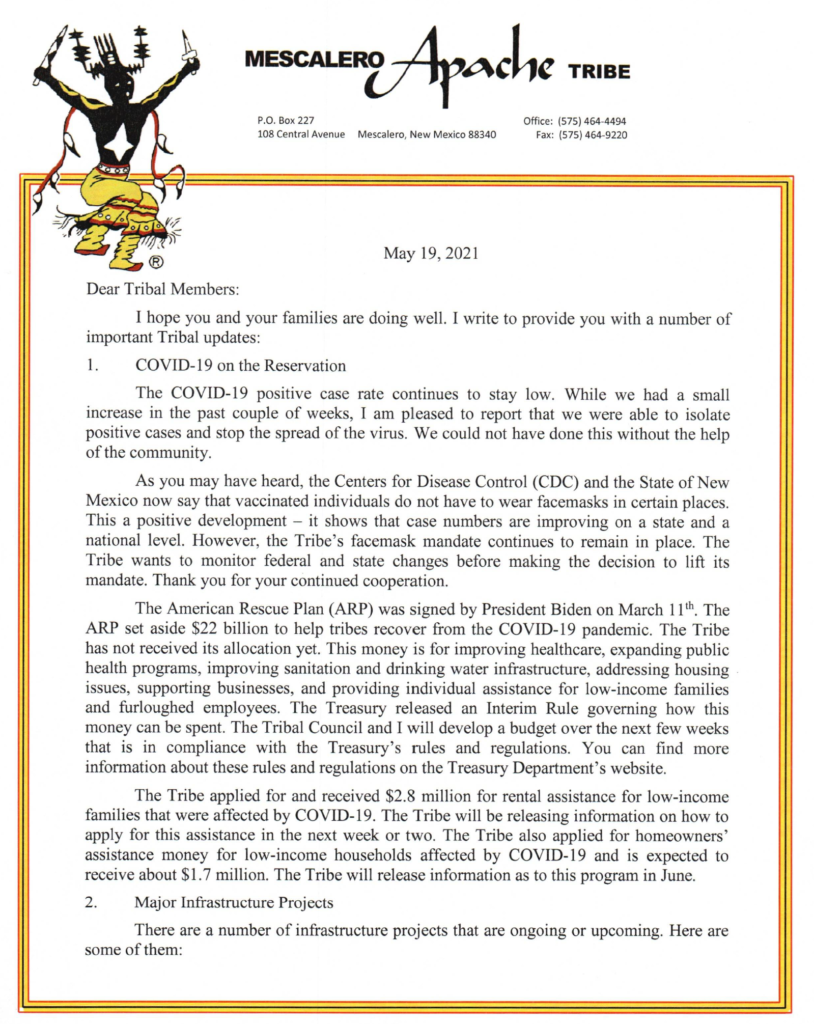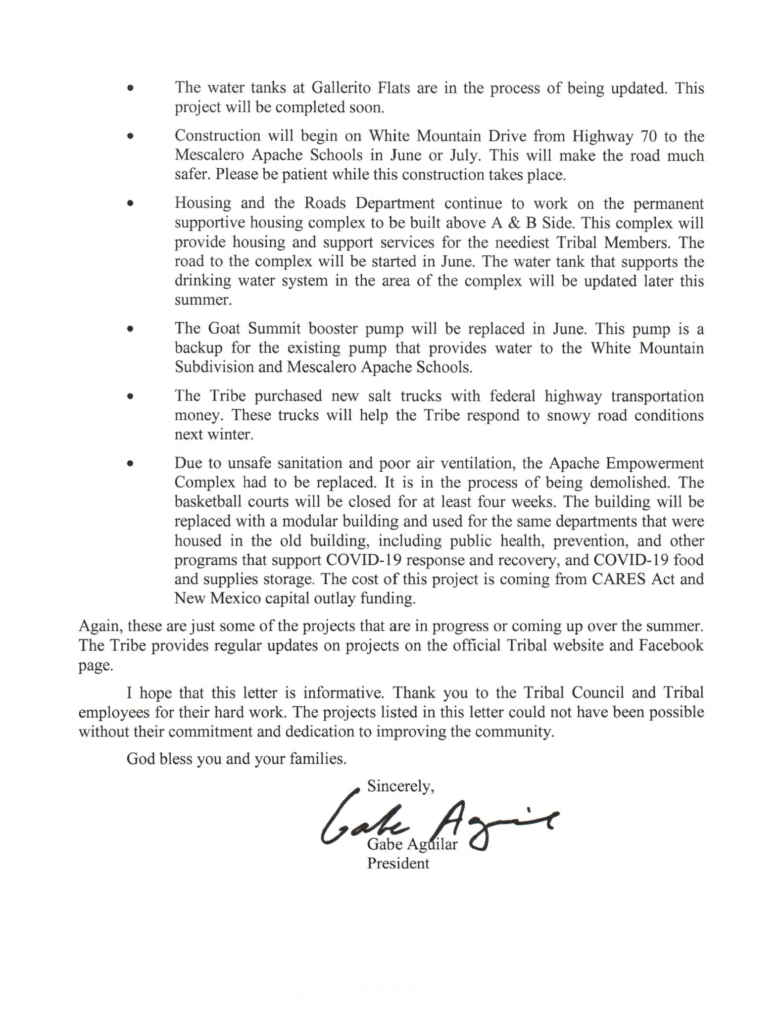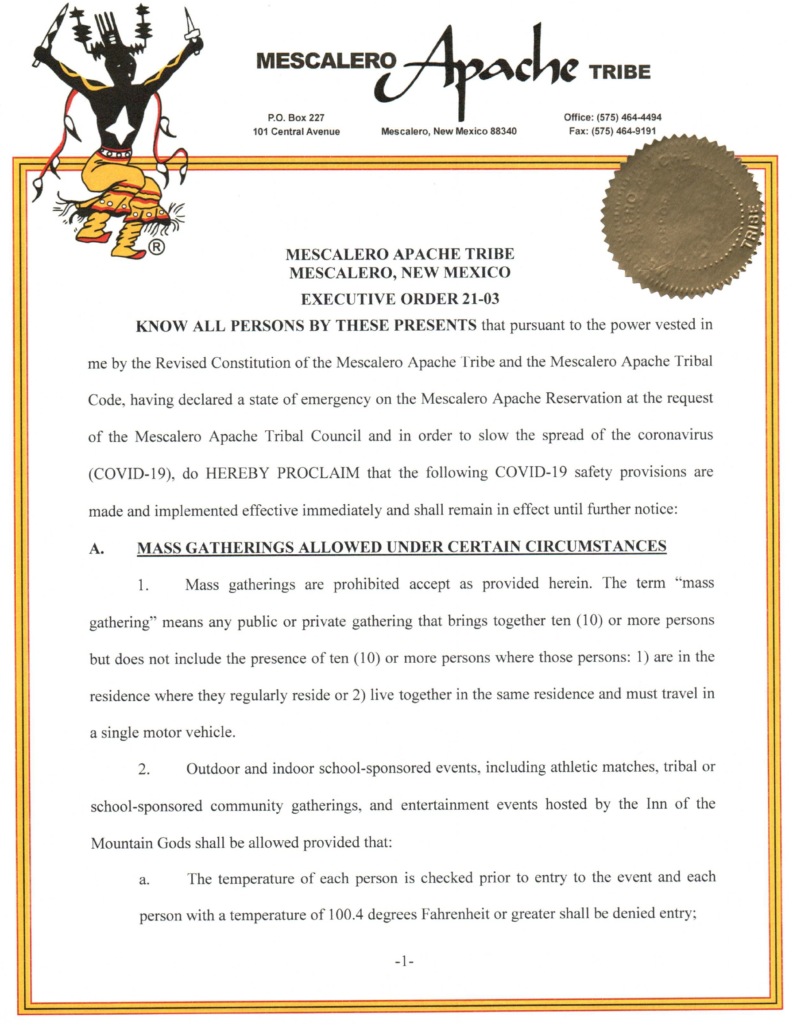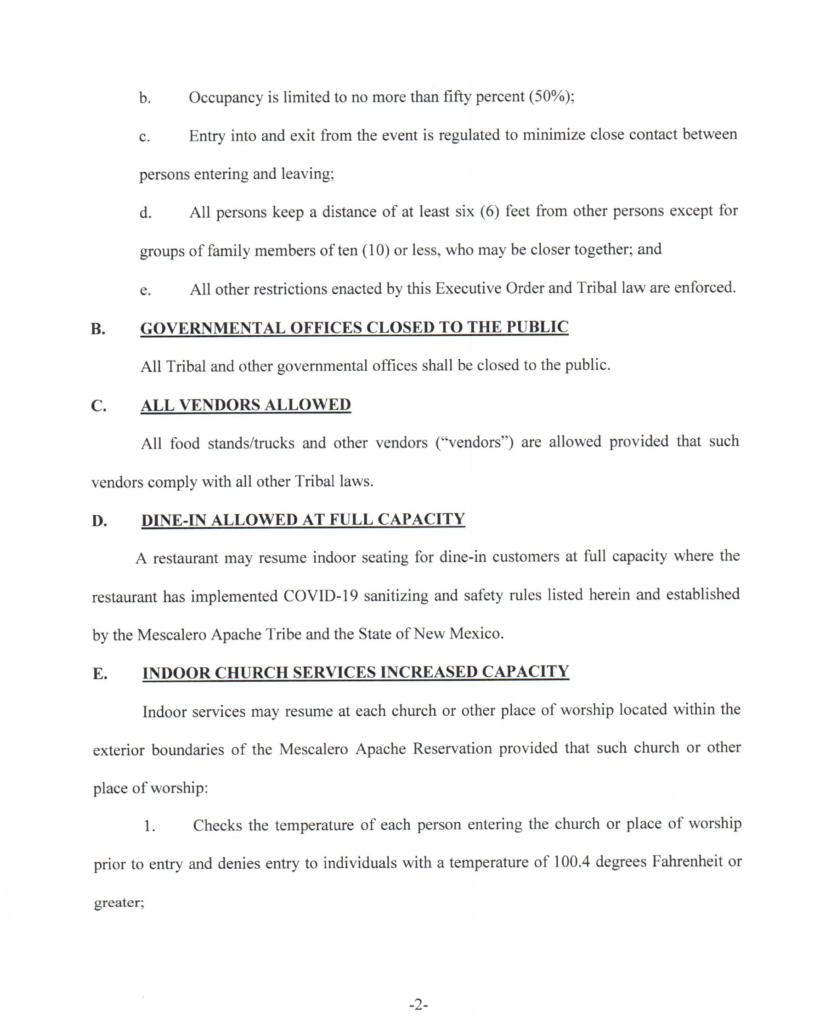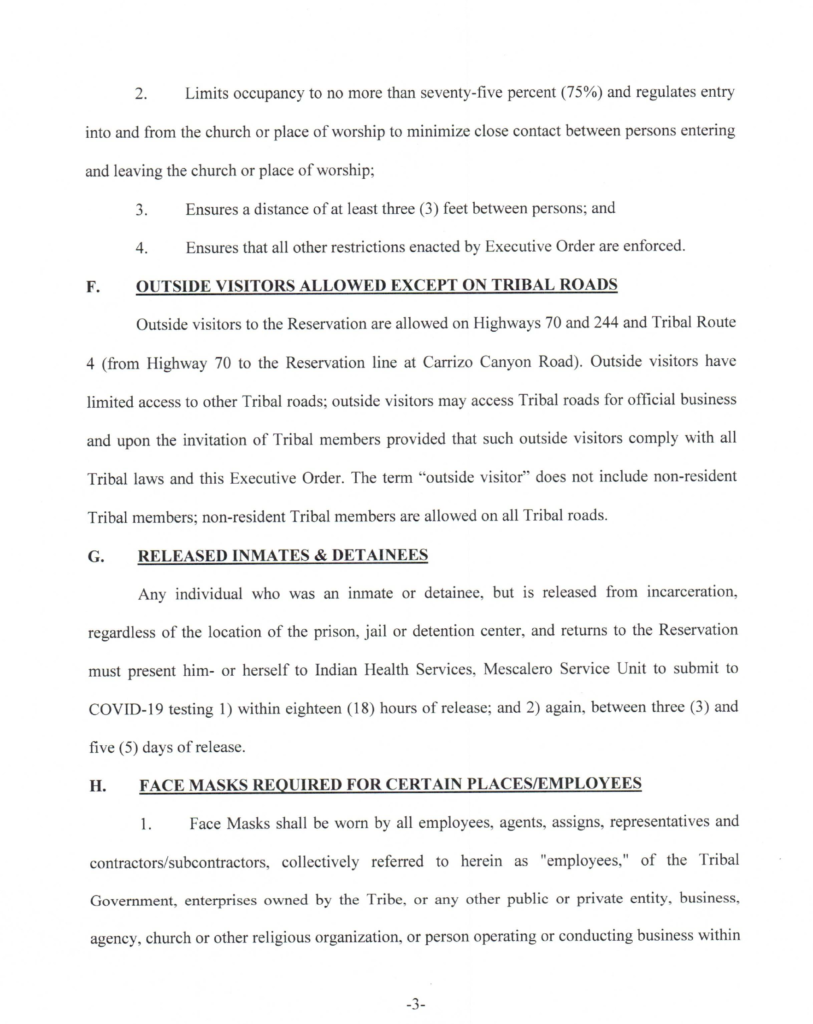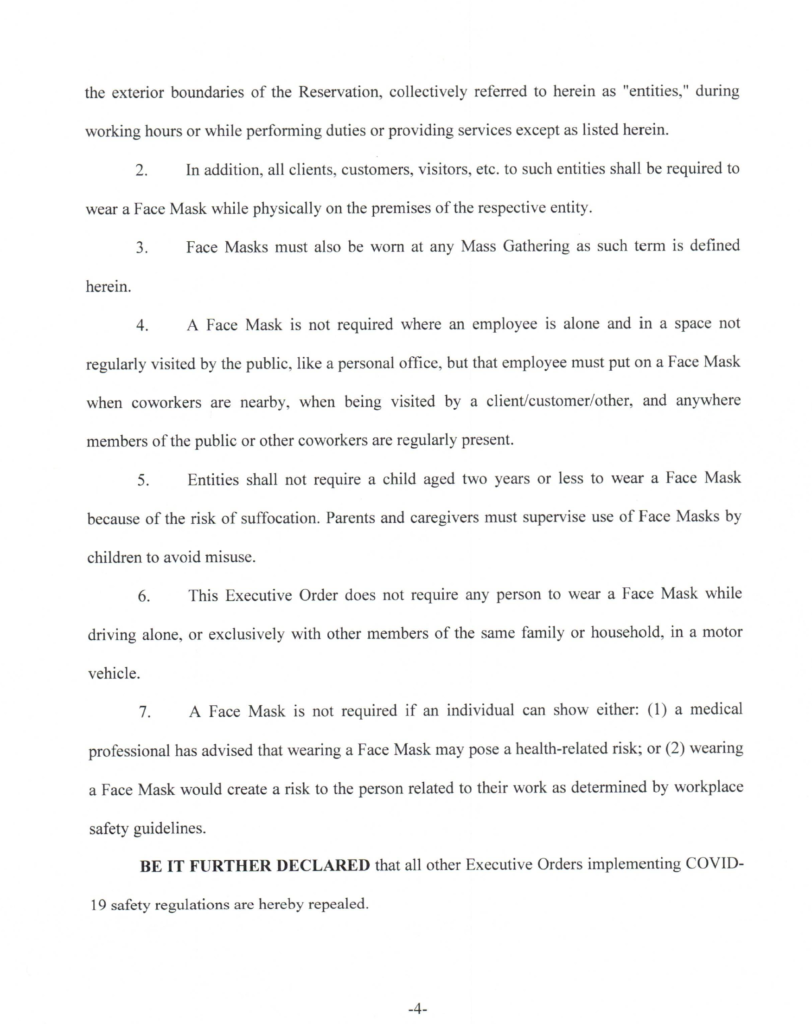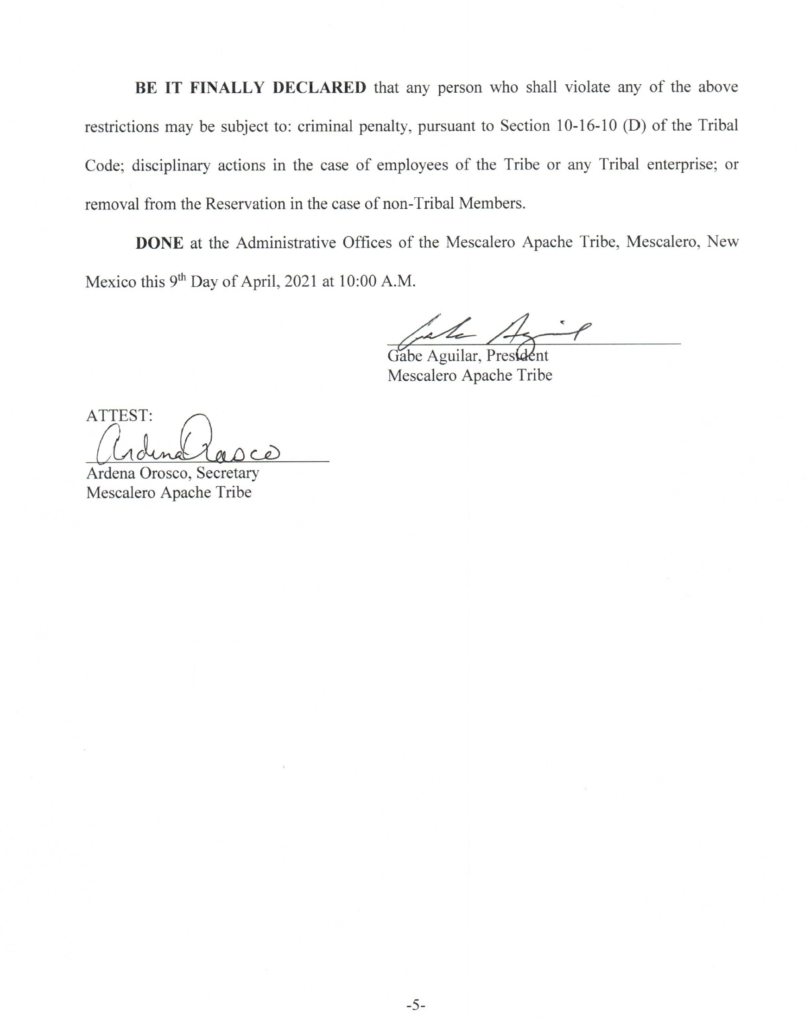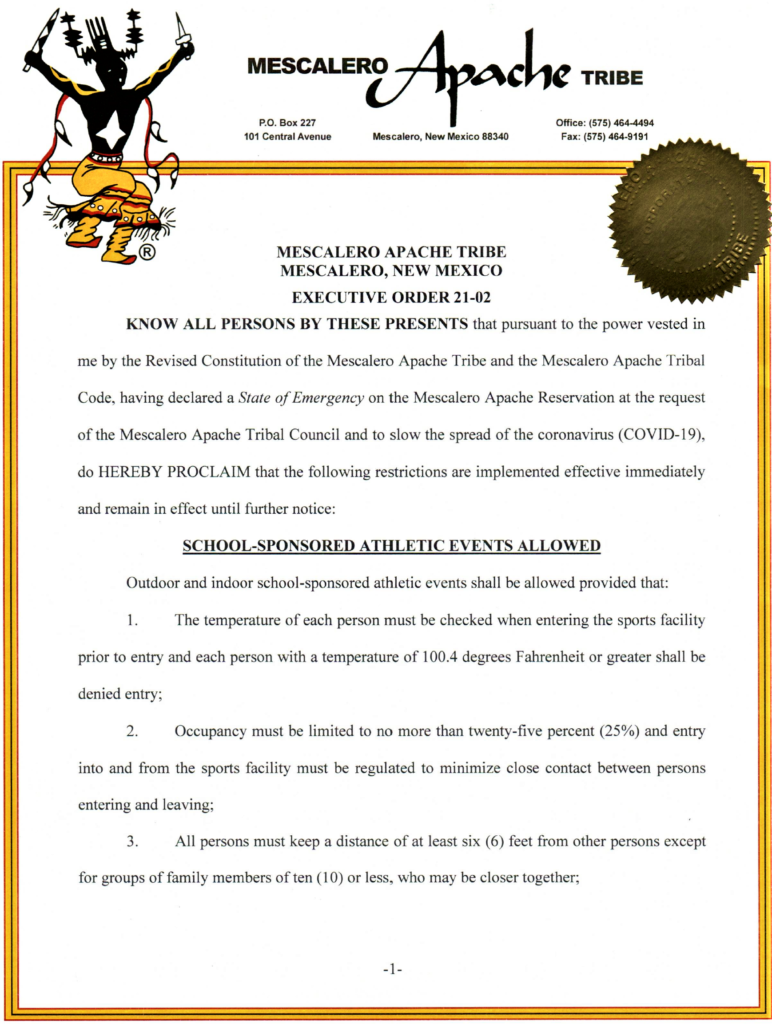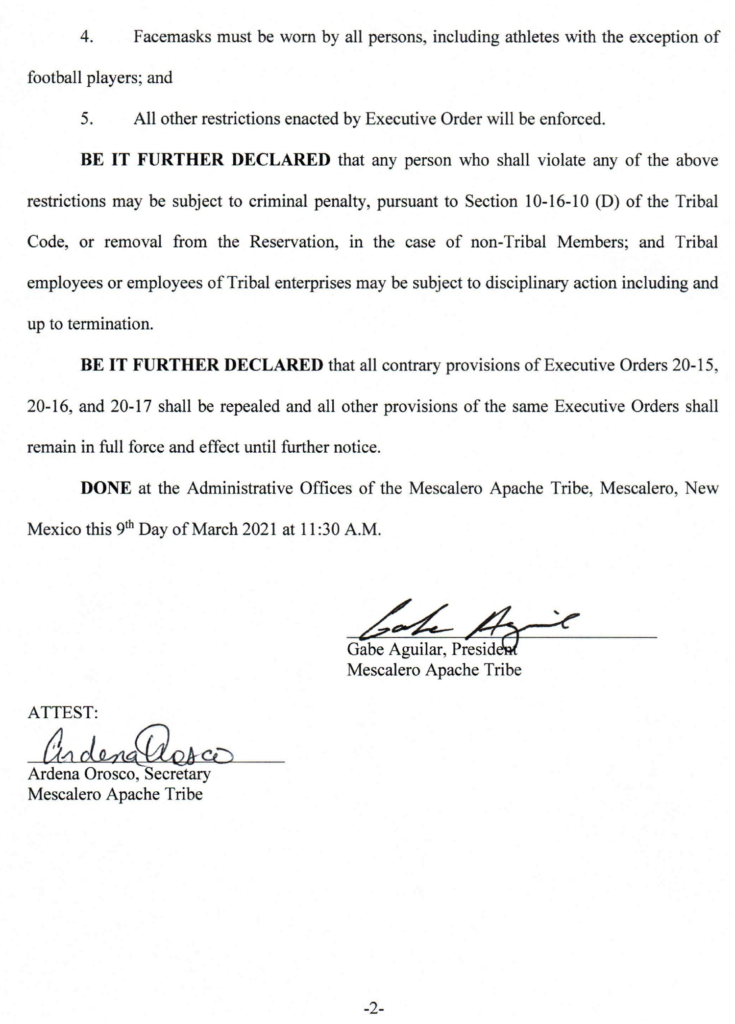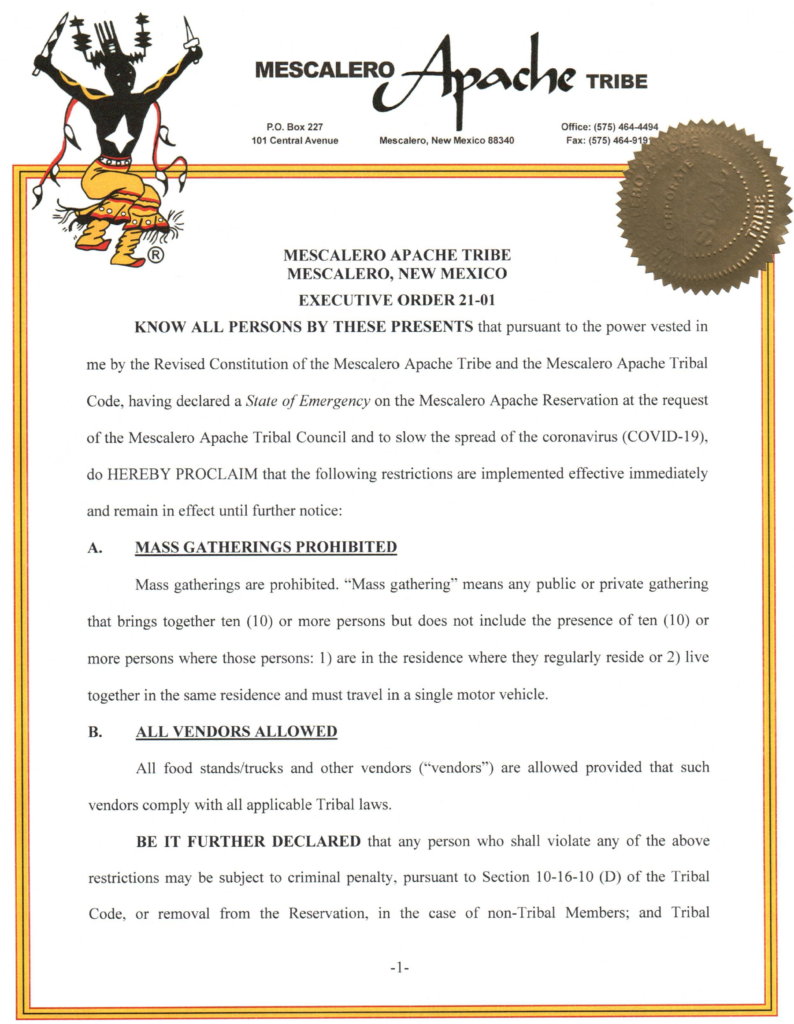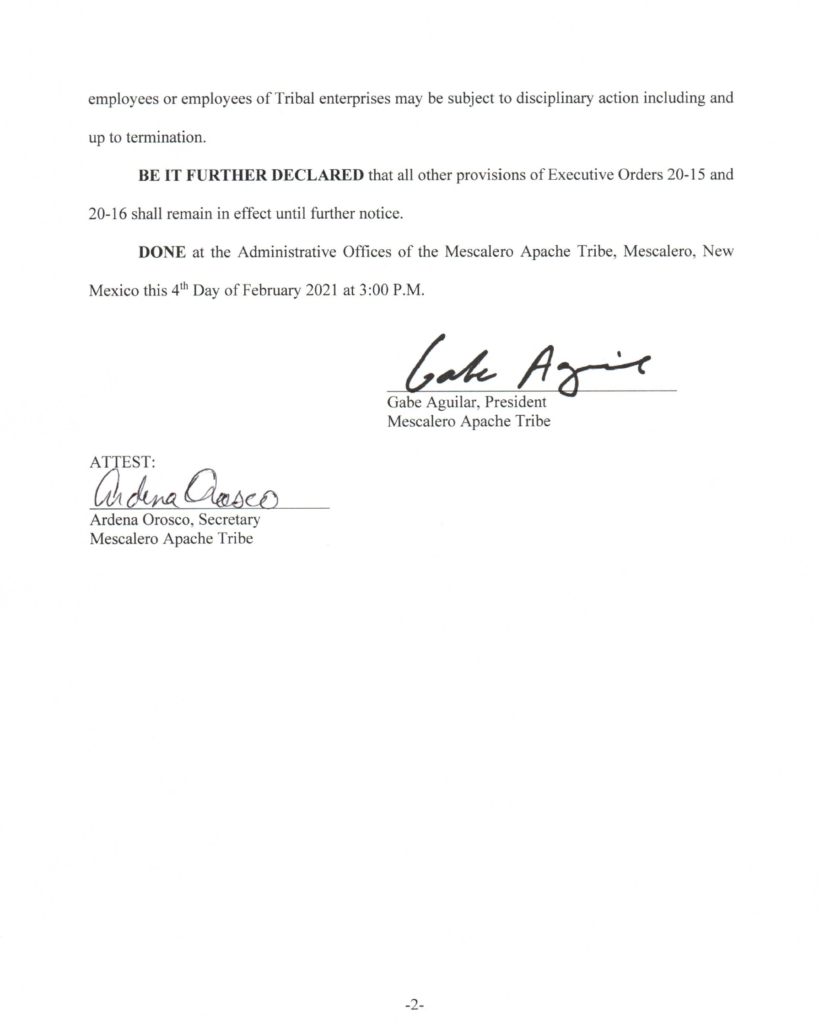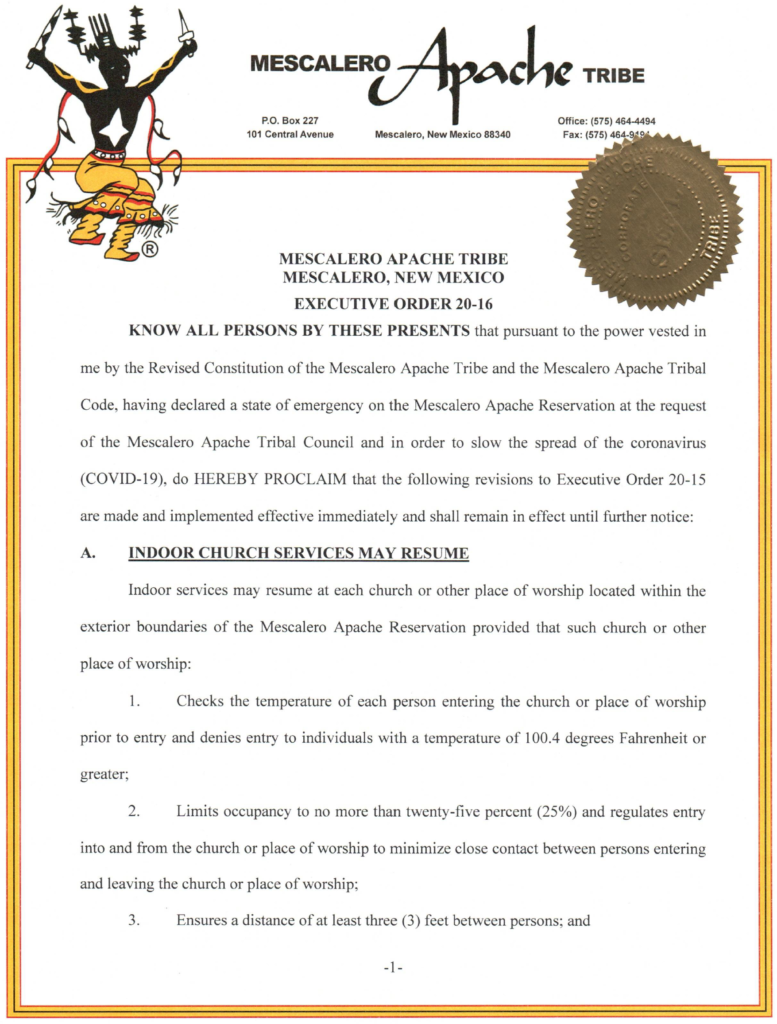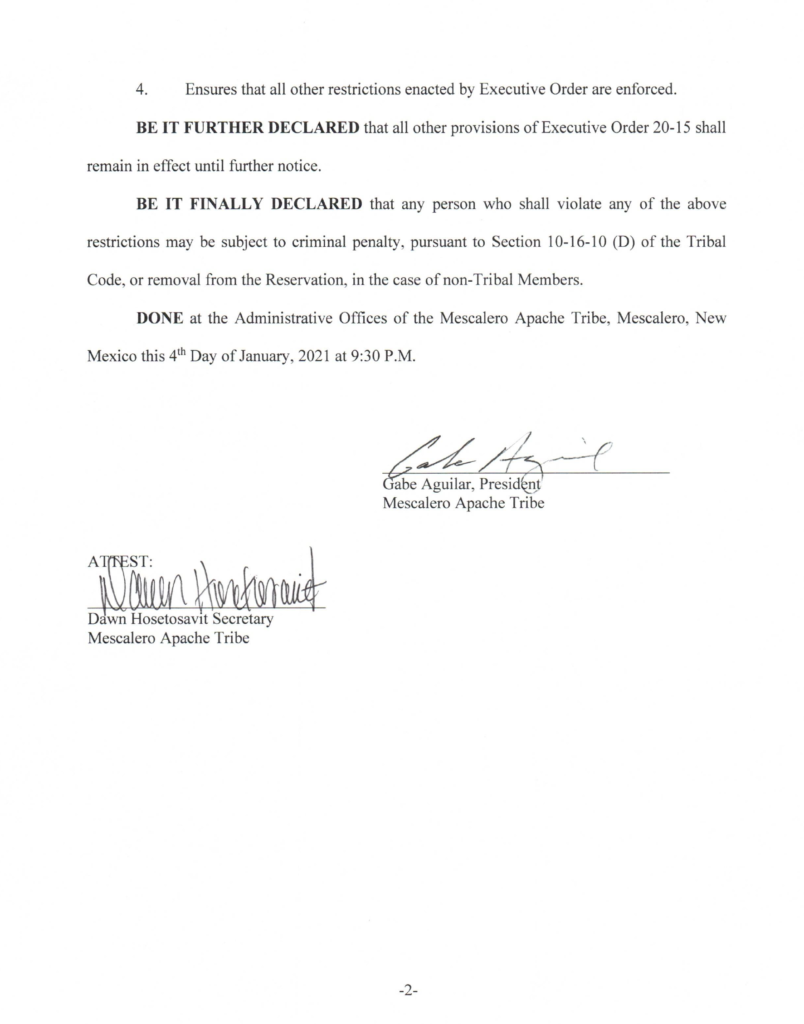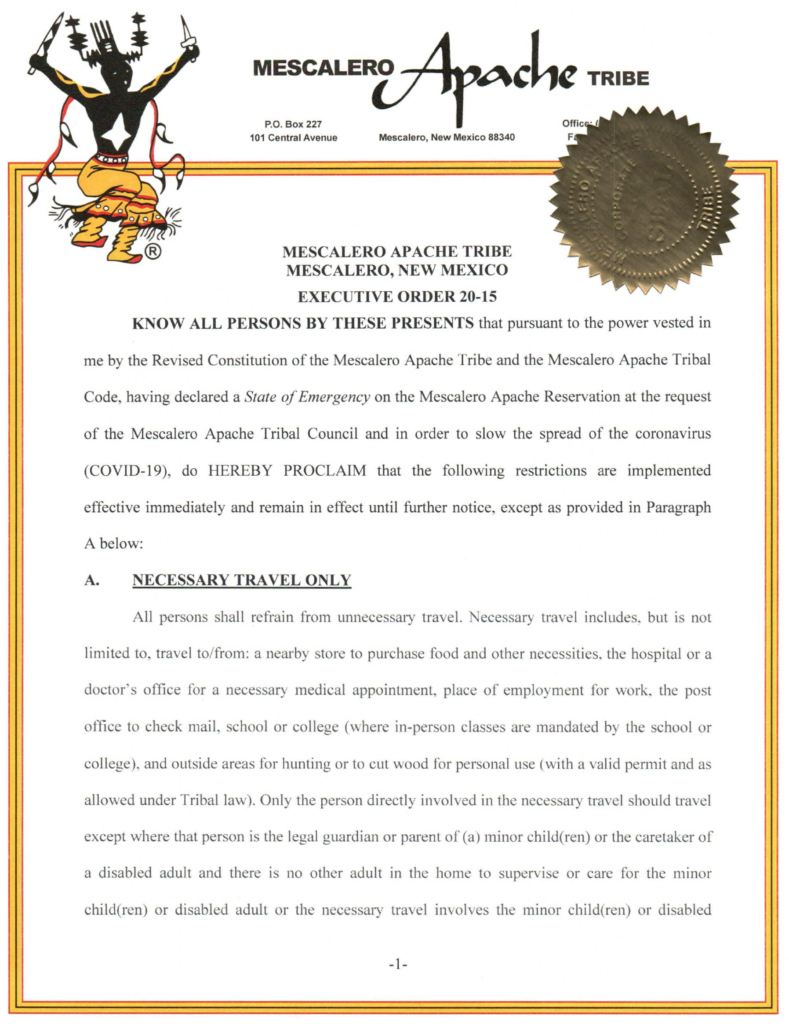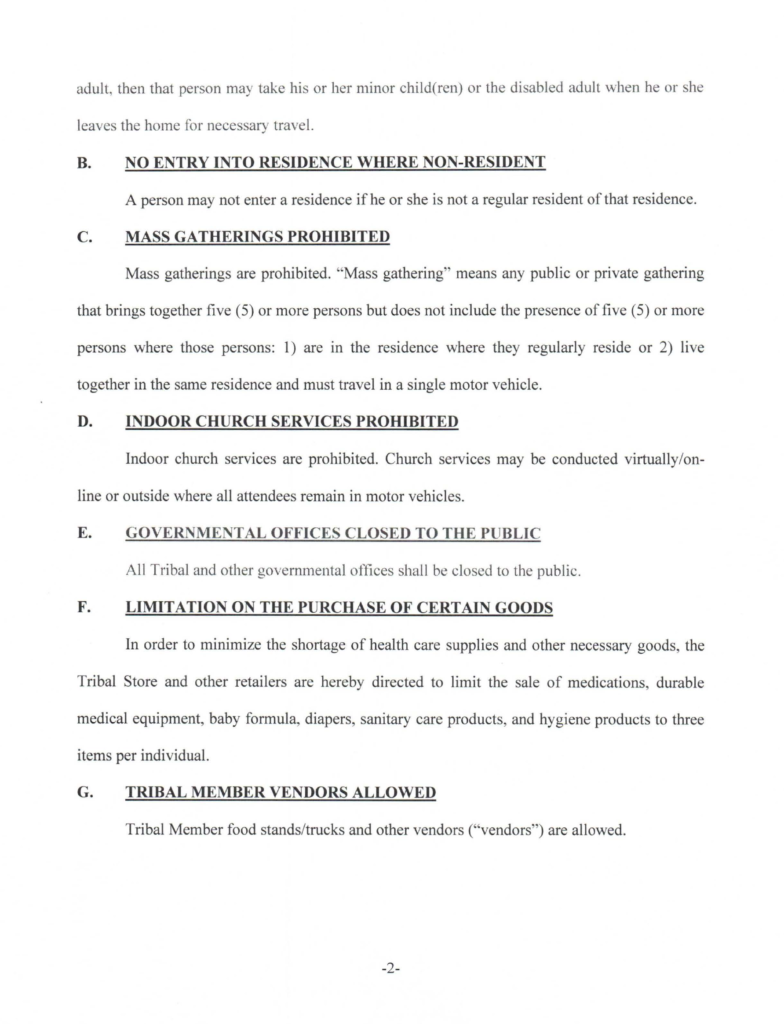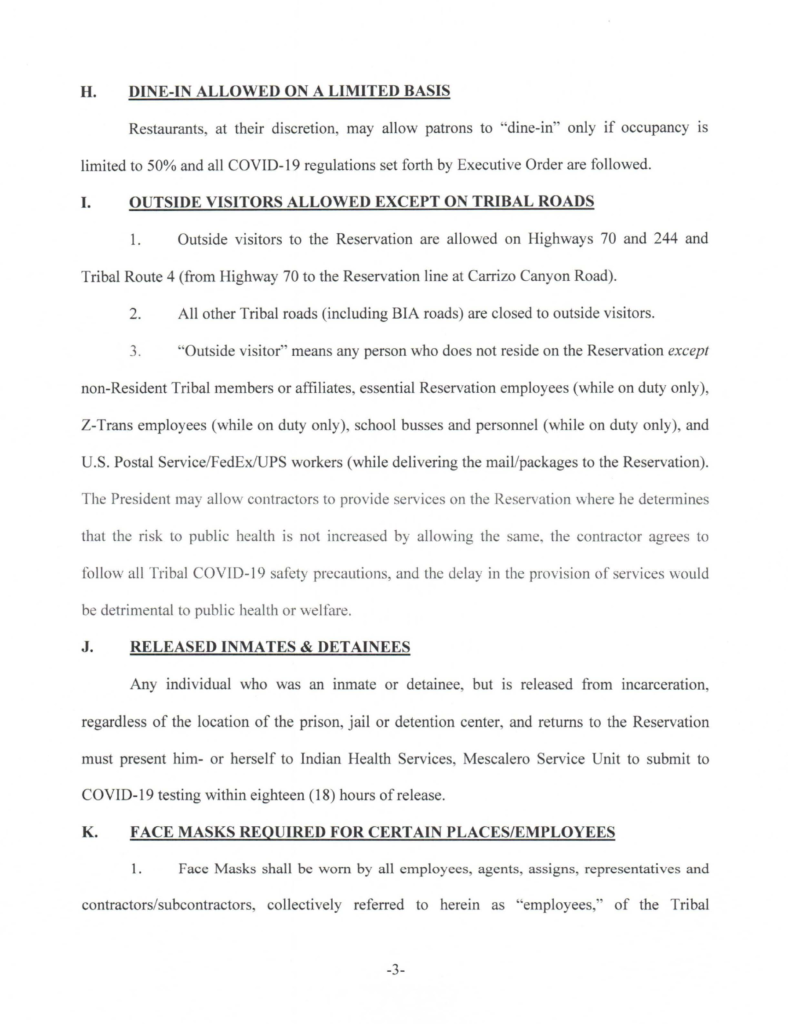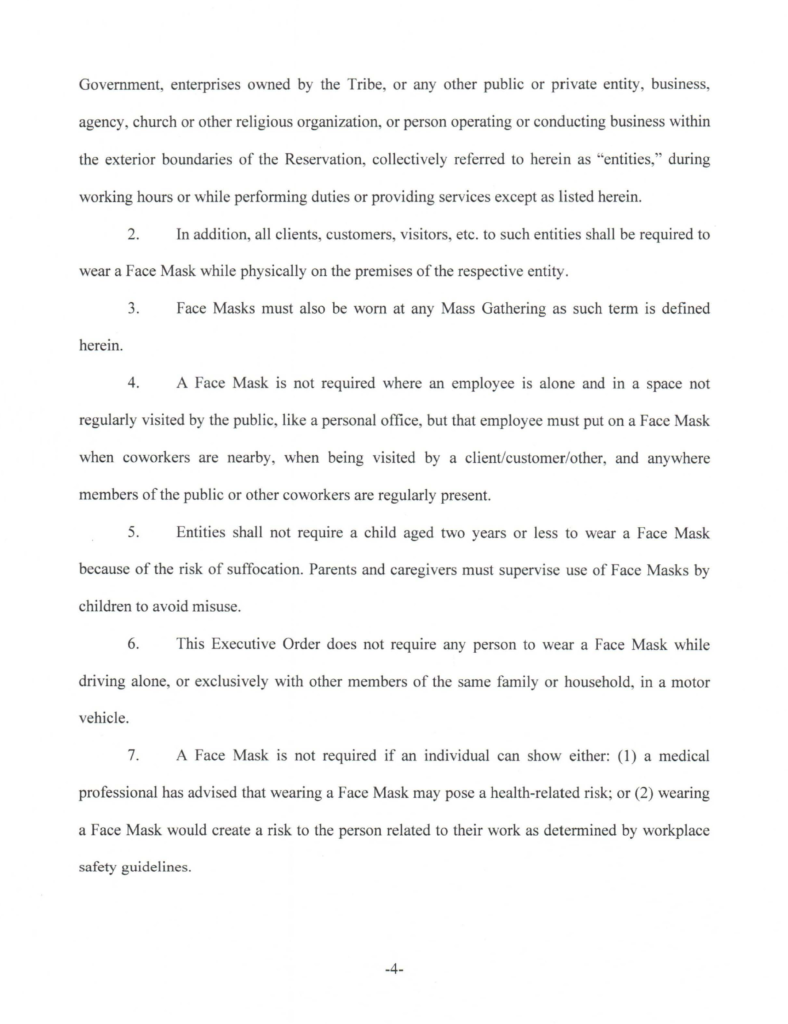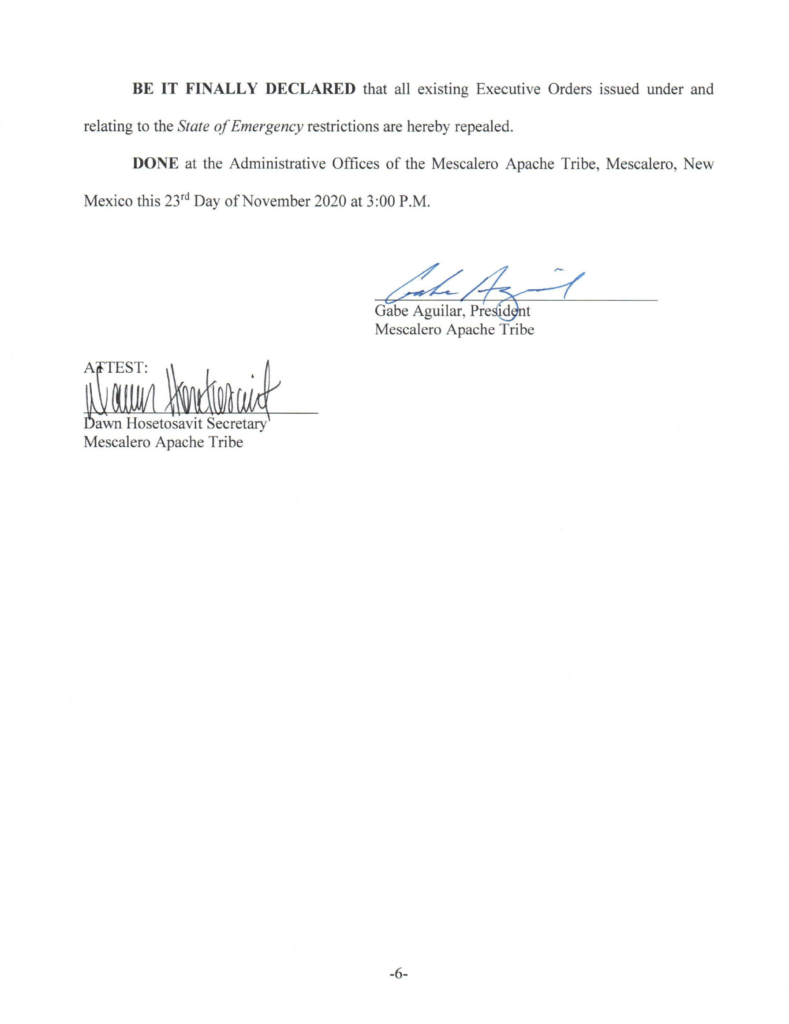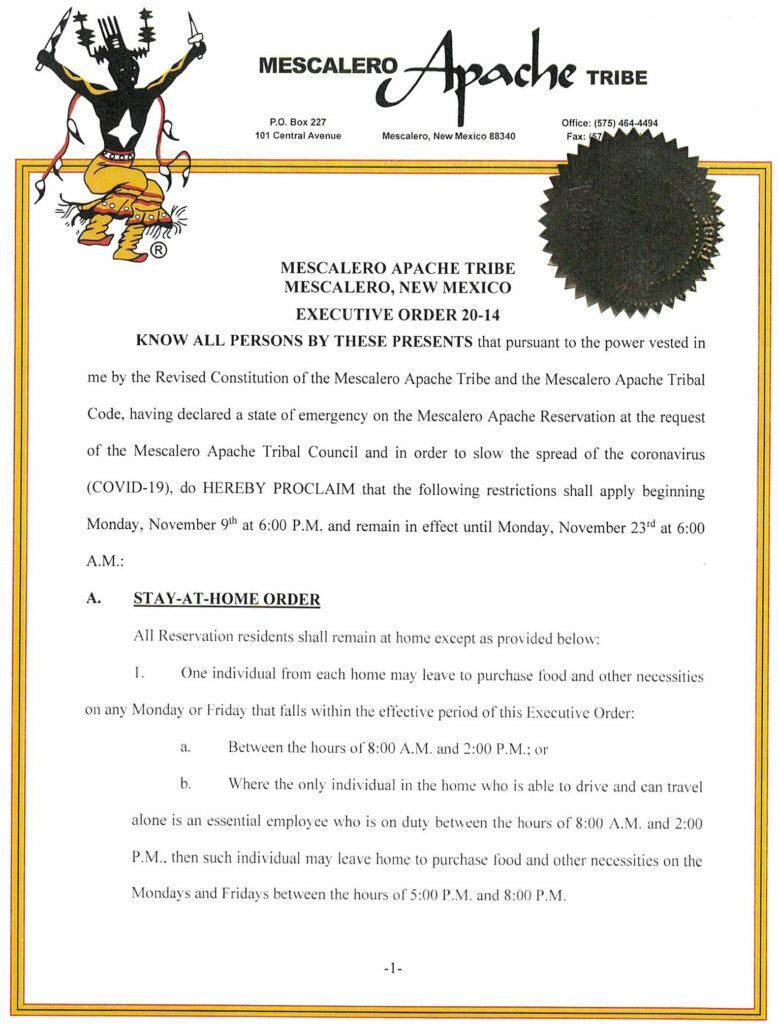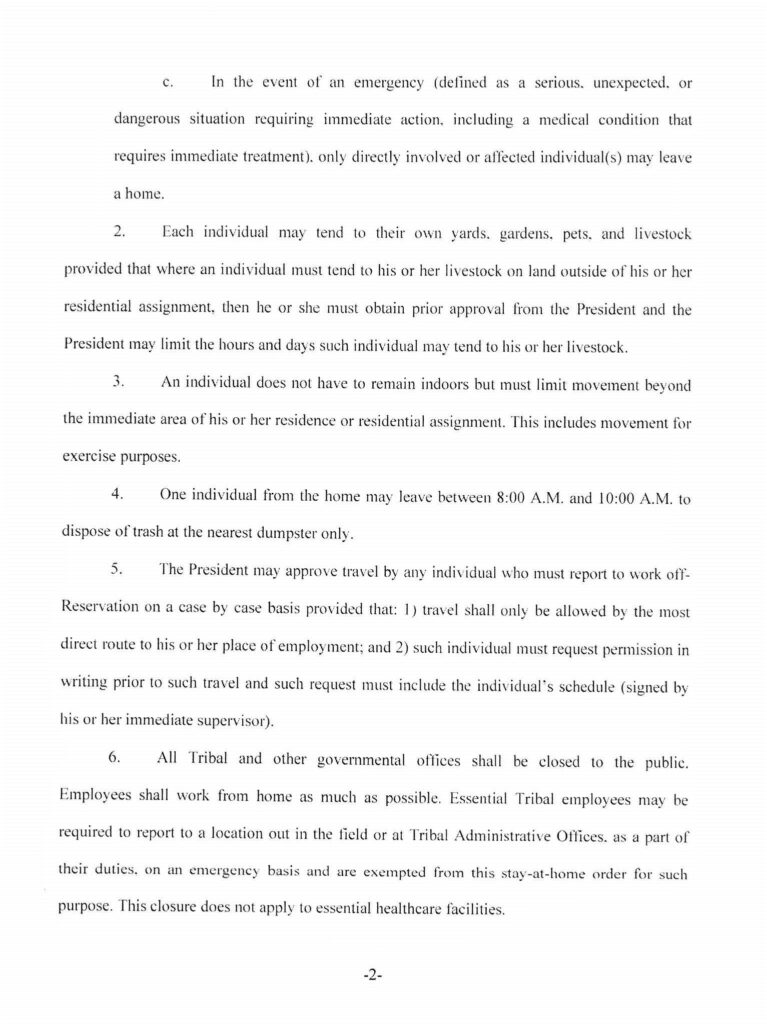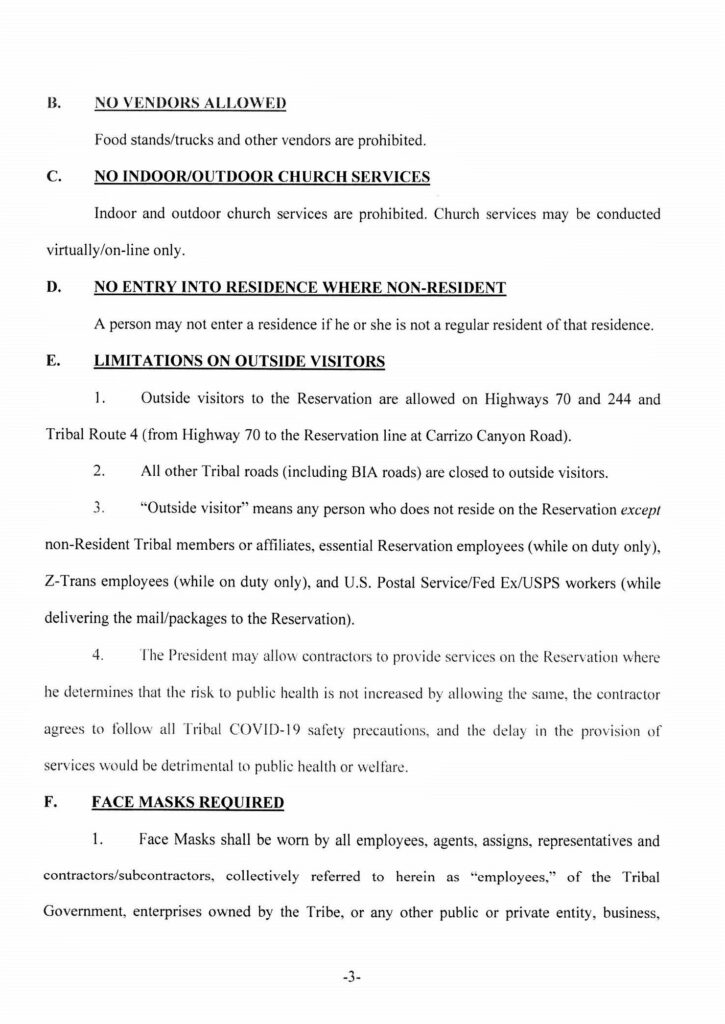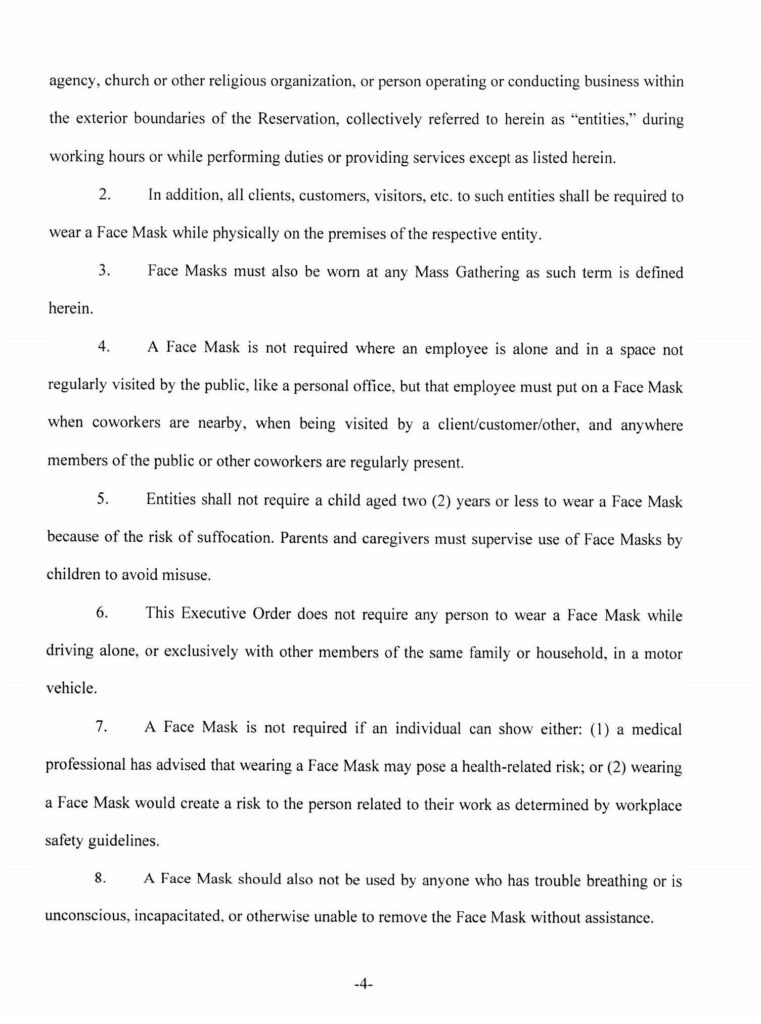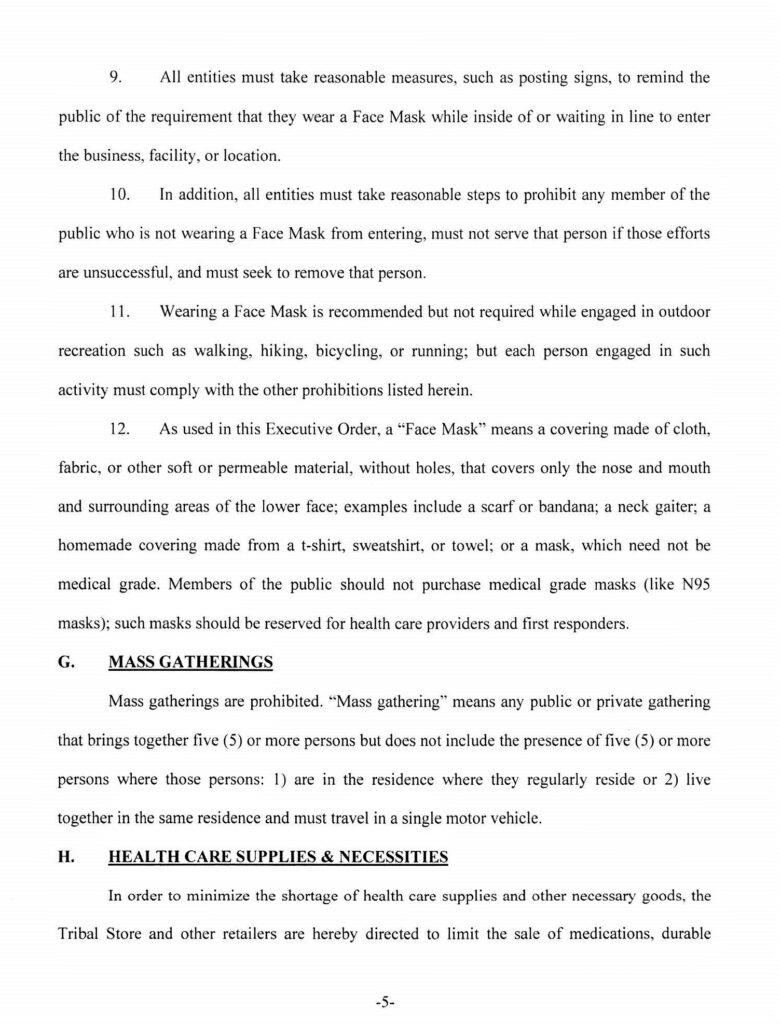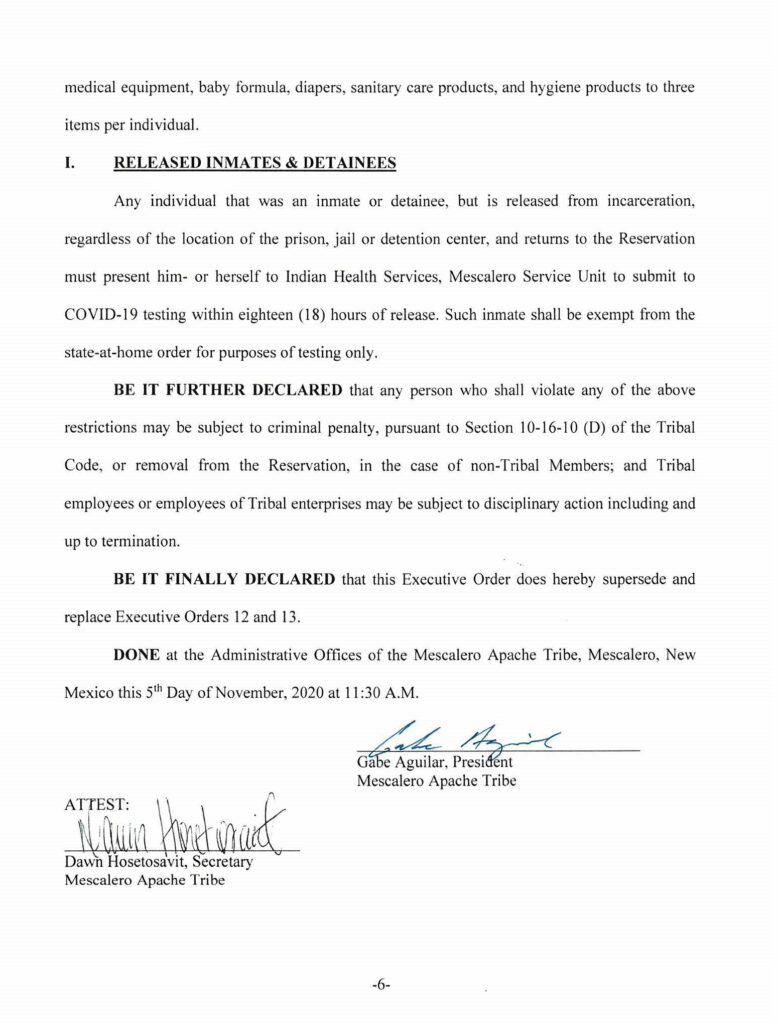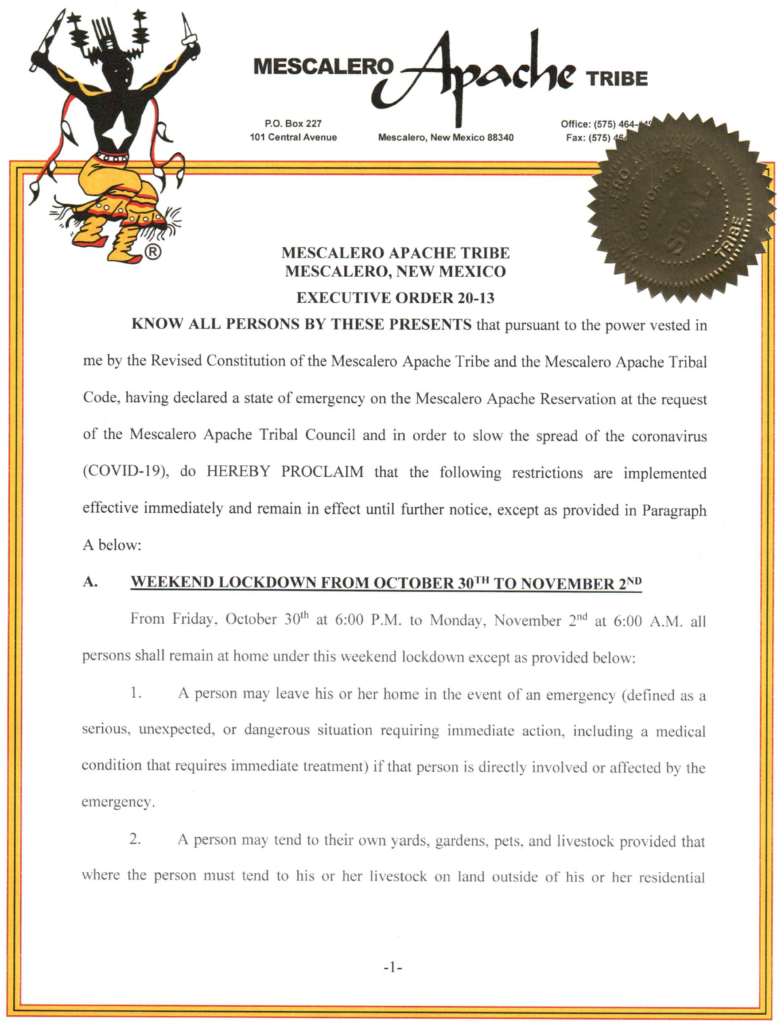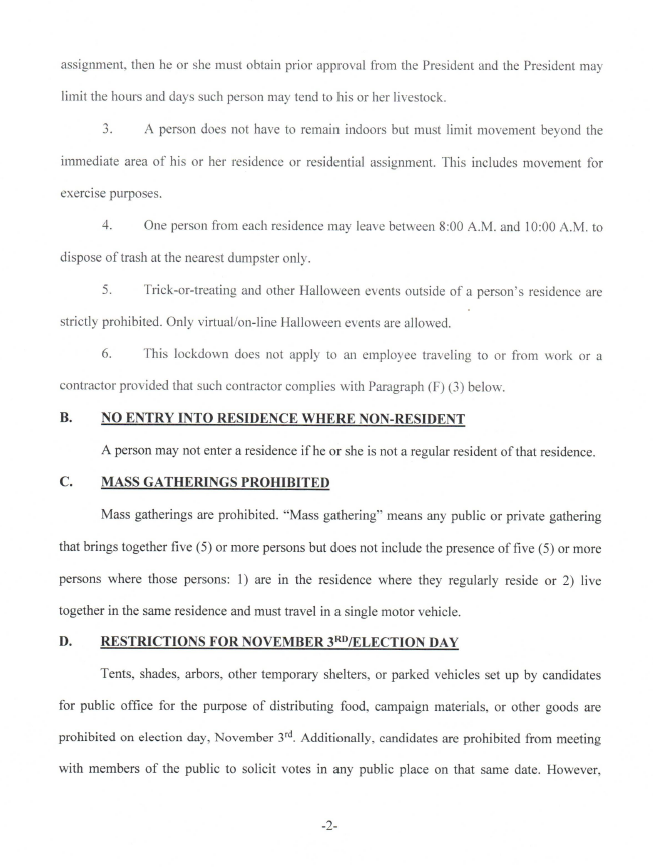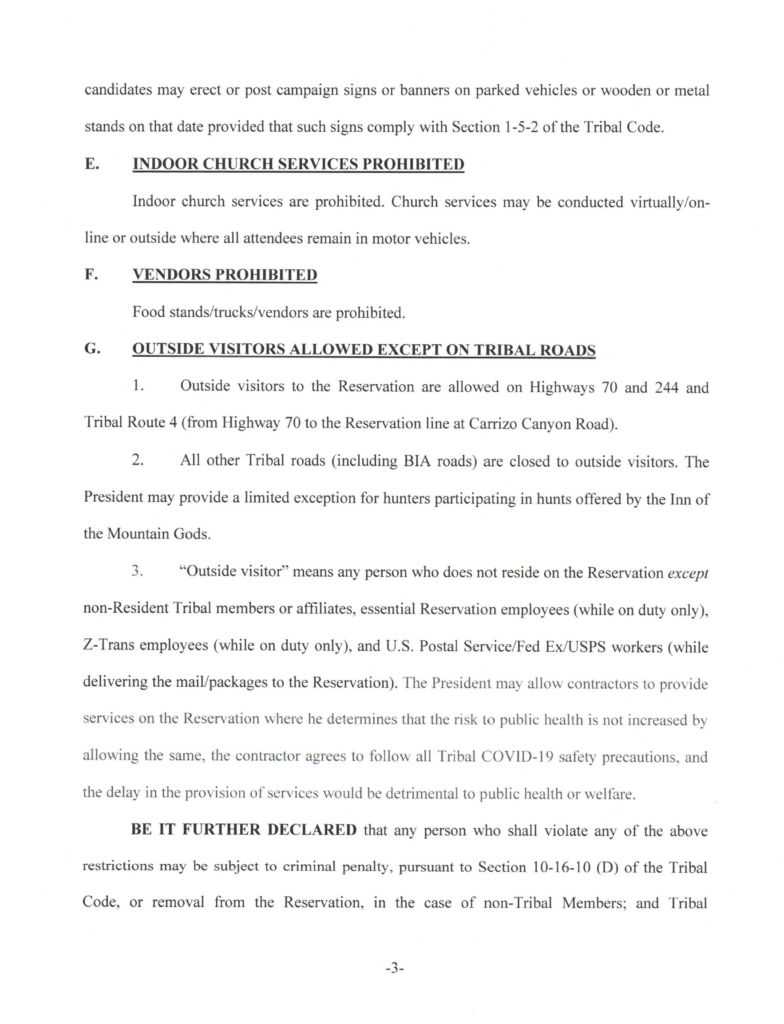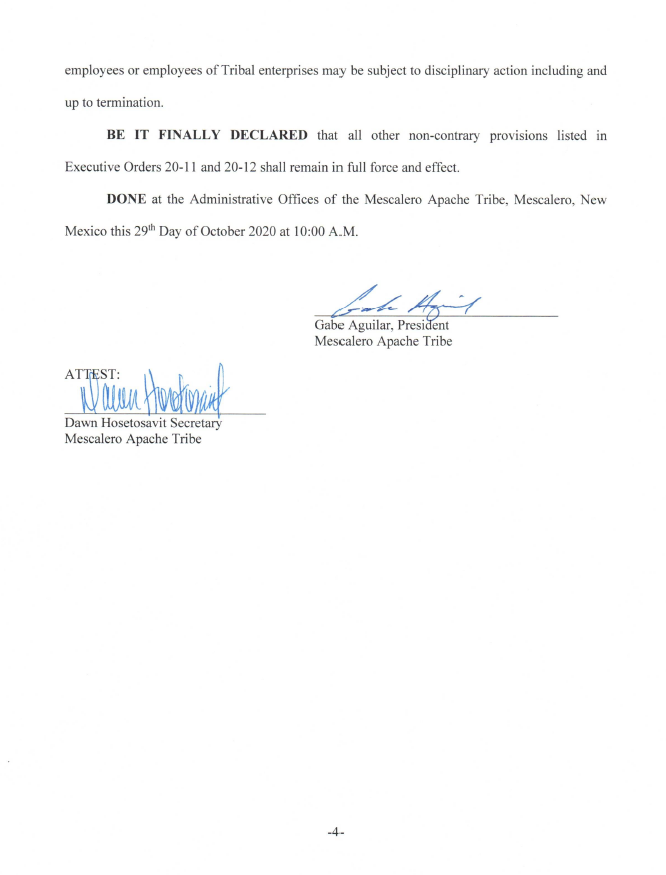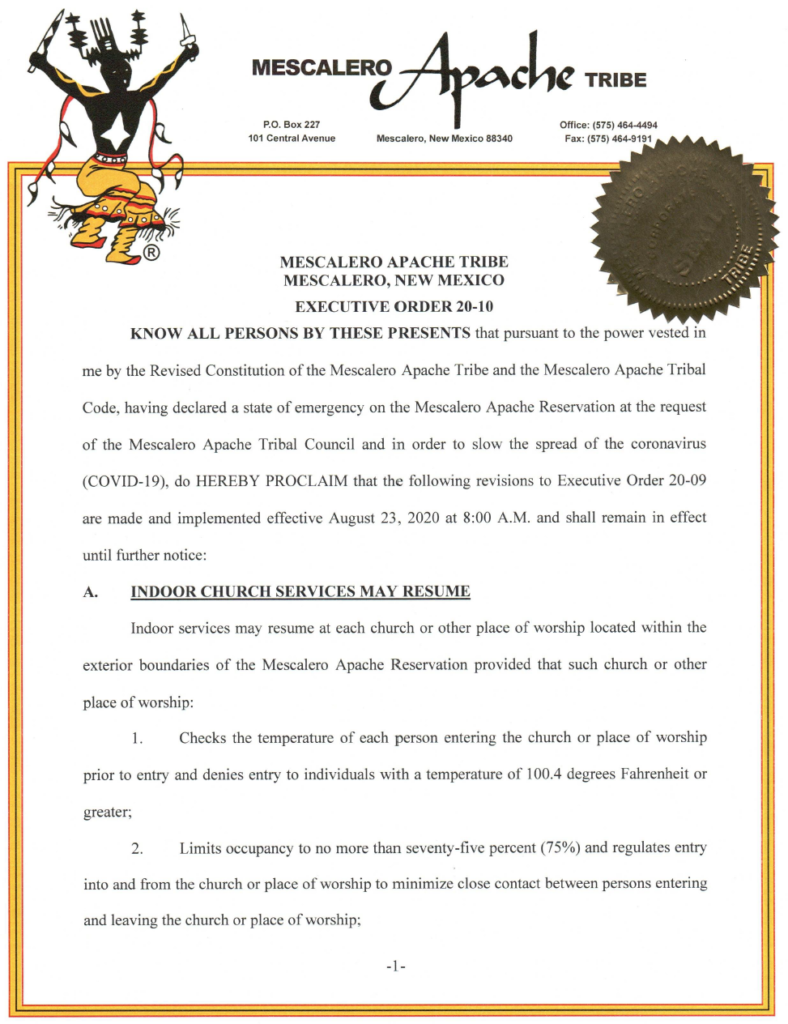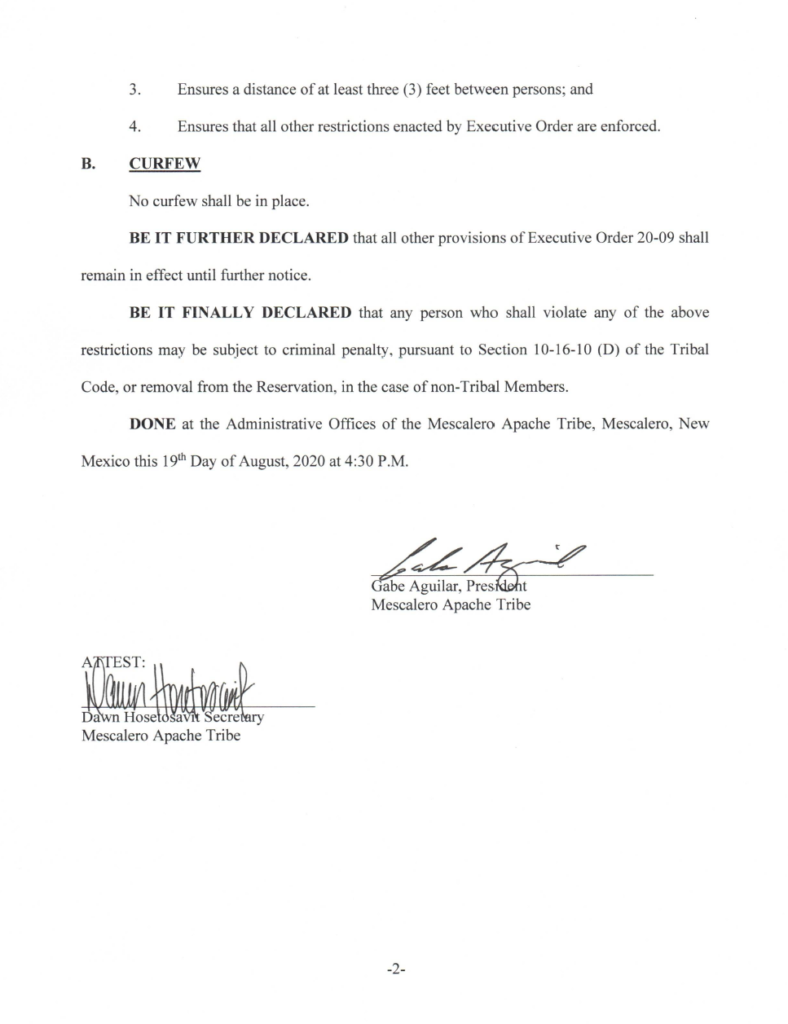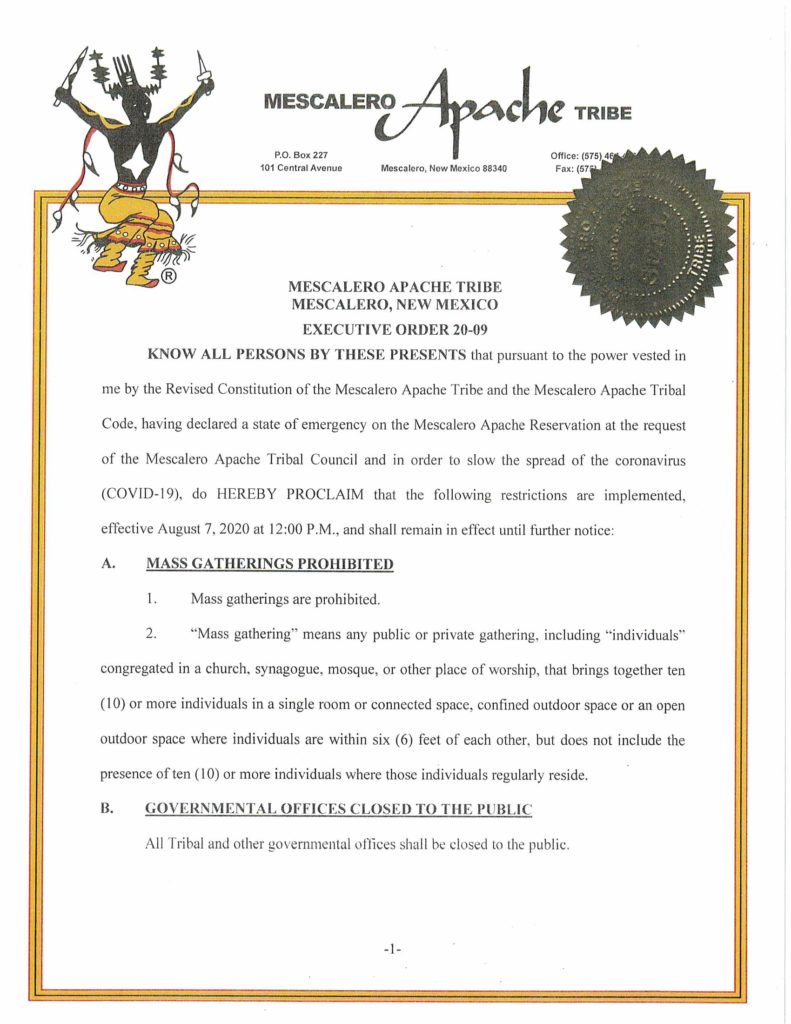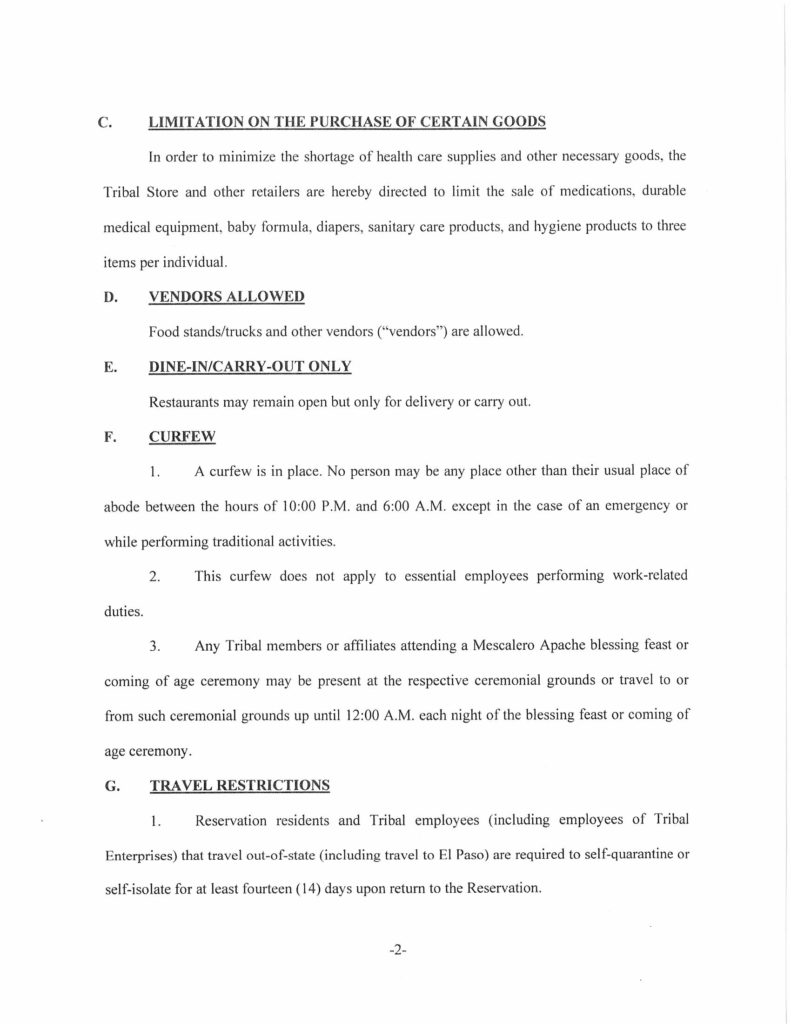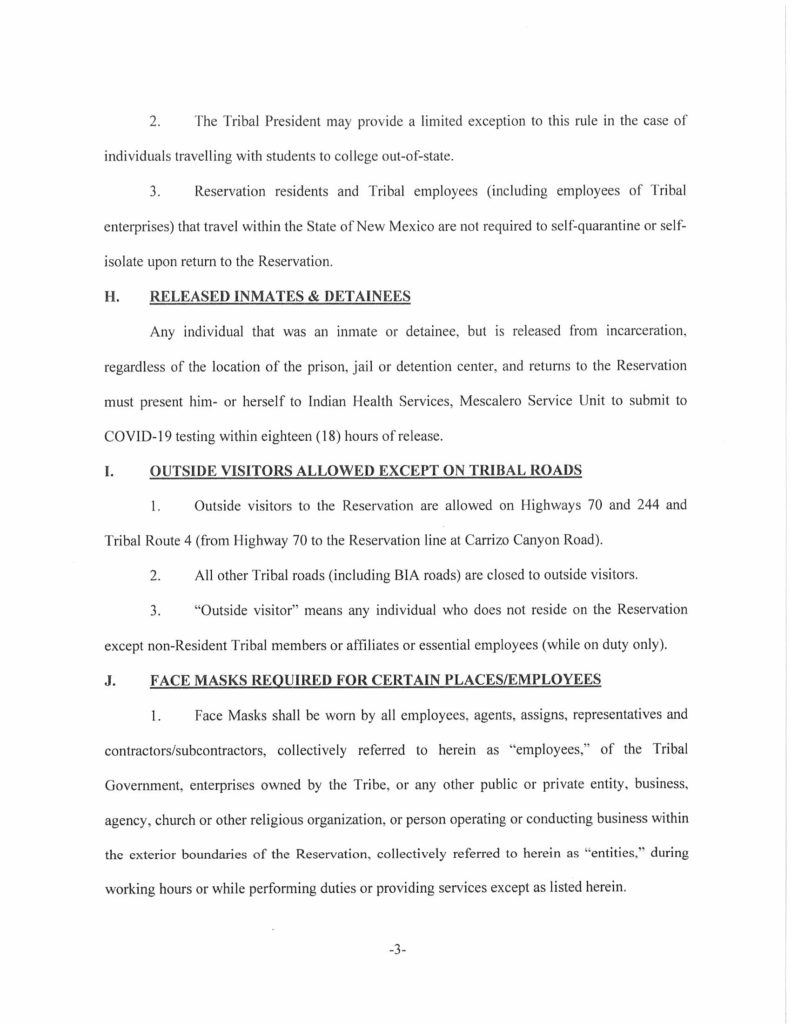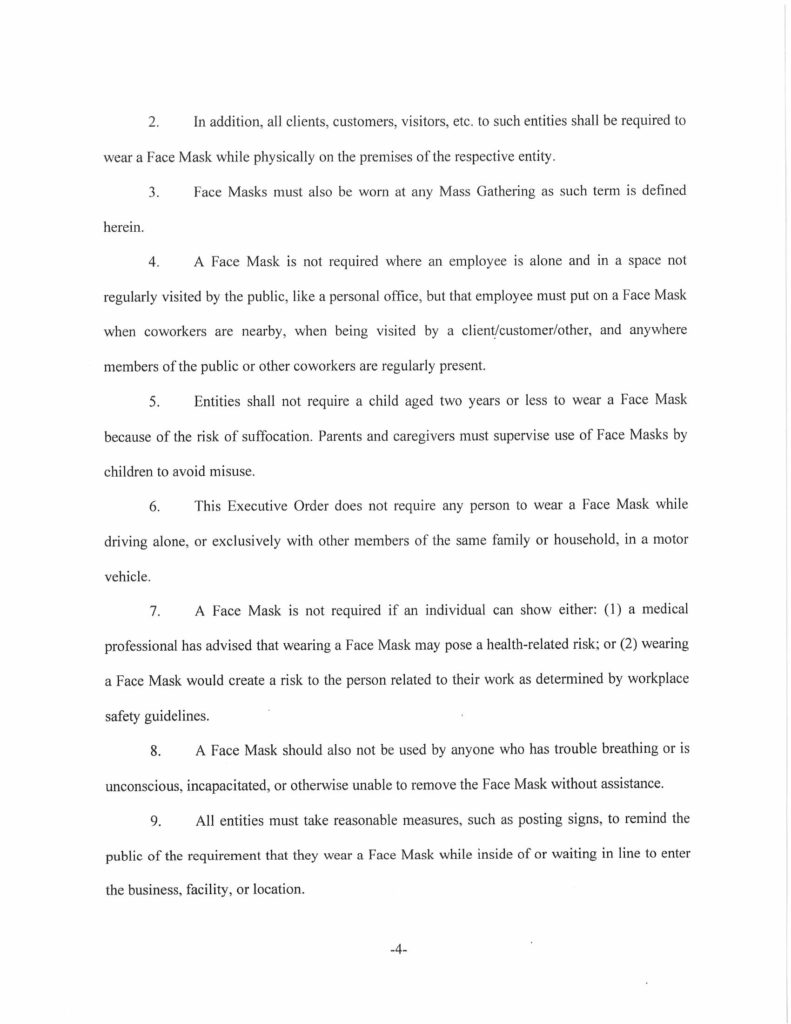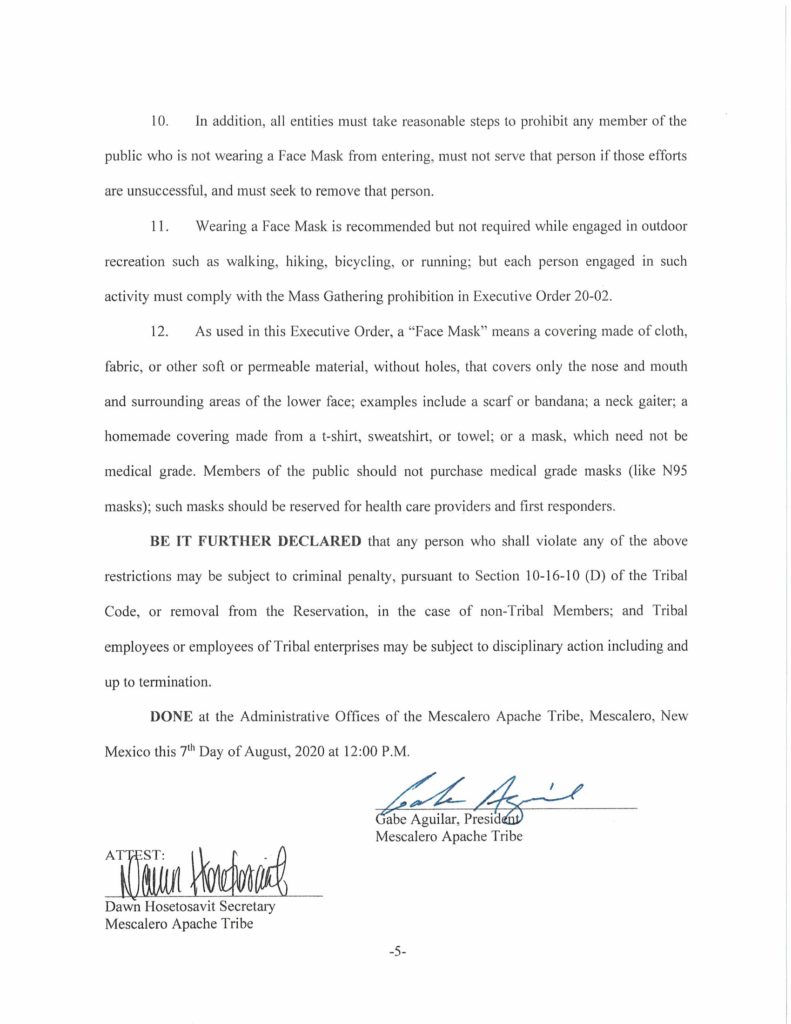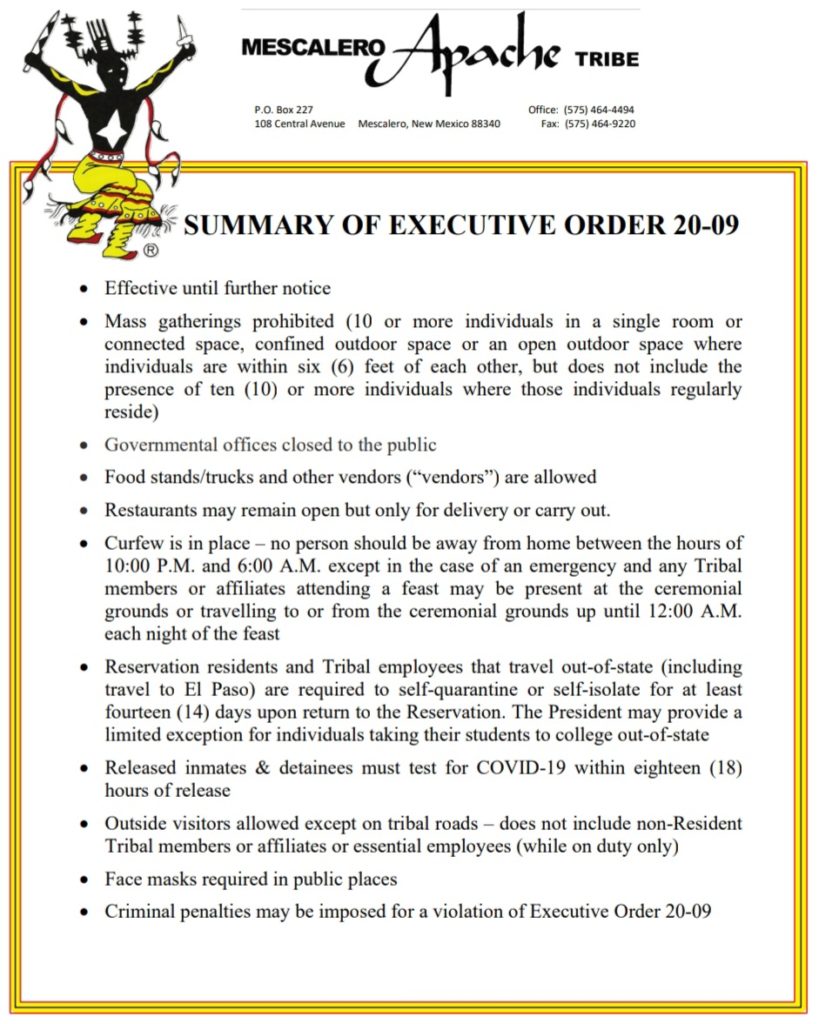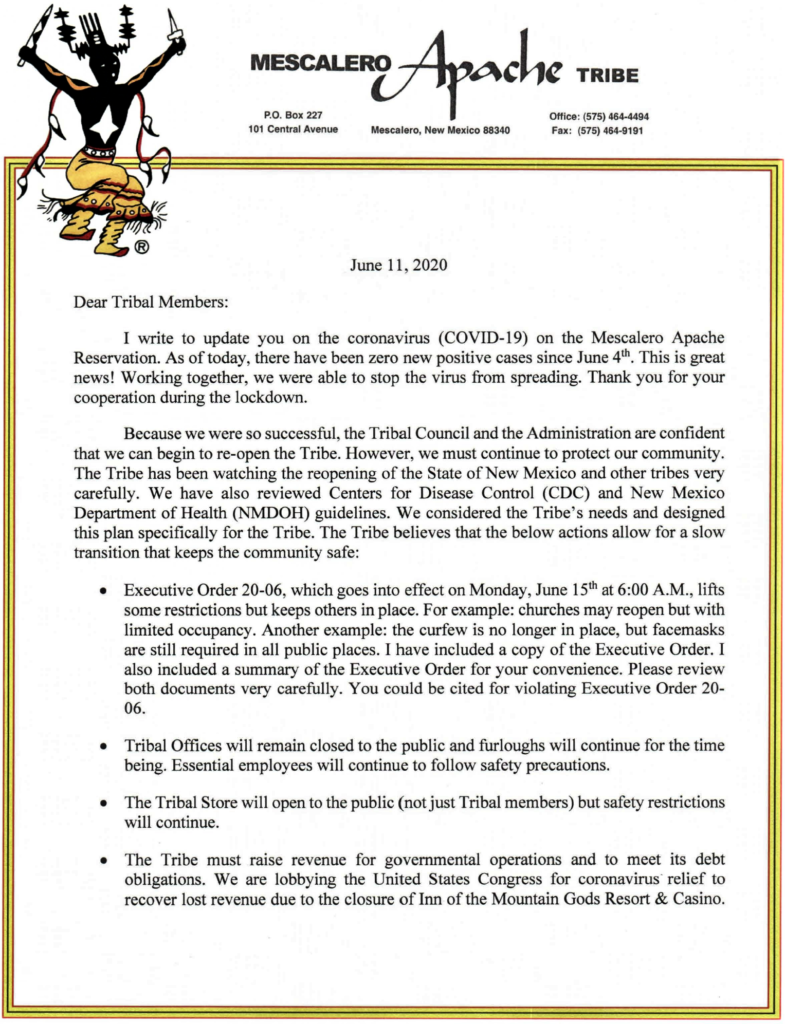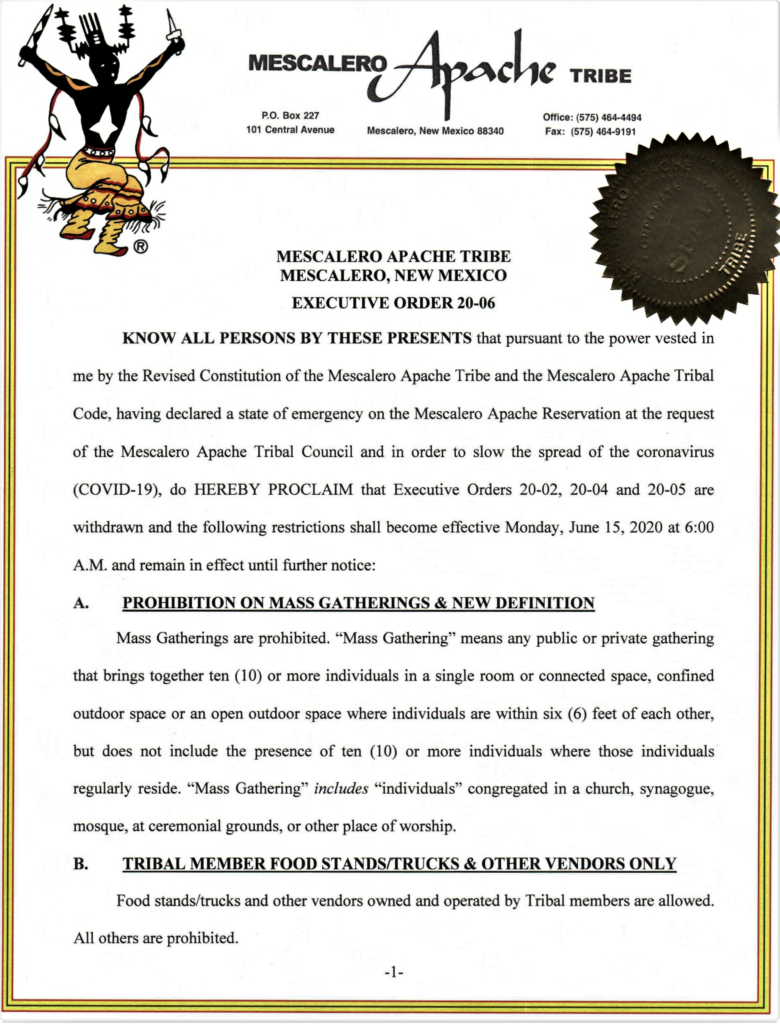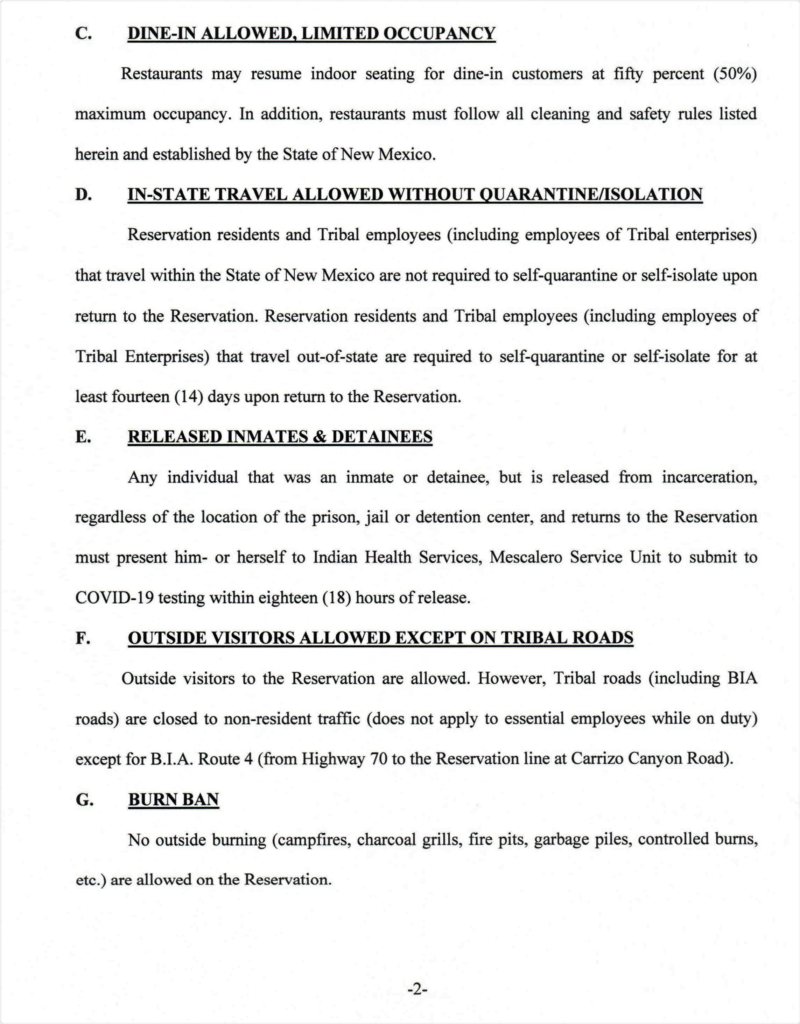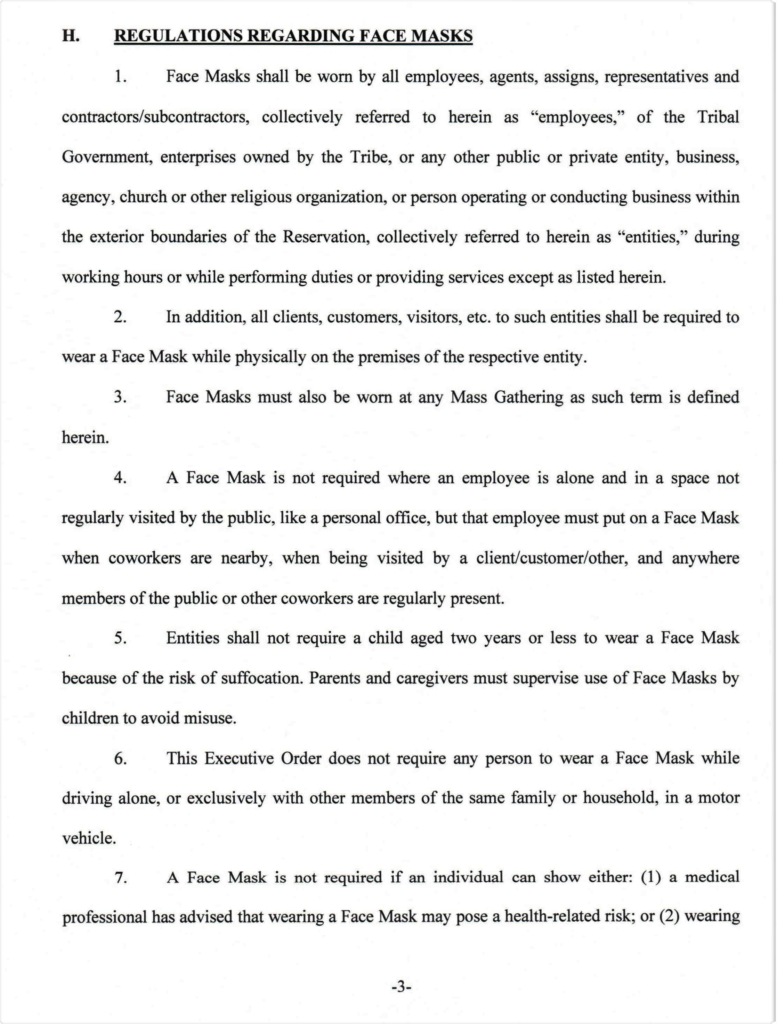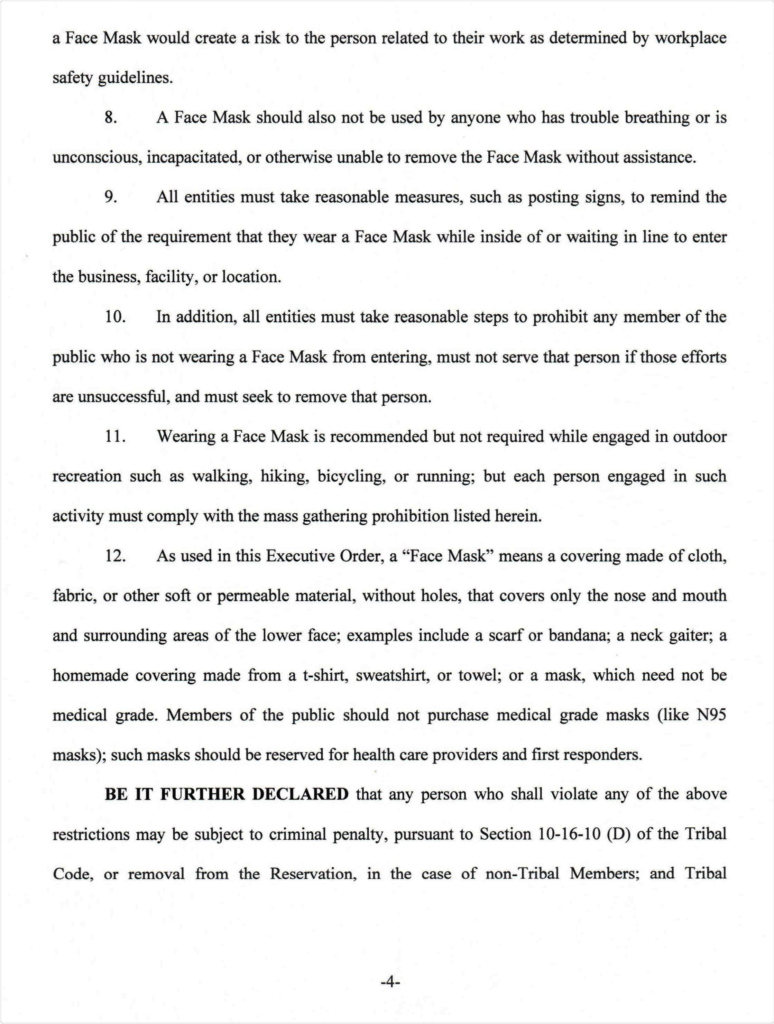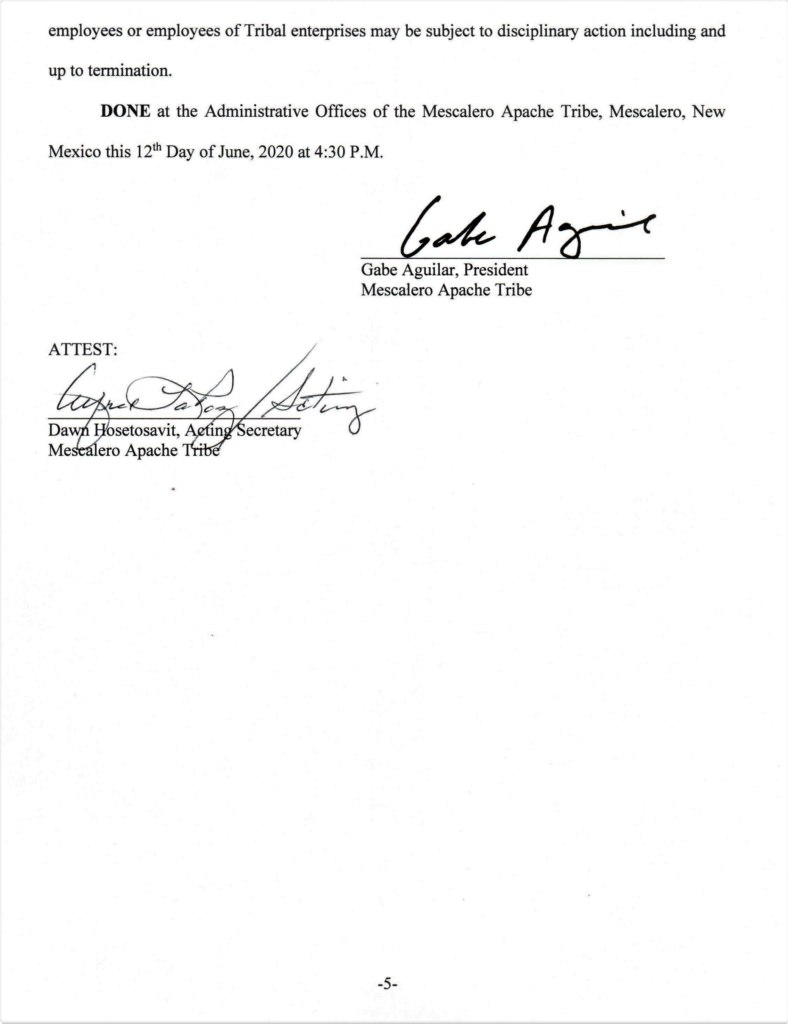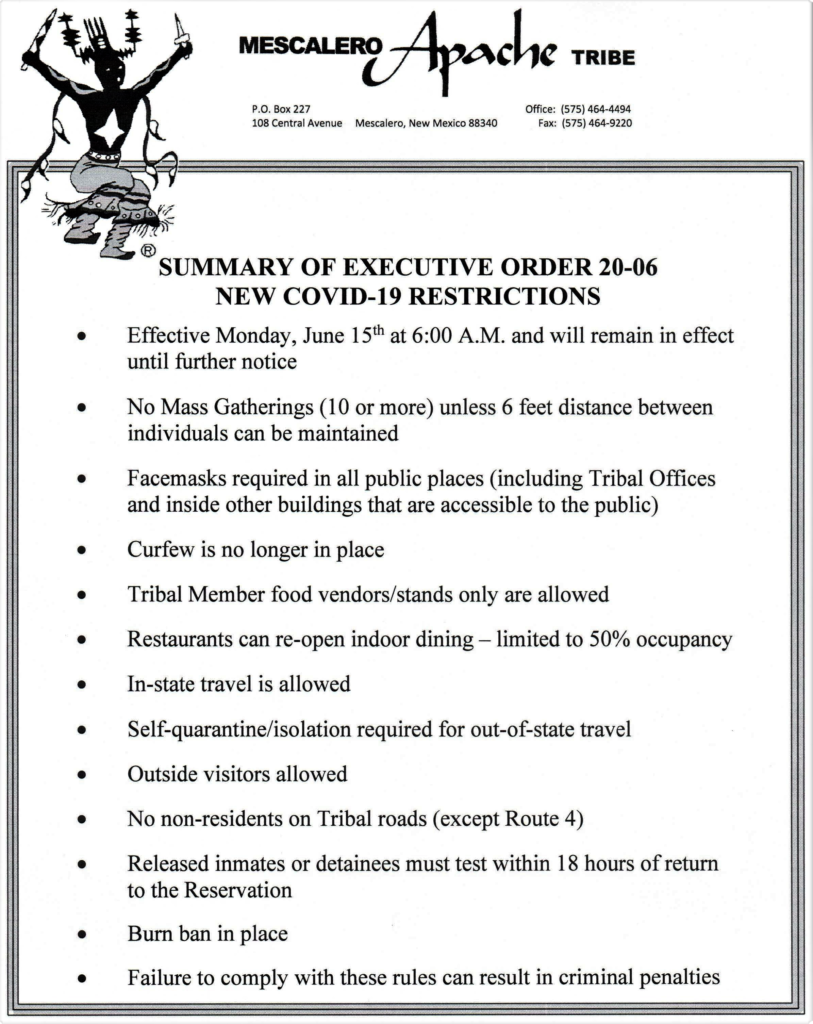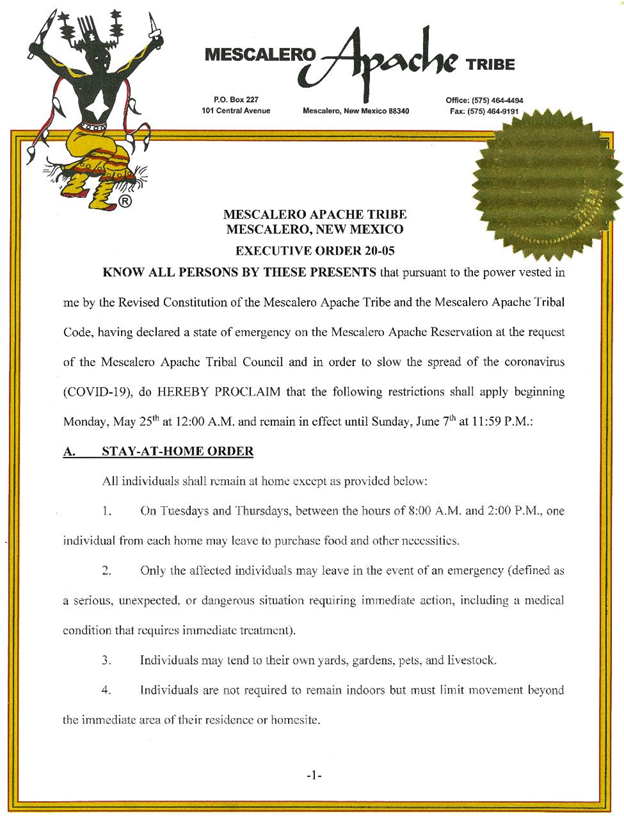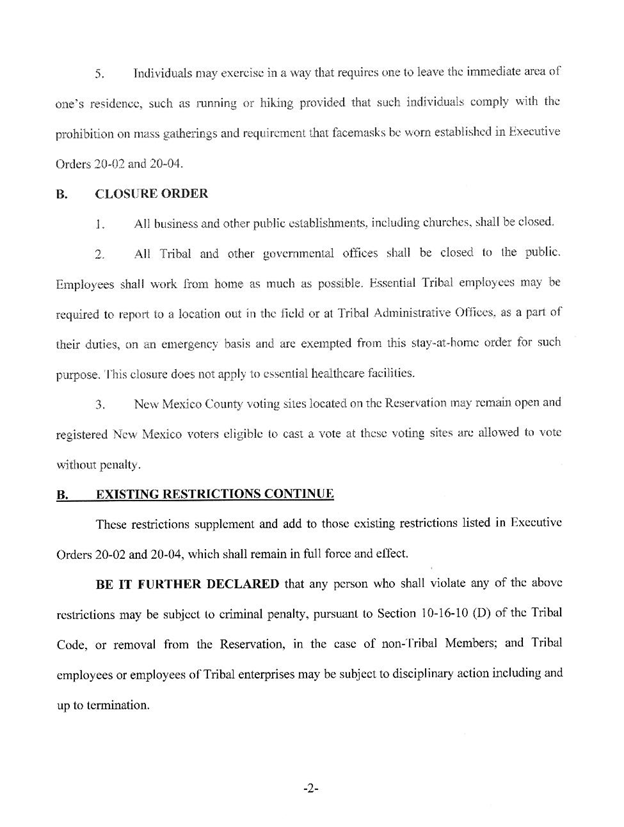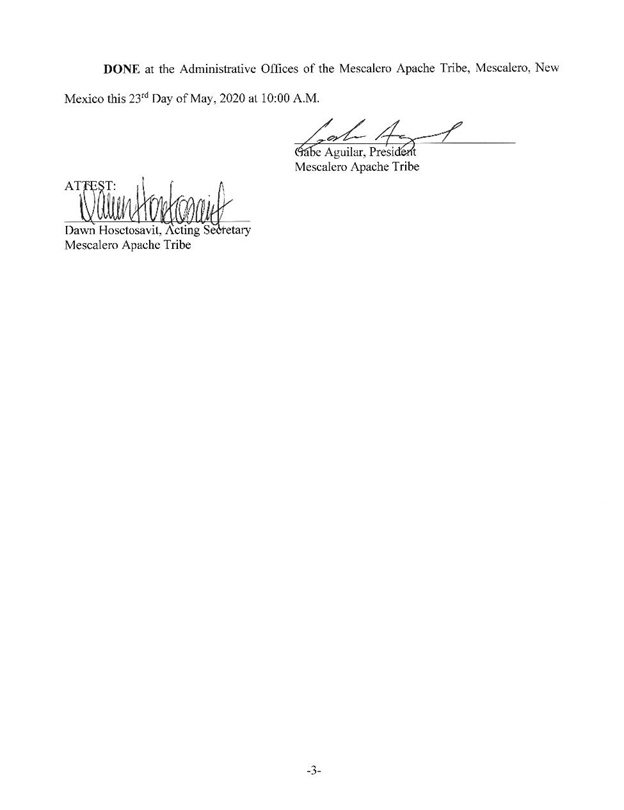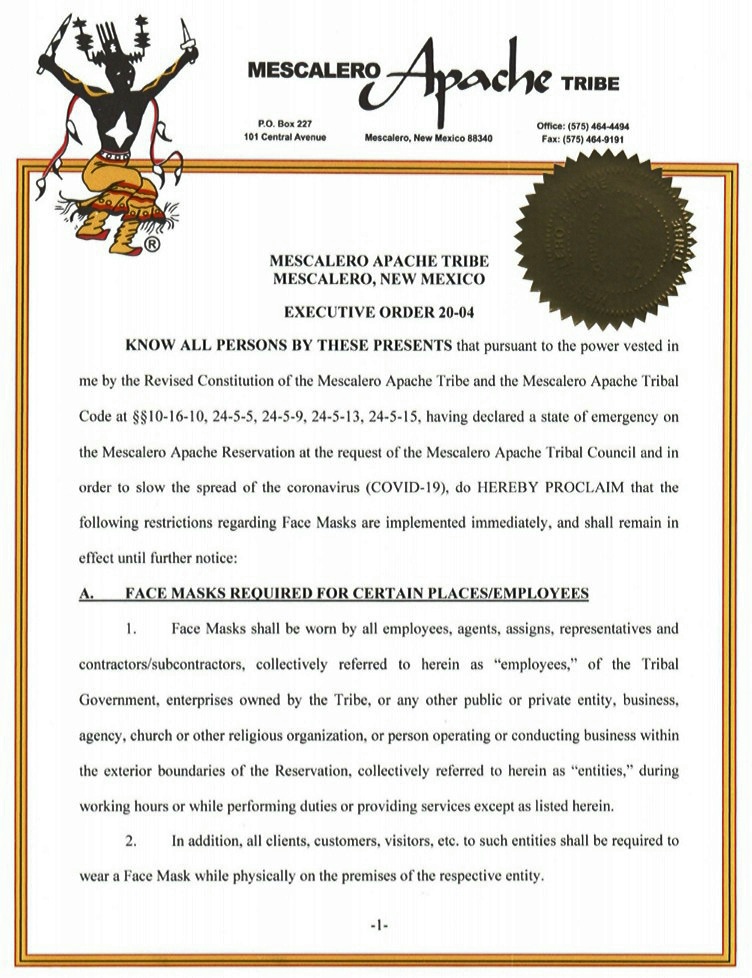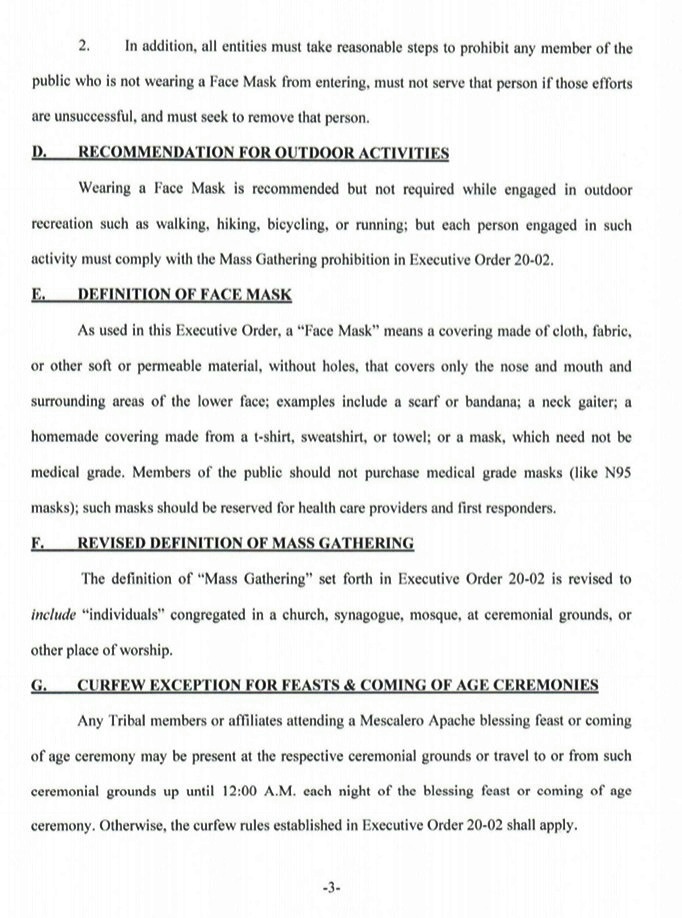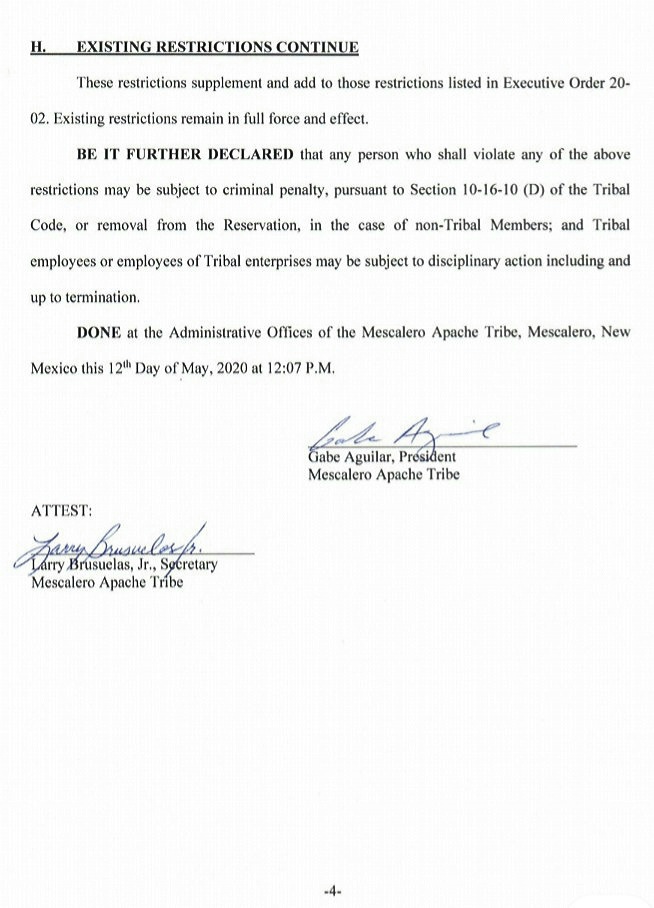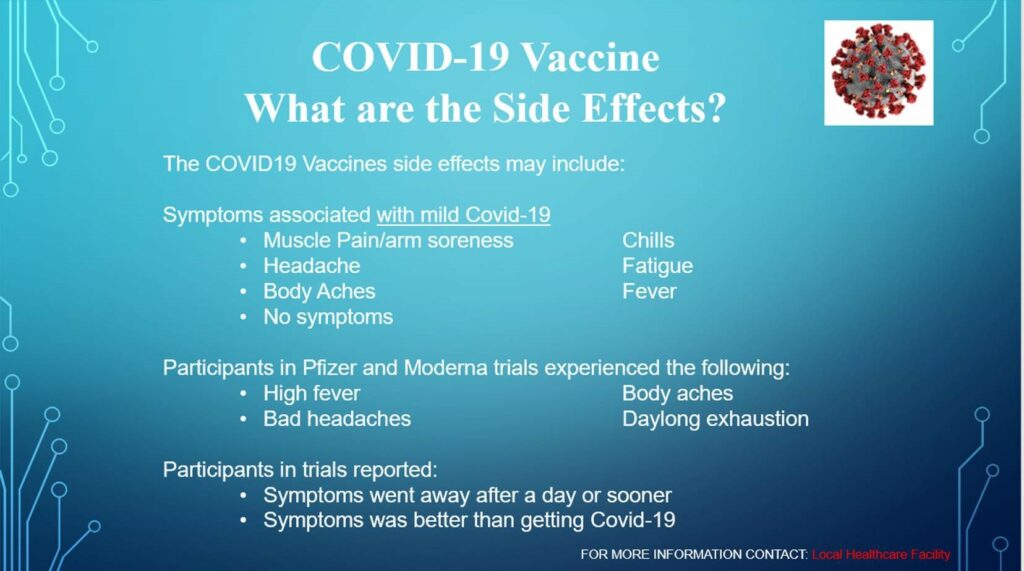Coronavirus (COVID-19)
by Mescalero Apache Tribe | March 13, 2020 12:15 pm
UPDATED: OCTOBER 14, 2022
Attention Tribal Members
REMEMBER: CALL LAW ENFORCEMENT IF YOU SEE SOMETHING OR SOMEONE SUSPICIOUS ON THE RESERVATION.
The number to Mescalero BIA Dispatch is 464-4479. Help Law Enforcement by reporting ASAP if you see something. There is little for officers to do when reporting is after the fact.
Again, call BIA dispatch at 464-4479 for ANY suspicious activity or person(s).
Everyone please stay safe and practice social distancing.
EOC (Emergency Operation Center)
IS ACTIVE!
575-464-1614
Monday – Friday; 8am – 4:30pm
This page is dedicated to providing you and your family with the latest Tribal information as it pertains to the Coronavirus (COVID-19). Here, you will find current:
- Mescalero IHS[1]
- Tribal[2]
- State[3]
- National[4]
- local School information[5] and more about the Coronavirus.
Important information for Tribal Employees about stimulus payment here[6]!
If you need hand sanitizer and/or cloth masks, please come by the Tribal Offices and see our Tribal Security. He will gladly help you with those items from 830am – 4pm, Monday – Friday.
Information on Mental Health Services During COVID-19 here[7].
We are accepting donations!
Find out more.Items can be dropped off at the Administration side door, located at the Tribal Offices. Since the offices are closed to the public, someone will walk in the items for you.
IF monetary donation
Make check payable to: Mescalero Apache Tribe
Mail to: P.O. Box 227, Mescalero, NM 88340
Note: “Coronavirus Relief Donation”
Thank you!
**REMINDER: Emergency Manager and Chief Conservation Officer, Tyner Cervantes recommends waiting for the Official Press Release on any Positive COVID-19 cases from the Governor’s Office or the New Mexico Department of Health only. Any other news reporting outlet may not have the correct information and could cause unnecessary panic within the community.**
Tribal Information
Mescalero Apache Tribe COVID-19 Test Results[8]
Executive Order 21-04
Find out more!Executive Order 20-16
Find out more!Tribal member letter from President Gabe Aguilar
Find out more!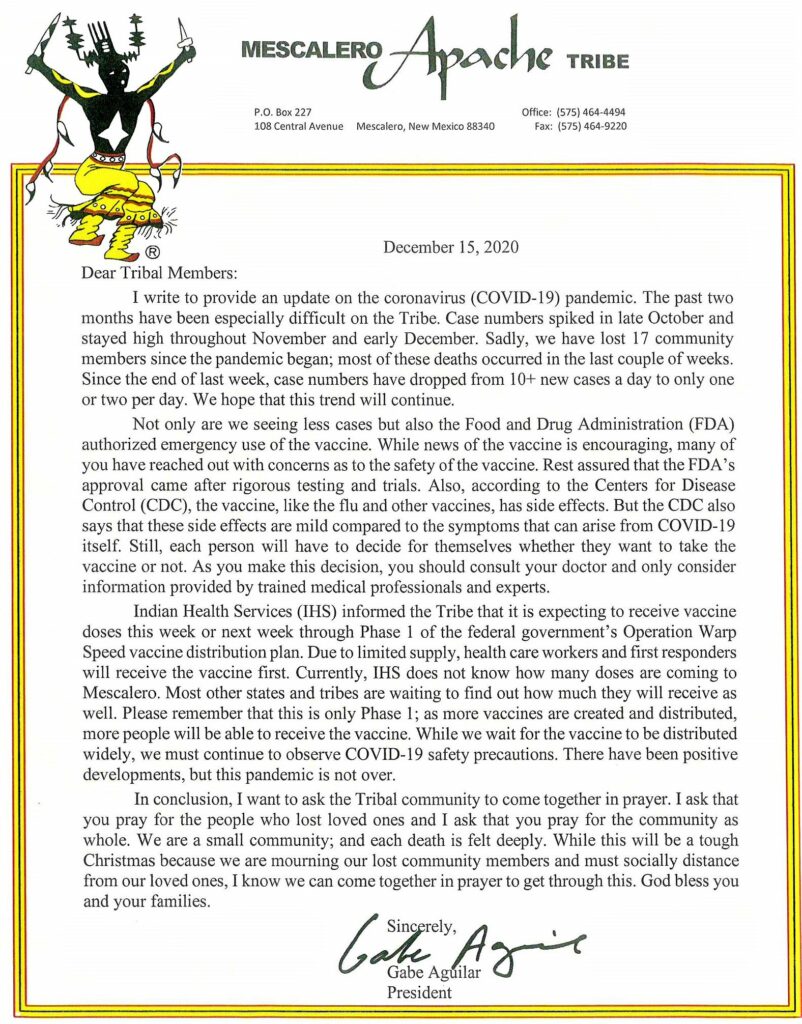
Executive Order 20-12
Find out more!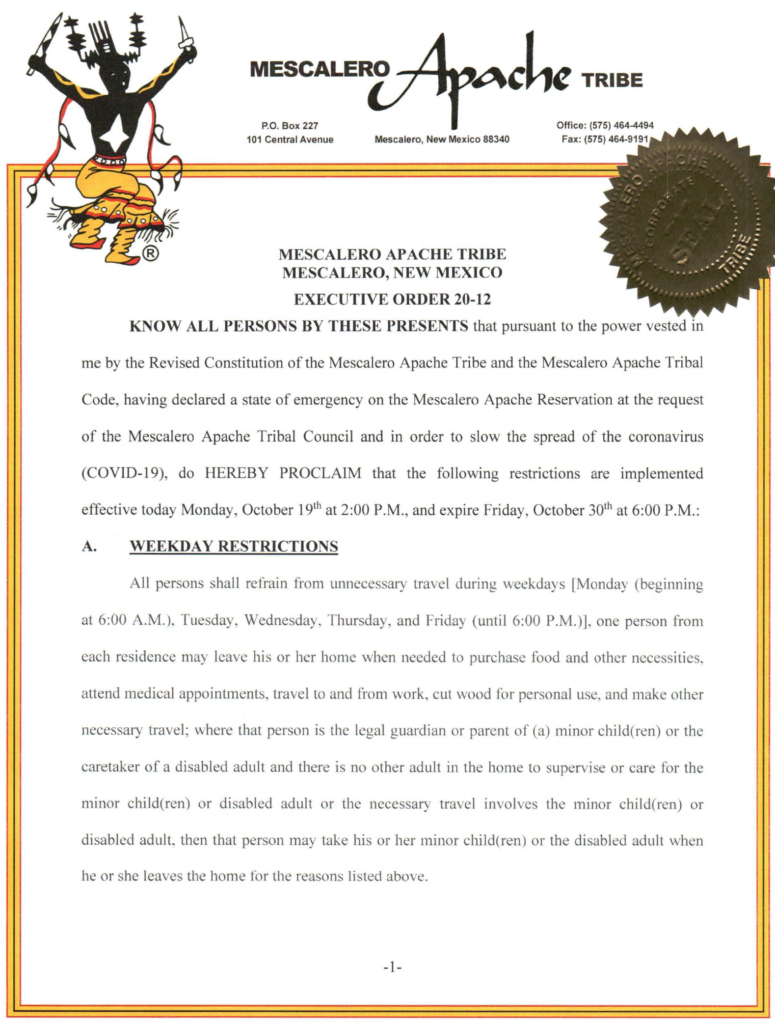
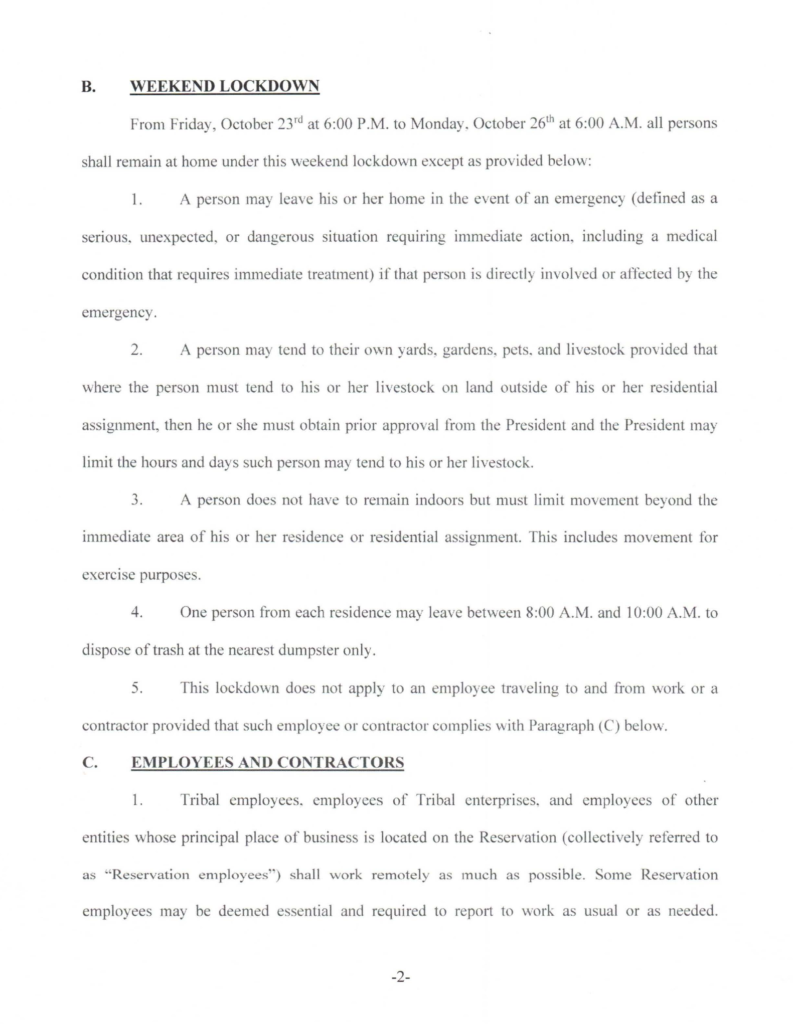
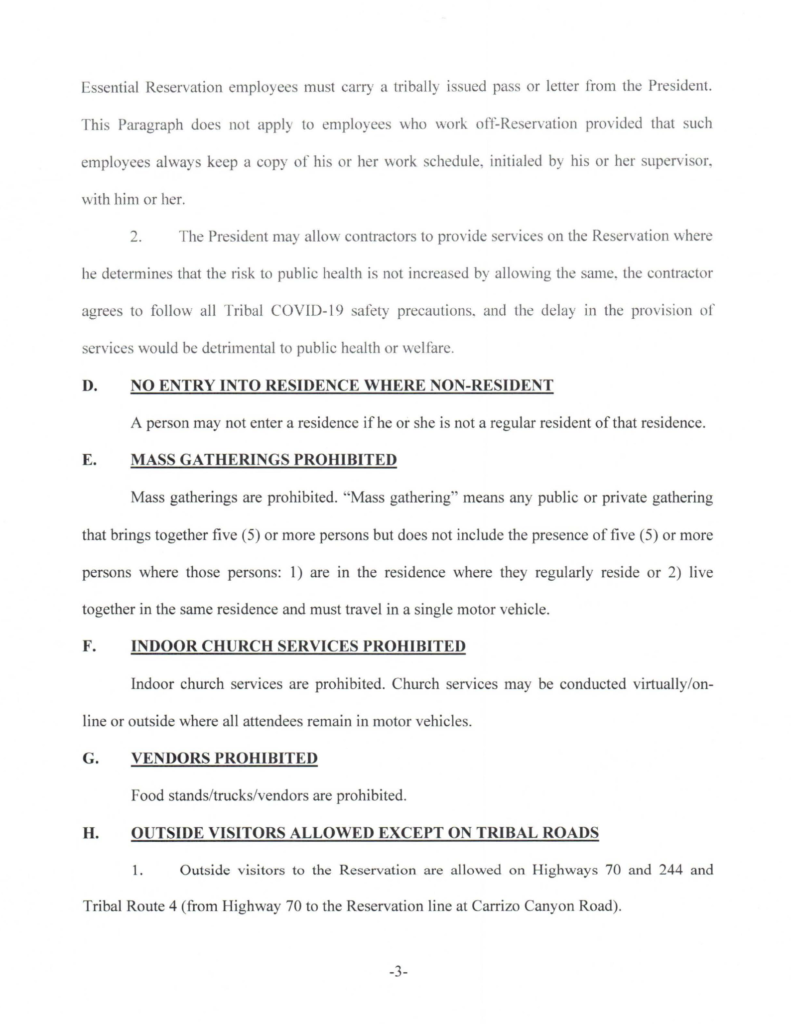
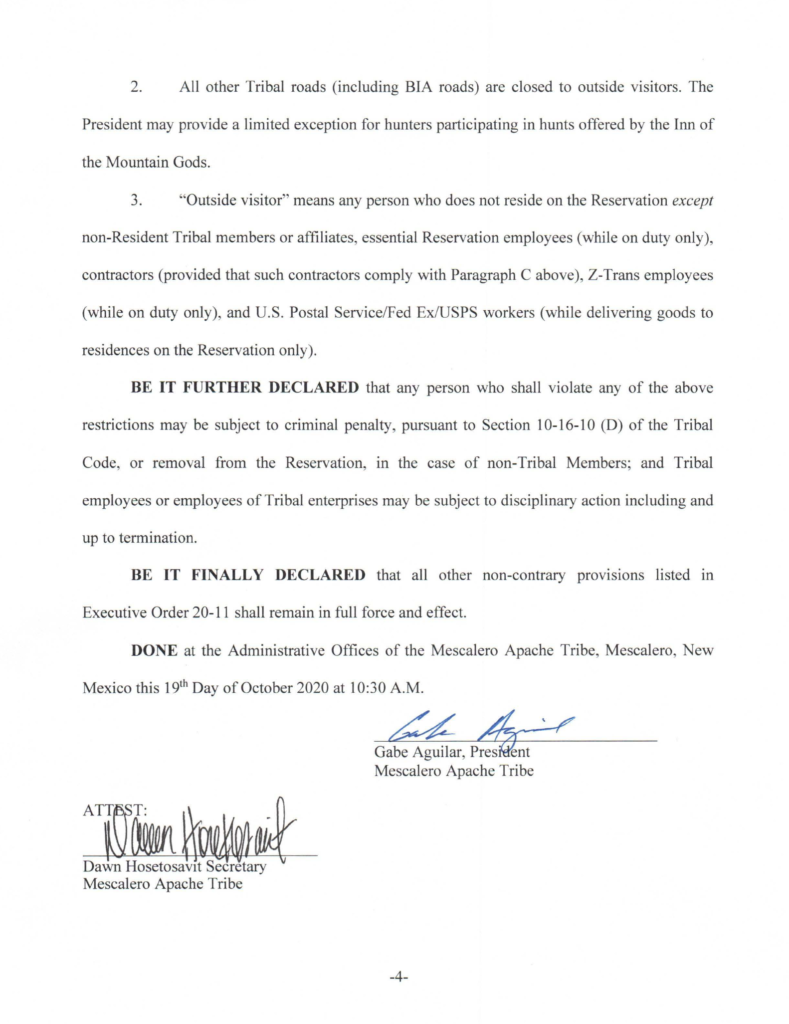
Summary of E.O. 20-12
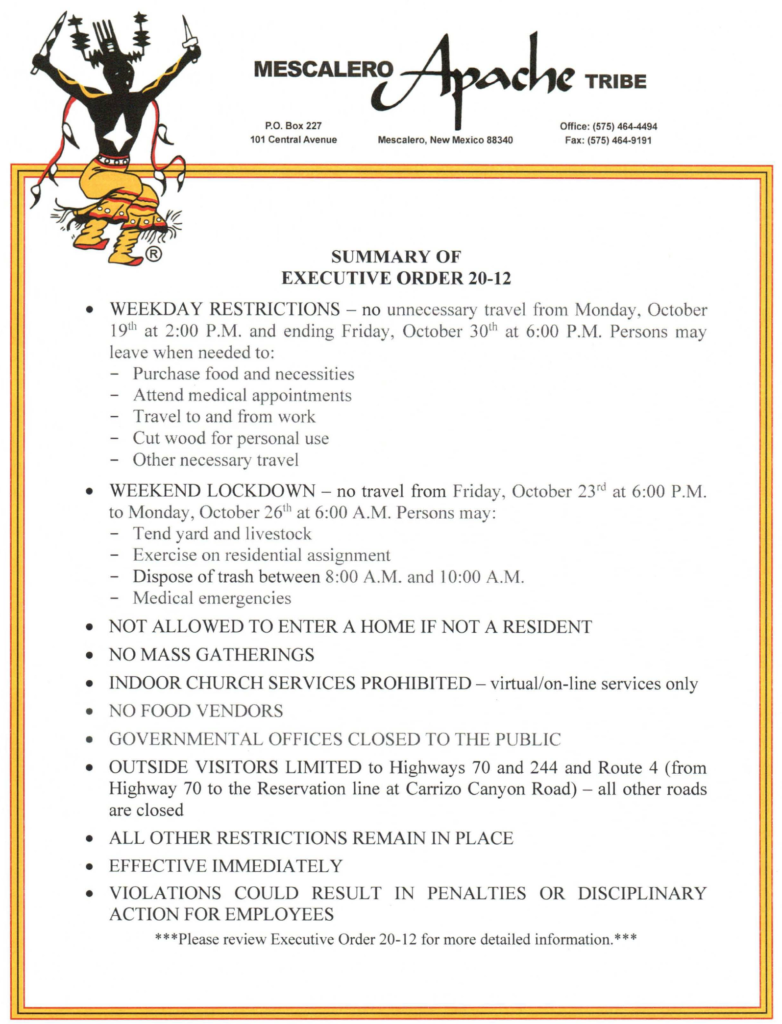
Important Dates during E.O. 20-12
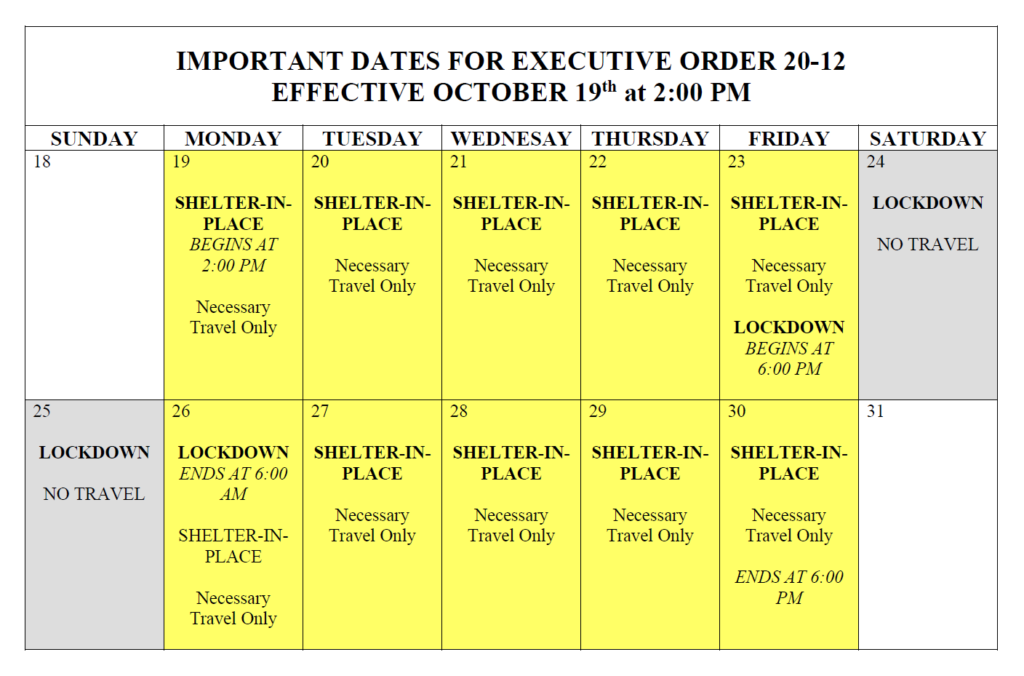
Executive Order 20-11
Find out more!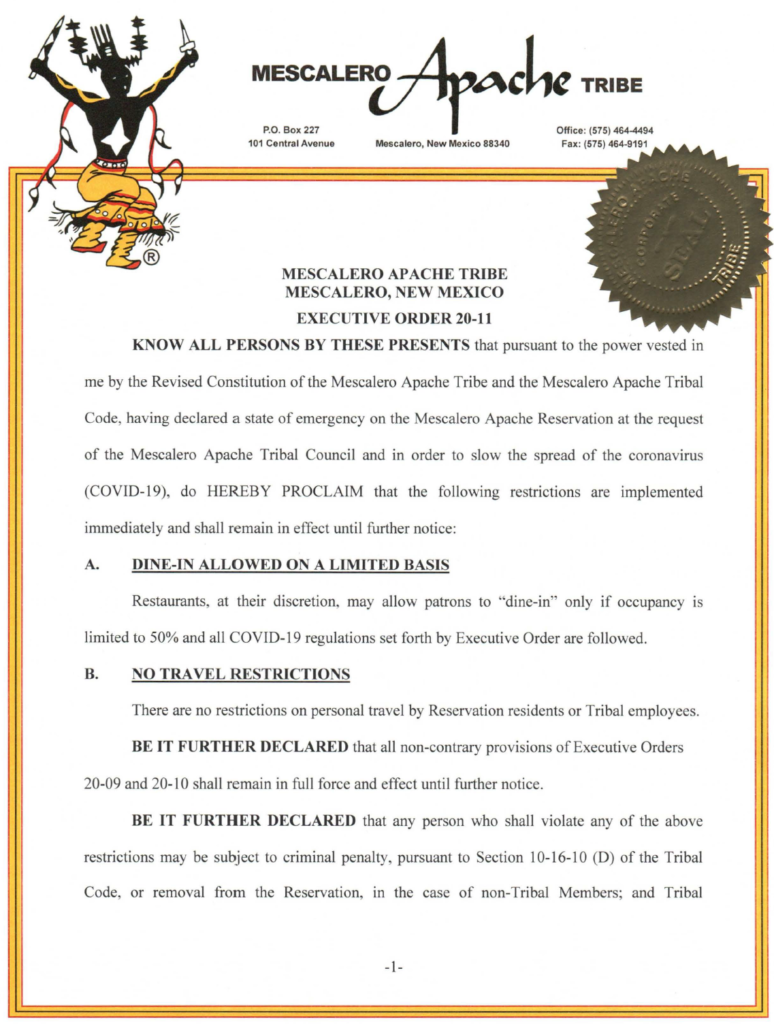
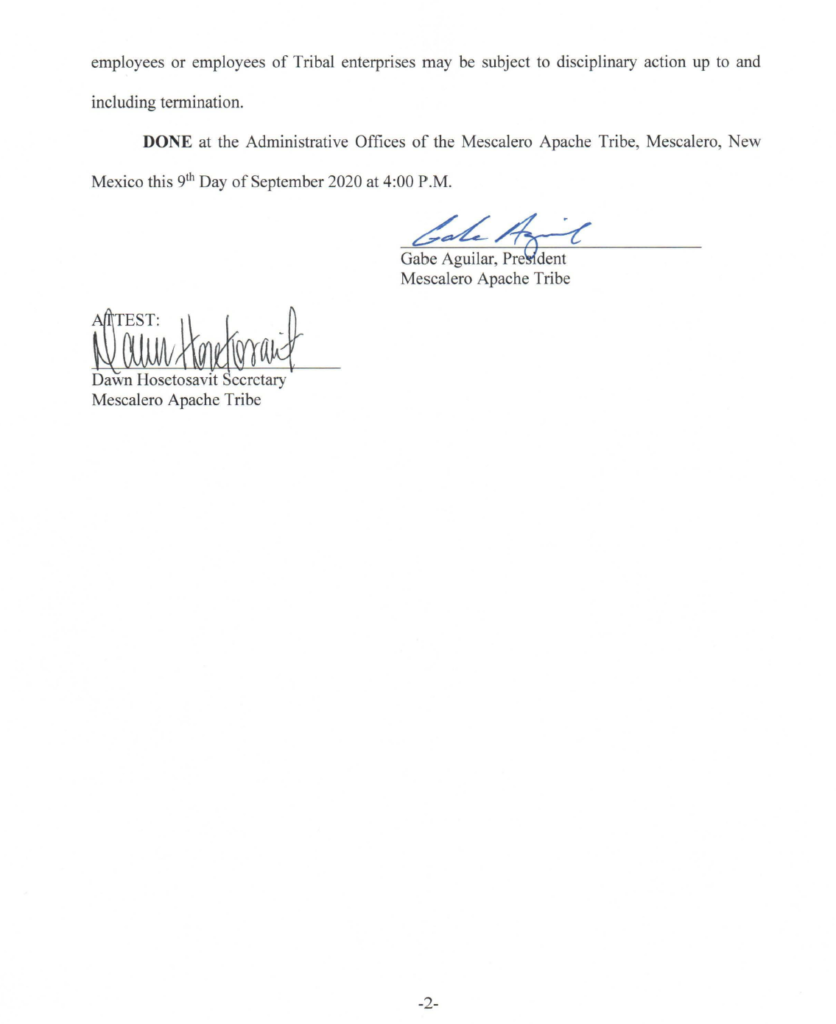
Summary
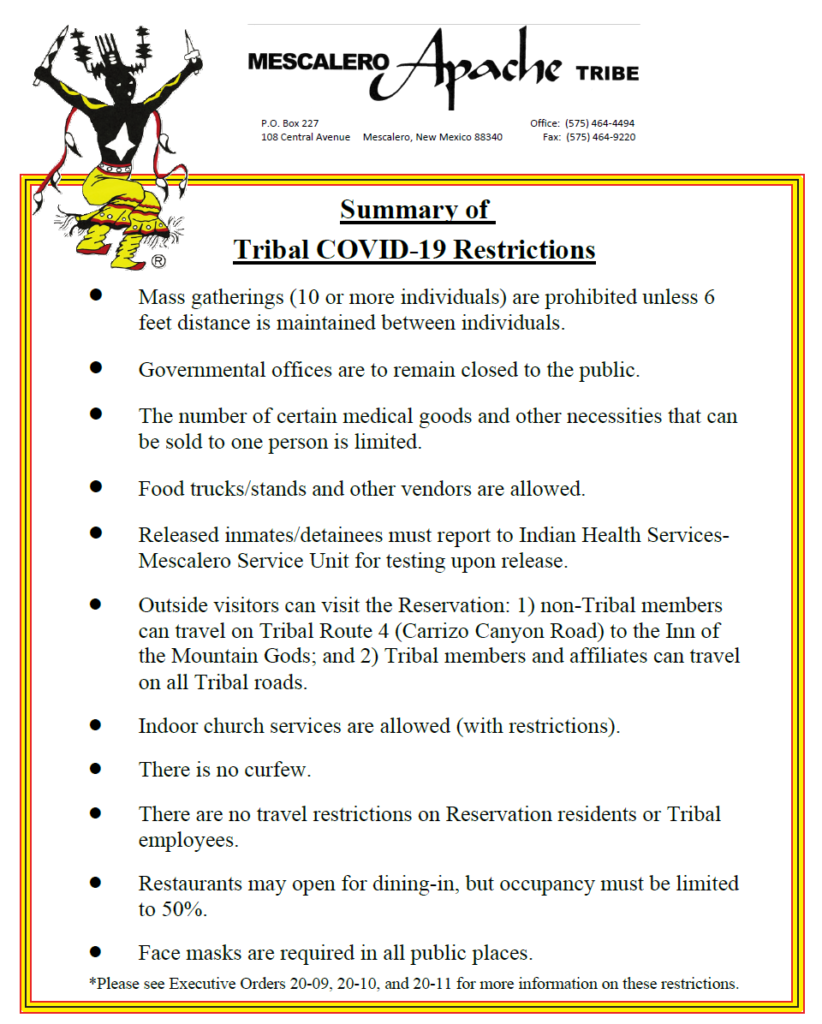
Mescalero Apache Tribe announces second corona virus death
Find out more!August 18, 2020. Earlier today, the Mescalero Apache Tribe announced the death of a Reservation resident, an elderly woman, from the corona virus (COVID-19). Tribal President Gabe Aguilar stated, “We are a small community and every death hurts. Our prayers are with the family.” The elderly woman who passed became sick several weeks ago and appeared to be on her way to a full recovery. President Aguilar commented, “She fought hard but in the end, she did not survive.”
This is the second death for the Tribe; the Tribe suffered its first coronavirus death, also an elderly woman, in late May. President Aguilar added, “We know the virus targets the elderly. The Tribe is doing everything we can to protect them and the community as a whole. And, we will keep working at it.” The Tribe has restricted access to the Reservation, mandated the use of facemasks in public and taken a number of other steps to curb the spread of COVID-19 on the Reservation.
The Tribe provides updates on its official website (www.mescaleroapachetribe.com[36]) and Facebook page.
Executive Order 20-09
Find out more!Executive Order 20-08
Find out more!
Executive Order 20-07 and Summary
Find out more!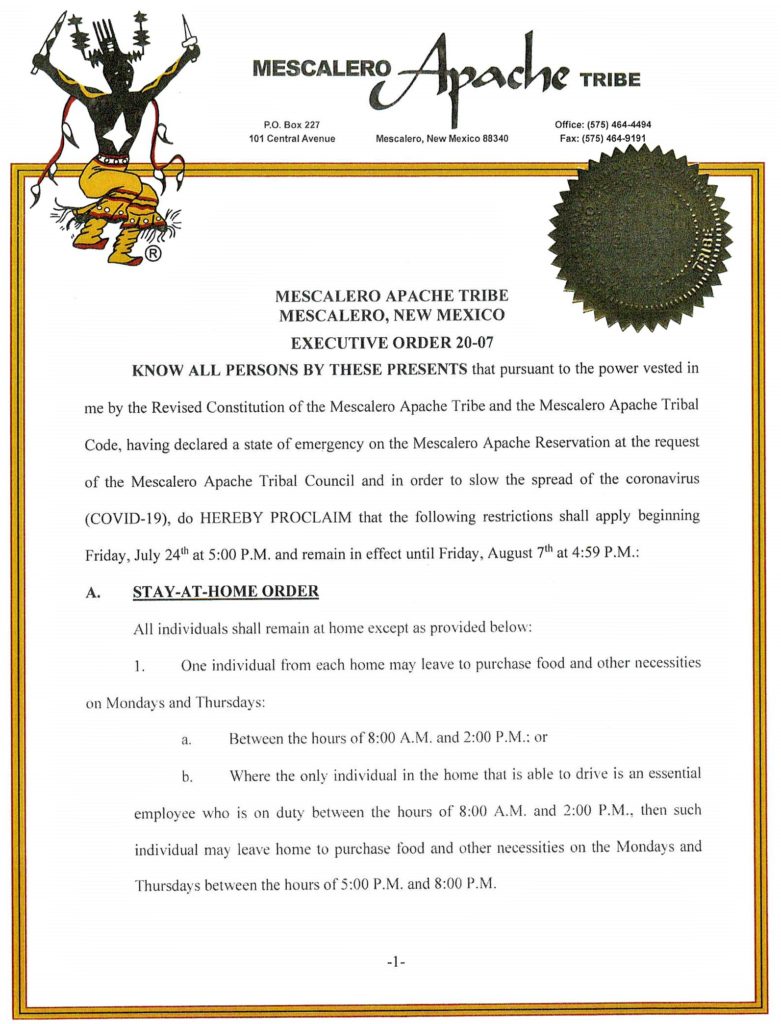
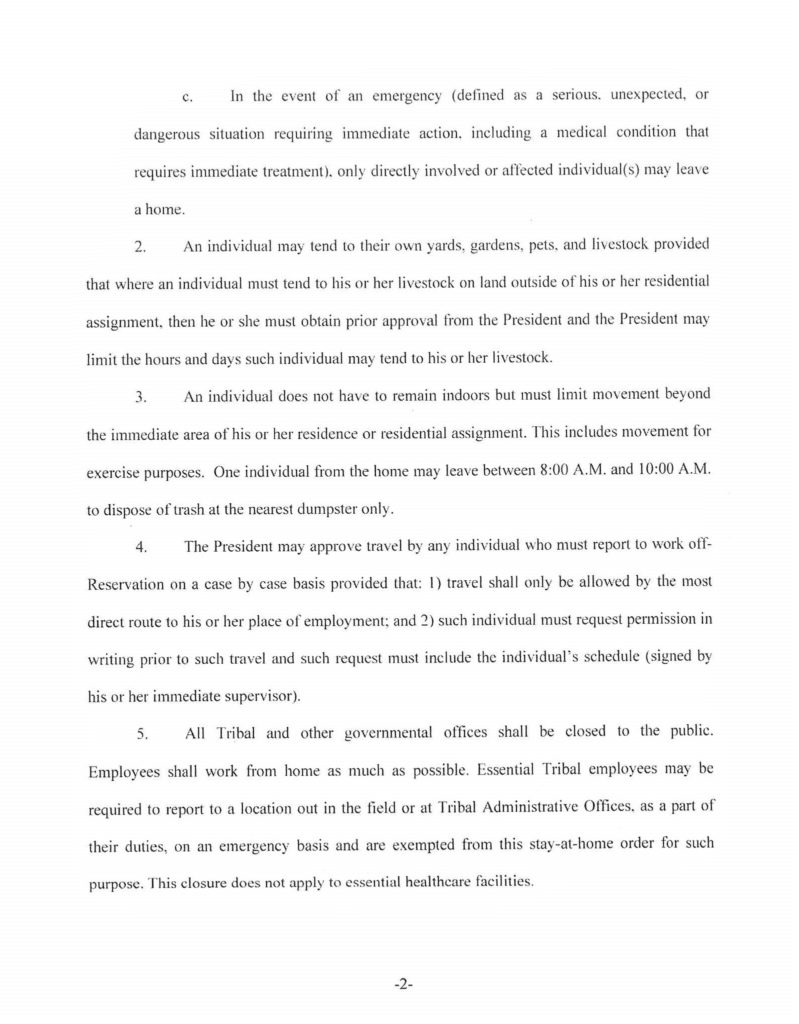
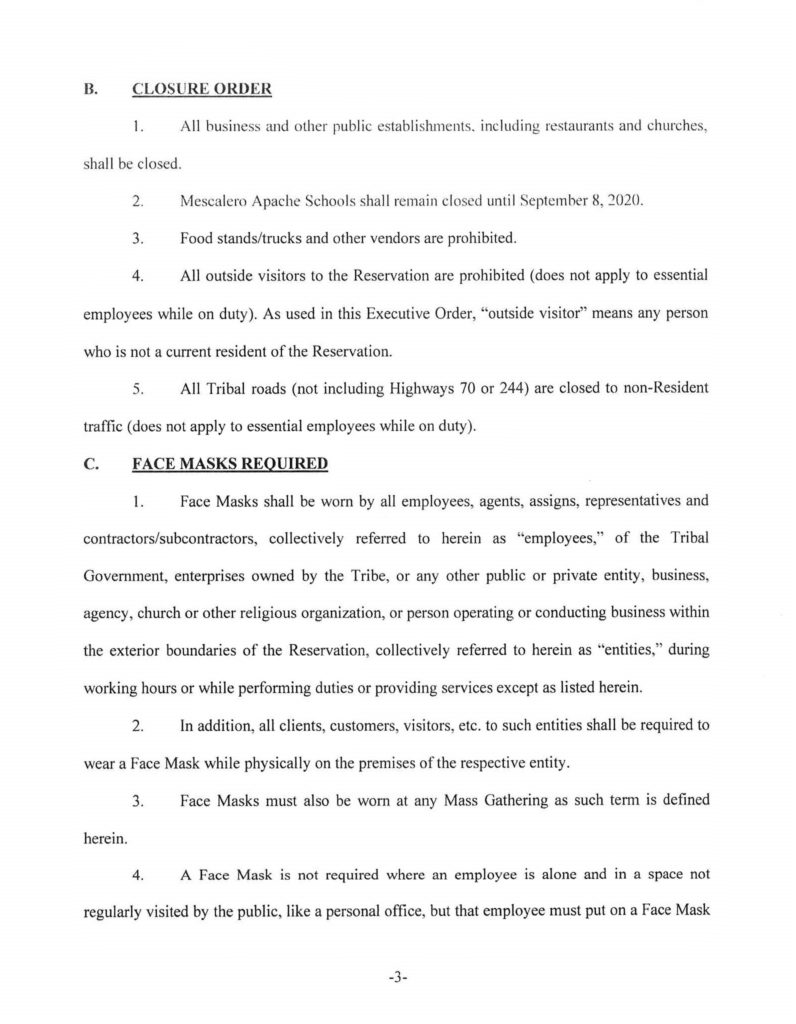
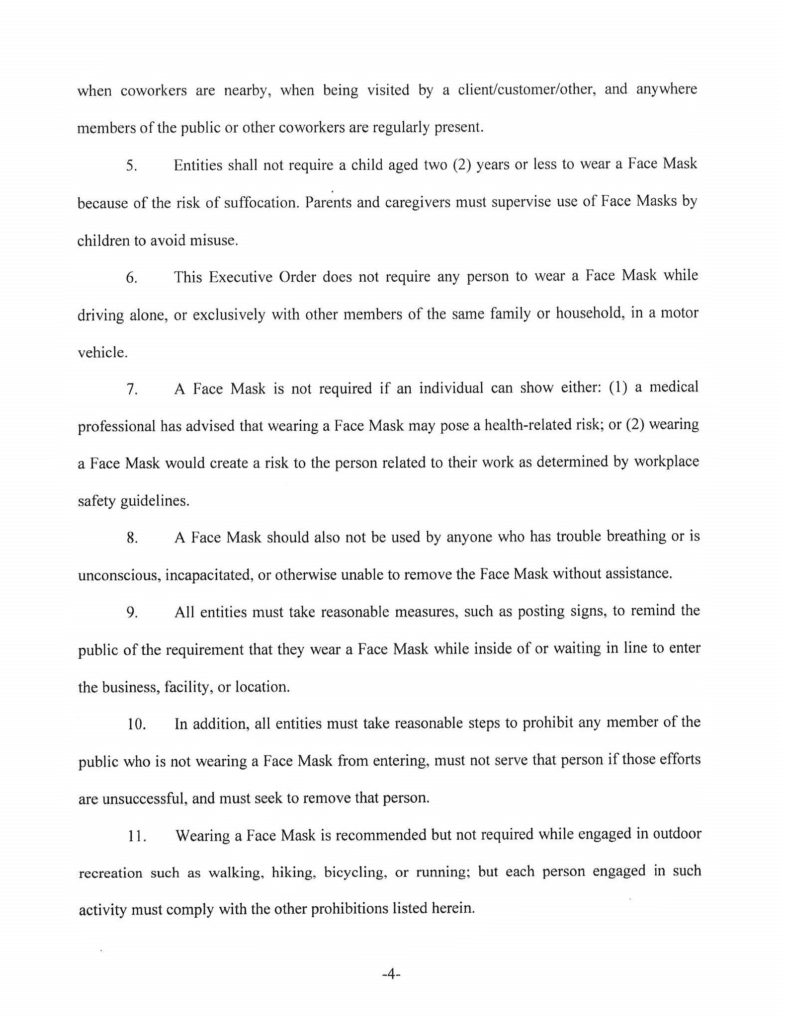

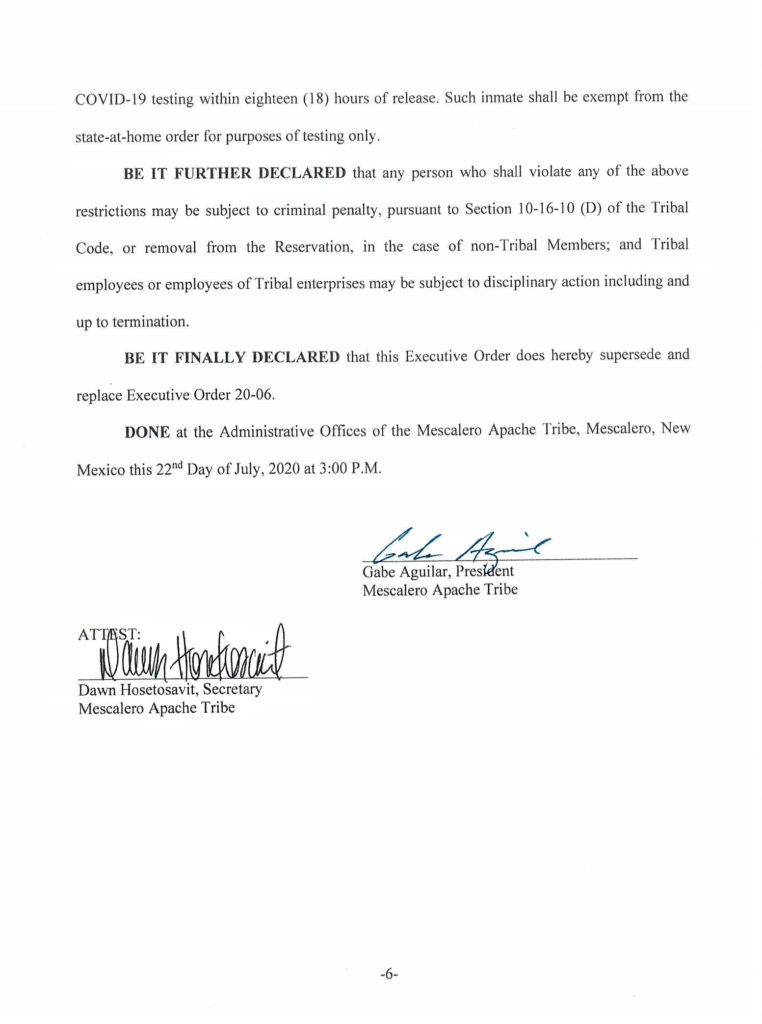
Summary of Executive Order 20-07
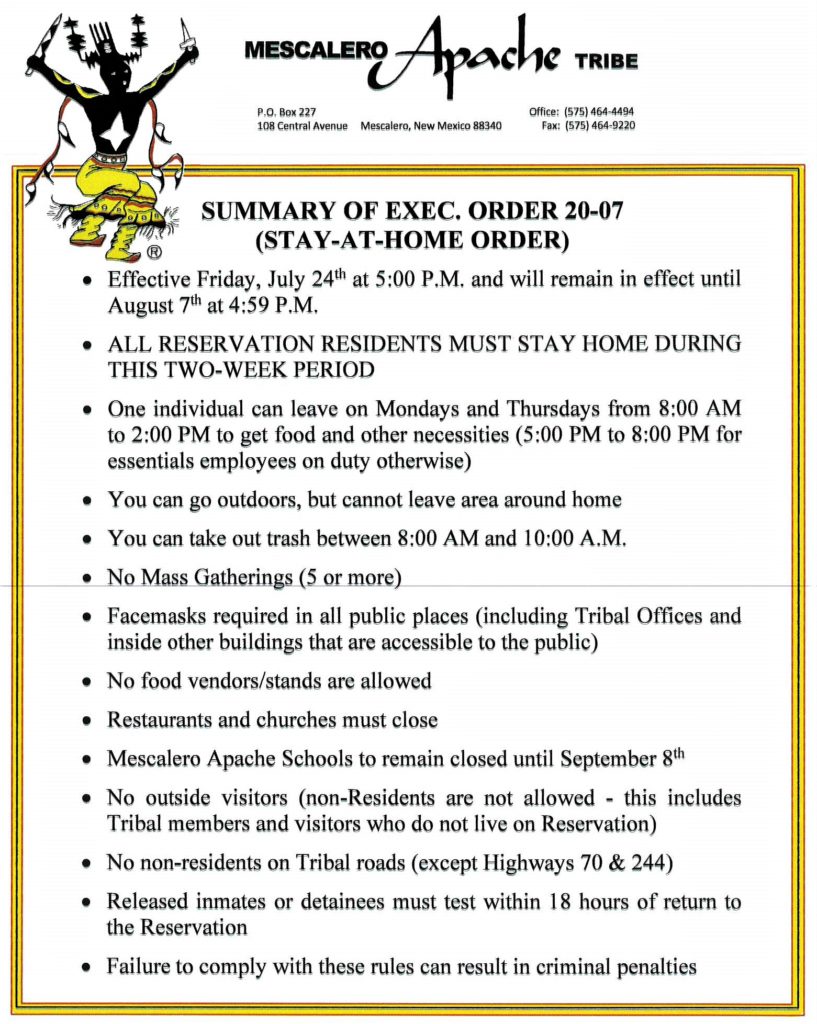
Tribal Member letter from President Aguilar
Find out more!Executive Order 20-06 and summary
Find out more!Mescalero Apache Tribe announces first Coronavirus death
Find out more!May 26, 2020. This morning, the Mescalero Apache Tribe announced the first death of a Reservation resident, an elderly woman, from the coronavirus (COVID-19). Tribal President Gabe Aguilar stated: “The individual that passed was the second resident to test positive. She was tested just hours after our first case was confirmed. It has been only a few days since the virus came to the Reservation. This virus moves quickly and targets our elders.”
The Tribe is entering its second day of a fourteen-day lockdown. Tribal offices and businesses on the Reservation are closed. Tribal residents will be cited if they do not comply with the lockdown. “The Tribe is being strict for a reason,” President Aguilar commented. “The Tribe has worked hard over the last two months to avoid this. I am heartbroken. The family is heartbroken. But we must keep going. We must come together to stop the virus.”
The Tribe will provide updates on its official website (www.mescaleroapachetribe.com[41]) and Facebook page.
Executive Order 20-05 signed by President Aguilar
Find out more!
Mescalero Apache Tribe announces second positive test for coronavirus on the reservation
Find out more!May 22, 2020. Last night, another Mescalero Apache Reservation resident tested positive for COVID-19. The resident is elderly and is hospitalized. This second positive case arose just hours after the Tribe’s first case.
“At this time, we need to come together as a community. Stay home. Wear a facemask. If you are contacted for testing, then please comply. If you may have been exposed, please contact Indian Health Service or the Tribe immediately,” Tribal President Gabe Aguilar stated. He added, “Our first case was discovered because the person came in on their own – they did the right thing. You need to as well. Think about your community.”
President Aguilar indicated that the Tribe will be issuing citations for violations of the Tribe’s coronavirus restrictions. President Aguilar commented, “We will be pushing for maximum penalties. We are taking this very seriously.”
The Tribe will provide updates on its official website (www.mescaleroapachetribe.com) and Facebook page.
Mescalero Apache Tribe announces first positive test for coronavirus on the reservation
Find out more!May 21, 2020. Earlier today, the Mescalero Apache Tribe was informed that a Reservation resident tested positive for COVID-19. The resident is not exhibiting symptoms and tested voluntarily. The resident will be quarantined and monitored closely.
President Gabe Aguilar asked Tribal members to stay calm: “We are doing everything we can to make sure that the individual that tested positive receives appropriate treatment and that the individual is isolated. There is no immediate threat to your safety. Please continue to follow the Tribe’s Executive Orders and health expert recommendations for social distancing, face masks, and hand washing.”
While most of Indian Country had been hit hard by the coronavirus, the Mescalero Apache Tribe was one of the only tribes in the country to have zero positive cases until today. The Tribe’s COVID-19 Response Unit has been meeting since mid-March to develop isolation plans and make other preparations. President Aguilar stated, “We were blessed to have gone so long with zero cases. I am proud of my community for stepping up. Because of your efforts to stay safe, we were able to prepare for this day.”
The Tribe will provide updates on its official website (www.mescaleroapachetribe.com) and Facebook page.
Mescalero receives $13.5 million in Coronavirus Relief Funding
Find out more!May 14, 2020. Recently, the Mescalero Apache Tribe received $13.5 million to address the coronavirus (COVID-19) pandemic. The funding was provided to Mescalero through the Coronavirus Aid, Relief, and Economic Security Act (“CARES Act”), passed by Congress on April 22nd. The CARES Act set aside $8 billion from the Coronavirus Relief Fund (“CRF”) for specifically for tribes. The U.S. Treasury Department released 60% of the CRF funding to tribes last week. The amount of funding received by each tribe was determined by population. “The Tribe is grateful for this money. We closed our casino to stop the spread of the coronavirus in our community and in neighboring communities. Now we have almost zero revenue coming in. We have to keep our community safe until this is over – the need for this money is huge,” stated Mescalero Apache Tribal President Gabe Aguilar.
Mescalero advocated for flexible rules for how the CRF funding could be used. But the Treasury Department issued strict guidelines governing the use of the funding. President Aguilar noted: “The Tribe has many needs and some of these needs result indirectly from COVID-19. These are legitimate needs, but this funding cannot be used.” He continued, “I know people will think that we can spend the money on anything we want – I want it to be clear that this money is restricted to COVID-19 needs”.
In line with these guidelines, yesterday, the Mescalero Apache Tribal Council, using its CRF funds, established an economic support program where each eligible Tribal member over the age of eighteen (18) can receive a $1,000 economic support payment. “This payment can be used to pay for food, electricity and other needs. Everyone is suffering the economic impacts of COVID-19. Please apply as soon as possible,” stated President Aguilar. Payments will be made by June 1, 2020.
The remaining 40% of the tribal funding in the CRF will be allocated depending on the outcome of a lawsuit filed by several tribes against the federal government. The lawsuit revolves around the issue of whether Alaskan Native Corporations are eligible to receive funding from the CRF or not. The Treasury Department has indicated that the remaining funding will be allocated according to factors like the number of individuals employed by and the annual revenue of each tribe. Mescalero opposes the possible distribution of monies from the CRF to ANCs and previously called for the resignation of the Department of Interior’s Assistant Secretary of Indian Affairs, Tara Sweeney, for her involvement in efforts to include ANCs.
**Copies of the application will also be available at the Tribal Offices. APPLICATION DEADLINE EXTENDED TO MAY 26, 2020 BY NOON.
Mescalero reservation roads closed to non-residents
Find out more!April 6, 2020. Last week, Mescalero Apache Tribal President Gabe Aguilar issued Executive Order 20-02 effectively closing the Reservation to non-residents. This action comes after the Tribal President proclaimed a state of emergency at the request of the Mescalero Apache Tribal Council.
“We see what is happening in other tribal communities and across the State of New Mexico,” President Aguilar commented. He continued: “We know that people love to visit our beautiful Reservation. This is especially true during this time of year. But the Tribe must do everything it can to encourage people to stay home.”
Non-residents traveling on tribal or BIA-maintained roads, including Carrizo Canyon Road/BIA Route 4 (from the Reservation boundary line by Carrizo Lodge to Highway 70), will be stopped and escorted off the Reservation. In addition, fines and fees could be assessed. This closure does not apply to U.S. Highways 244 or 70.
Executive Order 20-02 remains in effect until further notice.
Related Tribal Information:
**MESCALERO RESIDENTS**
Lock your home and vehicles! If you see suspicious activity, report it to BIA Dispatch 575-464-4479. Burglaries are increasing around the community.
Parents: Keep your child(ren) at home with you or a responsible adult.
A reminder from Chief Vepley, Mescalero BIA
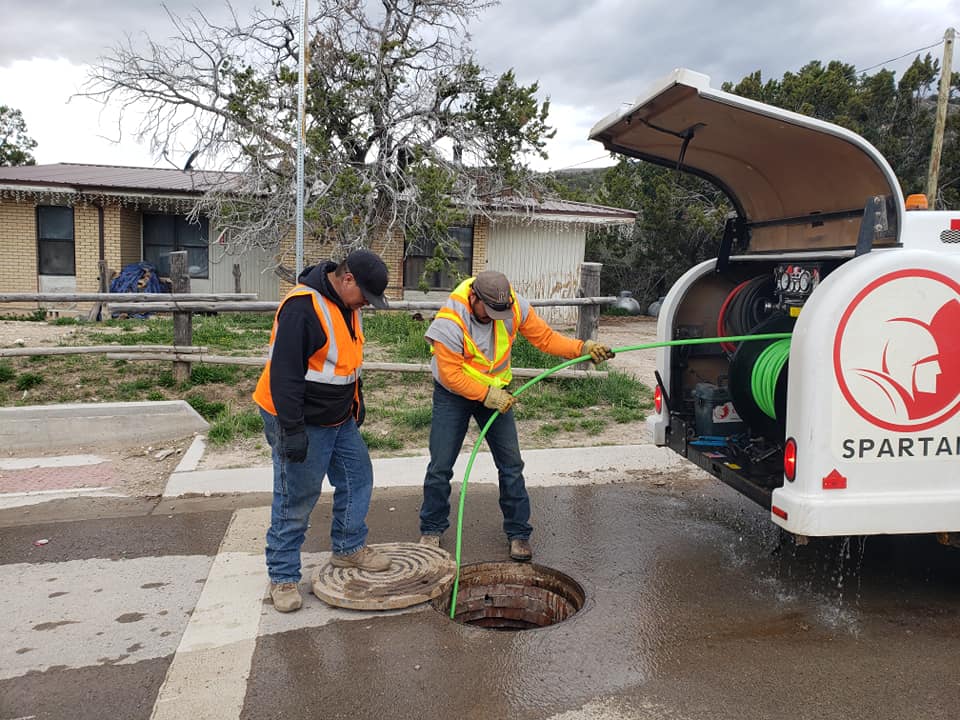
ATTENTION: Due to the COVID-19 pandemic, people are turning to other paper products for sanitary needs. The Mescalero Utilities Department is asking that residents please refrain from flushing wipes, paper towels, disinfecting wipes and similar products down the toilet. These products are not flushable and are causing sewer clogs and backups.
PUBLIC NOTICES from Tribal Departments & Mescalero Agencies:
- Public Defender PUBLIC NOTICE (11-09-20)[55]
- Gas Company PUBLIC NOTICE (11-06-20)[56]
- Social Services PUBLIC NOTICE (11-09-20)[57]
- Tribal Finance (Accounting) PUBLIC NOTICE (11-09-20)[58]
- Tribal Maintenance PUBLIC NOTICE (11-09-20)[59]
- Tribal Court PUBLIC NOTICE (11-09-20)[60]
- VAWA memo (07-29-20)[61]
- Gas Company NEW TEMP HOURS (07-28-20)[62]
- Tribal Court NEW TEMP HOURS (07-28-20)[63]
- Tribal Court PUBLIC NOTICE (06-23-20)[64]
- Mescalero Education Department (06-23-20)[65]
- Tribal Court Announcement (05-27-20) [66]
- Accounting PUBLIC NOTICE (05-26-20)
- Mescalero VAWA PUBLIC NOTICE (05-26-20)
- Elderly Program (05-26-20)
- CHR PUBLIC NOTICE (03-27-20)
- Human Resources
- Child Support Enforcement Office
- Tribal Court PUBLIC NOTICE (03-19-20)
- BIA – Mescalero Agency NOTICE (03-24-20)
- Mescalero Conservation Department PUBLIC NOTICE (03-19-20)
- Fish Hatchery PUBLIC NOTICE (03-19-20)
Other Important Information:
- CDC – Centers for Disease Control and Prevention
- WHO – World Health Organization
- First COVID-19 confirmed case in Lincoln County, NM[67]
- Operations at Silver City, Ruidoso eateries endangering public health: https://www.env.nm.gov/wp-content/uploads/2020/05/2020-05-22-Food-permits-suspended-.pdf[68]
Mescalero IHS Information
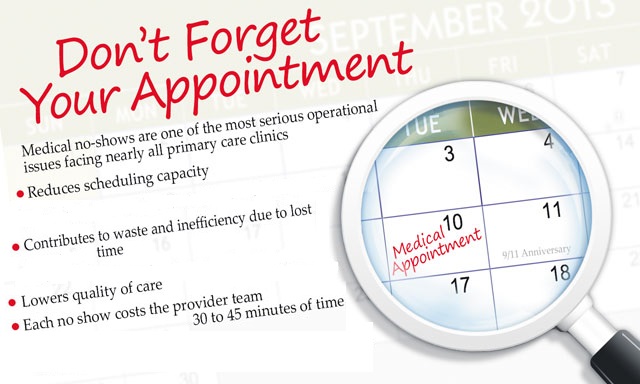
Norovirus Outbreak
The NM Dept of Health (NMDOH) has noticed an outbreak in norovirus cases. Norovirus is a “stomach bug” that can cause nausea, vomiting, diarrhea, flu-like symptoms (fever, chills, sweats, viral muscle aches, fatigue), and potentially dehydration. It is spread from one person who has norovirus to an uninfected person, most commonly through sharing food & drink items, but can also be spread through contact of infected droplets of vomit or diarrhea. Risk of obtaining norovirus can be decreased with proper hand hygiene. There is no cure– norovirus goes away with time. Please note that antibiotics never treat a viral infection such as norovirus, as antibiotics only treat bacteria. If you do get any stomach virus, the most important treatment is to maintain hydration using clear bland fluids that your stomach can tolerate. If we do see you in clinic for any stomach virus, we can provide nausea medications for you to take home. It is important to seek medical care immediately if you are unable to maintain hydration on your own. If a household member or close contact becomes ill with a stomach virus: surfaces, clothing, and linens should be disinfected to prevent spread. (Clean surfaces with bleach-based cleaners. Wash clothes & linens with detergent and hot water, then dry on the hottest temperature cycle.) You can visit the CDC page for more information on norovirus: https://www.cdc.gov/norovirus/about/index.html[71]
Mescalero IHS Update
Today, the U.S. Food and Drug Administration expanded the emergency use authorization (EUA) for the Pfizer-BioNTech COVID-19 Vaccine for the prevention of coronavirus disease 2019 (COVID-19) caused by severe acute respiratory syndrome coronavirus 2 (SARS-CoV-2) to include adolescents 12 through 15 years of age.
Mescalero Service Unit will begin scheduling appointments for this age group on 05/19/2021. Please call 575-464-4441 for an appointment.
Link: https://www.fda.gov/…/coronavirus-covid-19-update-fda…
Updated EUA Fact Sheet:
Thank You,Helen Chavez, ACEO
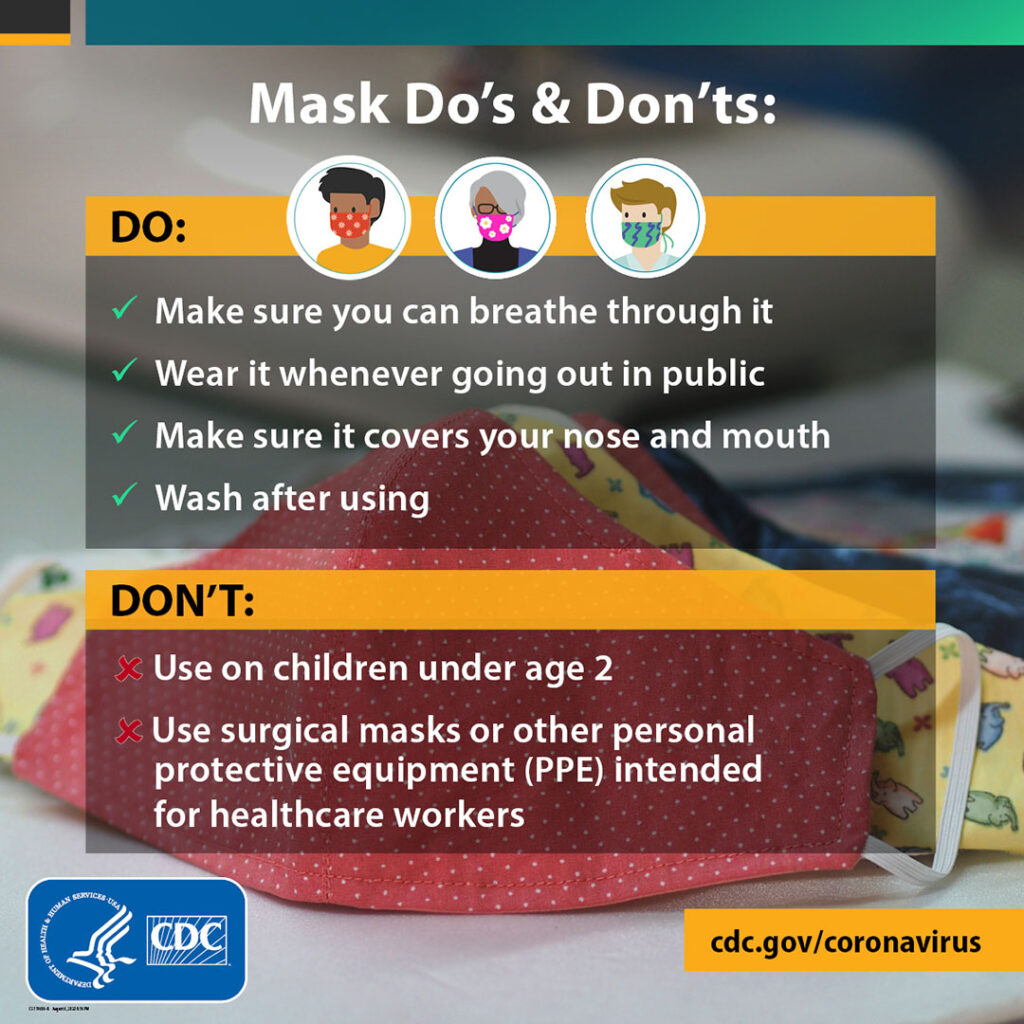
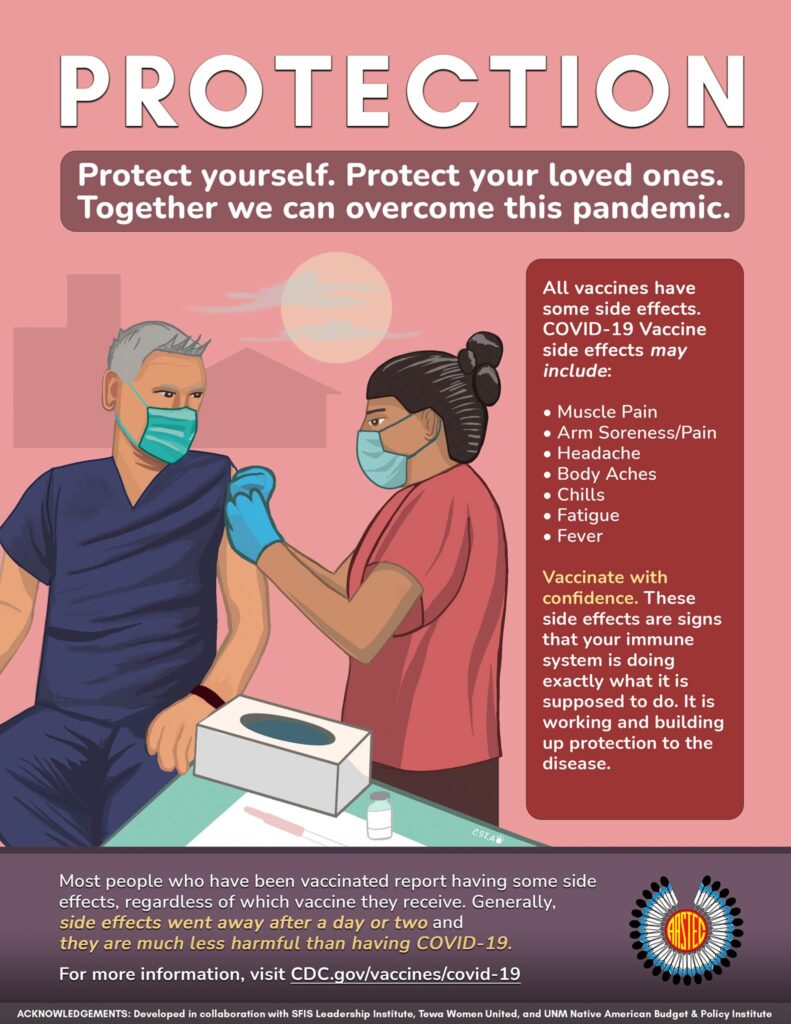
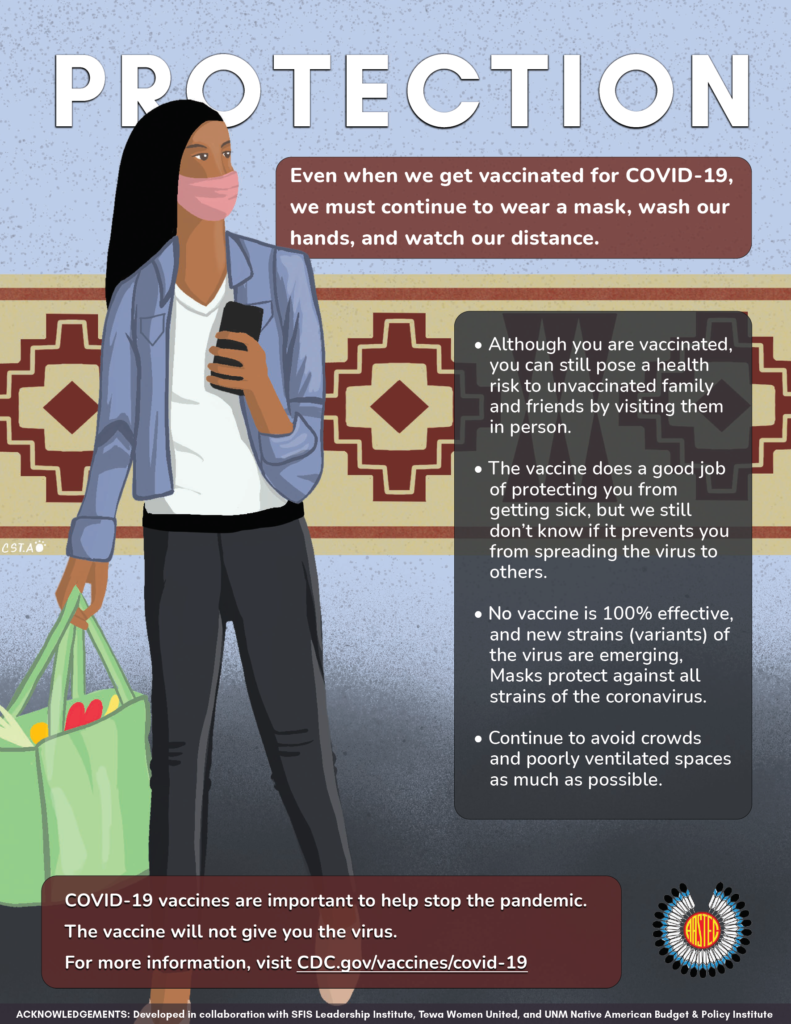
Call to schedule your COVID-19 vaccination RIGHT NOW
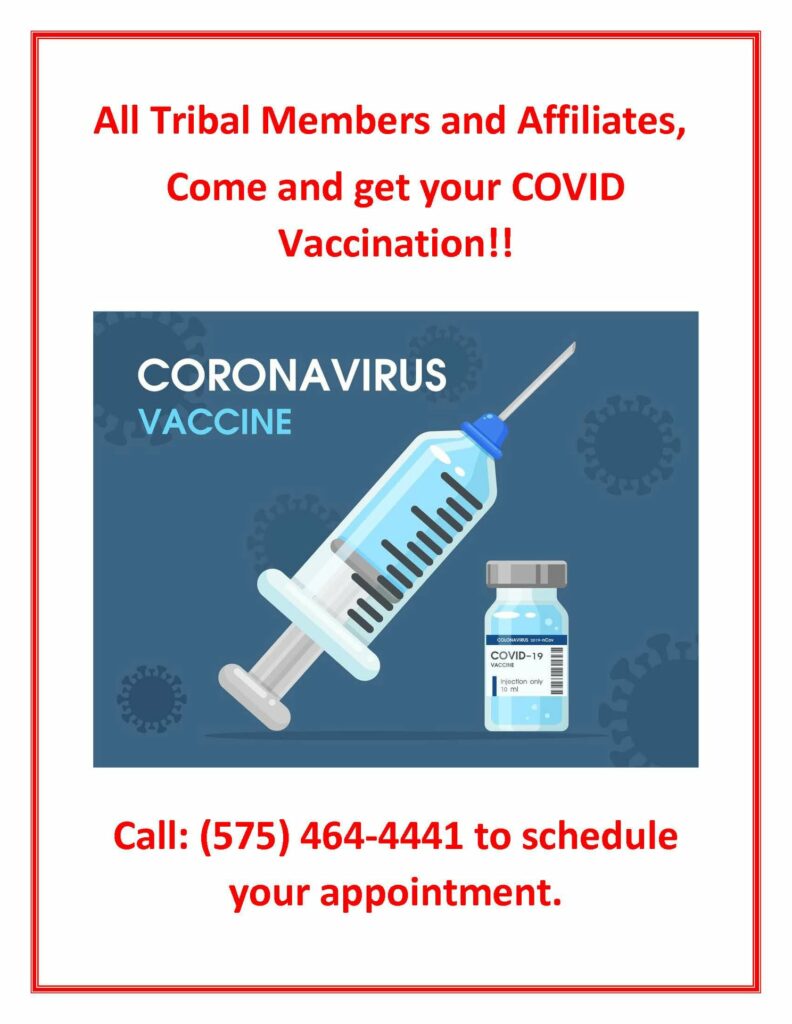
What is Monoclonal Antibody Infusion? Mescalero IHS has the answers.
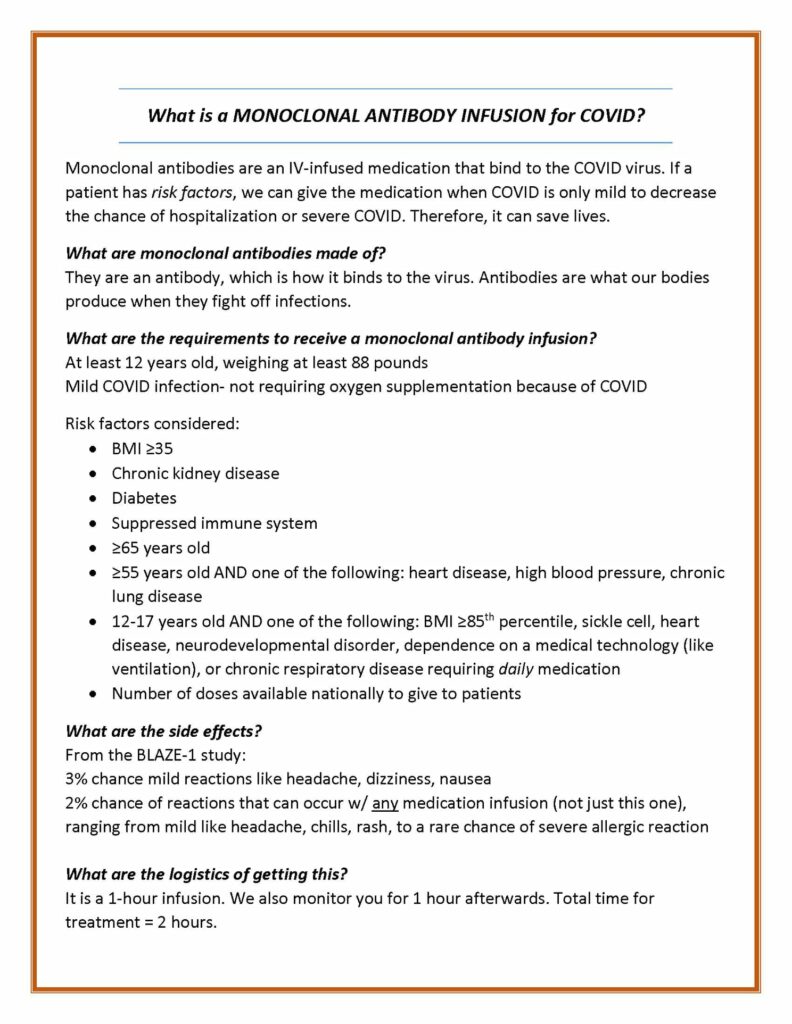
FAQ for COVID questions Mescalero Service Unit commonly receives:
Question: What are the COVID precautions once I complete my COVID vaccine and its 3-4 week booster shot?
Answer: Recommendations from the CDC are to continue all COVID precautions including masks, social distancing, & hand hygiene even if you complete vaccination. Recommendations may not change until vaccines are made available to the entire U.S. population (though vaccine availability does increase week by week). These CDC recommendations can be found in their vaccine FAQ on https://www.cdc.gov/coronavirus/2019-ncov/vaccines/faq.html[72]
Question: What are COVID testing recommendations after I have already recovered from COVID?
Answer: COVID testing, after recovery from COVID, is not recommended for 3 months after having unless symptoms occur. Although COVID test results return to normal for most patients, there is a statistically significant portion of the population who will maintain a false positive COVID result for up to 90 days after having COVID, despite full recovery and no longer being infectious. This is because COVID testing detects both live and dead virus. Those that recover from COVID are also recommended to not be isolated or quarantined if they become a COVID contact within 3 months after their recovery from COVID, unless they develop symptoms.
Per the CDC: “People who have tested positive for COVID-19 within the past 3 months and recovered do not have to quarantine or get tested again as long as they do not develop new symptoms. People who develop symptoms again within 3 months of their first bout of COVID-19 may need to be tested again if there is no other cause identified for their symptoms.” https://www.cdc.gov/coronavirus/2019-ncov/if-you-are-sick/quarantine.html[73]
Question: What if I am lacking what I need during quarantine or isolation?
Answer: The elderly center and CHR have teamed up during COVID to provide food, supplies, toiletries, & delivery of these these plus your MSU medications. Do NOT leave your home during quarantine or isolation other than for urgent medical care. The elderly center and CHR are available Mon-Fri 8am – 4:30 pm at 464-1614. If you need non-urgent medical advice, please call MSU via our main number, 464-4441. If having a medical emergency at any time please call 911.
Quarantine/Isolation Patients
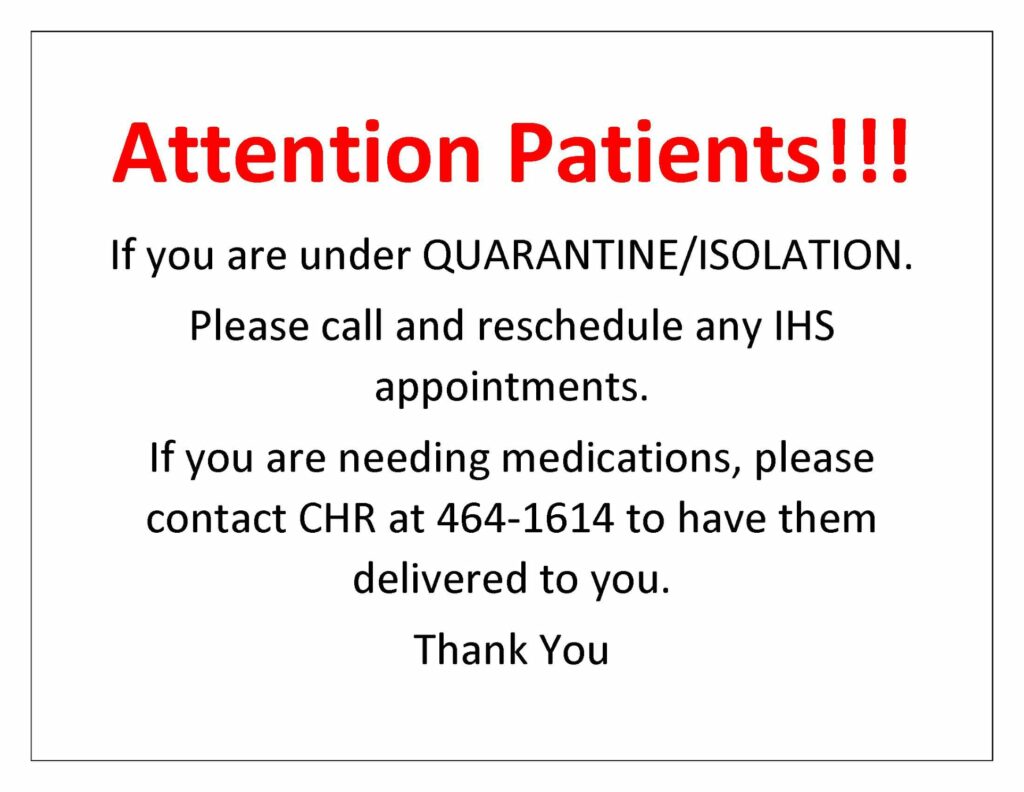
Important Information
Find out more!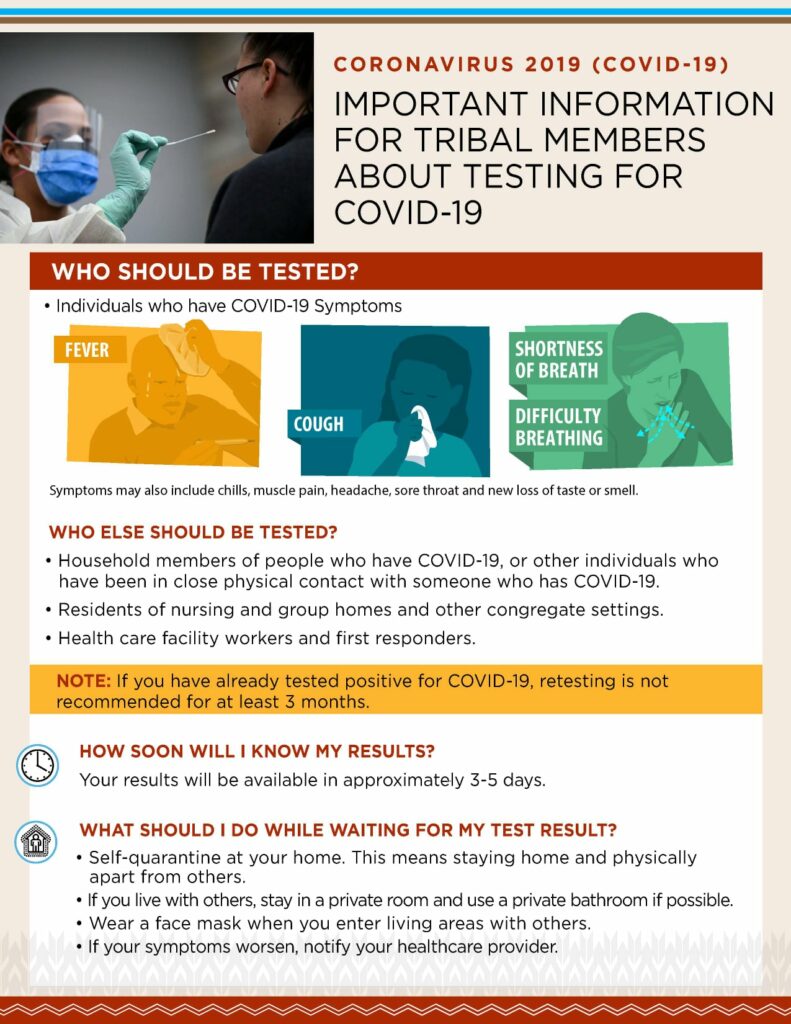
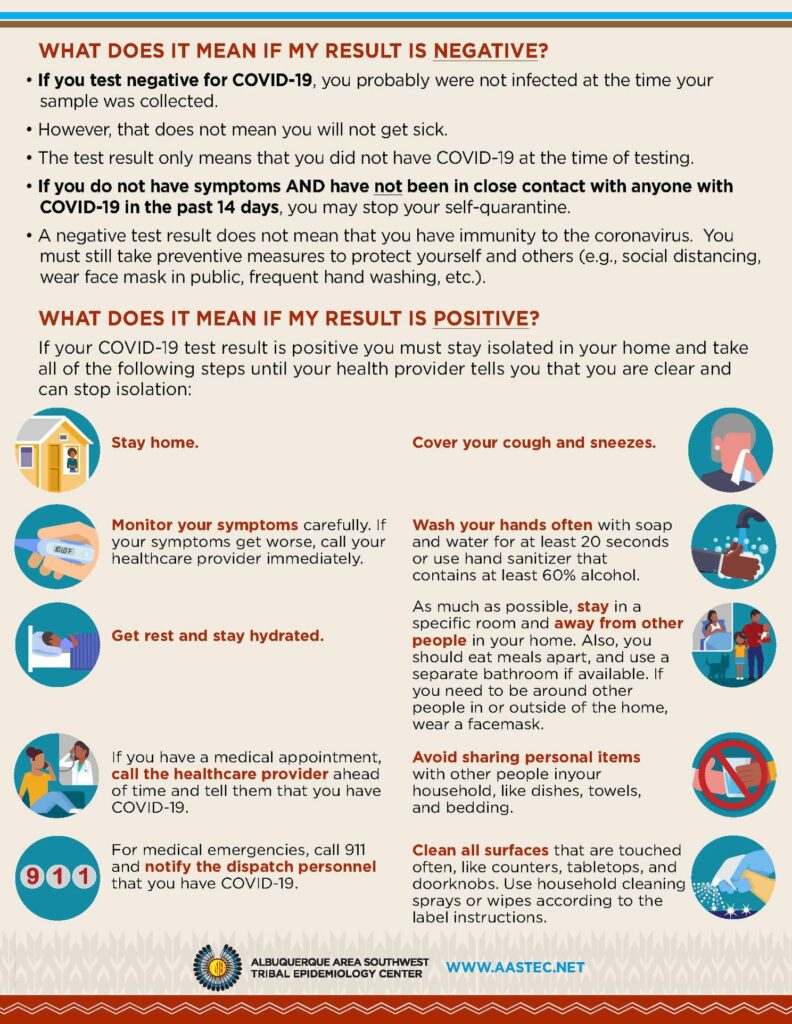
Pharmacy Hours
Pharmacy will be extending their weekday medication pickup hours: Mon-Fri 8 A.M. now through 6:30 P.M. In order to ensure all your meds are processed before arrival, we ask that you call a day ahead of time to process refills. Thank you & stay safe!
Canopies at IHS
We have now installed a few covered parking spots for curbside medication pick-up, as well as a few covered spots for patients being seen in clinic. Please be aware that each canopy is meant to fit 2 cars. There is 1 canopy for an over-sized truck at the farthest shaded spot. Please be careful when pulling your car in, as our new painted parking lines have been realigned for the canopies.
Mescalero IHS COVID screening requests for asymptomatic patients:
Starting on Monday, June 22, MSU will provide “drive-through” testing for COVID at our back upstairs/north parking lot. These appointments will be SCHEDULED, as there will be 4 available appointments for 9 A.M., and 4 appointments for 9:15 A.M. These appointments will be available Mondays, Tuesdays, Thursdays, and Fridays (that are not federal holidays). Please call our nurse triage line via our main phone number, 464-4441, if you need to schedule an appointment to test for Covid-19.
Mescalero IHS is conducting COVID-19 testing!
Monday, Tuesday, Thursday and Friday; 8am – 4:30pm
*COVID testing on Wednesday’s are 1pm-4:30pm*
Mescalero Hospital will be going back to its former schedule of Wednesday morning closures. This will start on Wednesday, June 3.
Metformin
There has been community concern about the recall of metformin. We would like to remind you that medication recalls involve specific numbered lots. This is important because the recalled metformin lots are NOT ones that we carry– our specific numbered lots of metformin have NOT been recalled. Please pass this on to anyone you know who is concerned about this. Thank you!
Dental Care at Mescalero IHS
Find out more!Mescalero IHS has offered PORCH VISITS and/or DRIVE THRU dental checks & fluoride for children due to family needs during online schooling. For more information, call dental at 464-3832.
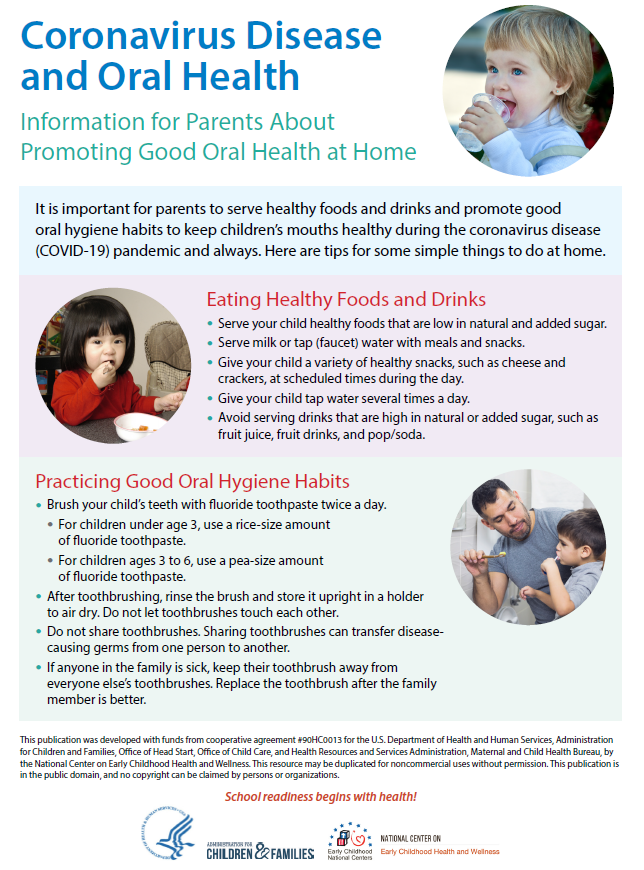
CDC update as of 5/12: Learn to minimize your COVID risk if you are in a higher-risk group. This includes those with diabetes, asthma, lung disease, liver disease, kidney disease with dialysis, and more.
[expand title=”Find out more!“]https://www.cdc.gov/coronavirus/2019-ncov/need-extra-precautions/groups-at-higher-risk.html[76] [/expand]Reminder from IHS Referral Dept.: Please call them directly at 464-3804 within 72 hours of any ER visit. Emergency rooms do not always notify us of your visit. Thank you!
Prenatal Care
Find out more. https://www.nichd.nih.gov/health/topics/preconceptioncare[77]
Referrals and Drop Offs at IHS
Find out more.
Curbside Medication at IHS
Find out more.
Learn how to use Cloth Face Coverings here.
Related Information from Mescalero IHS:
CDC: What You Can Do: https://www.cdc.gov/coronavirus/2019-ncov/need-extra-precautions/what-you-can-do.html[78]
How to cope with job stress: https://www.cdc.gov/coronavirus/2019-ncov/community/mental-health-non-healthcare.html[79]
CDC recommendation for wearing gloves: https://www.cdc.gov/coronavirus/2019-ncov/prevent-getting-sick/gloves.html[80]
State of New Mexico Information
New Mexico Corona Virus updates here[87].
Testing Locations in New Mexico here[88].
Albuquerque Area Southwest Tribal Epidemiology Center public health alerts here[89].
State of New Mexico Data page for COVID-19:
cv.nmhealth.org/dashboard[90].
COVID Safe Practices for New Mexicans here[91].
Environment Department releases updated COVID-19 Watchlist
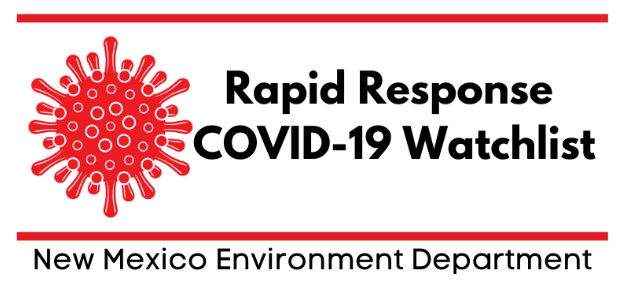
List includes New Mexico businesses with two or more rapid responses within the last 14 days
The New Mexico Environment Department (NMED) has updated its daily COVID-19 Watchlist, which includes New Mexico places of employment that have had two or more rapid responses in the last 14 days. There are currently 65 establishments on the watchlist.
View list here[92].
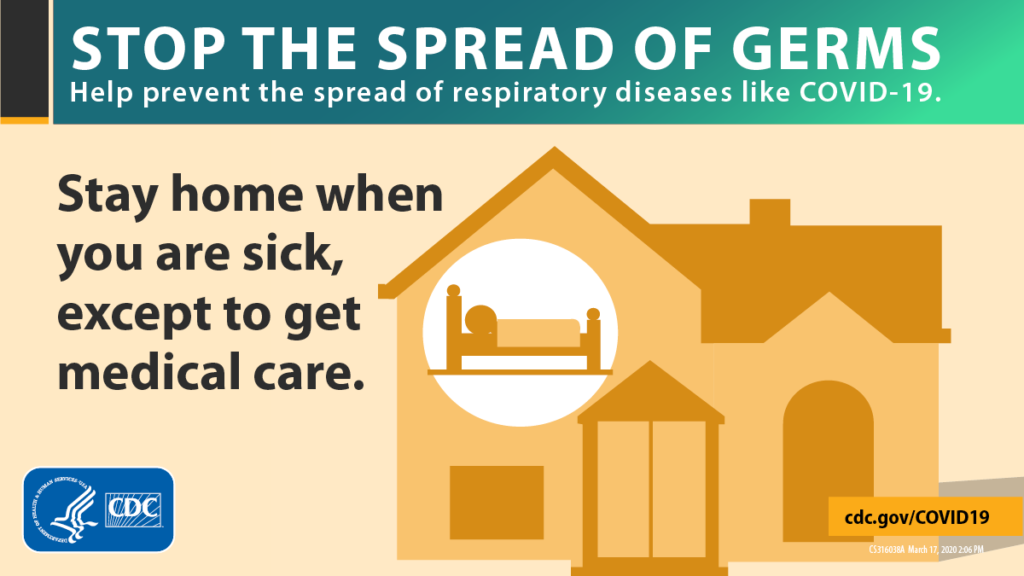
State introduces free at-home rapid testing program
More than a million tests expected by next week
Find out more!SANTA FE – Governor Michelle Lujan Grisham and the New Mexico Department of Health (NMDOH) are securing over 1 million ihealth at-home rapid antigen tests for the state, to be initially distributed in areas of higher social vulnerability. So far, over 400,000 tests have been secured, with the remaining tests expected to arrive in the coming week.
“I am committed to doing everything we possibly can to get the resources needed, despite national testing shortages,” said Gov. Lujan Grisham. “I have directed the Department of Health to procure 1 million rapid tests every two weeks to ensure that every New Mexican has access to this critical tool in our fight against COVID-19.”
Home testing (or self testing) is one of several ways to reduce the spread of COVID-19 along with primary vaccination, getting your booster dose, wearing a mask indoors, and social distancing. “Part of learning to live with COVID as we go forward is putting the tools to fight the virus into our home, and home testing is one of the tools that in the long run will enable us to manage this pandemic,” said David R. Scrase, M.D., Acting Cabinet Secretary of the New Mexico Department of Health.
In the next week, with the support of the Department of Homeland Security and Emergency Management and the National Guard, these home test kits will be distributed to emergency managers across 26 counties to the 79 zip codes with the highest social vulnerability index (SVI). Tribal communities will also receive test kits. After this initial allocation of tests, the program will expand based on available supply of tests to include a pro-rata distribution to counties across the entire state. The Biden Administration[93] is also launching a mail order home test program[94] available to the general public starting on January 19th.
Home tests can be completed in 15 minutes, allowing people to act quickly. Knowing if you are COVID positive allows you to let others know if they have been exposed, to stay home and/or seek timely medical attention. If you are unable to get a test and have symptoms of COVID, please assume that you have COVID, and follow COVID positive guidelines.[95] NMDOH also has developed a webpage for home testing [96]as well as a guide for what to do for quarantine and isolation[97] depending on the results of your test.
State launches round two of $100 COVID-19 vaccine incentive program
To receive incentive, New Mexicans must register at vaccineNM.org[98]
Find out more!SANTA FE – The New Mexico Department of Health on Monday announced the launch of its second $100 COVID-19 vaccine incentive program: Stay Ahead New Mexico.
Beginning Monday, August 2, and for the duration of August, all New Mexicans 12+ are eligible for a $100 incentive for getting a dose of COVID-19 vaccine. Any dose qualifies – a first or second dose of Moderna or Pfizer, or a dose of the single-shot J&J vaccine. No more than one $100 incentive will be distributed per person.
The announcement follows Thursday’s White House press conference, at which President Biden praised New Mexico for launching a $100 incentive program in June – a program that led to a 333% increase in single-shot vaccines and a 26% overall boost in completed vaccinations. New Mexico is resuming its $100 incentive program at President Biden’s request.
To be eligible for the incentive, New Mexicans will have to receive a vaccine between August 2 through the end of the month, and will have to opt in with an email, phone number, or home address at vaccineNM.org/stay-ahead[99].
New Mexicans can also call 1-855-600-3453 for assistance with opting in.
- If you need help filling out the form, press 1. Presione 9 para español.
- If you need help scheduling a vaccine appointment, please press 3. A DOH agent will call you back, so please expect the call.
- If you are a provider, please press 3
New Mexicans are not required to schedule their vaccine appointments through the vaccineNM.org system, however. New Mexicans can receive their COVID-19 vaccine from any provider in the state.
Vaccine providers are required to submit information about vaccinations to the New Mexico State Immunization Information System. When the state receives this information, it will process the incentive payments. Payments will be distributed most quickly through email and text message; users who provide only home addresses will receive their incentives less quickly.
The funds for this incentive come from the federal American Rescue Plan.
New Mexicans under the age of 18 will not receive the incentive directly. Instead, their parents/guardians will be required to provide permission, and the incentive will be disbursed to the parent/guardian.
Southwest Region Public Health Offices Offering Back-to-School Vaccinations
SANTA FE –The New Mexico Department of Health’s Public Health Offices in the Southwest Region will be providing no-cost back-to-school vaccinations by appointment or walk-in basis. Parents or guardians can bring their child to one of the locations listed below with the current schedule from now until the start of the school year in August. We encourage all students to get vaccinated as soon as possible. Students are required to be up to date on their childhood immunizations in order to attend school. The COVID-19 vaccination will also be available for parents and students 12 years and older.
Find out more!Las Cruces Public Health Office
1170 N. Solano. Las Cruces, NM 88001
- Monday and Friday- 8:30am-11:30am and 1:00pm-4:00pm – Walk-ins Welcome
- Tuesday thru Thursday- 8:30am-11:30am and 1:00pm-4:00pm- by Appointment Only
Beginning on July 24th, the Las Cruces Public Health Department will be open 5 days a week for walk-ins. This will be in partnership with our Got Shots? Campaign which will run until August 14th.
Call 575-528-5006 if you have any questions or would like to schedule an appointment.
Anthony Public Health Office
855 N. Anthony Dr., Anthony, NM 88021
- Tuesday thru Thursday – 8:00am-5:00pm- Appointment and Walk-ins Welcome
Call 575-882-3121 to schedule an appointment.
Chaparral Public Health Office
317 McCombs, Chaparral, NM 88081
- Tuesday thru Thursday- 8:00am-5:00pm- Appointment and Walk-ins Welcome
Call 575-824-3454 to schedule an appointment.
Sunland Park Public Health Office
3807 McNutt Road, Sunland Park, NM 88063
- Tuesday thru Friday – 8:00am-5:00pm- Appointment and Walk-ins Welcome
Call 575-589-2543 to schedule an appointment.
Otero Public Health Office
1207 8th Street, Alamogordo, NM 88310
- Wednesday and Thursday- 8:00am-5:00pm- Appointment and Walk Ins Welcome
Call 575-437-9340 to schedule an appointment.
Luna Public Health Office
501 Pear Ave., Columbus, NM 88029
- Monday- 8:00am-5:00pm- Walk-ins Welcome
Call 575-649-7065 for more information.
Silver City Public Health Office
2610 N. Silver, Silver City, NM 88061
- Tuesday and Wednesday – 8:00am-5:00pm- Walk-ins Welcome
Call 575-538-5318 for more information.
Hidalgo Public Health Office
530 De Moss Street, Lordsburg, NM 88045
- Thursday – 8:00am-5:00pm- Walk-ins Welcome
Call 575-542-9391 for more information.
Sierra Public Health Office
201 East 4th Street, Truth or Consequences, NM 87901
- Monday and Wednesday – 8:00am-5:00pm- Walk-ins Welcome
- Tuesday – 3:00pm-4:00pm – Walk-ins Welcome
Call 575-894-2716 for more information.
Socorro Public Health Office
214 Neel Avenue NW, Socorro, NM 87801
- Wednesday and Friday – 9:00am-11:30pm & 1:30pm-3:30pm – Appointments and Walk-ins Welcome
Call 575-835-0971 for more information or to schedule an appointment.
State announces changes to COVID-19 vaccine dashboard
Will report vaccinations among 18+ and 12-17 populations separately
Find out more!SANTA FE – The New Mexico Department of Health (DOH) on Thursday announced changes to its COVID-19 vaccine dashboard[100]. Beginning today, the state will report vaccinations based on the 18+ population. County-based totals will also be based on the 18+ population. Vaccinations among the 12-17 population will appear on the dashboard as well.
The state had previously used a 16+ age grouping to report vaccinations, as well as a separate category for 12-15. “At the time we announced our goal of 60% vaccinated, only New Mexicans 16+ were eligible,” said DOH Cabinet Secretary Dr. Tracie Collins. “After meeting that goal, we’ve decided to modify our reporting to 18+ so as to align with White House and CDC reporting standards.”
New Mexico COVID-19 update: 83 new cases, totaling 205, 996
One additional COVID-19 death
Find out more!Santa Fe– New Mexico state health officials on Wednesday announced 83 additional COVID-19 cases. Per the state Department of Health, the most recent cases are:
- · 27 new cases in Bernalillo County
- · 1 new case in Chaves County
- · 2 new cases in Curry County
- · 5 new cases in Doña Ana County
- · 1 new case in Los Alamos County
- · 3 new cases in Luna County
- · 1 new case in McKinley County
- · 1 new case in Otero County
- · 2 new cases in Rio Arriba County
- · 3 new cases in Roosevelt County
- · 10 new cases in Sandoval County
- · 2 new cases in San Juan County
- · 1 new case in San Miguel County
- · 14 new cases in Santa Fe County
- · 8 new cases in Valencia County
- · 2 new cases among individuals held by federal agencies at the Cibola County Correctional Center
The Department of Health on Wednesday reported one additional deaths in New Mexico related to COVID-19:
One recent death:
- · A female in her 40s from Guadalupe County. The individual was hospitalized and had underlying conditions.
The number of deaths of New Mexico residents related to COVID-19 is now 4,347.
The ten ZIP codes across the state with the most COVID-19 cases on Wednesday, Jul. 7 are:
- · 87121 – 10
- · 87505 – 7
- · 87124 – 4
- · 87507 – 4
- · 87004 – 3
- · 87031 – 3
- · 87042 – 3
- · 87114 – 3
- · 88030 – 3
- · 88130 – 3
Daily case counts and test numbers are raw data based on information the state receives today – meaning data that has not yet been scrutinized to identify potential duplicates or late-arriving positives or negatives. Including the above newly reported cases, New Mexico has now had a total of 205,996 COVID-19 cases:
- · Bernalillo County: 59,239
- · Catron County: 97
- · Chaves County: 9,076
- · Cibola County: 2,917
- · Colfax County: 799
- · Curry County: 5,338
- · De Baca County: 178
- · Doña Ana County: 25,166
- · Eddy County: 6,963
- · Grant County: 1,758
- · Guadalupe County: 472
- · Harding County: 13
- · Hidalgo County: 368
- · Lea County: 8,450
- · Lincoln County: 1,767
- · Los Alamos County: 541
- · Luna County: 3,395
- · McKinley County: 12,404
- · Mora County: 175
- · Otero County: 4,080
- · Quay County: 537
- · Rio Arriba County: 3,815
- · Roosevelt County: 2,037
- · Sandoval County: 12,287
- · San Juan County: 15,760
- · San Miguel County: 1,414
- · Santa Fe County: 10,656
- · Sierra County: 781
- · Socorro County: 1,330
- · Taos County: 1,732
- · Torrance County: 891
- · Union County: 260
- · Valencia County: 6,946
County totals are subject to change upon further investigation and determination of residency of individuals positive for COVID-19.
The Department of Health currently reports the following numbers of COVID-19 cases among individuals held by federal agencies at the following facilities:
- · Cibola County Correctional Center: 451
- · Otero County Federal Prison Facility: 447
- · Otero County Processing Center: 262
- · Torrance County Detention Facility: 202
The Department of Health currently reports the following numbers of COVID-19 cases among individuals held by the New Mexico Corrections Department at the following facilities:
- · Central New Mexico Correctional Facility in Valencia County: 302
- · Guadalupe County Correctional Facility: 255
- · Lea County Correctional Facility: 762
- · Northeast New Mexico Correctional Facility in Union County: 167
- · Northwest New Mexico Correctional Center in Cibola County: 128
- · Otero County Prison Facility: 473
- · Penitentiary of New Mexico in Santa Fe County: 219
- · Roswell Correctional Center: 229
- · Southern New Mexico Correctional Facility in Doña Ana County: 231
- · Springer Correctional Center in Colfax County: 151
- · Western New Mexico Correctional Facility in Cibola County: 75
As of today, there are 70 individuals hospitalized in New Mexico for COVID-19. This number may include individuals who tested positive for COVID-19 out of state but are currently hospitalized in New Mexico. This number does not include New Mexicans who tested positive for COVID-19 and may have been transferred to a hospital out of state.
As of today, there are 195,187 COVID-19 cases designated as having recovered by the New Mexico Department of Health.
The Department of Health has identified at least one positive COVID-19 case in residents and/or staff in the past 28 days at the following long-term care facilities:
- · Aztec Healthcare in Aztec
- · Cedar Ridge Inn in Farmington
- · Genesis Healthcare Uptown in Albuquerque
- · Good Samaritan Society Las Cruces
- · Laguna Rainbow Care Center in Casa Blanca
- · Lakeview Christian Home in Carlsbad
- · The Rio at Las Estancias in Albuquerque
The New Mexico Department of Health has active investigations into the positive patients, which includes contact tracing and swabs of symptomatic individuals who have had contact with the positive cases.
Every New Mexican must work together to stem the spread of COVID-19. If you are sick or unvaccinated, wear a mask when in public and around others.
New Mexicans who report symptoms of COVID-19 infection, such as fever, cough, shortness of breath, chills, repeated shaking with chills, muscle pain, headache, sore throat, congestion or runny nose, nausea or vomiting, diarrhea, and/or loss of taste or smell should call their health care provider or the NMDOH COVID-19 hotline immediately (1-855-600-3453).
The Department of Health strongly encourages the following groups to get tested:
- · Symptomatic people displaying the COVID-19 symptoms of fever, cough, shortness of breath, chills, repeated shaking with chills, muscle pain, headache, sore throat, congestion or runny nose, nausea or vomiting, diarrhea, and/or loss of taste or smell;
- · Asymptomatic people who are close contacts or household members of people in their infectious period who have already tested positive for the coronavirus;
- · Asymptomatic people who live or work in congregate settings such as long-term care facilities and group homes;
- · Patients who are scheduled for surgery and whose provider has advised them to get tested before the procedure. New Mexicans who have non-health-related questions or concerns can also call 833-551-0518 or visit newmexico.gov, which is being updated regularly as a one-stop source for information for families, workers, and others affected by and seeking more information about COVID-19.
Department of Health COVID-19 map update: June 2
N.M. elevates all counties to Turquoise
Find out more!SANTA FE – Gov. Michelle Lujan Grisham on Wednesday authorized the execution of a new statewide public health order that places each of the state’s 33 counties at the least-restrictive Turquoise Level within the state’s color-coded county-by-county risk framework, reflecting significantly decreased risk of viral transmission statewide.
Correspondingly, the New Mexico Department of Health’s updated statewide COVID-19 map[101] places all 33 New Mexico counties at the Turquoise Level as of June 2.
The Department of Health on Tuesday reported only 380 new COVID-19 cases[102] covering a four-day cumulative weekend reporting period (from Saturday, May 29, through Tuesday, June 1) — an average of fewer than 100 cases each day.
Given the state’s vaccination progress, and a continued positive outlook with respect to new virus cases, counties will remain at the Turquoise Level barring exceptional circumstances — such as an unforeseen mass outbreak — for the duration of the state’s use of the color-coded county-by-county system.
The color-coded system will be phased out after 60 percent of the state’s eligible population has completed its vaccination series and two weeks, allowing for the vaccinations to take full effect, have passed.
The public health order is attached to this release.
“We’re almost there,” said Gov. Lujan Grisham. “New Mexicans are making the right choices: Getting vaccinated so we can all safely resume our lives and so our small businesses and economy can roar back to life. Please encourage your friends and family to register if they haven’t already — and keep up the hard work as, all together, we push toward ending the worst of the pandemic.”
Absent the change enacted Wednesday, under the previous framework for evaluating risk for counties, 28 counties would have been operating at the Turquoise Level, and five — De Baca, Guadalupe, Harding, Roosevelt and Torrance — would have moved back to operating at the Yellow Level. The state will continue to closely monitor vaccination rates in those counties and work with local officials however possible to boost vaccinations.
After 60 percent of eligible New Mexicans[103] have been fully vaccinated, the state will graduate out of the color-coded county risk system and remove most pandemic-related restrictions[104] on commercial activities.
The state will remove the color-coded risk system two weeks after the 60 percent threshold is reached, allowing for the vaccinations to take full effect.
New Mexicans may schedule their COVID-19 vaccination at vaccineNM.org[105].
New Mexicans are eligible to win prizes, including up to $5 million, through the Vax 2 the Max Sweepstakes; vaccinated New Mexicans may opt in to the sweepstakes at vax2themaxnm.org[106].
New Mexicans who are fully vaccinated may as of last month opt to set aside their facemasks in most environments, per updated CDC guidance[107]. Unvaccinated New Mexicans are required to retain their facemasks in public spaces — and should seek out their vaccination[108] immediately. Regardless of vaccination status, New Mexicans must adhere to local and commercial requirements regarding facemasks. And New Mexicans are encouraged to continue adhering to COVID-safe practices.
All individuals, including those who are fully vaccinated, should continue to wear well-fitted masks where required by localities, tribal entities and individual businesses.
Thirty-two counties were operating at the Turquoise Level as of the last biweekly map update on May 19.
TURQUOISE LEVEL:
Essential businesses (non-retail): No capacity restrictions but operations must be limited to only those absolutely necessary to carry out essential functions
Essential retail spaces: 75% of maximum capacity for indoor spaces and 100% outdoor
Food and drink establishments (if NM Safe Certified): 75% of maximum capacity for indoor dining; 75% of maximum capacity for outdoor dining
Close-contact businesses: 75% of maximum capacity; no restrictions on outdoor spaces
Large entertainment venues: 33% of maximum capacity for any indoor/enclosed space on premises; 75% of any outdoor space on premises
Recreational facilities: 50% of maximum capacity of any indoor/enclosed space on the premises; 75% of any outdoor space on premises
Bars and clubs: 33% of maximum capacity of any indoor/enclosed space on premises; 75% of any outdoor space on premises, where applicable
**All other businesses: 75% of maximum capacity indoors; no restrictions on outdoor spaces
Houses of worship: May operate at 100% capacity indoors or outdoors should they so choose
Places of lodging: No maximum occupancy restrictions for those that have completed NM Safe Certified training; 50% of maximum occupancy for all others; 15 guests maximum for vacation rentals
Mass gatherings limit: 150 persons
Categories and definitions within the public health order:
Essential businesses (non-retail): These are any business or nonprofit entity falling within one or more of the following categories:
- Health care operations including hospitals, walk-in-care health facilities, pharmacies, medical wholesale and distribution, home health care workers or aides for the elderly, emergency dental facilities, nursing homes, residential health care facilities, research facilities, congregate care facilities, intermediate care facilities for those with intellectual or developmental disabilities, supportive living homes, home health care providers, drug and alcohol recovery support services, and medical supplies and equipment manufacturers and providers;
- Homeless shelters, food banks, and other services providing care to indigent or needy populations;
- Childcare facilities;
- Farms, ranches, and other food cultivation, processing, or packaging operations;
- Infrastructure operations including, but not limited to, public works construction, commercial and residential construction and maintenance, self-storage facilities, airport operations, public transportation, airlines, taxis, private transportation providers, transportation network companies, water, gas, electrical, oil drilling, oil refining, natural resources extraction or mining operations, nuclear material research and enrichment, those attendant to the repair and construction of roads and highways, gas stations, solid waste collection and removal, trash and recycling collection, processing and disposal, sewer, data and internet providers, data centers, technology support operations, and telecommunications systems;
- Manufacturing operations involved in food processing, manufacturing agents, chemicals, fertilizer, pharmaceuticals, sanitary products, household paper products, microelectronics/semiconductor, primary metals manufacturers, electrical equipment, appliance, and component manufacturers, and transportation equipment manufacturers;
- Services necessary to maintain the safety and sanitation of residences or essential businesses including security services, towing services, custodial services, plumbers, electricians, and other skilled trades;
- Veterinary and livestock services, animal shelters and facilities providing pet adoption, daycare, or boarding services;
- Media services;
- Utilities, including their contractors, suppliers, and supportive operations, engaged in power generation, fuel supply and transmission, water and wastewater supply;
- Crematoriums, funeral homes and cemeteries;
- Banks, credit unions, insurance providers, payroll services, brokerage services, and investment management firms;
- Businesses providing mailing and shipping services
- Laboratories and defense and national security-related operations supporting the United States government, a contractor to the United States government, or any federal entity;
- Professional services, such as legal or accounting services, but only where necessary to assist in compliance with legally mandated activities; and
- Logistics, and also businesses that store, transport, or deliver groceries, food, materials, goods or services directly to residences, retailers, government institutions, or essential businesses.
Essential retail spaces: These include grocery stores, supermarkets, food banks, farmers’ markets and vendors who sell food, convenience stores, and other businesses that generate more than one-third of their revenue from the sale of canned food, dry goods, fresh fruits and vegetables, pet food, animal feed or supplies, fresh meats, fish, and poultry, and any other consumable food and drink products; automobile repair facilities, bike repair facilities, and retailers who generate the majority of their revenue from the sale of automobile or bike repair products; hardware stores; laundromats; and dry cleaner services.
Food and drink establishments: These are restaurants, breweries, wineries, distillers, cafes, coffee shops, or other similar establishments that offer food or drink.
Close-contact businesses: These are barbershops, hair salons, tattoo parlors, nail salons, spas, massage therapy services, esthetician clinics and tanning salons.
Recreational facilities: These are any publicly or privately owned facility typically or actually used for recreational activities capable of bringing persons within close proximity of one another, including aquariums, amusement parks, arcades, basketball courts, baseball fields, bowling alleys, botanical gardens, family entertainment centers, football fields, go-kart courses, golf courses, ice-skating rinks, museums with interactive displays or exhibits, miniature golf courses, ski areas, soccer fields, swimming pools, tennis courts, youth programs, guided raft tours, guided balloon tours and zoos.
Bars and clubs: These are any business that typically or actually generates more than half of its revenue from the sale of alcohol for on-premises consumption — including adult entertainment venues, nightclubs, and dance clubs, regardless of the source of their revenue.
Large entertainment venues: These are as any publicly or privately owned venue typically or actually used to host large audiences for the purposes of entertainment or amusement, including racetracks, concert venues, movie theaters, performance venues, professional sports venues and theaters.
Houses of worship: These are any church, synagogue, mosque, or other gathering space where persons congregate to exercise their religious beliefs.
Places of lodging: These are hotels, motels, RV parks, and short-term vacation rentals.
Mass gatherings: These are any public gathering, private gathering, organized event, ceremony, parade, funeral, or any other grouping that brings together a specified number of individuals in a single room or connected space, confined outdoor space, or open outdoor space. “Mass gatherings” also include coordinated events in which individuals gather in vehicles. “Mass gatherings” do not include the presence of any number of individuals where those individuals regularly reside. “Mass gathering” does not include individuals who are public officials or public employees in the course and scope of their employment.
**All other businesses: These are any entities that are not identified explicitly as an “essential business,” “house of worship,” “recreational facility,” “large entertainment venue,” “food and drink establishment,” “bars or clubs” or “place of lodging”.” Examples would include non-essential retail spaces like a clothing store, a gym, a group fitness class or a personal training service, among others.
Environment Department to update Rapid Response COVID-19 Watchlist on weekdays only
For over a year, the New Mexico Environment Department (NMED) and other state agencies conducted tens of thousands of rapid responses around the state to protect New Mexicans in workplaces, schools, medical facilities, daycare centers and residences. Since October, the Rapid Response COVID-19 Watchlist and other rapid response data has been posted to the NMED website, serving as tools for New Mexicans to make more informed decisions about which establishments they visit and when.
With over 55 percent of eligible New Mexicans completing their vaccine series and the number of rapid responses steadily declining since peaking in December, the state will begin updating online rapid response data on weekdays only. The Watchlist, closure list and rapid response data will continue to be updated Monday through Friday here[109].
“With nearly 40,000 rapid responses conducted to date, the Environment Department and other state agencies are helping businesses stay open and keeping New Mexicans employed and protected,” said NMED Cabinet Secretary James Kenney. “Now, it’s critical that employers encourage employees to be vaccinated – and state agencies stand ready to connect employers with the resources they need.”
Employers can request an on-site vaccination event here[110]. Additional NMED resources for employers and employees are available here[111]. New Mexicans can also register for vaccine and schedule their appointments at vaccineNM.org.
NMED will also discontinue publishing a daily press release on the Watchlist. Rapid response data will not be updated on Monday, May 31, in observance of Memorial Day.
Department of Health COVID-19 map update: May 19
Thirty-two counties are Turquoise
SANTA FE – The New Mexico Department of Health on Wednesday announced the updated statewide COVID-19 map[112], with 32 New Mexico counties at the Turquoise Level and one at the Green Level, at which there are fewer restrictions on commercial and day-to-day activities amid decreased virus risk.
Find out more!There are no counties at the Yellow or Red Levels as of May 19. Counties may still backslide with enhancing risk upon the next biweekly map update, however, if vaccination thresholds are not reached and key health metrics indicating the spread of the virus worsen.
When 60 percent of eligible New Mexicans[103] have been fully vaccinated, the state will graduate out of the color-coded county risk system and remove most pandemic-related restrictions[104] on commercial activities.
New Mexicans who are fully vaccinated may as of late last week opt to set aside their facemasks in most environments, per updated CDC guidance[113]. Unvaccinated New Mexicans are required to retain their facemasks in public spaces – and should seek out their vaccination[114] immediately. Regardless of vaccination status, New Mexicans must adhere to local and commercial requirements regarding facemasks. All New Mexicans are encouraged to continue adhering to COVID-safe practices.
All individuals, including those who are fully vaccinated, should continue to wear well-fitted masks where required by localities, tribal entities, and individual businesses.
“New Mexicans should continue to get vaccinated at the very first opportunity,” said Health Secretary Tracie Collins, M.D. “Not only will it hasten the end of the worst of the pandemic, it will enhance counties’ and communities’ ability to safely begin more and more commercial and day-to-day activities without endangering public health.”
New Mexicans may schedule their COVID-19 vaccination at vaccineNM.org[105].
Counties that may operate at the Turquoise Level[115] as of May 19 are: Bernalillo, Catron, Cibola, Colfax, Curry, De Baca, Dona Ana, Eddy, Guadalupe, Grant, Harding, Hidalgo, Lea, Lincoln, Los Alamos, Luna, McKinley, Mora, Otero, Quay, Rio Arriba, Roosevelt, Sandoval, San Juan, San Miguel, Santa Fe, Sierra, Socorro, Taos, Torrance, Union and Valencia.
Counties that met both of the health metric thresholds and may operate at the Green Level[116] as of May 19 are: Chaves.
The health metrics used to determine a county’s risk level are:
- A per-capita rate of new COVID-19 cases of no greater than 10 per 100,000 inhabitants over the most recent 14-day reporting period
- An average positivity rate less than or equal to 7.5 percent over the most recent 14-day reporting period
- A county with a fully vaccinated rate at or above a target (45% as of May 19) that increases 5% every other week as more vaccinations are completed
A county that meets none of the criteria upon the biweekly Department of Health map update will be at the Red Level. A county meeting one will be at the Yellow Level. A county meeting two criteria is at the Green Level. A county meeting all three criteria, or having maintained the Green Level for two consecutive biweekly map update periods, is at the Turquoise Level.
The public health order, the red-to-green framework and frequently asked questions are all available at cv.nmhealth.org/redtogreen[117], where New Mexicans can also view the test positivity rate and new case incidence for each county.
The categories and definitions for each risk level are available below and available at cv.nmhealth.org/redtogreen[117].
TURQUOISE LEVEL:
Counties at the Turquoise Level have three of the following or two of the following in two consecutive reporting periods: 1) a new COVID-19 average daily case incidence rate of no greater than 10 cases per 100,000 inhabitants during the most recent two-week period, 2) an average percent of positive COVID-19 test results less than or equal to 7.5%, or 3) a fully vaccinated rate at or above 40%.
Essential businesses (non-retail): No capacity restrictions but operations must be limited to only those absolutely necessary to carry out essential functions
Essential retail spaces: 75% of maximum capacity for indoor spaces and 100% outdoor
Food and drink establishments (if NM Safe Certified): 75% of maximum capacity for indoor dining; 75% of maximum capacity for outdoor dining
Close-contact businesses: 75% of maximum capacity; no restrictions on outdoor spaces
Large entertainment venues: 33% of maximum capacity for any indoor/enclosed space on premises; 75% of any outdoor space on premises
Recreational facilities: 50% of maximum capacity of any indoor/enclosed space on the premises; 75% of any outdoor space on premises
Bars and clubs: 33% of maximum capacity of any indoor/enclosed space on premises; 75% of any outdoor space on premises, where applicable
**All other businesses: 75% of maximum capacity indoors; no restrictions on outdoor spaces
Houses of worship: May operate at 100% capacity indoors or outdoors should they so choose
Places of lodging: No maximum occupancy restrictions for those that have completed NM Safe Certified training; 50% of maximum occupancy for all others; 15 guests maximum for vacation rentals
Mass gatherings limit: 150 persons
GREEN LEVEL:
Counties at the Green Level have two of the following: 1) a new COVID-19 average daily case incidence rate of no greater than 10 cases per 100,000 inhabitants during the most recent two-week period, 2) an average percent of positive COVID-19 test results no greater than 7.5%, or 3) a fully vaccinated rate at or above 40%.
Essential businesses (non-retail): No capacity restrictions but operations must be limited to only those absolutely necessary to carry out essential functions
Essential retail spaces: 50% of maximum capacity (indoor and outdoor)
Food and drink establishments (if NM Safe Certified): 50% of maximum capacity for indoor dining; 75% of maximum capacity for outdoor dining
Close-contact businesses: 50% of maximum capacity (indoor and outdoor)
Large entertainment venues: 25% of maximum capacity for any indoor/enclosed space on premises; 50% of any outdoor space on premises
Recreational facilities: 25% of maximum capacity of any indoor/enclosed space on the premises; 50% of any outdoor space on the premises
Bars and clubs: 25% of maximum capacity of any outdoor space on premises, where applicable; indoor not permitted
**All other businesses: 50% of maximum capacity (indoor and outdoor)
Houses of worship: May operate at 100% capacity indoors or outdoors should they so choose
Places of lodging: 75% of maximum occupancy for those that have completed NM Safe Certified training; 40% of maximum occupancy for all others; 10 guests maximum for vacation rentals
Mass gatherings limit: 20 persons
YELLOW LEVEL:
Counties at the Yellow Level are those who have one of the following: 1) a new COVID-19 average daily case incidence rate of no greater than 10 cases per 100,000 inhabitants during the most recent two-week period, 2) an average percent of positive COVID-19 test results no greater than 7.5%, or 3) a fully vaccinated rate at or above 40%.
Essential businesses (non-retail): No capacity restrictions but operations must be limited to only those absolutely necessary to carry out essential functions
Essential retail spaces: 33% of maximum capacity (indoor and outdoor)
Food and drink establishments (if NM Safe Certified): 33% of maximum capacity for indoor dining; 75% of maximum capacity for outdoors dining; any establishment serving alcohol must close by 10 p.m. each night
Close-contact businesses: 33% of maximum capacity or 20 customers at one time, whichever is smaller; 33% of any outdoor space on the premises
Large entertainment venues: 25% of maximum capacity of any outdoor space on premises; indoor not permitted with the limited exception of operating up to 25% of maximum capacity for recording and broadcasting entertainment without any in-person audience
Recreational facilities: 33% of any outdoor space on the premises; indoor not permitted
Bars and clubs: May not operate
**All other businesses: 33% of maximum capacity (indoor and outdoor)
Houses of worship: May operate at 100% capacity indoors or outdoors should they so choose
Places of lodging: 60% of maximum occupancy for those that have completed NM Safe Certified training; 33% of maximum occupancy for all others; 5 guests maximum for vacation rentals
Mass gatherings limit: 10 persons
RED LEVEL:
Counties at the Red Level are those with a new COVID-19 case incident rate of greater than 10 cases per 100,000 inhabitants during the most recent two-week period; an average percent of positive COVID-19 test results over the most recent 14-day period greater than 7.5%; and a fully vaccinated rate below 40%.
Essential businesses (non-retail): No capacity restrictions but must limit operations to only those absolutely necessary to carry out essential functions
Essential retail spaces: 25% of maximum capacity (indoor and outdoor)
Food and drink establishments: No indoor dining permitted; 25% of maximum capacity for outdoor dining; any establishment serving alcohol must close by 9 p.m. each night
Close-contact businesses: 25% of maximum capacity or 10 customers at one time, whichever is smaller; 25% of any outdoor space on the premises
Large entertainment venues: May not operate
Recreational facilities: 25% of maximum capacity of any outdoor space on the premises; indoor not permitted
Bars and clubs: May not operate
**All other businesses: 25% of maximum capacity (indoor and outdoor)
Houses of worship: May operate at 100% capacity indoors or outdoors should they so choose
Places of lodging: 40% of maximum occupancy for those that have completed NM Safe Certified training; 25% of maximum occupancy for all others; 5 guests maximum for vacation rentals
Mass gatherings limit: 5 persons
Categories and definitions within the public health order:
Essential businesses (non-retail): These are any business or nonprofit entity falling within one or more of the following categories:
- Health care operations including hospitals, walk-in-care health facilities, pharmacies, medical wholesale and distribution, home health care workers or aides for the elderly, emergency dental facilities, nursing homes, residential health care facilities, research facilities, congregate care facilities, intermediate care facilities for those with intellectual or developmental disabilities, supportive living homes, home health care providers, drug and alcohol recovery support services, and medical supplies and equipment manufacturers and providers;
- Homeless shelters, food banks, and other services providing care to indigent or needy populations;
- Childcare facilities;
- Farms, ranches, and other food cultivation, processing, or packaging operations;
- Infrastructure operations including, but not limited to, public works construction, commercial and residential construction and maintenance, self-storage facilities, airport operations, public transportation, airlines, taxis, private transportation providers, transportation network companies, water, gas, electrical, oil drilling, oil refining, natural resources extraction or mining operations, nuclear material research and enrichment, those attendant to the repair and construction of roads and highways, gas stations, solid waste collection and removal, trash and recycling collection, processing and disposal, sewer, data and internet providers, data centers, technology support operations, and telecommunications systems;
- Manufacturing operations involved in food processing, manufacturing agents, chemicals, fertilizer, pharmaceuticals, sanitary products, household paper products, microelectronics/semiconductor, primary metals manufacturers, electrical equipment, appliance, and component manufacturers, and transportation equipment manufacturers;
- Services necessary to maintain the safety and sanitation of residences or essential businesses including security services, towing services, custodial services, plumbers, electricians, and other skilled trades;
- Veterinary and livestock services, animal shelters and facilities providing pet adoption, daycare, or boarding services;
- Media services;
- Utilities, including their contractors, suppliers, and supportive operations, engaged in power generation, fuel supply and transmission, water and wastewater supply;
- Crematoriums, funeral homes and cemeteries;
- Banks, credit unions, insurance providers, payroll services, brokerage services, and investment management firms;
- Businesses providing mailing and shipping services
- Laboratories and defense and national security-related operations supporting the United States government, a contractor to the United States government, or any federal entity;
- Professional services, such as legal or accounting services, but only where necessary to assist in compliance with legally mandated activities; and
- Logistics, and also businesses that store, transport, or deliver groceries, food, materials, goods or services directly to residences, retailers, government institutions, or essential businesses.
Essential retail spaces: These include grocery stores, supermarkets, food banks, farmers’ markets and vendors who sell food, convenience stores, and other businesses that generate more than one-third of their revenue from the sale of canned food, dry goods, fresh fruits and vegetables, pet food, animal feed or supplies, fresh meats, fish, and poultry, and any other consumable food and drink products; automobile repair facilities, bike repair facilities, and retailers who generate the majority of their revenue from the sale of automobile or bike repair products; hardware stores; laundromats; and dry cleaner services.
Food and drink establishments: These are restaurants, breweries, wineries, distillers, cafes, coffee shops, or other similar establishments that offer food or drink.
Close-contact businesses: These are barbershops, hair salons, tattoo parlors, nail salons, spas, massage therapy services, esthetician clinics and tanning salons.
Recreational facilities: These are any publicly or privately owned facility typically or actually used for recreational activities capable of bringing persons within close proximity of one another, including aquariums, amusement parks, arcades, basketball courts, baseball fields, bowling alleys, botanical gardens, family entertainment centers, football fields, go-kart courses, golf courses, ice-skating rinks, museums with interactive displays or exhibits, miniature golf courses, ski areas, soccer fields, swimming pools, tennis courts, youth programs, guided raft tours, guided balloon tours and zoos.
Bars and clubs: These are any business that typically or actually generates more than half of its revenue from the sale of alcohol for on-premises consumption — including adult entertainment venues, nightclubs, and dance clubs, regardless of the source of their revenue.
Large entertainment venues: These are as any publicly or privately owned venue typically or actually used to host large audiences for the purposes of entertainment or amusement, including racetracks, concert venues, movie theaters, performance venues, professional sports venues and theaters.
Houses of worship: These are any church, synagogue, mosque, or other gathering space where persons congregate to exercise their religious beliefs.
Places of lodging: These are hotels, motels, RV parks, and short-term vacation rentals.
Mass gatherings: These are any public gathering, private gathering, organized event, ceremony, parade, funeral, or any other grouping that brings together a specified number of individuals in a single room or connected space, confined outdoor space, or open outdoor space. “Mass gatherings” also include coordinated events in which individuals gather in vehicles. “Mass gatherings” do not include the presence of any number of individuals where those individuals regularly reside. “Mass gathering” does not include individuals who are public officials or public employees in the course and scope of their employment.
**All other businesses: These are any entities that are not identified explicitly as an “essential business,” “house of worship,” “recreational facility,” “large entertainment venue,” “food and drink establishment,” “bars or clubs” or “place of lodging”.” Examples would include non-essential retail spaces like a clothing store, a gym, a group fitness class or a personal training service, among others.
Updated public health order in effect; New Mexico adopts CDC mask guidance for fully vaccinated individuals
SANTA FE – The New Mexico Department of Health on Friday announced the state’s adoption of the Centers for Disease Control and Prevention’s updated guidance[118] on facemasks for those who are fully vaccinated. An updated Department of Health public health order, effective Friday, May 14, is attached to this news release.
Find out more!Per the CDC[119], in most circumstances, fully vaccinated individuals are no longer required to wear a mask in either indoor or outdoor settings. All individuals who are unvaccinated or not yet fully vaccinated are still required, per the public health order and CDC guidance, to wear a mask in public settings. Individuals are considered fully vaccinated two weeks after their second dose in a two-dose series, such as the Pfizer or Moderna vaccines, or two weeks after a single-dose vaccine, such as the Johnson & Johnson vaccine. Individuals who do not meet those requirements must continue to wear a mask in public settings.
New Mexicans are encouraged to continue adhering to COVID-safe practices. All individuals, including those who are fully vaccinated, should continue to wear well-fitted masks where required by localities, tribal entities, and individual businesses. The state fully supports businesses and workplaces that may continue to require masks for employees and/or customers on the premises, regardless of vaccination status.
“Getting vaccinated is the ticket to a safe and healthy COVID-free future,” said Gov. Michelle Lujan Grisham. “We are close and getting closer. But that all depends on New Mexicans continuing to protect themselves and their community by getting vaccinated – please find vaccines near you at vaccineNM.org[105] and get your shot!”
Per CDC guidance[120], masks continue to be required to be worn by all individuals, regardless of vaccination status, in the following settings:
- Health care settings, including but not limited to hospitals, long-term care facilities, and doctors’ offices
- Correctional facilities
- Homeless shelters
- Public transportation, including but not limited to buses, trains, and planes and in transportation hubs such as airports and stations
As the majority of students remain unvaccinated, the CDC’s guidance for school settings currently remains unchanged. Pending additional guidance from the CDC, masks continue to be required in schools for all students and school staff regardless of vaccination status.
“Unvaccinated individuals remain at risk of contracting and spreading the virus; over 99% percent of new COVID-19 cases nationwide are among the unvaccinated,” said Department of Health Secretary Tracie Collins, M.D. “Please schedule your shot today at vaccineNM.org[105] and protect yourself and your loved ones.”
“As the CDC continues to evaluate available data and develop additional guidance, it is critical that New Mexicans continue to take all precautions until they are fully vaccinated,” said Human Services Department Secretary David Scrase, M.D. “While the science is clear that vaccinated individuals are protected, New Mexicans must continue to get vaccinated in order to guarantee that protection. Vaccines are safe, effective, and widely available to New Mexicans – please get vaccinated.”
Mass gathering limits and the statewide framework[121] remain in place. As previously announced[122] by the governor and state officials, New Mexico will graduate from the color-coded county risk system and remove most pandemic-related restrictions on commercial activities when 60% of eligible New Mexicans have been fully vaccinated. As of May 13, 51% of eligible New Mexicans[123] have been fully vaccinated.
All New Mexicans age 16+ are eligible for the COVID-19 vaccine and are strongly encouraged to schedule their vaccine appointment today at vaccineNM.org[105] or by calling 1-855-600-3453. Parents of New Mexicans age 12-15 are encouraged to register their child for the approved Pfizer vaccine at vaccineNM.org[105].
Department of Health county map update May 5: Nearly entire state is Turquoise
SANTA FE – The New Mexico Department of Health on Wednesday announced the updated statewide COVID-19 map[112] for the two-week period beginning May 5, with 30 New Mexico counties at the Turquoise Level, at which there are the fewest restrictions on commercial and day-to-day activities amid decreased virus risk. The majority of the state’s counties remain at the least restrictive levels.
As of May 5, two counties are at the Green Level and one county remains at the Yellow Level; zero counties are at the Red Level.
Find out more!Eight counties advanced to a less restrictive level since the most recent update to the map criteria: Bernalillo, Catron, Doña Ana, Hidalgo, Otero, Sandoval, San Juan, and Valencia.
Even as New Mexico rapidly vaccinates eligible populations with all available supply, it is important that New Mexicans still seek out COVID-19 tests if they feel symptomatic, if they have traveled, if they have spent time unmasked in the company of others – particularly non-household members and particularly indoors. Getting tested not only helps slow the spread; it helps counties maintain their risk levels and advance to less restrictive levels when the viral risk in the community is sufficiently reduced. Please seek out COVID-19 testing at togethernm.org[124].
The state’s county-by-county system uses key health metrics[125] – the per-capita daily incidence of new COVID-19 cases, average COVID-19 test positivity within county borders and county vaccination rate – to determine the level of public health risk and requirement for each county. A county that meets one criterion may operate at the Yellow Level; a county that meets two may operate at the Green Level. A county that has met all three criteria, or two of three for two consecutive biweekly map updates, may operate at the Turquoise Level. Additionally, counties that reach the Turquoise Level will move to a four-week update, as opposed to biweekly.
Counties that may operate at the Turquoise Level[115] as of May 5 are: Bernalillo, Cibola, Colfax, Curry, De Baca, Doña Ana, Eddy, Grant, Guadalupe, Harding, Hidalgo, Lea, Lincoln, Los Alamos, Luna, McKinley, Mora, Otero, Quay, Rio Arriba, Roosevelt, Sandoval, San Juan, San Miguel, Santa Fe, Sierra, Socorro, Taos, Torrance, and Union.
Counties that met both of the health metric thresholds and may operate at the Green Level[116] as of May 5 are: Catron and Valencia.
Counties that met one of the health metric thresholds and may operate at the Yellow Level[126] as of May 5 are: Chaves.
No counties must currently operate at the Red Level.
The color-coded tier system – Red Level, Yellow Level, Green Level and Turquoise Level – enables counties to shed restrictions and provide local communities the flexibility to operate more day-to-day activities as soon as public health data show the virus is retreating within their borders.
As of May 5, the health metrics used to determine a county’s risk level are:
- A new per-capita rate of new COVID-19 cases of no greater than 10 per 100,000 inhabitants over the most recent 14-day reporting period
- An average positivity rate less than or equal to 7.5 percent over the most recent 14-day reporting period
- A county with a fully vaccinated rate at or above a target (40% as of May 5) that increases 5% every other week as more vaccinations are completed
The public health order, the red-to-green framework and frequently asked questions are all available at cv.nmhealth.org/redtogreen[117], where New Mexicans can also view the test positivity rate and new case incidence for each county.
The categories and definitions for each risk level are available below and available at cv.nmhealth.org/redtogreen[127].
TURQUOISE LEVEL:
Counties at the Turquoise Level have three of the following or two of the following in two consecutive reporting periods: 1) a new COVID-19 average daily case incidence rate of no greater than 10 cases per 100,000 inhabitants during the most recent two-week period, 2) an average percent of positive COVID-19 test results less than or equal to 7.5%, or 3) a fully vaccinated rate at or above 40%.
Essential businesses (non-retail): No capacity restrictions but operations must be limited to only those absolutely necessary to carry out essential functions
Essential retail spaces: 75% of maximum capacity for indoor spaces and 100% outdoor
Food and drink establishments (if NM Safe Certified): 75% of maximum capacity for indoor dining; 75% of maximum capacity for outdoor dining
Close-contact businesses: 75% of maximum capacity; no restrictions on outdoor spaces
Large entertainment venues: 33% of maximum capacity for any indoor/enclosed space on premises; 75% of any outdoor space on premises
Recreational facilities: 50% of maximum capacity of any indoor/enclosed space on the premises; 75% of any outdoor space on premises
Bars and clubs: 33% of maximum capacity of any indoor/enclosed space on premises; 75% of any outdoor space on premises, where applicable
**All other businesses: 75% of maximum capacity indoors; no restrictions on outdoor spaces
Houses of worship: May operate at 100% capacity indoors or outdoors should they so choose
Places of lodging: No maximum occupancy restrictions for those that have completed NM Safe Certified training; 50% of maximum occupancy for all others; 15 guests maximum for vacation rentals
Mass gatherings limit: 150 persons
GREEN LEVEL:
Counties at the Green Level have two of the following: 1) a new COVID-19 average daily case incidence rate of no greater than 10 cases per 100,000 inhabitants during the most recent two-week period, 2) an average percent of positive COVID-19 test results no greater than 7.5%, or 3) a fully vaccinated rate at or above 40%.
Essential businesses (non-retail): No capacity restrictions but operations must be limited to only those absolutely necessary to carry out essential functions
Essential retail spaces: 50% of maximum capacity (indoor and outdoor)
Food and drink establishments (if NM Safe Certified): 50% of maximum capacity for indoor dining; 75% of maximum capacity for outdoor dining
Close-contact businesses: 50% of maximum capacity (indoor and outdoor)
Large entertainment venues: 25% of maximum capacity for any indoor/enclosed space on premises; 50% of any outdoor space on premises
Recreational facilities: 25% of maximum capacity of any indoor/enclosed space on the premises; 50% of any outdoor space on the premises
Bars and clubs: 25% of maximum capacity of any outdoor space on premises, where applicable; indoor not permitted
**All other businesses: 50% of maximum capacity (indoor and outdoor)
Houses of worship: May operate at 100% capacity indoors or outdoors should they so choose
Places of lodging: 75% of maximum occupancy for those that have completed NM Safe Certified training; 40% of maximum occupancy for all others; 10 guests maximum for vacation rentals
Mass gatherings limit: 20 persons
YELLOW LEVEL:
Counties at the Yellow Level are those who have one of the following: 1) a new COVID-19 average daily case incidence rate of no greater than 10 cases per 100,000 inhabitants during the most recent two-week period, 2) an average percent of positive COVID-19 test results no greater than 7.5%, or 3) a fully vaccinated rate at or above 40%.
Essential businesses (non-retail): No capacity restrictions but operations must be limited to only those absolutely necessary to carry out essential functions
Essential retail spaces: 33% of maximum capacity (indoor and outdoor)
Food and drink establishments (if NM Safe Certified): 33% of maximum capacity for indoor dining; 75% of maximum capacity for outdoors dining; any establishment serving alcohol must close by 10 p.m. each night
Close-contact businesses: 33% of maximum capacity or 20 customers at one time, whichever is smaller; 33% of any outdoor space on the premises
Large entertainment venues: 25% of maximum capacity of any outdoor space on premises; indoor not permitted with the limited exception of operating up to 25% of maximum capacity for recording and broadcasting entertainment without any in-person audience
Recreational facilities: 33% of any outdoor space on the premises; indoor not permitted
Bars and clubs: May not operate
**All other businesses: 33% of maximum capacity (indoor and outdoor)
Houses of worship: May operate at 100% capacity indoors or outdoors should they so choose
Places of lodging: 60% of maximum occupancy for those that have completed NM Safe Certified training; 33% of maximum occupancy for all others; 5 guests maximum for vacation rentals
Mass gatherings limit: 10 persons
RED LEVEL:
Counties at the Red Level are those with a new COVID-19 case incident rate of greater than 10 cases per 100,000 inhabitants during the most recent two-week period; an average percent of positive COVID-19 test results over the most recent 14-day period greater than 7.5%; and a fully vaccinated rate below 40%.
Essential businesses (non-retail): No capacity restrictions but must limit operations to only those absolutely necessary to carry out essential functions
Essential retail spaces: 25% of maximum capacity (indoor and outdoor)
Food and drink establishments: No indoor dining permitted; 25% of maximum capacity for outdoor dining; any establishment serving alcohol must close by 9 p.m. each night
Close-contact businesses: 25% of maximum capacity or 10 customers at one time, whichever is smaller; 25% of any outdoor space on the premises
Large entertainment venues: May not operate
Recreational facilities: 25% of maximum capacity of any outdoor space on the premises; indoor not permitted
Bars and clubs: May not operate
**All other businesses: 25% of maximum capacity (indoor and outdoor)
Houses of worship: May operate at 100% capacity indoors or outdoors should they so choose
Places of lodging: 40% of maximum occupancy for those that have completed NM Safe Certified training; 25% of maximum occupancy for all others; 5 guests maximum for vacation rentals
Mass gatherings limit: 5 persons
Categories and definitions within the public health order:
Essential businesses (non-retail): These are any business or nonprofit entity falling within one or more of the following categories:
- Health care operations including hospitals, walk-in-care health facilities, pharmacies, medical wholesale and distribution, home health care workers or aides for the elderly, emergency dental facilities, nursing homes, residential health care facilities, research facilities, congregate care facilities, intermediate care facilities for those with intellectual or developmental disabilities, supportive living homes, home health care providers, drug and alcohol recovery support services, and medical supplies and equipment manufacturers and providers;
- Homeless shelters, food banks, and other services providing care to indigent or needy populations;
- Childcare facilities;
- Farms, ranches, and other food cultivation, processing, or packaging operations;
- Infrastructure operations including, but not limited to, public works construction, commercial and residential construction and maintenance, self-storage facilities, airport operations, public transportation, airlines, taxis, private transportation providers, transportation network companies, water, gas, electrical, oil drilling, oil refining, natural resources extraction or mining operations, nuclear material research and enrichment, those attendant to the repair and construction of roads and highways, gas stations, solid waste collection and removal, trash and recycling collection, processing and disposal, sewer, data and internet providers, data centers, technology support operations, and telecommunications systems;
- Manufacturing operations involved in food processing, manufacturing agents, chemicals, fertilizer, pharmaceuticals, sanitary products, household paper products, microelectronics/semiconductor, primary metals manufacturers, electrical equipment, appliance, and component manufacturers, and transportation equipment manufacturers;
- Services necessary to maintain the safety and sanitation of residences or essential businesses including security services, towing services, custodial services, plumbers, electricians, and other skilled trades;
- Veterinary and livestock services, animal shelters and facilities providing pet adoption, daycare, or boarding services;
- Media services;
- Utilities, including their contractors, suppliers, and supportive operations, engaged in power generation, fuel supply and transmission, water and wastewater supply;
- Crematoriums, funeral homes and cemeteries;
- Banks, credit unions, insurance providers, payroll services, brokerage services, and investment management firms;
- Businesses providing mailing and shipping services
- Laboratories and defense and national security-related operations supporting the United States government, a contractor to the United States government, or any federal entity;
- Professional services, such as legal or accounting services, but only where necessary to assist in compliance with legally mandated activities; and
- Logistics, and also businesses that store, transport, or deliver groceries, food, materials, goods or services directly to residences, retailers, government institutions, or essential businesses.
Essential retail spaces: These include grocery stores, supermarkets, food banks, farmers’ markets and vendors who sell food, convenience stores, and other businesses that generate more than one-third of their revenue from the sale of canned food, dry goods, fresh fruits and vegetables, pet food, animal feed or supplies, fresh meats, fish, and poultry, and any other consumable food and drink products; automobile repair facilities, bike repair facilities, and retailers who generate the majority of their revenue from the sale of automobile or bike repair products; hardware stores; laundromats; and dry cleaner services.
Food and drink establishments: These are restaurants, breweries, wineries, distillers, cafes, coffee shops, or other similar establishments that offer food or drink.
Close-contact businesses: These are barbershops, hair salons, tattoo parlors, nail salons, spas, massage therapy services, esthetician clinics and tanning salons.
Recreational facilities: These are any publicly or privately owned facility typically or actually used for recreational activities capable of bringing persons within close proximity of one another, including aquariums, amusement parks, arcades, basketball courts, baseball fields, bowling alleys, botanical gardens, family entertainment centers, football fields, go-kart courses, golf courses, ice-skating rinks, museums with interactive displays or exhibits, miniature golf courses, ski areas, soccer fields, swimming pools, tennis courts, youth programs, guided raft tours, guided balloon tours and zoos.
Bars and clubs: These are any business that typically or actually generates more than half of its revenue from the sale of alcohol for on-premises consumption — including adult entertainment venues, nightclubs, and dance clubs, regardless of the source of their revenue.
Large entertainment venues: These are as any publicly or privately owned venue typically or actually used to host large audiences for the purposes of entertainment or amusement, including racetracks, concert venues, movie theaters, performance venues, professional sports venues and theaters.
Houses of worship: These are any church, synagogue, mosque, or other gathering space where persons congregate to exercise their religious beliefs.
Places of lodging: These are hotels, motels, RV parks, and short-term vacation rentals.
Mass gatherings: These are any public gathering, private gathering, organized event, ceremony, parade, funeral, or any other grouping that brings together a specified number of individuals in a single room or connected space, confined outdoor space, or open outdoor space. “Mass gatherings” also include coordinated events in which individuals gather in vehicles. “Mass gatherings” do not include the presence of any number of individuals where those individuals regularly reside. “Mass gathering” does not include individuals who are public officials or public employees in the course and scope of their employment.
**All other businesses: These are any entities that are not identified explicitly as an “essential business,” “house of worship,” “recreational facility,” “large entertainment venue,” “food and drink establishment,” “bars or clubs” or “place of lodging”.” Examples would include non-essential retail spaces like a clothing store, a gym, a group fitness class or a personal training service, among others.
New Mexico to loosen Red-Yellow-Green criteria, sets vaccination goal for removal of restrictions
Changes come amid nation-leading vaccine distribution effort; New Mexico approaching victory over the worst of the pandemic
Find out more!SANTA FE – State officials announced on Wednesday that New Mexico will loosen the key health metrics used to assign risk levels to counties under the Red-Yellow-Green COVID-19 framework, as the state’s nation-leading vaccine distribution effort is over time likely to reduce the number of asymptomatic people seeking out and receiving tests for COVID-19.
The color-coded framework will now include a criterion that will benefit counties as their vaccination rates improve, incorporating an essential new metric that reflects increasing vaccination rates in counties all across the state as more supply becomes available. An updated Department of Health public health order is attached to this news release.
Gov. Michelle Lujan Grisham on Wednesday also announced an important state target: When 60 percent of eligible New Mexicans have been fully vaccinated, which state modeling projects may occur as early as the end of June, the state will graduate out of the color-coded county risk system and remove most pandemic-related restrictions on commercial activities. Although a mask requirement while around others will remain in place, and certain COVID-Safe Practices will be required for specific activities, this target – made possible by New Mexico’s nation-leading vaccination effort – will represent the most significant removal of restrictions since the onset of the pandemic.
The state’s intent under the revised color-coded framework, meanwhile, remains to align a local area’s decreasing risk level with loosened requirements, and vice versa, and to balance the need to prevent another surge of viral spread with the need for standard localized “openness” amid this stage of the pandemic, as we approach an environment where restrictions can be relaxed to an even greater extent or entirely over the summer.
“I believe that New Mexico, by some time in June, will have fully vaccinated enough of our state that we can shed these restrictions and frameworks and instead move closer to a simpler new phase, from fighting to ultimately monitoring the pandemic,” said Gov. Michelle Lujan Grisham, “where businesses and commercial and community activity can safely occur at the same open level all across the state. We are close and getting closer. But that all depends on New Mexicans continuing to get their shots when it’s their turn, so please register at vaccineNM.org[128] and help us keep up the pace!”
Effective Friday, April 30, the health metrics that will be used to determine a county’s risk level will be:
- A new per-capita rate of new COVID-19 cases of no greater than 10 per 100,000 inhabitants over the most recent 14-day reporting period
- An average positivity rate less than or equal to 7.5 percent over the most recent 14-day reporting period
- A county with a fully vaccinated rate at or above a target, beginning at 35% as of April 30 and increasing to 40% for the regularly-scheduled map update on May 5, that will increase 5% every other week as more vaccinations are completed
- As an example, the vaccination rate metric will increase to 45 percent for the next biweekly map update on May 19
A county that meets none of the criteria upon the biweekly Department of Health map update will be at the Red Level. A county meeting one will be at the Yellow Level. A county meeting two criteria is at the Green Level. A county meeting all three criteria, or having maintained the Green Level for two consecutive biweekly map update periods, is at the Turquoise Level.
In addition, counties that reach the Turquoise Level will move to a four-week update, as opposed to biweekly. In other words, once a county reaches the Turquoise Level, as of May 5, they will maintain the Turquoise Level for at least the next four weeks, whereas up until now the time period between updates has been two weeks.
Previously, the health metrics were more restrictive; the new per-capita case rate was 8 per 100,000 inhabitants and the average new positivity rate was 5 percent. Vaccination rates were not part of the equation.
“Our intention here is and has always been to ensure the color-coding of the map – and the associated requirements for each county – continue to match the actual risk level on the ground in each county,” said Human Services Secretary David Scrase, M.D. “As our models show test positivity is likely to become more elastic over time, and as fewer New Mexicans will require COVID-19 testing amid increasing vaccinations, we want to provide counties the assurance that they can continue to progress in accordance with the actual risk they face.”
“New Mexicans should continue to get vaccinated at the very first opportunity,” said Health Secretary Tracie Collins, M.D. “Not only will it hasten the end of the worst of the pandemic, it will enhance counties’ and communities’ ability to safely begin more and more commercial and day-to-day activities without endangering public health.”
New Mexicans can register for their COVID-19 vaccination at vaccineNM.org[128].
State officials also announced on Wednesday that New Mexico will adopt the Centers for Disease Control and Prevention’s updated guidance on facemasks for those who are fully vaccinated[129]. Masks will no longer be required when exercising outdoors alone or with members of the same household or attending a small, outdoor gathering of fully vaccinated individuals no larger than the applicable mass gathering limit for the county or twenty (20) individuals, whichever is less. Fully vaccinated individuals will no longer be required to wear a mask when attending small, outdoor gatherings of vaccinated or unvaccinated individuals no larger than the applicable mass gathering limit for the county or twenty (20) individuals, whichever is less. Regardless of vaccination status, masks continue to be required in any public indoor space, with the exception of while eating or drinking, and in any public outdoor space where numerous vaccinated and unvaccinated people from multiple households are in close proximity.
The updated criteria for the statewide framework will go into effect on Friday, April 30, at which point the statewide map will be updated. The next biweekly Department of Health map update is scheduled for the afternoon of Wednesday, May 5.
State announces COVID-19 vaccine self-scheduling for New Mexicans ages 16 and up
Santa Fe–The New Mexico Department of Health on Monday announced that all vaccineNM.org[128] registrants ages 16 and up can now schedule their own COVID-19 vaccine appointments. To do so, users simply log in to vaccineNM.org[128] using their confirmation code and date of birth, choose their location, and then select from available appointments in their area.
In the event that a user does not immediately find an available appointment, DOH encourages them to check back again. Providers are continually updating their appointment schedules. Seniors and those with disabilities can also call 1-800-432-2080 for support with registration and scheduling.
Road tests canceled in counties designated ‘Yellow’ or ‘Red’
Road tests for new driver’s licenses are being suspended at Motor Vehicle Division offices in counties designated as ‘Yellow’ or ‘Red’ under the state’s red-to-turquoise COVID-19 reopening framework.
Find out more!Nine counties regressed to either the Yellow or Red level in the most recent map, released Wednesday: Catron, Chaves, Eddy, Harding, Lincoln, Rio Arriba, Sierra and Socorro regressed to the Yellow level, and Colfax moved to the Red level.
Also at the Yellow level are Bernalillo, Dona Ana, Grant, Luna, Sandoval, San Juan and Valencia.
Although many MVD services can continue to be safely delivered in yellow and red counties, road tests require an MVD agent and the customer to drive together in the customer’s vehicle—a small indoor space. Road tests will continue to be provided in a safe manner in green and turquoise counties.
All offices are open by appointment only, which can be made at mvdonline.com.
New Mexico’s county-by-county system uses key health metrics[130] – the per-capita daily incidence of new COVID-19 cases and average COVID-19 test positivity within county borders – to determine the level of public health risk and requirement for each county. A county that meets one criterion may operate at the Yellow Level; a county that meets both may operate at the Green Level. A county that has met both for two consecutive biweekly map updates may operate at the Turquoise Level.
Department of Health, Public Education Department announce Student COVID-19 Vaccination Week
Students encouraged to register and get vaccinated
Find out more!Santa Fe–The New Mexico Department of Health (NMDOH) and Public Education Department (PED) on Thursday announced Student COVID-19 Vaccination Week. During the week of May 3-8, students aged 16 and older will be given priority for making appointments on the NMDOH COVID-19 Vaccine Registration System, vaccineNM.org[128].
“With public schools back in session and summer just around the corner, we want students to know that getting vaccinated against COVID-19 protects them and their families – and will help us all get back to doing the things we miss,” said Department of Health Secretary Dr. Tracie Collins.
“Vaccinating against this virus protects students’ health and the health of the school community,” Public Education Secretary Ryan Stewart said. “Additionally, once students are fully vaccinated, they won’t have to quarantine if they’re identified as close contacts of someone with COVID-19. That could help reduce school closures in the future.”
Beginning next Monday, April 26, all New Mexicans 16 years and older will be able to self-schedule their own vaccination appointments through vaccineNM.org[128], no event code required.
To schedule a vaccination appointment, register online at VaccineNM.org. Vaccinations for New Mexicans under age 18 require parental consent, and Pfizer is the only vaccine available for students 16-to-17-years-old. The Department of Health can also assist those who need help registering – including those who do not have internet access. Please call the COVID-19 hotline at 1-855-600-3453, press option 0 (zero) for vaccine questions, and then option 4 for tech support.
Department of Health county map update April 21: Majority of counties static, some regress
SANTA FE – The New Mexico Department of Health on Wednesday announced the updated statewide COVID-19 map[112] for the two-week period beginning April 21, with 14 New Mexico counties at the Turquoise Level and three at the Green Level, at which there are fewer restrictions on commercial and day-to-day activities amid decreased virus risk. The majority of the state’s counties reached or remain at the least restrictive levels.
Find out more!Fifteen counties are at the Yellow Level as of March 24. One is at the Red Level, signifying the highest risk.
Five counties advanced to a less restrictive level since the most recent biweekly map update: Cibola, Guadalupe, Hidalgo, Otero and San Miguel. Nine counties, meanwhile, regressed to either the Yellow or Red Level: Catron, Chaves, Eddy, Harding, Lincoln, Rio Arriba, Sierra and Socorro regressed to the Yellow Level, and Colfax moved to the Red Level.
Even as New Mexico rapidly vaccinates eligible populations with all available supply, it is important that New Mexicans still seek out COVID-19 tests if they feel symptomatic, if they have traveled, if they have spent time unmasked in the company of others – particularly non-household members and particularly indoors. Getting tested not only helps slow the spread; it helps counties maintain their risk levels and advance to less restrictive levels when the viral risk in the community is sufficiently reduced. Please seek out COVID-19 testing at togethernm.org[131].
The state’s county-by-county system uses key health metrics[130] – the per-capita daily incidence of new COVID-19 cases and average COVID-19 test positivity within county borders – to determine the level of public health risk and requirement for each county. A county that meets one criterion may operate at the Yellow Level; a county that meets both may operate at the Green Level. A county that has met both for two consecutive biweekly map updates may operate at the Turquoise Level.
Counties that met both of the health metric thresholds for two consecutive biweekly map updates and may operate at the Turquoise Level[115] as of April 7 are: Cibola, Curry, De Baca, Lea, Los Alamos, McKinley, Mora, Quay, Roosevelt, San Miguel, Santa Fe, Taos, Torrance and Union.
Counties that met both of the health metric thresholds and may operate at the Green Level[116] as of April 7 are: Guadalupe, Hidalgo and Otero.
Counties that met one of the health metric thresholds and may operate at the Yellow Level[126] as of April 7 are: Bernalillo, Catron, Chaves, Dona Ana, Eddy, Grant, Harding, Lincoln, Luna, Rio Arriba, Sandoval, San Juan, Sierra, Socorro and Valencia.
Counties that met neither of the health metric thresholds and must operate at the Red Level are: Colfax.
The color-coded tier system – Red Level, Yellow Level, Green Level and Turquoise Level – enables counties to shed restrictions and provide local communities the flexibility to operate more day-to-day activities as soon as public health data show the virus is retreating within their borders.
The public health order, the red-to-green framework and frequently asked questions are all available at cv.nmhealth.org/redtogreen[127], where New Mexicans can also view the test positivity rate and new case incidence for each county.
The categories and definitions for each risk level are available below and available at cv.nmhealth.org/redtogreen[127].
TURQUOISE LEVEL:
Counties at the Turquoise Level have both a new COVID-19 case incidence rate of no greater than 8 cases per 100,000 inhabitants during the two most recent 14 day reporting periods, and an average percent of positive COVID-19 test results over the two most recent 14 day reporting periods less than or equal to 5%.
Essential businesses (non-retail): No capacity restrictions but operations must be limited to only those absolutely necessary to carry out essential functions
Essential retail spaces: 75% of maximum capacity for indoor spaces and 100% outdoor
Food and drink establishments (if NM Safe Certified): 75% of maximum capacity for indoor dining; 75% of maximum capacity for outdoor dining
Close-contact businesses: 75% of maximum capacity; no restrictions on outdoor spaces
Large entertainment venues: 33% of maximum capacity for any indoor/enclosed space on premises; 75% of any outdoor space on premises
Recreational facilities: 50% of maximum capacity of any indoor/enclosed space on the premises; 75% of any outdoor space on premises
Bars and clubs: 33% of maximum capacity of any indoor/enclosed space on premises; 75% of any outdoor space on premises, where applicable
**All other businesses: 75% of maximum capacity indoors; no restrictions on outdoor spaces
Houses of worship: May hold religious services, indoors or outdoors, or provide services through audiovisual means, but may not exceed 75% of the maximum capacity of any enclosed space on the premises; may operate at 100% capacity outdoors
Places of lodging: No maximum occupancy restrictions for those that have completed NM Safe Certified training; 50% of maximum occupancy for all others; 15 guests maximum for vacation rentals
Mass gatherings limit: 150 persons
GREEN LEVEL:
Counties at the Green Level have both a new COVID-19 case incidence rate of no greater than 8 cases per 100,000 inhabitants during the most recent two-week period, and an average percent of positive COVID-19 test results over the most recent 14-day period less than or equal to 5%.
Essential businesses (non-retail): No capacity restrictions but operations must be limited to only those absolutely necessary to carry out essential functions
Essential retail spaces: 50% of maximum capacity (indoor and outdoor)
Food and drink establishments (if NM Safe Certified): 50% of maximum capacity for indoor dining; 75% of maximum capacity for outdoor dining
Close-contact businesses: 50% of maximum capacity (indoor and outdoor)
Large entertainment venues: 25% of maximum capacity for any indoor/enclosed space on premises; 50% of any outdoor space on premises
Recreational facilities: 25% of maximum capacity of any indoor/enclosed space on the premises; 50% of any outdoor space on the premises
Bars and clubs: 25% of maximum capacity of any outdoor space on premises, where applicable; indoor not permitted
**All other businesses: 50% of maximum capacity (indoor and outdoor)
Houses of worship: May hold religious services, indoors or outdoors, or provide services through audiovisual means, but may not exceed 50% of the maximum capacity of any enclosed space on the premises; may operate at 100% capacity outdoors
Places of lodging: 75% of maximum occupancy for those that have completed NM Safe Certified training; 40% of maximum occupancy for all others; 10 guests maximum for vacation rentals
Mass gatherings limit: 20 persons
YELLOW LEVEL:
Counties at the Yellow Level have either a new COVID-19 case incidence rate of no greater than 8 cases per 100,000 inhabitants during the most recent two-week period, or an average percent of positive COVID-19 test results over the most recent 14-day period less than or equal to 5%.
Essential businesses (non-retail): No capacity restrictions but operations must be limited to only those absolutely necessary to carry out essential functions
Essential retail spaces: 33% of maximum capacity (indoor and outdoor)
Food and drink establishments (if NM Safe Certified): 33% of maximum capacity for indoor dining; 75% of maximum capacity for outdoors dining; any establishment serving alcohol must close by 10 p.m. each night
Close-contact businesses: 33% of maximum capacity or 20 customers at one time, whichever is smaller; 33% of any outdoor space on the premises
Large entertainment venues: 25% of maximum capacity of any outdoor space on premises; indoor not permitted with the limited exception of operating up to 25% of maximum capacity for recording and broadcasting entertainment without any in-person audience
Recreational facilities: 33% of any outdoor space on the premises; indoor not permitted
Bars and clubs: May not operate
**All other businesses: 33% of maximum capacity (indoor and outdoor)
Houses of worship: May hold religious services, indoors or outdoors, or provide services through audiovisual means, but may not exceed 33% of the maximum capacity of any enclosed space on the premises; may operate at 100% capacity outdoors
Places of lodging: 60% of maximum occupancy for those that have completed NM Safe Certified training; 33% of maximum occupancy for all others; 5 guests maximum for vacation rentals
Mass gatherings limit: 10 persons
RED LEVEL:
Counties at the Red Level are those with a new COVID-19 case incident rate of greater than 8 cases per 100,000 inhabitants during the most recent two-week period and an average percent of positive COVID-19 test results over the most recent 14-day period greater than 5%.
Essential businesses (non-retail): No capacity restrictions but must limit operations to only those absolutely necessary to carry out essential functions
Essential retail spaces: 25% of maximum capacity (indoor and outdoor)
Food and drink establishments: No indoor dining permitted; 25% of maximum capacity for outdoor dining; any establishment serving alcohol must close by 9 p.m. each night
Close-contact businesses: 25% of maximum capacity or 10 customers at one time, whichever is smaller; 25% of any outdoor space on the premises
Large entertainment venues: May not operate
Recreational facilities: 25% of maximum capacity of any outdoor space on the premises; indoor not permitted
Bars and clubs: May not operate
**All other businesses: 25% of maximum capacity (indoor and outdoor)
Houses of worship: May hold religious services, indoors or outdoors, or provide services through audiovisual means, but may not exceed 25% of the maximum capacity of any enclosed space on the premises; may operate at 100% capacity outdoors
Places of lodging: 40% of maximum occupancy for those that have completed NM Safe Certified training; 25% of maximum occupancy for all others; 5 guests maximum for vacation rentals
Mass gatherings limit: 5 persons
Categories and definitions within the public health order:
Essential businesses (non-retail): These are any business or nonprofit entity falling within one or more of the following categories:
- Health care operations including hospitals, walk-in-care health facilities, pharmacies, medical wholesale and distribution, home health care workers or aides for the elderly, emergency dental facilities, nursing homes, residential health care facilities, research facilities, congregate care facilities, intermediate care facilities for those with intellectual or developmental disabilities, supportive living homes, home health care providers, drug and alcohol recovery support services, and medical supplies and equipment manufacturers and providers;
- Homeless shelters, food banks, and other services providing care to indigent or needy populations;
- Childcare facilities;
- Farms, ranches, and other food cultivation, processing, or packaging operations;
- Infrastructure operations including, but not limited to, public works construction, commercial and residential construction and maintenance, self-storage facilities, airport operations, public transportation, airlines, taxis, private transportation providers, transportation network companies, water, gas, electrical, oil drilling, oil refining, natural resources extraction or mining operations, nuclear material research and enrichment, those attendant to the repair and construction of roads and highways, gas stations, solid waste collection and removal, trash and recycling collection, processing and disposal, sewer, data and internet providers, data centers, technology support operations, and telecommunications systems;
- Manufacturing operations involved in food processing, manufacturing agents, chemicals, fertilizer, pharmaceuticals, sanitary products, household paper products, microelectronics/semiconductor, primary metals manufacturers, electrical equipment, appliance, and component manufacturers, and transportation equipment manufacturers;
- Services necessary to maintain the safety and sanitation of residences or essential businesses including security services, towing services, custodial services, plumbers, electricians, and other skilled trades;
- Veterinary and livestock services, animal shelters and facilities providing pet adoption, daycare, or boarding services;
- Media services;
- Utilities, including their contractors, suppliers, and supportive operations, engaged in power generation, fuel supply and transmission, water and wastewater supply;
- Crematoriums, funeral homes and cemeteries;
- Banks, credit unions, insurance providers, payroll services, brokerage services, and investment management firms;
- Businesses providing mailing and shipping services
- Laboratories and defense and national security-related operations supporting the United States government, a contractor to the United States government, or any federal entity;
- Professional services, such as legal or accounting services, but only where necessary to assist in compliance with legally mandated activities; and
- Logistics, and also businesses that store, transport, or deliver groceries, food, materials, goods or services directly to residences, retailers, government institutions, or essential businesses.
Essential retail spaces: These include grocery stores, supermarkets, food banks, farmers’ markets and vendors who sell food, convenience stores, and other businesses that generate more than one-third of their revenue from the sale of canned food, dry goods, fresh fruits and vegetables, pet food, animal feed or supplies, fresh meats, fish, and poultry, and any other consumable food and drink products; automobile repair facilities, bike repair facilities, and retailers who generate the majority of their revenue from the sale of automobile or bike repair products; hardware stores; laundromats; and dry cleaner services.
Food and drink establishments: These are restaurants, breweries, wineries, distillers, cafes, coffee shops, or other similar establishments that offer food or drink.
Close-contact businesses: These are barbershops, hair salons, tattoo parlors, nail salons, spas, massage therapy services, esthetician clinics and tanning salons.
Recreational facilities: These are any publicly or privately owned facility typically or actually used for recreational activities capable of bringing persons within close proximity of one another, including aquariums, amusement parks, arcades, basketball courts, baseball fields, bowling alleys, botanical gardens, family entertainment centers, football fields, go-kart courses, golf courses, ice-skating rinks, museums with interactive displays or exhibits, miniature golf courses, ski areas, soccer fields, swimming pools, tennis courts, youth programs, guided raft tours, guided balloon tours and zoos.
Bars and clubs: These are any business that typically or actually generates more than half of its revenue from the sale of alcohol for on-premises consumption — including adult entertainment venues, nightclubs, and dance clubs, regardless of the source of their revenue.
Large entertainment venues: These are as any publicly or privately owned venue typically or actually used to host large audiences for the purposes of entertainment or amusement, including racetracks, concert venues, movie theaters, performance venues, professional sports venues and theaters.
Houses of worship: These are any church, synagogue, mosque, or other gathering space where persons congregate to exercise their religious beliefs.
Places of lodging: These are hotels, motels, RV parks, and short-term vacation rentals.
Mass gatherings: These are any public gathering, private gathering, organized event, ceremony, parade, funeral, or any other grouping that brings together a specified number of individuals in a single room or connected space, confined outdoor space, or open outdoor space. “Mass gatherings” also include coordinated events in which individuals gather in vehicles. “Mass gatherings” do not include the presence of any number of individuals where those individuals regularly reside. “Mass gathering” does not include individuals who are public officials or public employees in the course and scope of their employment.
**All other businesses: These are any entities that are not identified explicitly as an “essential business,” “house of worship,” “recreational facility,” “large entertainment venue,” “food and drink establishment,” “bars or clubs” or “place of lodging”.” Examples would include non-essential retail spaces like a clothing store, a gym, a group fitness class or a personal training service, among others.
State will offer consolidated weekend COVID-19 case count reports
New report will be issued on Mondays and include weekend data
Santa Fe–The New Mexico Department of Health on Friday announced that it will no longer release a daily COVID-19 case count report on Saturdays and Sundays. Instead, the state will provide a consolidated weekend report on Mondays. Day-by-day breakdowns of case counts for Saturday and Sunday will no longer be available.
Note: DOH has also shifted the time frame covered by its daily Epidemiology and Response Division reports – which include the daily case count press release. Instead of reporting from noon to noon the following day, these reports will now cover the period of midnight to midnight the following day. This change took effect today, April 9, and covers the case count press release issued early this afternoon.
State Announces $170M for Rental and Utility Assistance
Assistance is for households experiencing financial hardship due to COVID-19
Find out more!SANTA FE – The state of New Mexico will grant approximately $170M of federal aid to New Mexicans for rental and utility assistance to households experiencing financial hardship due to the COVID-19 outbreak. The Department of Finance and Administration (DFA) will administer the Emergency Rental Assistance Program (ERAP) in partnership with the City of Albuquerque. New Mexicans can apply for assistance at www.RentHelpNM.org[132] beginning April 5, 2021.
“New Mexicans have persevered through incredible challenges this last year,” said Governor Michelle Lujan Grisham. “My administration has stepped up not only to fight the health effects of the pandemic but to assist businesses and individuals at every single opportunity – and this program is more of the same, as we put the dollars at our disposal to the best possible use: helping New Mexicans.”
“We know many New Mexicans require a variety of aid as a result of the pandemic, and as we acquire more funds, we will get the money out the door as quickly and efficiently as possible,” said Finance and Administration Secretary Debbie Romero. “Our team has been working diligently on building this program from conception to launch.”
“Identifying New Mexicans in need of rental and utility assistance will take a collaborative effort, so in addition to our efforts, we hope to collaborate with nonprofits and other entities for community outreach, said Donnie Quintana, Local Government Division Director, and ERAP lead.
“This funding is an important extension of the safety net we have been providing for Albuquerque residents throughout the pandemic.” Said Mayor Tim Keller. “By teaming up with the state and local partners, we can streamline the application process and quickly get money to those in our community who need it to stay housed.”
Renters across the state are eligible for the program — except for residents of Bernalillo County, Dona Ana County, and those who live in a pueblo or tribal area. Those two counties, as well as tribal governments, will administer their own Rental Assistance Programs. Those seeking assistance should review the current FAQ at www.RentHelpNM.org[132] to learn more about eligibility and documentation needed for their application.
The state of New Mexico will either pay the landlord and/or the utility provider directly depending on the financial assistance request by the applicant. Landlords and utility providers are encouraged to download a W9[133] and submit it to DFA via [email protected][134] as soon as possible to ensure a streamlined process for receiving payment.
For more information visit www.RentHelpNM.org[132] or see attached FAQ to this press release.
State Announces COVID-19 Exposure Notification App
NM Notify Phone App Launches in New Mexico
Find out more!SANTA FE – The New Mexico Department of Health on Tuesday announced the launch of an Exposure Notification System. When activated on a Smart Phone, the app alerts individuals when they have been exposed to someone who has verified that they are infected with COVID-19.
“This is a powerful tool in the fight to stop the spread of COVID-19. We strongly encourage the public to activate the NM Notify app on your iPhone or Android phone,” said NMDOH Secretary Dr. Tracie Collins. “In combination with vaccination, testing, and continued COVID-safe practices, this app will help us contain COVID-19 and protect New Mexicans.”
The app was designed in a first-of-its-kind partnership between Google and Apple. Once downloaded, the app uses Bluetooth technology to communicate with other phones that have activated the app. Then, if one of the users verifies an infection of COVID-19, all users that have been in contact with the infected person within a 14-day period will receive a notification of possible exposure. The app then directs users on next steps to prevent additional spread of COVID-19.
The NM Notify app is completely safe and anonymous, and fully protects users’ privacy. No personal data is collected through the app. The app is in wide use in many states and around the globe. According to Google and Apple data, every two downloads of the app can prevent one infection. To learn more about the NM Notify Exposure Notification app, go to NMNotify.com.
All educators to be offered vaccine by end of March; schools to move rapidly to expand in-person learning
Goal: All schools in full reentry no later than April 5
Find out more!SANTA FE — All New Mexico school staff members will be offered a COVID-19 vaccine before the end of March as a gateway to further expanding safe in-person learning with a goal of reaching full reentry by April 5, the Public Education Department and Department of Health announced today.
“I bring you good news today — news you’ve been waiting to hear for a year: We’re going back to school,” Public Education Secretary Ryan Stewart said. “The time has come to get back to the gold-standard in education, which is students and teachers together in classrooms. Our message to New Mexico public schools is that you can and should move as quickly as possible to get everyone who wants it back for in-person learning.”
Additionally, all schools may immediately begin offering New Mexico Activities Association-sponsored activities, including sports, and may resume other curricular and extracurricular activities such as band, choir and drama.
The announcement moves New Mexico public schools to the third and final stage of the Public Education Department’s COVID-19 Safe Operating Categories. All schools were in the remote category until Sept. 8; most elementary schools were eligible for the hybrid category in the fall; all schools became eligible for the hybrid category Feb. 8; and all schools are now eligible for full reentry, which means all students can return to their school buildings for in-person each school day.
COVID-Safe Practices will remain in place, including mask-wearing, frequent hand-washing, enhanced indoor air quality and social distancing to the greatest extent possible. Schools will be encouraged to use large communal spaces and outdoor spaces to maximize social distancing, especially during meal times.
Vaccinations for school staff members
Based on an increase in supply of vaccines, the state’s substantial progress in vaccinating priority groups and recent federal guidelines on vaccine priority, New Mexico is offering vaccines to every school staff member in the next three weeks. This week, vaccines will be offered to all school staff members who are registered for the vaccine and are outside the Albuquerque metro area. Next week, vaccines will be offered to all registered school staff members in the Albuquerque metro; school staff members not currently registered and who register in the interim will be offered vaccines in the week ending March 26.
“As part of New Mexico’s nation-leading vaccine distribution effort, DOH is focusing on vaccinating K-12 educators, early childhood professionals and staff. We are eager to support the safe return of educators and students to the classroom,” Department of Health Secretary Dr. Tracie Collins said.
“Our goal has always been to welcome students back to school as quickly and safely as possible. The statewide mobilization to vaccinate all school staff is a game-changer in creating increasingly safe working conditions and school environments for all,” Stewart said.
More than 45,000 New Mexicans have registered as educators to receive the vaccine, which includes those in early childhood and higher education. Of the registered educators, almost 15,000 have already received the vaccine as members of previously eligible groups — health care workers; those 75 and older, and those with certain health conditions that place them at high risk for serious outcomes should they become infected.
New Mexico currently has 50,864 K-12 school staff members — including classroom teachers, administrators, bus drivers and food handlers.
Once school staff members provide evidence of full vaccination, they will no longer be required to participate in asymptomatic surveillance testing, which is used to prevent outbreaks. Since school reentry began Sept. 8, the overall positivity rate of school staff surveillance testing is 1%, well below the state’s 5% target. The positivity rate since the expansion of in-person learning on Feb. 8 is 0.3%.
Moving quickly to full reentry
The PED and schools have been working since summer to make this return possible, with longstanding requirements for surveillance testing, case monitoring, improved air quality and evidence-based COVID Safe Practices like mask-wearing, hand-washing and social distancing. Before moving into hybrid, districts had to sign assurances that those practices would continue, and site visits by either PED officials or fire marshals were conducted to assure readiness.
With those protections in place, 52,200 of New Mexico’s 330,000 public school students are already attending in-person learning, most in the hybrid mode, which means they attend school in person two days a week and study remotely the other three days. Of the 50,000-plus people who staff public schools, 17,000 have already returned to in-person work.
PED is urging districts and schools to move quickly to get many more educators and students through school doors in the coming weeks, with an expectation that all schools will be in full reentry no later than April 5.
“While we know our communities need time to plan, we expect them to move quickly. As a state, our expectation is for all schools to be offering in-person learning for every family that wants it. You tell us your start date, but that start date should be soon,” Stewart said.
Families still may choose for their students to study remotely, and if any district has a significant portion of students making that choice, the Public Education Department will provide whatever flexibility is needed.
“We are phasing out what we’ve been calling ‘hybrid’ learning, although there will continue to be a fully remote option for those families who choose it,” Stewart said.
In no case will a student be required to return to in-person learning if doing so would violate the requirements of a sovereign tribe or nation, some of which are still in a “lockdown” environment.
Extracurricular activities and sports
Sports and other extracurricular activities may resume immediately at all schools, with explicit safety precautions in place.
For sports, precautions include no congregating during warm-ups or breaks in play; no overnight travel, and masks required for all except when eating or drinking. A complete list of sports guidelines is available on P. 23 of this document[137].
Choir and band will be allowed outdoors. Students may not share instruments and must follow COVID-safe practices such as the use of cloth bell covers on wind instruments. Both singers and musicians must be appropriately masked and must maintain enhanced social distancing of 9 feet when playing or singing in groups. A complete list of music guidelines is available on P. 22 of this document[137].
MVD launches new appointment system, expands in-person operations
The New Mexico Motor Vehicle Division is expanding its in-person operations as COVID-19 case counts are improving statewide. MVD is also launching a new appointment scheduling system on Monday that will increase the number and type of appointments that can be made online at MVDonline.com.
Find out more!The scheduling system will not be available this weekend so that existing appointments can be transferred to the new system, called MVD Direct. There is no need for customers who have already scheduled appointments to rebook them.
The new MVD Direct scheduler will allow customers to check in to their appointments via text message from their cars and then receive a text notification when their number is called.
Customers will be able to access the new scheduling system using a link on the home page of mvdonline.com.
To comply with public health restrictions and help limit the spread of COVID-19,
appointments at larger offices, such as those in Albuquerque, Santa Fe and Las Cruces, have been limited to first-time New Mexico licenses, first-time RealID licenses and for dropping off in-state vehicle title transfer and registration paperwork. However, MVD is expanding appointment capacity and the transaction types offered thanks to improving conditions.
Transactions will continue to be conducted by appointment only, and the number of people allowed in MVD lobbies will continue to be limited in compliance with the state public health order. With the exception of counties designated as ‘red’, customers will no longer be screened at the entrances, but they will be asked to check a box when making their appointments agreeing not to show up for appointments if they are exhibiting any symptoms related to COVID-19.
Throughout the pandemic, MVD has worked to move more of its services online to meet customer demand while ensuring COVID-safety. About 3,200 transactions per month are currently being completed outside of MVD offices due to innovations made by MVD throughout the pandemic.
Gov. Lujan Grisham signs House Bill 11, delivering $200M to N.M. businesses
SANTA FE – Gov. Michelle Lujan Grisham on Friday signed House Bill 11 into law, delivering $200 million in grants to support New Mexico businesses to ease the hiring or rehiring of employees.
Find out more!“New Mexico will continue to get meaningful financial assistance out the door to businesses all across the state,” said Gov. Michelle Lujan Grisham. “Our economy will bounce back. And businesses will get back on their feet.”
“We are grateful to Governor Lujan Grisham for her support on House Bill 11, and for all of her leadership throughout this challenging year,” said Speaker of the House Brian Egolf. “We convened the 2021 session knowing that getting economic relief into local economies was the most critical action that we would take as lawmakers. Now we are continuing our work on subsequent bills. Help is on the way.”
“I’m encouraged knowing that this funding is out the door. New Mexico’s small businesses have been shaken by the pandemic and they need our support,” said Rep. Christine Chandler of Los Alamos. “Direct funding to help pay for rent, equipment, and other operating costs will help businesses in my district and across the state keep their doors open and payroll going.”
The applications and payments for the grants provided for in House Bill 11 – sponsored by Speaker Egolf and Rep. Chandler – will be managed by the New Mexico Finance Authority at nmfinance.com[138]. A formal announcement will be made when the application portal is open for HB 11 grants.
Each business may qualify for up to $100,000 to be distributed in four quarterly payments.
Among the guidelines:
- Businesses must be operating in New Mexico with fewer than 75 employees per location;
- Businesses must demonstrate a loss of revenue for at least one quarter between 2019 and 2020;
- Funding must be used for reimbursement of rent, mortgage or lease obligations;
- The grant must be accompanied by job creation for each quarter prior to one of the quarterly payments; and
- The grants will be paid out in quarterly installments.
Funding is allocated through the Economic Development Department’s LEDA job-creation fund, requiring business owners who accept assistance to rehire workers or hire new employees. Benchmarks for the hiring will be agreed to in advance and monitored by the EDD as is required for all other LEDA investments. Businesses can use the funding to make current or back payments for rent, lease and mortgages.
“Thousands of New Mexico businesses will be able to receive assistance through this grant program so they can hire or rehire employees,” said Economic Development Cabinet Secretary Alicia J. Keyes. “Building this new capacity to create jobs is a cornerstone of the state’s recovery plan.”
There will be two primary application periods – the first before June 30, 2021 and the second by December 31, 2021; a later application deadline will be set up for any businesses that are not yet eligible to open and apply by these deadlines, and funding will be set aside for these businesses.
HB 11 also amends certain definitions in the Local Economic Development Act, such as language restricting the kind of businesses eligible for the grant relief, opening the grants to restaurants, hospitality and retailers.
A second section of the original legislation, which would make New Mexico more competitive by changing how LEDA can be utilized for large job-producing developments, will now be part of Senate Bill 5, an economic reform bill sponsored by Sen. George Munoz.
Gov. statement after White House meeting on federal COVID-19 relief
Find out more!WASHINGTON, D.C. – Gov. Michelle Lujan Grisham on Friday issued the following statement following a bipartisan meeting of governors and mayors with President Joe Biden and Vice President Kamala Harris in the Oval Office, where they discussed the president’s COVID-19 relief package, the American Rescue Plan, which includes $350 billion in direct aid to states, localities and tribes:
“I was humbled to represent New Mexicans in the Oval Office this afternoon and to advocate for the direct aid our businesses, front-line workers, local governments and tribal governments desperately need. President Biden made it very clear to me directly: His government wants New Mexico to succeed in our struggle against COVID-19 and he and his administration are fighting in Congress to get New Mexicans every resource we need as part of our ongoing economic recovery after this year of crisis.
“Governors from across the political spectrum have been consistent in our advocacy for more direct relief. I want to thank President Biden, Vice President Harris and their team for both a productive meeting and for the opportunity they provided this bipartisan group of state and local leaders to join their fight for more of that relief for our constituents. I know the Biden Administration is committed to helping us end this pandemic and to protecting the lives and livelihoods of New Mexicans.”
State to phase out travel quarantine requirements
SANTA FE – The state of New Mexico on Wednesday announced a change in its mandatory self-quarantine requirements for visitors into the state, owing to a cautiously brighter pandemic outlook after several months of unsustainable strain on the state’s health care system.
Read more.On Feb. 10, the Department of Health announced 15 counties had reached the Yellow Level under the state’s color-coding risk system[140], with four additional counties at the Green Level. All but four of the state’s counties saw a positivity rate below 10 percent in the most recent two-week period, signaling that with continued vigilance most every county in the state could soon reach less-restrictive levels.
Effective Thursday, Feb. 11, the state will no longer require self-quarantine for visitors or New Mexicans arriving into the state from “high-risk” states, or states with a 5 percent positivity rate or greater over a 7-day rolling average, or a positive test rate greater than 80 per 1 million residents.
Visitors from anywhere outside of the state will instead be strongly advised to self-quarantine for a period of 14 days and to seek out a COVID-19 test[141] upon their arrival in or return to New Mexico.
Previously the state had required visitors or arrivals from “high-risk” states to physically separate from others in a residence or place of lodging for at least 14 days from the date of their entry into New Mexico or for the duration of their presence in the state, whichever is shorter. As of Feb. 9, only Hawaii was deemed a “low-risk” state, defined as a state with a 5 percent positivity rate or lower over a 7-day rolling average and a positive test rate lower than 80 per 1 million residents.
The executive order formalizing these changes is attached to this news release.
“New Mexicans have sacrificed to make this recent progress, and I encourage all New Mexicans and visitors to our state to maintain vigilance in the coming weeks,” said Gov. Michelle Lujan Grisham. “Please consider continuing to limit travel to only what is necessary for your work and family. This is the best way to ensure our progress is sustained, and we can continue to save lives and protect New Mexicans’ health and livelihoods.”
The overall suppression of the virus across different regions of New Mexico, supplemented by the state’s aggressive testing efforts and expeditious distribution of vaccine, contributed to the best statewide showing under the color-coding system that has been in place since the late fall. Information about the state’s color-coding system is available here[142] at cv.nmhealth.org/redtogreen.
State announces adjustment to county COVID-19 vaccination figures
Residents will be counted by county of residence, not county of vaccination
Find out more!SANTA FE – The New Mexico Department of Health on Monday announced an adjustment in the way COVID-19 vaccination data is reported.
All vaccinations in the state are reported to the New Mexico State Immunization Information System (NMSIIS). That system is supported by a third-party technology vendor. On Friday, February 5, DOH staff identified that the computer code used to generate vaccination reports pulls data based on the county in which vaccinations take place – not New Mexicans’ county of residence.
This approach has been adjusted. Beginning on Tuesday, February 9, county-based data on the state’s vaccination website[143] will display vaccination totals based on county of residence.
“New Mexico’s vaccination program is committed to rapid – and equitable – distribution. So far, we’re doing very well on both fronts – and today’s announcement will ensure that New Mexicans have even more accurate information about where vaccinations are taking place around our state,” said DOH Secretary-Designate Dr. Tracie Collins.
Background and Ongoing Plans to Ensure Equitable Vaccine Distribution
In the first weeks of the vaccination campaign, the state allocated vaccines to locations across New Mexico based on population, number of health care providers, and number of high-contact providers more specifically. Since that time, DOH has been forced to adjust distributions based on provider capacity, efficiency and local interest in getting vaccinated. The state is exploring ways to increase allocations for counties with low vaccination rates – including supporting new providers as they join the distribution system. If providers are ready and able to accept more doses – and administer these doses – DOH is ready to support them and will try to increase their supply, provided shipments from the federal government continue to increase.
Department of Health county map update Jan. 27: Seven reach Yellow Level, one county at Green Level
More than two-thirds of counties now on cusp of Yellow Level; almost every county improving in both health metrics, suppressing virus
Find out more!SANTA FE – The New Mexico Department of Health on Wednesday announced the updated statewide COVID-19 map[112] for the two-week period beginning Jan. 27, with seven New Mexico counties at the Yellow Level and one at the Green Level, reflecting an improving overall COVID-19 outlook for the state.
Twenty-eight of 33 counties saw improvements in their average daily per-capita rate of new cases in the last two weeks, and 29 counties saw improvements in their test positivity rate. In addition, the state’s most populous counties – Bernalillo, Doña Ana, Sandoval, San Juan and Santa Fe – each improved dramatically in both of the two health gating criteria metrics[144].
The state’s county-by-county system uses key health metrics – the per-capita daily incidence of new COVID-19 cases and average COVID-19 test positivity within county borders – to determine the level of public health risk and requirement for each county. A county that meets one criterion may operate at the Yellow Level; a county that meets both may operate at the Green Level.
Harding County met both health metric thresholds[145] and may continue to operate at the Green Level, which it first reached Jan. 13. The counties of Colfax, Grant, Los Alamos, San Miguel, Sierra, Socorro and Union met one of the health metric thresholds – a positivity rate below 5 percent in each county – and may operate at the Yellow Level beginning Jan. 27.
Twenty four counties reported a positivity rate below 10 percent, close to the state threshold of 5 percent, an increase from 11 counties below 10 percent two weeks ago.
IMPROVING PER-CAPITA CASE RATES:
Over the past two weeks, 28 counties saw their per-capita new daily case rate improve; two other counties (Harding and Socorro) saw no change. The improving counties are: Bernalillo, Catron, Chaves, Cibola, Colfax, Curry, De Baca, Doña Ana, Eddy, Grant, Guadalupe, Hidalgo, Lea, Los Alamos, McKinley, Mora, Otero, Quay, Rio Arriba, Roosevelt, Sandoval, San Juan, San Miguel, Santa Fe, Sierra, Torrance, Union and Valencia, with Catron, Lea, Sierra, Mora and Union seeing the greatest improvements by percentage.
Other than sparsely populated Harding County, the county with the lowest daily per-capita new case rate is Catron County, at 10.1 per 100,000 as of Jan. 27. It is followed by Union County (10.5), Mora County (14.1), Torrance County (21.5) and Quay County (25.5). The state threshold for moving to a less restrictive level is 8 per 100,000.
The counties of Lincoln, Luna and Taos saw an increase in their per-capita new daily case rates.
IMPROVING POSITIVITY RATES:
Over the past two weeks, 29 counties saw their test positivity rate improve, with one county (Harding) seeing no change. Those improving counties are: Bernalillo, Catron, Chaves, Cibola, Colfax, Curry, De Baca, Doña Ana, Eddy, Grant, Guadalupe, Hidalgo, Lea, Los Alamos, McKinley, Mora, Otero, Quay, Rio Arriba, Roosevelt, Sandoval, San Juan, San Miguel, Santa Fe, Sierra, Socorro, Torrance, Union and Valencia, with De Baca, Catron, San Juan, Roosevelt, Colfax and Lea seeing the greatest increases by percentage.
Other than sparsely populated Harding County, the county with the lowest daily per-capita new case rate is Union County, with 2.1 percent of tests returning positive as of Jan. 27. It is followed by Socorro County (3.56 percent), San Miguel County (3.96 percent), Grant County (4.35 percent) and Sierra County (4.55). The state threshold for moving to a less restrictive level is 5 percent.
The counties of Luna, Lincoln and Taos saw an increase in their test positivity rates, though Taos remains on the threshold of the Yellow Level at 6.07 percent of tests returned positive.
POPULOUS COUNTIES:
The state’s five most populous counties – Bernalillo, Doña Ana, Santa Fe, Sandoval and San Juan – each increased in both of the health metrics.
Bernalillo County saw a new daily per-capita case rate of 32.7 per 100,000, a decrease of 36.5 percent over two weeks, and a test positivity rate of 6.68 percent, a decrease of 37 percent over two weeks.
Doña Ana County saw a new daily per-capita case rate of 39.6 per 100,000, a decrease of 19 percent over two weeks, and a test positivity rate of 9.46, a decrease of 27 percent over two weeks.
Sandoval County saw a new daily per-capita case rate of 36 per 100,000, a decrease of 39 percent over two weeks, and a test positivity rate of 6.14, a decrease of 43 percent over two weeks.
San Juan County saw a new daily per-capita case rate of 60.4 per 100,000, a decrease of 42 percent over two weeks, and a test positivity rate of 12.17, a decrease of 36 percent over two weeks.
Santa Fe County saw a new daily per-capita case rate of 33.1 per 100,000, a decrease of 29 percent over two weeks, and a test positivity rate of 6.24 percent, a decrease of 31 percent over two weeks.
The color-coded tier system – Red Level, Yellow Level and Green Level – enables counties to shed restrictions and provide local communities the flexibility to operate more day-to-day activities as soon as public health data show the virus is retreating within their borders.
The public health order, the red-to-green framework and frequently asked questions are all available at cv.nmhealth.org/redtogreen[127], where New Mexicans can also view the test positivity rate and new case incidence for each county as of Dec. 2.
The requirements for each level are available below and at cv.nmhealth.org/redtogreen[127].
GREEN LEVEL:
Counties at the Green Level have both a new COVID-19 case incidence rate of no greater than 8 cases per 100,000 inhabitants during the most recent two-week period, and an average percent of positive COVID-19 test results over the most recent 14-day period less than or equal to 5%.
Essential businesses (non-retail): No capacity restrictions but operations must be limited to only those absolutely necessary to carry out essential functions
Essential retail spaces: 50% of maximum capacity
Food and drink establishments: 50% of maximum capacity for indoor dining; 75% of maximum capacity for outdoor dining
Close-contact businesses: 50% of maximum capacity
Outdoor recreational facilities: 50% of maximum capacity (unless required to have less capacity under the state’s COVID-Safe Practices)
Close-contact recreational facilities: Remain closed
**All other businesses: 50% of maximum capacity
Houses of worship: May hold religious services, indoors or outdoors, or provide services through audiovisual means, but may not exceed 50% of the maximum capacity of any enclosed space on the premises
Places of lodging: 75% of maximum occupancy for those that have completed NM Safe Certified training; 40% of maximum occupancy for all others; 10 guests maximum for vacation rentals
Mass gatherings limit: 20 persons, 100 vehicles
YELLOW LEVEL:
Counties at the Yellow Level have either a new COVID-19 case incidence rate of no greater than 8 cases per 100,000 inhabitants during the most recent two-week period, or an average percent of positive COVID-19 test results over the most recent 14-day period less than or equal to 5%.
Essential businesses (non-retail): No capacity restrictions but operations must be limited to only those absolutely necessary to carry out essential functions
Essential retail spaces: 33% of maximum capacity
Food and drink establishments: 25% of maximum capacity for indoor dining; 75% of maximum capacity for outdoors dining; any establishment serving alcohol must close by 10 p.m. each night
Close-contact businesses: 25% of maximum capacity or 20 customers at one time, whichever is smaller
Outdoor recreational facilities: 25% of maximum capacity (unless required to have less capacity under the state’s COVID-Safe Practices)
Close-contact recreational facilities: Remain closed
**All other businesses: 25% of maximum capacity or 125 customers at one time, whichever is smaller
Houses of worship: May hold religious services, indoors or outdoors, or provide services through audiovisual means, but may not exceed 33% of the maximum capacity of any enclosed space on the premises
Places of lodging: 60% of maximum occupancy for those that have completed NM Safe Certified training; 25% of maximum occupancy for all others; 5 guests maximum for vacation rentals
Mass gatherings limit: 10 persons; 25 vehicles
RED LEVEL:
Counties at the Red Level are those with a new COVID-19 case incident rate of greater than 8 cases per 100,000 inhabitants during the most recent two-week period and an average percent of positive COVID-19 test results over the most recent 14-day period greater than 5%.
Essential businesses (non-retail): No capacity restrictions but must limit operations to only those absolutely necessary to carry out essential functions
Essential retail spaces: 25% of maximum capacity
Food and drink establishments: No indoor dining permitted; 25% of maximum capacity for outdoor dining; any establishment serving alcohol must close by 9 p.m. each night
Close-contact businesses: 25% of maximum capacity or 10 customers at one time, whichever is smaller
Outdoor recreational facilities: 25% of maximum capacity (unless required to have less capacity under the state’s COVID-Safe Practices)
Close-contact recreational facilities: Remain closed
**All other businesses: 25% of maximum capacity or 75 customers at one time, whichever is smaller
Houses of worship: May hold religious services, indoors or outdoors, or provide services through audiovisual means, but may not exceed 25% of the maximum capacity of any enclosed space on the premises
Places of lodging: 40% of maximum occupancy for those that have completed NM Safe Certified training; 25% of maximum occupancy for all others; 5 guests maximum for vacation rentals
Mass gatherings limit: 5 persons, 10 vehicles
Categories and definitions within the public health order:
Essential businesses (non-retail): These are any business or nonprofit entity falling within one or more of the following categories:
- Health care operations including hospitals, walk-in-care health facilities, pharmacies, medical wholesale and distribution, home health care workers or aides for the elderly, emergency dental facilities, nursing homes, residential health care facilities, research facilities, congregate care facilities, intermediate care facilities for those with intellectual or developmental disabilities, supportive living homes, home health care providers, drug and alcohol recovery support services, and medical supplies and equipment manufacturers and providers;
- Homeless shelters, food banks, and other services providing care to indigent or needy populations;
- Childcare facilities;
- Farms, ranches, and other food cultivation, processing, or packaging operations;
- Infrastructure operations including, but not limited to, public works construction, commercial and residential construction and maintenance, self-storage facilities, airport operations, public transportation, airlines, taxis, private transportation providers, transportation network companies, water, gas, electrical, oil drilling, oil refining, natural resources extraction or mining operations, nuclear material research and enrichment, those attendant to the repair and construction of roads and highways, gas stations, solid waste collection and removal, trash and recycling collection, processing and disposal, sewer, data and internet providers, data centers, technology support operations, and telecommunications systems;
- Manufacturing operations involved in food processing, manufacturing agents, chemicals, fertilizer, pharmaceuticals, sanitary products, household paper products, microelectronics/semiconductor, primary metals manufacturers, electrical equipment, appliance, and component manufacturers, and transportation equipment manufacturers;
- Services necessary to maintain the safety and sanitation of residences or essential businesses including security services, towing services, custodial services, plumbers, electricians, and other skilled trades;
- Veterinary and livestock services, animal shelters and facilities providing pet adoption, daycare, or boarding services;
- Media services;
- Utilities, including their contractors, suppliers, and supportive operations, engaged in power generation, fuel supply and transmission, water and wastewater supply;
- Crematoriums, funeral homes and cemeteries;
- Banks, credit unions, insurance providers, payroll services, brokerage services, and investment management firms;
- Businesses providing mailing and shipping services;
- Laboratories and defense and national security-related operations supporting the United States government, a contractor to the United States government, or any federal entity;
- Professional services, such as legal or accounting services, but only where necessary to assist in compliance with legally mandated activities; and
- Logistics, and also businesses that store, transport, or deliver groceries, food, materials, goods or services directly to residences, retailers, government institutions, or essential businesses.
Essential retail spaces: These include grocery stores, supermarkets, food banks, farmers’ markets and vendors who sell food, convenience stores, and other businesses that generate more than one-third of their revenue from the sale of canned food, dry goods, fresh fruits and vegetables, pet food, animal feed or supplies, fresh meats, fish, and poultry, and any other consumable food and drink products; automobile repair facilities, bike repair facilities, and retailers who generate the majority of their revenue from the sale of automobile or bike repair products; hardware stores; laundromats; and dry cleaner services.
Food and drink establishments: These are restaurants, breweries, wineries, distillers, cafes, coffee shops, or other similar establishments that offer food or drink.
Close-contact businesses: These are barbershops, hair salons, tattoo parlors, nail salons, spas, massage therapy services, esthetician clinics, tanning salons, guided raft tours, guided balloon tours.
Outdoor recreational facilities: These are outdoor golf courses, public swimming pools, ski basins, youth programs, youth livestock shows, horseracing tracks, botanical gardens, outdoor zoos and outdoor skating rinks.
Close-contact recreational facilities: These are indoor movie theaters, indoor museums with interactive displays or exhibits and other similar venues, miniature golf, arcades, amusement parks, aquariums, casinos, concert venues, professional sports venues, event venues, bars, dance clubs, performance venues, go-kart courses, automobile racetracks, adult entertainment venues, bowling alleys, indoor ice-skating rinks and other places of recreation or entertainment. For purposes of the public health order, a bar is defined as any business that generated more than half of its revenue from the sale of alcohol during the preceding fiscal year.
Houses of worship: These are any church, synagogue, mosque, or other gathering space where persons congregate to exercise their religious beliefs.
Places of lodging: These are hotels, motels, RV parks, and short-term vacation rentals.
Mass gatherings: These are any public gathering, private gathering, organized event, ceremony, parade, funeral, or any other grouping that brings together a specified number of individuals in a single room or connected space, confined outdoor space, or open outdoor space. “Mass gatherings” also include coordinated events in which individuals gather in vehicles. “Mass gatherings” do not include the presence of any number of individuals where those individuals regularly reside. “Mass gathering” does not include individuals who are public officials or public employees in the course and scope of their employment.
**All other businesses: These are any entities that are not identified explicitly as an “essential business,” “house of worship,” “outdoor recreational facility,” “food and drink establishment,” “place of lodging” or “close-contact recreational facility.” Examples would include non-essential retail spaces like a clothing store, a gym, a group fitness class or a personal training service, among others.
New Mexico launches statewide vaccine dashboard
Website offers data on vaccinations, provider locations, and registration
SANTA FE – The New Mexico Department of Health on Thursday announced the launch of the state’s vaccine dashboard.
The website – https://cvvaccine.nmhealth.org/public-dashboard.html[146] – offers key up-to-the-day statistics about the state’s vaccination effort, including vaccines received in New Mexico, vaccines administered, vaccines administered in the last seven days, and total registrants to New Mexico’s vaccine registration website, vaccinenm.org[147]. The site also features a map with the location of every active vaccination provider in the state.
“The Department of Health is pleased to provide a clear window into our state’s vaccination efforts,” said DOH Secretary-Designate Dr. Tracie Collins. “This website allows New Mexicans to track our state’s progress – and we encourage everyone to play a role in that progress by registering for vaccine.”
Department of Health county map update Jan. 13: One county reaches Green Level, one Yellow Level
Virus metrics trending in wrong direction in more counties
Find out more!SANTA FE – The New Mexico Department of Health on Wednesday announced the updated statewide COVID-19 map[112] for the two-week period beginning Jan. 13, with 30 counties at the Red Level. Twenty counties saw a higher average daily per-capita rate of new cases in the last two weeks, and 17 counties saw a higher test positivity rate; 16 counties worsened in both metrics. Only 12 counties improved in both of the two health gating criteria metrics[148].
The state’s county-by-county system uses key health metrics – the per-capita daily incidence of new COVID-19 cases and average COVID-19 test positivity within county borders – to determine the level of public health risk and requirement for each county. A county that meets one criterion may operate at the Yellow Level; a county that meets both may operate at the Green Level.
Harding County met both health metric thresholds[145] and may operate at the Green Level beginning Jan. 13. Union County met one of the health metric thresholds – with a positivity rate of 3.8 percent – and may operate at the Yellow Level beginning Jan. 13.
Catron County, which had reached the Yellow Level on Dec. 30, saw dramatic increases in both health metrics and returns to the Red Level requirements on Friday, Jan. 15.
Eleven counties, one third of the state’s counties, reported a positivity rate below 10 percent, close to the state threshold of 5 percent.
WORSENING PER-CAPITA CASE RATES:
Over the past two weeks, 20 counties saw their per-capita new daily case rate increase. Those counties are: Catron, Colfax, Curry, De Baca, Doña Ana, Eddy, Grant, Hidalgo, Lincoln, Los Alamos, Luna, McKinley, Otero, Quay, Rio Arriba, San Juan, Sandoval, Santa Fe, Sierra and Taos, with Catron, Hidalgo, Lincoln, Sierra and Quay seeing the greatest increases by percentage.
McKinley County has the highest average daily per-capita case rates, at 104.9 per 100,000 as of Jan. 13. It is followed by San Juan County (103.4), Eddy County (102.4), Chaves County (85.6) and Lea County (84.8). The state threshold for moving to a less restrictive level is 8 per 100,000.
The counties of Bernalillo, Chaves, Cibola, Guadalupe, Harding, Lea, Mora, Roosevelt, San Miguel, Socorro, Torrance, Union and Valencia saw improvements in their per-capita new daily case rate, with Harding, Mora, Union, Socorro and Roosevelt making the greatest improvements by percentage.
WORSENING POSITIVITY RATES:
Over the past two weeks, 17 counties saw their test positivity rate increase. Those counties are: Catron, Colfax, De Baca, Doña Ana, Eddy, Grant, Guadalupe, Hidalgo, Lincoln, Luna, McKinley, Otero, Quay, Rio Arriba, Sandoval, Santa Fe and Sierra, with Catron, Quay, Lincoln, De Baca and Otero seeing the greatest increases by percentage.
De Baca County has the highest positivity rate in the state, with 31.25 percent of tests returning positive as of Jan. 13. It is followed by Lea County (30.69 percent), Eddy County (27.26 percent), Catron County (20.69 percent) and McKinley County (20.41). The state threshold for moving to a less restrictive level is 5 percent.
The counties of Bernalillo, Chaves, Cibola, Curry, Harding, Lea, Los Alamos, Mora, Roosevelt, San Juan, San Miguel, Socorro, Taos, Torrance, Union and Valencia saw improvements in their test positivity rate, with Harding, Union, Socorro, Mora and Roosevelt making the greatest improvements by percentage.
POPULOUS COUNTIES:
The state’s five most populous counties – Bernalillo, Doña Ana, Santa Fe, Sandoval and San Juan – saw mixed results, with three of the five worsening in both health metrics. Bernalillo County, meanwhile, improved in both metrics, and San Juan improved in one of the two.
The color-coded tier system – Red Level, Yellow Level and Green Level – enables counties to shed restrictions and provide local communities the flexibility to operate more day-to-day activities as soon as public health data show the virus is retreating within their borders.
The public health order, the red-to-green framework and frequently asked questions are all available at cv.nmhealth.org/redtogreen[149], where New Mexicans can also view the test positivity rate and new case incidence for each county as of Dec. 2.
The requirements for each level are available below and at cv.nmhealth.org/redtogreen[149].
GREEN LEVEL:
Counties at the Green Level have both a new COVID-19 case incidence rate of no greater than 8 cases per 100,000 inhabitants during the most recent two-week period, and an average percent of positive COVID-19 test results over the most recent 14-day period less than or equal to 5%.
Essential businesses (non-retail): No capacity restrictions but operations must be limited to only those absolutely necessary to carry out essential functions
Essential retail spaces: 50% of maximum capacity
Food and drink establishments: 50% of maximum capacity for indoor dining; 75% of maximum capacity for outdoor dining
Close-contact businesses: 50% of maximum capacity
Outdoor recreational facilities: 50% of maximum capacity (unless required to have less capacity under the state’s COVID-Safe Practices)
Close-contact recreational facilities: Remain closed
**All other businesses: 50% of maximum capacity
Houses of worship: May hold religious services, indoors or outdoors, or provide services through audiovisual means, but may not exceed 50% of the maximum capacity of any enclosed space on the premises
Places of lodging: 75% of maximum occupancy for those that have completed NM Safe Certified training; 40% of maximum occupancy for all others; 10 guests maximum for vacation rentals
Mass gatherings limit: 20 persons, 100 vehicles
YELLOW LEVEL:
Counties at the Yellow Level have either a new COVID-19 case incidence rate of no greater than 8 cases per 100,000 inhabitants during the most recent two-week period, or an average percent of positive COVID-19 test results over the most recent 14-day period less than or equal to 5%.
Essential businesses (non-retail): No capacity restrictions but operations must be limited to only those absolutely necessary to carry out essential functions
Essential retail spaces: 33% of maximum capacity
Food and drink establishments: 25% of maximum capacity for indoor dining; 75% of maximum capacity for outdoors dining; any establishment serving alcohol must close by 10 p.m. each night
Close-contact businesses: 25% of maximum capacity or 20 customers at one time, whichever is smaller
Outdoor recreational facilities: 25% of maximum capacity (unless required to have less capacity under the state’s COVID-Safe Practices)
Close-contact recreational facilities: Remain closed
**All other businesses: 25% of maximum capacity or 125 customers at one time, whichever is smaller
Houses of worship: May hold religious services, indoors or outdoors, or provide services through audiovisual means, but may not exceed 33% of the maximum capacity of any enclosed space on the premises
Places of lodging: 60% of maximum occupancy for those that have completed NM Safe Certified training; 25% of maximum occupancy for all others; 5 guests maximum for vacation rentals
Mass gatherings limit: 10 persons; 25 vehicles
RED LEVEL:
Counties at the Red Level are those with a new COVID-19 case incident rate of greater than 8 cases per 100,000 inhabitants during the most recent two-week period and an average percent of positive COVID-19 test results over the most recent 14-day period greater than 5%.
Essential businesses (non-retail): No capacity restrictions but must limit operations to only those absolutely necessary to carry out essential functions
Essential retail spaces: 25% of maximum capacity
Food and drink establishments: No indoor dining permitted; 25% of maximum capacity for outdoor dining; any establishment serving alcohol must close by 9 p.m. each night
Close-contact businesses: 25% of maximum capacity or 10 customers at one time, whichever is smaller
Outdoor recreational facilities: 25% of maximum capacity (unless required to have less capacity under the state’s COVID-Safe Practices)
Close-contact recreational facilities: Remain closed
**All other businesses: 25% of maximum capacity or 75 customers at one time, whichever is smaller
Houses of worship: May hold religious services, indoors or outdoors, or provide services through audiovisual means, but may not exceed 25% of the maximum capacity of any enclosed space on the premises
Places of lodging: 40% of maximum occupancy for those that have completed NM Safe Certified training; 25% of maximum occupancy for all others; 5 guests maximum for vacation rentals
Mass gatherings limit: 5 persons, 10 vehicles
Categories and definitions within the public health order:
Essential businesses (non-retail): These are any business or nonprofit entity falling within one or more of the following categories:
- Health care operations including hospitals, walk-in-care health facilities, pharmacies, medical wholesale and distribution, home health care workers or aides for the elderly, emergency dental facilities, nursing homes, residential health care facilities, research facilities, congregate care facilities, intermediate care facilities for those with intellectual or developmental disabilities, supportive living homes, home health care providers, drug and alcohol recovery support services, and medical supplies and equipment manufacturers and providers;
- Homeless shelters, food banks, and other services providing care to indigent or needy populations;
- Childcare facilities;
- Farms, ranches, and other food cultivation, processing, or packaging operations;
- Infrastructure operations including, but not limited to, public works construction, commercial and residential construction and maintenance, self-storage facilities, airport operations, public transportation, airlines, taxis, private transportation providers, transportation network companies, water, gas, electrical, oil drilling, oil refining, natural resources extraction or mining operations, nuclear material research and enrichment, those attendant to the repair and construction of roads and highways, gas stations, solid waste collection and removal, trash and recycling collection, processing and disposal, sewer, data and internet providers, data centers, technology support operations, and telecommunications systems;
- Manufacturing operations involved in food processing, manufacturing agents, chemicals, fertilizer, pharmaceuticals, sanitary products, household paper products, microelectronics/semiconductor, primary metals manufacturers, electrical equipment, appliance, and component manufacturers, and transportation equipment manufacturers;
- Services necessary to maintain the safety and sanitation of residences or essential businesses including security services, towing services, custodial services, plumbers, electricians, and other skilled trades;
- Veterinary and livestock services, animal shelters and facilities providing pet adoption, daycare, or boarding services;
- Media services;
- Utilities, including their contractors, suppliers, and supportive operations, engaged in power generation, fuel supply and transmission, water and wastewater supply;
- Crematoriums, funeral homes and cemeteries;
- Banks, credit unions, insurance providers, payroll services, brokerage services, and investment management firms;
- Businesses providing mailing and shipping services;
- Laboratories and defense and national security-related operations supporting the United States government, a contractor to the United States government, or any federal entity;
- Professional services, such as legal or accounting services, but only where necessary to assist in compliance with legally mandated activities; and
- Logistics, and also businesses that store, transport, or deliver groceries, food, materials, goods or services directly to residences, retailers, government institutions, or essential businesses.
Essential retail spaces: These include grocery stores, supermarkets, food banks, farmers’ markets and vendors who sell food, convenience stores, and other businesses that generate more than one-third of their revenue from the sale of canned food, dry goods, fresh fruits and vegetables, pet food, animal feed or supplies, fresh meats, fish, and poultry, and any other consumable food and drink products; automobile repair facilities, bike repair facilities, and retailers who generate the majority of their revenue from the sale of automobile or bike repair products; hardware stores; laundromats; and dry cleaner services.
Food and drink establishments: These are restaurants, breweries, wineries, distillers, cafes, coffee shops, or other similar establishments that offer food or drink.
Close-contact businesses: These are barbershops, hair salons, tattoo parlors, nail salons, spas, massage therapy services, esthetician clinics, tanning salons, guided raft tours, guided balloon tours.
Outdoor recreational facilities: These are outdoor golf courses, public swimming pools, ski basins, youth programs, youth livestock shows, horseracing tracks, botanical gardens, outdoor zoos and outdoor skating rinks.
Close-contact recreational facilities: These are indoor movie theaters, indoor museums with interactive displays or exhibits and other similar venues, miniature golf, arcades, amusement parks, aquariums, casinos, concert venues, professional sports venues, event venues, bars, dance clubs, performance venues, go-kart courses, automobile racetracks, adult entertainment venues, bowling alleys, indoor ice skating rinks and other places of recreation or entertainment. For purposes of the public health order, a bar is defined as any business that generated more than half of its revenue from the sale of alcohol during the preceding fiscal year.
Houses of worship: These are any church, synagogue, mosque, or other gathering space where persons congregate to exercise their religious beliefs.
Places of lodging: These are hotels, motels, RV parks, and short-term vacation rentals.
Mass gatherings: These are any public gathering, private gathering, organized event, ceremony, parade, funeral, or any other grouping that brings together a specified number of individuals in a single room or connected space, confined outdoor space, or open outdoor space. “Mass gatherings” also include coordinated events in which individuals gather in vehicles. “Mass gatherings” do not include the presence of any number of individuals where those individuals regularly reside. “Mass gathering” does not include individuals who are public officials or public employees in the course and scope of their employment.
**All other businesses: These are any entities that are not identified explicitly as an “essential business,” “house of worship,” “outdoor recreational facility,” “food and drink establishment,” “place of lodging” or “close-contact recreational facility.” Examples would include non-essential retail spaces like a clothing store, a gym, a group fitness class or a personal training service, among others.
‘Roadmap’ lays out recommendations for economic recovery
Key proposals focus on tourism, infrastructure and economic development
Find out more!SANTA FE— Gov. Michelle Lujan Grisham’s Economic Recovery Council today released its recommendations for recovering jobs lost to the ongoing pandemic and for priming the state to thrive in a post-COVID economy.
Among the key proposals laid out in the publication ‘Roadmap to Recovery’ are setting aside 50% of Severance Tax bonding capacity in 2021 to expand broadband throughout New Mexico; overhauling the $400 million Small Business Recovery Loan program to make it accessible to more businesses; and approving the Governor’s call for a $25 million special appropriation to the New Mexico Tourism Department to kickstart recovery in the hard-hit sector.
“We recognize that the Governor and Legislature have a difficult legislative session ahead of them and will need to prioritize due to budget and other constraints,” said Council Chairwoman Christina Campos. “The ideas laid out in this report offer them a meaningful menu of options for economic relief and recovery for both the near term and future.”
The Council’s report also proposes expanding existing economic development programs; extending the tax penalty and interest relief granted under HB6; increasing the share of state contracts awarded to New Mexico businesses through procurement reform; and amending the Liquor Control Act to allow for takeout or delivery of alcohol.
The full report can be found online here[150].
“I want to thank the Economic Recovery Council for the long hours and hard work they have put in to help New Mexico overcome the financial challenges imposed by this pandemic,” said Gov. Michelle Lujan Grisham. “This new report certainly gives us food for thought on how to move forward.”
“COVID-19 has taken its toll on businesses around New Mexico, especially those in leisure and hospitality. So, we know those businesses will need more help in the short term,” said Recovery Council Chairwoman Christina Campos. “We also know that the pandemic will have lasting effects on workplaces and the economy in general. We need to be ready for that.”
The Economic Recovery Council was appointed by Gov. Lujan Grisham in April 2020 to advise her on how to safely reopen New Mexico’s economy. It is composed of business and labor leaders representing a variety of industries from around the state.
State launches vaccine sign-up website
New Mexicans can register for vaccinations when available, sign up for availability notifications
Find out more!SANTA FE – The New Mexico Department of Health announced on Wednesday the launch of a website that enables New Mexicans to receive notice when they qualify for COVID-19 vaccine. That website is available at cvvaccine.nmhealth.org/[151]
New Mexico is currently offering vaccine doses to health care workers and staff and residents of long-term care facilities in Phase 1a of vaccine distribution. New
Mexicans who work in the following settings may also sign up to receive vaccine during this phase:
- Health care workers who have direct contact with patients
- Workers in other settings (such as congregate care facilities or private homes) who have direct contact with people or materials that may be infectious
“We are eager to distribute vaccine doses as quickly as we can – but that depends on the timeline of shipments from the federal government. This website will enable New Mexicans to sign up for vaccine doses – or to find out as soon as they qualify to receive them,” said Department of Health Secretary-Designate Tracie C. Collins, M.D.
Additional New Mexicans will be able to schedule their vaccinations as the Department of Health receives more information about the number and timing of further vaccine shipments in the coming weeks and months.
The goal is for every New Mexican to be able to easily get a COVID-19 vaccine when large quantities are available. The state expects that several thousand vaccination providers and numerous locations throughout the state will eventually be available, including doctors’ offices, retail pharmacies, hospitals, community locations, and federally qualified health centers.
For more information, please visit https://cv.nmhealth.org/covid-vaccine/
State launches free at-home COVID-19 tests
Find out more!SANTA FE – Gov. Michelle Lujan Grisham on Tuesday announced New Mexicans may now order free, at-home, self-administered COVID-19 saliva tests, with accurate laboratory-confirmed results returned within 24-48 hours of receipt of the sample.
The free tests are available to New Mexico residents regardless of exposure risk– whether they are symptomatic or asymptomatic, and whether they have come into close contact with a confirmed COVID-19 positive individual or not.
Any New Mexican with access to online video-conferencing through Zoom can receive a test at home, self-administer the test with a virtual testing supervisor through a secure Zoom, and mail the sample back for laboratory processing, all free of charge.
The breakthrough in testing convenience for New Mexicans is a result of a public-private partnership between the state and Vault Health.
To order a test, and for more information, visit learn.vaulthealth.com/nm/[152].
“We need more New Mexicans to get tested,” said Gov. Lujan Grisham. “We’ve worked hard every single day this year to make testing fast, easy and accessible to everyone. We ensured, from the very start, that cost would not be an obstacle for New Mexicans needing a COVID-19 test. And right now testing is one of the best ways to get New Mexico from ‘red’ to ‘green.’ We can drive down county positivity rates, help more businesses and workers get safely back on their feet, and keep more New Mexicans healthy. But it all starts with you, and it starts with getting a test. This is a very, very promising development.”
“Testing is an absolutely essential tool in our fight against the virus,” said Health Secretary-designate Tracie C. Collins, M.D. “When we know who’s positive, we can isolate the virus and cut down on transmission. New Mexicans should have every confidence in the testing our state makes available. We will get through this crisis together, and testing is one of our best strategies for managing the pandemic.”
“When more New Mexicans get tested, we can understand better the scope of viral spread in our state,” said Human Services Secretary David Scrase, M.D. “We can fight the virus more effectively when we know where we stand in every community across New Mexico. I hope New Mexicans take advantage of this simple and accessible means of testing – and continue to undertake all COVID-safe behaviors in their day-to-day lives.”
Only a photo identification, email address and an internet connection – in order to connect via online video-conferencing with a testing supervisor while self-administering the test – are required to request an at-home test.
Individuals requesting a test will be required to share basic identifying information, like a date of birth, phone number and name. Individuals will be asked for insurance information, as well, but the testing will not cost you; the test will be sent free of charge even if a requester does not have insurance.
The test will be sent via expedited shipping. Once the test is received, the individual must log onto the Vault virtual waiting room, via Zoom, to connect with a testing supervisor while self-administering the saliva sample.
The test will then be sent for laboratory verification via a prepaid UPS package. Within 24 to 48 hours of arrival at the lab, results will be available to the patient. Please note that test pick-ups and deliveries may be affected by UPS holiday hours[153].
The state of New Mexico continues to make free in-person testing available at dozens of sites statewide each day. To find a testing location near you, visit togethernm.org[154]. For more information on the free at-home test kits, visit learn.vaulthealth.com/nm/[155].
Taxation and Revenue responds to pandemic, budget challenges
Modified enforcement, improvements to customer service and technology
The New Mexico Taxation and Revenue Department is continuing to find ways to improve its service to New Mexicans amid the challenges imposed by the COVID-19 pandemic.
Cabinet Secretary Stephanie Schardin Clarke presented the Department’s Fiscal Year 2022 general fund budget request of $62.8 million to the Legislative Finance Committee on Friday, Dec. 4.
“Obviously, this has been an extremely challenging year. Yet even with all the hurdles put in their way, Taxation and Revenue employees accomplished a great deal,” said Schardin Clarke.
Despite budget restraints imposed in the current fiscal year, Schardin Clarke pointed out that the Department has moved forward on initiatives to improve its service to the public and took steps to ease the financial stress that the pandemic has imposed on many New Mexicans.
The following are a few of the initiatives:
- While the Motor Vehicle Division has had to limit operations to minimize the spread of COVID-19, it has made more services available online, including license renewals for drivers 79 and older and commercial license holders. First-time vehicle registrations and title transfers will soon be available online, as well. Interactive voice response technology now allows some MVD transactions to be completed by phone. A pilot project starting later this month will allow customers to renew vehicle registrations at automated kiosks in some retail locations.
- Response times at the taxpayer customer service phone line have greatly improved with the deployment of new technology.
- Taxpayers who owe outstanding balances can now create their own payment plans through the Taxpayer Access Point, the Department’s self-service portal.
- A modernization project at the Property Tax Division is automating processes that previously had to be conducted manually and is providing better coordination between the state and counties.
- An ongoing overhaul of the Combined Reporting System for gross receipts taxes, compensating taxes and withholding will create separate, targeted returns for those programs, making it easier for taxpayers to file. The project also will update TAP with a more user-friendly interface.
Understanding that many taxpayers were under financial stress this year, the Department temporarily suspended its most aggressive enforcement actions and has made it easier for them to enter into managed audits, a program that helps taxpayers voluntarily comply with their tax obligations. Filing deadlines were extended for several tax programs, and under legislation passed in this summer’s special session, taxpayers have additional time to pay certain taxes without incurring penalty and interest.
The new fiscal year will bring a large change to New Mexico’s tax system: destination-based sourcing for gross receipts taxes. Currently, most business use their business location to determine the location in which they will report and use the corresponding tax rate, or in the case of internet-based sellers, the statewide GRT rate. Starting July 1, 2021, tax on most transactions including remote sales will be based on the rate at the location where goods are delivered.
The change, enacted under 2019 legislation, will allow cities and counties to share directly in tax revenue generated by internet and other remote sales.
[/expand]State begins wastewater surveillance at CYFD, correctional facilities
Monitoring sewage allows for early detection of COVID-19, prioritization of testing
Find out more!This week, the state began its initial phase of the New Mexico Wastewater Surveillance System (NMWSS), a COVID-19 wastewater monitoring program at congregate settings, in the southwest region of New Mexico.
This innovative approach led by the New Mexico Environment Department (NMED) and done in cooperation with other state agencies and local governments allows for early detection of COVID-19 in congregate facilities and helps prioritize the use of individual-based testing resources (e.g. nasal swab testing).
Included in the initial effort are several federal, state and local correctional and Children, Youth and Families Department (CYFD) facilities.
“My administration will continue to use every resource at our disposal to track and stop this virus, to prevent outbreaks and illness and to save New Mexican lives,” said Gov. Michelle Lujan Grisham. “And we will innovate and create our own new resources and programs to execute that mission, as well.”
“The Environment Department is on the cutting edge of using science and innovation to improve public health outcomes for New Mexicans,” said NMED Cabinet Secretary James Kenney. “The pandemic has called for unprecedented levels of collaboration among government agencies, and we appreciate the cooperation of state and local agencies to aid in protecting vulnerable populations during our fight against COVID.”
“It’s terrific that Cabinet Secretary Kenney made this effort a priority for his Department,” said CYFD Cabinet Secretary Brian Blalock. “Information provided by this testing will help CYFD streamline our own decision-making so we can put our testing resources where we need them most and provide the safest possible environment in our facilities.”
“Our agency is grateful for the Environment Department’s diligent efforts in launching this collaborative testing program,” said New Mexico Corrections Cabinet Secretary Alisha Tafoya Lucero. “This is an exciting opportunity to detect COVID early in our facilities, driving testing strategies to protect our staff and inmate populations.”
NMED and its contractor ERG will collect samples twice a week from these facilities. The samples will be analyzed for concentrations of SARS-CoV-2, the virus that causes the COVID-19 illness. Since the virus is excreted in bodily fluids before an infected person experiences symptoms, this data can be used as an early indicator of spread in the facility and a trigger to initiate testing of individuals at the facility. Wastewater surveillance also detects when the virus is shed by asymptomatic individuals.
The southwest region was selected for this initial phase due to its high positivity rates and lower-than-average rates of testing. The program may expand to other areas of the state and other types of facilities as resources allow.
More information about wastewater surveillance is available here.
NMDOH introduces oral fluid tests to southeast test sites
Curative tests will alleviate wait times
Find out more!SANTA FE – The Department of Health and Curative are further expanding their COVID-19 testing partnership to include ten locations in southeast New Mexico.
In addition to the six locations across the state, two sites in southeast New Mexico will now provide the less invasive, oral fluid tests. The sites are already established under the Public Health Offices and have been providing nasopharyngeal tests to the public since testing began. Those tests will be exchanged next week for the Curative tests in Artesia, Carlsbad, Hobbs, Roswell, Clovis, Ft. Sumner, Lovington, Portales, Ruidoso and Tucumcari. A list of the testing days and times for each location can be found here.[156]
Mostly non-medical DOH employees will be staffing the sites. The oral swabs are self-collected and do not require a medical professional to administer them.
“The Curative partnership has provided many benefits to the department and the people of New Mexico,” said incoming Secretary of Health Tracie Collins M.D. “Our hard working, DOH employees are freed up to assist the public with other health initiatives like administering flu shots and eventually the COVID vaccine. In addition, the tests are much less invasive, and the public are seeing faster result times. We hope to expand our Curative partnership even further as early as next week.”
“We are grateful for the Department of Health and the work they are doing to mitigate the spread,” said Curry County Manager Lance A. Pyle “We know there have been challenges with the citizens of Curry County waiting for days and days to receive their test results and the state recognizes and acknowledges that frustration. Those tests have to travel all the way to Santa Fe before they can be processed by the state lab. The Curative tests are picked up at the end of the day and flown to out-of-state, Curative labs for processing and people are getting their results much faster which will allow our residents to isolate, take care of themselves, recover and get back to work.” Curative is a California research company that created the first oral fluid test in the United States. As with all COVID-19 tests in New Mexico, these tests will be administered for free; clients must pre-register at curative.com[157].
Department of Health county map update: 32 counties operating at Red Level beginning Dec. 2
Find out more!SANTA FE – The New Mexico Department of Health on Wednesday announced the updated statewide COVID-19 map[112] for the two-week period beginning Dec. 2, with 32 counties at the Red Level at one county at the Yellow Level.
No counties meet the criteria to operate[158] at the Green Level at present.
The color-coding of the map, in accordance with the state’s amended emergency public health order[159], will be updated biweekly on Wednesdays. The next update is scheduled for Wednesday, Dec. 16. It and other associated demographic COVID-19 data are available at cv.nmhealth.org.
San Miguel County meets the criteria for operating at the Yellow Level from Dec. 2 through at least Wednesday, Dec. 16. Under the requirements of the state’s emergency public health order, when a county moves to a less restrictive level, the requirements of the less restrictive level take effect immediately.
A rising positivity rate has pushed Los Alamos County to the Red Level. Under the requirements of the state’s emergency public health order, when a county moves to a more restrictive level, the requirements of the more restrictive level must be enacted within 48 hours.
The state has transitioned to a county-by-county system in which key health metrics – the per-capita incidence of new COVID-19 cases and average test positivity within county borders – will determine the level of public health risk and requirement for each county.
The color-coded tier system – Red Level, Yellow Level and Green Level – is intended to enable counties to shed burdensome restrictions and provide local communities the flexibility to operate more day-to-day activities as soon as public health data show the virus is retreating within their borders.
The public health order, the red-to-green framework and frequently asked questions are all available at cv.nmhealth.org/redtogreen[127], where New Mexicans can also view the test positivity rate and new case incidence for each county as of Dec. 2.
The requirements for each level are available below and at cv.nmhealth.org[160].
GREEN LEVEL:
Counties at the Green Level have both a new COVID-19 case incidence rate of no greater than 8 cases per 100,000 inhabitants during the most recent two-week period, and an average percent of positive COVID-19 test results over the most recent 14-day period less than or equal to 5%.
Essential businesses (non-retail): No capacity restrictions but operations must be limited to only those absolutely necessary to carry out essential functions
Essential retail spaces: 50% of maximum capacity
Food and drink establishments: 50% of maximum capacity for indoor dining; 75% of maximum capacity for outdoor dining
Close-contact businesses: 50% of maximum capacity
Outdoor recreational facilities: 50% of maximum capacity (unless required to have less capacity under the state’s COVID-Safe Practices)
Close-contact recreational facilities: Remain closed
**All other businesses: 50% of maximum capacity
Houses of worship: May hold religious services, indoors or outdoors, or provide services through audiovisual means, but may not exceed 50% of the maximum capacity of any enclosed space on the premises
Places of lodging: 75% of maximum occupancy for those that have completed NM Safe Certified training; 40% of maximum occupancy for all others; 10 guests maximum for vacation rentals
Mass gatherings limit: 20 persons, 100 vehicles
YELLOW LEVEL:
Counties at the Yellow Level have either a new COVID-19 case incidence rate of no greater than 8 cases per 100,000 inhabitants during the most recent two-week period, or an average percent of positive COVID-19 test results over the most recent 14-day period less than or equal to 5%.
Essential businesses (non-retail): No capacity restrictions but operations must be limited to only those absolutely necessary to carry out essential functions
Essential retail spaces: 25% of maximum capacity or 125 customers at one time, whichever is smaller
Food and drink establishments: 25% of maximum capacity for indoor dining; 75% of maximum capacity for outdoors dining; any establishment serving alcohol must close by 10 p.m. each night
Close-contact businesses: 25% of maximum capacity or 20 customers at one time, whichever is smaller
Outdoor recreational facilities: 25% of maximum capacity (unless required to have less capacity under the state’s COVID-Safe Practices)
Close-contact recreational facilities: Remain closed
**All other businesses: 25% of maximum capacity or 125 customers at one time, whichever is smaller
Houses of worship: May hold religious services, indoors or outdoors, or provide services through audiovisual means, but may not exceed 25% of the maximum capacity of any enclosed space on the premises
Places of lodging: 60% of maximum occupancy for those that have completed NM Safe Certified training; 25% of maximum occupancy for all others; 5 guests maximum for vacation rentals
Mass gatherings limit: 10 persons; 25 vehicles
RED LEVEL:
Counties at the Red Level are those with a new COVID-19 case incident rate of greater than 8 cases per 100,000 inhabitants during the most recent two-week period and an average percent of positive COVID-19 test results over the most recent 14-day period greater than 5%.
Essential businesses (non-retail): No capacity restrictions but must limit operations to only those absolutely necessary to carry out essential functions
Essential retail spaces: 25% of maximum capacity or 75 customers at one time, whichever is smaller
Food and drink establishments: No indoor dining permitted; 25% of maximum capacity for outdoor dining; any establishment serving alcohol must close by 9 p.m. each night
Close-contact businesses: 25% of maximum capacity or 10 customers at one time, whichever is smaller
Outdoor recreational facilities: 25% of maximum capacity (unless required to have less capacity under the state’s COVID-Safe Practices)
Close-contact recreational facilities: Remain closed
**All other businesses: 25% of maximum capacity or 75 customers at one time, whichever is smaller
Houses of worship: May hold religious services, indoors or outdoors, or provide services through audiovisual means, but may not exceed 25% of the maximum capacity of any enclosed space on the premises
Places of lodging: 40% of maximum occupancy for those that have completed NM Safe Certified training; 25% of maximum occupancy for all others; 5 guests maximum for vacation rentals
Mass gatherings limit: 5 persons, 10 vehicles
Categories and definitions within the public health order:
Essential businesses (non-retail): These are any business or nonprofit entity falling within one or more of the following categories:
- Health care operations including hospitals, walk-in-care health facilities, pharmacies, medical wholesale and distribution, home health care workers or aides for the elderly, emergency dental facilities, nursing homes, residential health care facilities, research facilities, congregate care facilities, intermediate care facilities for those with intellectual or developmental disabilities, supportive living homes, home health care providers, drug and alcohol recovery support services, and medical supplies and equipment manufacturers and providers;
- Homeless shelters, food banks, and other services providing care to indigent or needy populations;
- Childcare facilities;
- Farms, ranches, and other food cultivation, processing, or packaging operations;
- Infrastructure operations including, but not limited to, public works construction, commercial and residential construction and maintenance, self-storage facilities, airport operations, public transportation, airlines, taxis, private transportation providers, transportation network companies, water, gas, electrical, oil drilling, oil refining, natural resources extraction or mining operations, nuclear material research and enrichment, those attendant to the repair and construction of roads and highways, gas stations, solid waste collection and removal, trash and recycling collection, processing and disposal, sewer, data and internet providers, data centers, technology support operations, and telecommunications systems;
- Manufacturing operations involved in food processing, manufacturing agents, chemicals, fertilizer, pharmaceuticals, sanitary products, household paper products, microelectronics/semiconductor, primary metals manufacturers, electrical equipment, appliance, and component manufacturers, and transportation equipment manufacturers;
- Services necessary to maintain the safety and sanitation of residences or essential businesses including security services, towing services, custodial services, plumbers, electricians, and other skilled trades;
- Veterinary and livestock services, animal shelters and facilities providing pet adoption, daycare, or boarding services;
- Media services;
- Utilities, including their contractors, suppliers, and supportive operations, engaged in power generation, fuel supply and transmission, water and wastewater supply;
- Crematoriums, funeral homes and cemeteries;
- Banks, credit unions, insurance providers, payroll services, brokerage services, and investment management firms;
- Businesses providing mailing and shipping services;
- Laboratories and defense and national security-related operations supporting the United States government, a contractor to the United States government, or any federal entity;
- Professional services, such as legal or accounting services, but only where necessary to assist in compliance with legally mandated activities; and
- Logistics, and also businesses that store, transport, or deliver groceries, food, materials, goods or services directly to residences, retailers, government institutions, or essential businesses.
Essential retail spaces: These include grocery stores, supermarkets, food banks, farmers’ markets and vendors who sell food, convenience stores, and other businesses that generate more than one-third of their revenue from the sale of canned food, dry goods, fresh fruits and vegetables, pet food, animal feed or supplies, fresh meats, fish, and poultry, and any other consumable food and drink products; automobile repair facilities, bike repair facilities, and retailers who generate the majority of their revenue from the sale of automobile or bike repair products; hardware stores; laundromats; and dry cleaner services.
Food and drink establishments: These are restaurants, breweries, wineries, distillers, cafes, coffee shops, or other similar establishments that offer food or drink.
Close-contact businesses: These are barbershops, hair salons, tattoo parlors, nail salons, spas, massage therapy services, esthetician clinics, tanning salons, guided raft tours, guided balloon tours, bowling alleys and ice skating rinks.
Outdoor recreational facilities: These are outdoor golf courses, public swimming pools, ski basins, youth programs, youth livestock shows, horseracing tracks, botanical gardens, and outdoor zoos.
Close-contact recreational facilities: These are indoor movie theaters, indoor museums with interactive displays or exhibits and other similar venues, miniature golf, arcades, amusement parks, aquariums, casinos, concert venues, professional sports venues, event venues, bars, dance clubs, performance venues, go-kart courses, automobile racetracks, adult entertainment venues, and other places of recreation or entertainment. For purposes of the public health order, a bar is defined as any business that generated more than half of its revenue from the sale of alcohol during the preceding fiscal year.
Houses of worship: These are any church, synagogue, mosque, or other gathering space where persons congregate to exercise their religious beliefs.
Places of lodging: These are hotels, motels, RV parks, and short-term vacation rentals.
Mass gatherings: These are any public gathering, private gathering, organized event, ceremony, parade, funeral, or any other grouping that brings together a specified number of individuals in a single room or connected space, confined outdoor space, or open outdoor space. “Mass gatherings” also include coordinated events in which individuals gather in vehicles. “Mass gatherings” do not include the presence of any number of individuals where those individuals regularly reside. “Mass gathering” does not include individuals who are public officials or public employees in the course and scope of their employment.
**All other businesses: These are any entities that are not identified explicitly as an “essential business,” “house of worship,” “outdoor recreational facility,” “food and drink establishment,” “place of lodging” or “close-contact recreational facility.” Examples would include non-essential retail spaces like a clothing store, a gym, a group fitness class or a personal training service, among others.
State announces tiered ‘Red to Green’ system for N.M. counties in next phase of COVID-19 response
Framework enables counties to reopen further when meeting key health metrics
Find out more!SANTA FE – In an effort designed to provide local communities the flexibility to operate more day-to-day activities, the state of New Mexico will transition to a tiered county-by-county COVID-19 risk system on Dec. 2, enabling local communities to shed burdensome restrictions as soon as public health data show the virus is retreating within their borders.
The shift in the state’s “reopening” framework will come after a two-week “reset” period, in which state health officials enacted the most heightened level of statewide public health restrictions upon places of business and day-to-day activities in an effort to blunt the spread of COVID-19 all across New Mexico.
“The county-by-county framework enables counties, and the businesses and nonprofits within their borders, to operate with fewer restrictions when they slow the spread of the virus and drive down test positivity rates,” said Gov. Michelle Lujan Grisham. “It’s been a difficult year and an especially difficult past month. We must remain as vigilant as ever to contain and beat the virus; we also must look for ways to lessen the burden on our communities wherever possible, while never swerving from our top priority – protecting New Mexicans and saving lives.”
An amended emergency public health order, installing the new framework with an effective date of Wednesday, Dec. 2, is attached to this news release.
The operative requirements of the state’s two-week “reset”[161] will be in effect through Dec. 2.
The spread of COVID-19 remains a statewide emergency. Hospitals and health care providers all across New Mexico have reported great strain in responding to the escalating illness and mortality caused by the continued spread of the virus.
The county-by-county framework will permit counties – and the businesses and nonprofit entities within their borders – to operate under less restrictive public health measures when health metrics demonstrating the extent of the virus’ spread and test positivity within those counties are met.
In order to prevent and mitigate the effects of the spread of the virus, and to ameliorate the unsustainable resultant strain placed upon the state’s health care system and personnel, counties where the virus is more prevalent will operate under more restrictive public health measures. Likewise, counties where the virus has been or is being suppressed will operate under less restrictive measures.
Counties will operate under one of three levels: Red, signifying very high risk; Yellow, signifying high risk; and Green, signifying medium risk.
The New Mexico Department of Health maintains an official map displaying each county’s current level[162] on its designated COVID-19 webpage, cv.nmhealth.org[160]. To capture an average over a period of time that accurately conveys the state of the spread of the virus in each county, the agency updates this map every other Wednesday.
When a county fails to meet the specified metrics for a given level upon the biweekly update of the map, it will begin operating at the next most restrictive level within 48 hours. When a county meets the specific metrics for a less restrictive level, the county may begin operating at that level of restrictions upon immediate effect of the department’s biweekly update of the map.
The two key health metrics that will used to determine where a county sits within the tiered framework are pulled identified within the state’s gating criteria[163], the set of public health data points tracked and measured by the state Medical Advisory Team and others: The per-capita incidence of new COVID-19 cases and average COVID-19 test positivity over a statistically meaningful period of time. These are also the same metrics the state has used to classify counties for the purposes of gauging the risk level for limited public school reopenings and limited nursing home visitations.
As of Monday, Nov. 30, 32 of the state’s 33 counties are at the Red Level. At this level, almost every category of business or nonprofit entity may operate – but with limited capacity and reduced operations, owing to the very high risk of viral spread.
The map will next be updated Wednesday, Dec. 2, and every other Wednesday thereafter.
The public health requirements for each level – and reminders about definitions of businesses and other entities within the state’s emergency public health order – are attached to this news release and available at cv.nmhealth.org/redtogreen[117].
NOTE: The state’s announcement of the tiered system Friday, Nov. 27, identified gyms as “close-contact businesses.” In the emergency public health order, attached to this news release, gyms are re-categorized into the catch-all category for businesses not identified elsewhere in the public health order, meaning that, at the Red Level, they may operate at up to 25 percent of maximum occupancy or 75 individuals at one time, whichever is smaller.
“Nothing about this virus has changed,” said Gov. Lujan Grisham. “And what we can all do to fight it – and to help members of our local communities avoid infection and get back to more safe day-to-day activities – hasn’t changed either. Avoid gatherings. Wear a facemask. Avoid spending time with non-household members. Stay at home whenever – whenever – you can. These are best and indeed our only tools as we seek to prevent and minimize the illness and suffering and death so many of our neighbors in this state continue to grapple with.”
No matter a county’s level, the following requirements remain in place statewide:
- Facemasks are required to be worn in public.
- Businesses that accrue a significant number of positive COVID-19 cases within their workforce in a two-week span are subject to temporary closure by the Department of Health.
- An essential business may be permitted to continue operating if the Department of Health and Environment Department determine the business is a necessary provider of goods or services within the community in light of geographic considerations.
- Businesses that test each employee every two weeks and regularly provide contact training data to the Environment Department shall not be subject to closure under this framework
- This applies only to food and drink establishments; close-contact businesses; places of lodging; retail spaces; and other other businesses which members of the public regularly visit.
- The closure process is triggered if four or more rapid responses occur within a 14-day period.
- Businesses and nonprofits must adhere to the state’s COVID-Safe Practices[164].
More testing, fewer closures: State launches proactive testing, contact tracing agreement for essential businesses
Businesses conducting 100% percent employee testing will not be considered for closure
Find out more!In an effort to increase proactive COVID-19 testing of New Mexico’s workforce and avoid additional temporary restrictions on essential businesses, the New Mexico Departments of Health and Environment have implemented a voluntary surveillance testing and contact tracing agreement to enable businesses to prevent mandatory 14-day closures triggered by state rapid responses to COVID-19 cases.
The agreement requires essential businesses to conduct regular COVID-19 testing among staff, as well as assist the Department of Health in contact tracing efforts. If positive cases are discovered as a result of this testing, the resulting rapid response will not count toward the mandatory 14-day closure requirement in the current public health order.
“We’re empowering businesses to stay open by contributing to critical public health efforts,” said Environment Department Cabinet Secretary James Kenney. “By incentivizing businesses to participate in a regular surveillance testing program, we are keeping New Mexicans safe, slowing the spread of COVID-19, and preventing additional closures of essential businesses.”
“Proactive testing is an essential tool in combating the spread of this virus,” said Department of Health Acting Secretary Billy Jimenez. “Partners in the private sector through these agreements will make a significant and positive impact in curbing COVID-19 in New Mexico.”
To participate in the program, a business must submit to both departments a plan that details surveillance testing and contact tracing efforts the establishment will undertake at a business location. A plan must be submitted for each business location.
The agreements not only allow essential businesses to avoid a 14-day mandatory closure, it also clears a path for businesses currently closed to be allowed to reopen before the 14-day period is over.
Rapid response data will still be counted toward inclusion on the Environment Department’s Rapid Response COVID-19 Watchlist and included in the daily rapid response data posted at https://www.env.nm.gov/rapid-response-data/.
New Mexico must reset
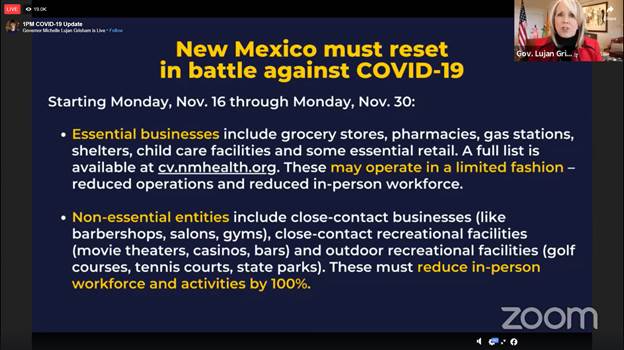
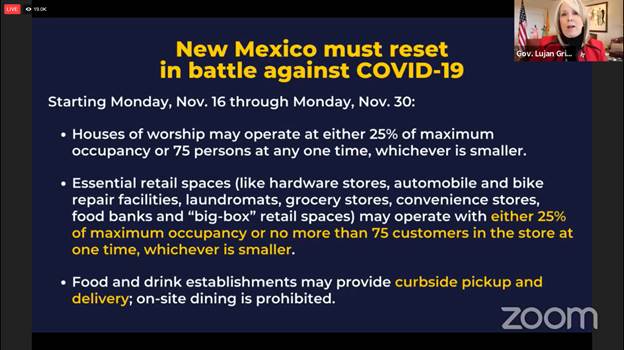
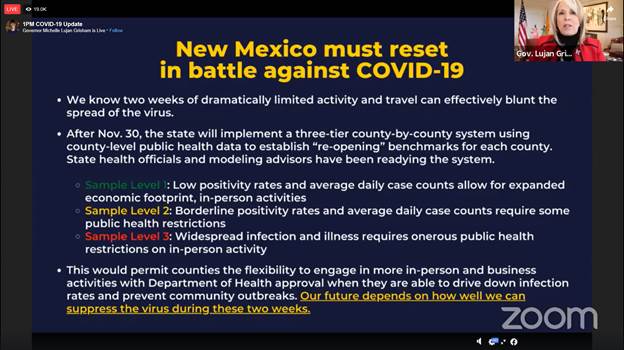
Department of Health announces ‘Red to Green’: COVID-19 testing surge across southern N.M.
Find out more!SANTA FE – – The state of New Mexico has partnered with the U.S. Department of Health and Human Services to launch a dramatically expanded COVID-19 testing effort across southern New Mexico with the goal of driving down positivity rates to turn “red” counties to “green” and restore the economy of the region.
Beginning Thursday, Nov. 5, the Department of Health will establish 12 new testing sites across southern counties, where skyrocketing positivity rates indicate the virus is spreading rapidly.
“We are working around the clock to expand New Mexico’s testing capacity,” said Gov. Michelle Lujan Grisham. “Testing in New Mexico has been and will always be free. It must be accessible and easy. We’re always working on improving that. And together we will beat back this awful virus.”
“More testing does not lead to more cases,” said Lt. Gov. Howie Morales. “More testing helps us identify who is positive and ensure they are informed and are isolated before they spread the virus throughout the community. Testing is an important tool in helping us cut down the spread. I know Southern New Mexico wants to get back to work. Getting tested is an essential step in getting from ‘red’ to ‘green,’ and getting kids safely back in school and more workers safely back to work. The state of New Mexico is grateful to our federal partners for helping to coordinate this important effort in our fight against the virus.”
The following new testing sites will be operational as of Thursday, Nov. 5. Residents must pre-register for a test at www.doineedacovid19test.com[166].
Las Cruces: 3 p.m. to 7 p.m.,New Mexico State University, at 3305 Williams Avenue (Parking Lot #100), Las Cruces, NM 88003
Clovis: 3 p.m. to 7 p.m.,Clovis Community College Gymnasium, 417 Schepps Blvd, Clovis, NM
Hobbs: 3 p.m. to 7 p.m., Ralph Tasker Arena, 800 N Jefferson St, Hobbs, NM 88240
Carlsbad: 3 p.m. to 7 p.m.,New Mexico State University – Carlsbad, 1500 University Dr, Carlsbad, NM
Portales: 3 p.m. to 7 p.m.,Eastern NM University, Greyhound Stadium (Home Parking Lot), 1751 West University Drive, Portales, NM 88130
Socorro: 3 p.m. to 7 p.m.,NM Tech, 801 Leroy Pl (Intersection of Leroy Pl and College Ave), Socorro, NM
Roswell: 3 p.m. to 7 p.m.,Fifth Judicial District Courthouse, 400 N Virginia Ave, Roswell, NM
Ruidoso: 3 p.m. to 7 p.m.,Fire Station 1, 541 Sudderth Dr., Ruidoso, NM
Sunland Park/Santa Teresa: 3 p.m. to 7 p.m.,Sunland Park Casino, 1200 Futurity Dr, Sunland Park, NM
Hatch: 3 p.m. to 7 p.m.,Hatch Community Center, 837 NM-187, Hatch, NM
Deming: 3 p.m. to 7 p.m.,Valley Learning Center, 2300 E Pine St, Deming, NM 88030
Alamogordo: 3 p.m. to 7 p.m.,Alamogordo Civic Center, 800 E 1st St, Alamogordo, NM
The state of New Mexico and its testing partners have processed more than 1.1 million tests since the onset of the COVID-19 pandemic.
Visit cv.nmhealth.org[167] for more information on testing sites, behavioral health resources and the state of New Mexico’s pandemic response.
Staying safe, reducing stress during COVID-19
Find out more!SANTA FE – Gov. Michelle Lujan Grisham and state behavioral health officials on Tuesday highlighted resources to support New Mexicans during the ongoing health emergency.
“For many, the pandemic is a source of fear, anxiety, and uncertainty – but there is plenty we can do to take care of ourselves and our loved ones,” said Gov. Lujan Grisham. “And it’s essential that we take time for genuine self-care. That’s how we’ll find the calm and stability to weather this time – together.”
“Even when we’re quarantining, we’re still all in this together,” said New Mexico Behavioral Health Collaborative CEO Bryce Pittenger. “Please reach out to mental health providers, faith or community leaders, and other people you trust during this time. When we stay connected, we stay strong.”
Key tips include:
Healthy Daily Habits
- Limit your viewing of repetitive news media; consider setting one or two times during the day to check media, and then take a break for more positive thoughts and activities.
- Help children stay connected with friends through virtual means.
- View news on prevention and treatment efforts by visiting New Mexico’s COVID-19 webpage (cv.nmhealth.org) or the Centers for Disease Control (www.cdc.gov).
- Find time and space to talk about your fears and concerns with other adults.
- Exercise (in a COVID-safe manner).
- Read with children, help them write letters to family or friends they miss.
- Plan unstructured time to relax, talk, and play with family members.
Talk to Your Children About the Coronavirus
To make them feel safe
Having conversations with your children allows you to know what they understand and what they might not. It also helps them develop a deeper understanding of the situation through questions and open dialogue, so everyone can be on the same page.
To know the crisis’ impact on them
The coronavirus pandemic is an unprecedented and traumatic event that affects everyone – but it doesn’t affect us all the same way. It’s important to understand what your child is feeling and thinking.
To help them understand what is happening
Ask your children what they know, what they think, what they feel about the situation. If a child asks, “Are people dying?” say yes. Don’t lie, but remember to tell them that most people recover – and that very smart people are working on developing medicines (vaccines) that will keep us safe.
For more resources including tips for parents, behavioral health support, easy ways to explain COVID to children and young adults, and free tutoring for students K-12, visit PullTogether.org.
Self-Care
Self-care is not selfish, nor is it an emergency response plan to be activated when stress becomes overwhelming. Instead, healthy self-care can renew our spirits and help us become more resilient. Think of self-care as having three basic aspects:
Awareness
The first step is to seek awareness. This requires us to slow down and focus inwardly to determine how we are feeling, what our stress level is, what types of thoughts are going through our minds, and whether our behaviors and actions are consistent with who we want to be.
Balance
The second step is to seek balance in all areas of life including work, personal and family life, rest, and leisure. We are more productive when we have had opportunities to rest and relax. Becoming aware of when we are losing balance gives us an opportunity to change.
Connection
The final step is connection. It involves building connections and supportive relationships with co-workers, friends, family, and community. One of the most powerful stress-reducers is social connection.
Reach Out for Help
If you need to talk, please reach out – call 1-855-NMCRISIS (662-7474). If you want to text with a peer support worker use the NMCONNECT app available on smartphones. And if you’re considering taking drastic steps, please call the Suicide Prevention Lifeline at 1-800-273-8255 (1-888-628-9454 para Español).
N.M. updates high-risk states under quarantine order
Find out more!SANTA FE – The state of New Mexico, pursuant to Gov. Michelle Lujan Grisham’s executive order requiring quarantine for out-of-state visitors arriving from high-risk states, on Wednesday, Oct. 21, amended the list of states from which visitors and arriving residents must quarantine.
Per the executive order intended to protect New Mexicans by minimizing the risk of spread from out-of-state travel, Washington has been added to the list of high-risk states as of Oct. 21. A reminder: pursuant to the most recent executive order, the negative test quarantine exemption is no longer in effect. Any individual arriving in New Mexico from any high-risk state must quarantine for a period of 14 days or for the duration of their stay in the state, whichever is shorter, regardless of any negative COVID-19 test.
As of Oct. 21, the list of high-risk states is as follows: Alabama, Alaska, Arizona, Arkansas, Colorado, Connecticut, Delaware, Florida, Georgia, Idaho, Illinois, Indiana, Iowa, Kansas, Kentucky, Louisiana, Maryland, Massachusetts, Michigan, Minnesota, Mississippi, Missouri, Montana, Nebraska, Nevada, New Jersey, North Carolina, North Dakota, Ohio, Oklahoma, Oregon, Pennsylvania, Puerto Rico, Rhode Island, South Carolina, South Dakota, Tennessee, Texas, Utah, Virginia, Washington, West Virginia, Wisconsin and Wyoming.
The state amends the list every Wednesday according to the state-by-state health conditions as defined in the executive order; the updated information is maintained on the cv.nmhealth.org homepage and is disseminated each week in English and Spanish to city and county officials who manage airports within the state. Information regarding traveling can also be found on the New Mexico Tourism Department’s website.
STATE QUARANTINE ORDER
High-risk states: Persons who have arrived in New Mexico from states with a 5% positivity rate or greater over a 7-day rolling average, or a positive test rate greater than 80 per 1 million residents, must physically separate from others in a residence or place of lodging for at least 14 days from the date of their entry into New Mexico or for the duration of their presence in the state, whichever is shorter.
Lower-risk states: Persons arriving from states with a 5% positivity rate or lower over a 7-day rolling average, or a positive test rate lower than 80 per 1 million residents, are not required to self-quarantine. Self-quarantine is still advised for persons arriving from these states, and persons arriving from these lower-risk states are advised to be tested for COVID-19 within 5 to 7 days of their arrival in the state.
COMPLIANCE
Individuals who are quarantined upon arrival into the state from a high-risk state may leave the residence or place of lodging in which they are self-quarantining only for the purposes of medical care.
Self-quarantining individuals should not allow others into the residence or place of lodging in which they are quarantined except for those providing medical care, emergency response or other individuals designated by the Department of Health. Family or household members may visit a quarantined person, but those visitors must then self-quarantine themselves for a period of no less than 14 days.
Non-compliant individuals are subject to involuntary quarantine by the New Mexico Department of Health under the Public Health Emergency Response Act.
Gov. announces renewed public health regulations, reiterates that more will come if alarming rise of COVID-19 is not slowed
Find out more!SANTA FE – Gov. Michelle Lujan Grisham on Tuesday announced the state of New Mexico will implement, and in some cases re-implement, several public health regulations later in the week to stem the alarming rise of COVID-19 illnesses statewide[169].
The governor also reiterated[170] her stark[171] warnings from recent weeks[172] – as COVID-19 infections have spread rapidly throughout all regions of the state[173], including an increase in COVID-19 hospitalizations – that New Mexico may in the near future be compelled to re-enact even more stringent public health controls to blunt the spread of the highly infectious and potentially lethal virus, which has already killed almost 1,000 New Mexicans.
“Without a vaccine, we have only a few tools against this awful, invisible enemy,” said Gov. Lujan Grisham. “We must wear our masks. We must avoid large groups of people. We must limit our travel outside of the home, particularly our time in enclosed indoor spaces. When we do these things, we can crush the virus, and we protect our families, our communities and our state from being overrun by illness. But the virus is booming in New Mexico right now. The increases we’ve seen here are some of the worst in the entire United States this fall. This kind of overwhelming and dramatic statewide spread signals one thing: Too many of us, succumbing to COVID fatigue, are no longer using those tools. We’re no longer taking those precautions. We are giving the virus too many opportunities to spread. And the enemy is taking advantage.
“When the community spread of the virus becomes uncontrollable – and we are fast approaching that point – our only option is to simply shut down those opportunities for the virus. We’ve made so much progress to sustain reopenings and our limited, safe in-person learning efforts – but that progress is rapidly disappearing. Rollbacks will mean more economic turmoil for so many workers and business owners in our state who have already suffered and sacrificed so much. But it is our only chance to prevent more devastating illness and to save lives. No one wants to come to that point. I detest the very thought of it. We have got to turn it around and fast. So I once again urge, with my whole heart, that New Mexicans in every corner of the state, city leaders, county leaders, business leaders, community leaders all take up the mantle of fighting this invisible enemy, of requiring and encouraging safe behavior, of asking more of ourselves to protect New Mexico. The crisis is not over. The virus is still with us. Let’s step it up, all together, once again.”
The state has missed its reopening gating criteria[174] – a measure of the spread of the virus that signals whether additional day-to-day activity is safe and can be permitted – for several weeks. Absent an improvement in those data, the state of New Mexico will once again restrict indoor dining service and significantly roll back maximum occupancy allowances at other retail and dining establishments.
The state’s operative emergency public health order will expire Friday, Oct. 16; it will be extended, with amendments.
The governor and state health officials will, effective Friday, Oct. 16, append the following changes to the public health order and associated public health guidance documents:
TEMPORARY CLOSING TIME
Any food or drink establishment in New Mexico serving alcohol must close at 10:00 p.m. each night. The governor’s Economic Recovery Council, which has advised her administration on re-opening strategies to strengthen and sustain the state’s workforce and economy through this crisis, made the recommendation for this mandatory closing time.
“New Mexico hotels and restaurants and our hospitality employees have suffered more from COVID than any other sector,” said Allan Affeldt, hotel and restaurant owner and member of the Economic Recovery Council. “In spite of that, the overwhelming majority of hotels and restaurants are in support of the state’s COVID-Safe Practices and are doing our best to keep our guests and staff safe so our economy can recover faster. Unfortunately, there are some restaurants and bars that blatantly disregard public safety by operating late and in gross violation of safe practices and common sense. These business owners threaten the survival of all businesses in the state and the health of their customers and staff. These problems nearly all occur after hours, when some restaurants are simply acting as bars, where spread of the virus is not inhibited. Because of this, I and many of my fellow hotel and restaurant operators are in full support of a temporary limit on operating hours for late-night restaurants and bars. Together we can get all New Mexico businesses open sooner if we take these simple steps to help limit viral spread.”
Other states – including Kentucky, Ohio, South Carolina and Washington – have enacted similar closing times for places of business selling alcohol in order to slow the spread of COVID-19 in those establishments[175]. The state, which issues liquor and restaurant licenses to food and drink establishments, will rigorously enforce this requirement.
HOTEL OCCUPANCY
Maximum occupancy restrictions will be reduced to 60 percent for places of lodging that have completed the N.M. Safe Certified training program[176] and to 25 percent for places of lodging that have not completed the training program – a reduction of maximum occupancy from 75 percent and 50 percent, respectively.
QUARANTINE
The governor will amend her executive order[177] that requires a period of mandatory self-quarantine for individuals arriving into New Mexico from out of state. Individuals arriving from “higher-risk states,” or those with a test positivity rate exceeding 5 percent and a test positivity rate higher than 80 per 100,000 residents, will no longer be exempt from the period of mandatory self-quarantine if they test negative for COVID-19 within 72 hours of their arrival into New Mexico. All individuals arriving from those higher-risk states – a list of which is updated each Wednesday at cv.nmhealth.org/travel-recommendations[178] – must self-quarantine for a period of no less than 14 days or for the duration of their stay in New Mexico, whichever is shorter.
MASS GATHERINGS
Mass gatherings of more than 5 individuals are once again prohibited. Previously the state had allowed gatherings of more than 10 individuals. A “mass gathering” is defined as any public or private gathering, organized event, ceremony, parade, organized amateur contact sport, or other grouping that brings together individuals in an indoor or outdoor space.
The governor and state health officials are scheduled to discuss the extended public health order and other COVID-19 data in the state’s regular COVID-19 public update Thursday; additional details about that event will be disseminated later this week.
State of New Mexico encourages residents to ‘stay inside the triangle,’ limit daily activities outside the home
Find out more!SANTA FE – Gov. Michelle Lujan Grisham and state health officials this week once again reminded New Mexicans to limit their travel outside of the home in order to reduce the risk of spreading the virus.
“Every time we leave the house, we take a risk, because the virus is out there, and it is an awful, invisible enemy,” said Gov. Lujan Grisham. “But if and when we must go out, we should think about how to minimize the number of places we visit, the things we do, the people we come into contact with. If we limit ourselves to three trips or places to go or things to do each day – or fewer! – we will ultimately reduce the opportunities for catching and spreading the virus. And it will make an enormous difference in our state’s overall health and well-being and permit us to get more students safely back in the classroom and more New Mexicans safely back to work.”
New Mexicans are encouraged to think about categorizing their limited daily travel outside the home into the following categories:
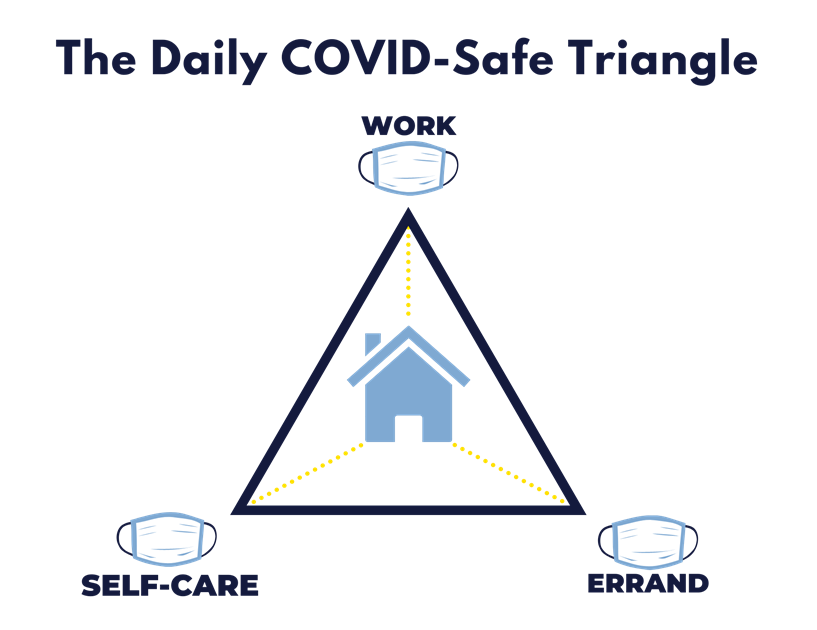
COVID-safe self-care options can include going for a solo walk or a run, walking the dog, visiting a park, taking a hike alone or with a small group — all while practicing social distancing from others and wearing a facemask.
The following public health restrictions and guidelines remain in place:
- Masks are required in all public settings in New Mexico for the benefit of public health.
- Gatherings of more than 10 are not permitted.
- A period of self-quarantine is mandatory for visitors and New Mexicans returning from out-of-state from most U.S. states.[179]
“There’s a safer option and a less-safe option for everything we do outside of the home,” said Human Services Secretary David Scrase, M.D. “I hope all New Mexicans choose the safer option: Takeout or delivery instead of dining in, ordering online instead of browsing through the aisles of a store, visiting a family member or friend over the phone or the computer instead of spending time indoors and in person, going for a jog alone with a mask instead of hiking with a large group of friends. Of course, staying home in the first place is always the safest choice. If more of us make these choices, the safer decisions, we will see fewer illnesses in our state, and we will begin to once again turn the tide in our fight against this virus.”
SNAP benefits
Find out more!Individuals seeking to apply for SNAP benefits may apply online through www.yes.state.nm.us[180] or by phone at 1-800-283-4465.
The Human Services Department provides services and benefits to more than 1 million New Mexicans through several programs including: the Medicaid Program, Temporary Assistance for Needy Families (TANF) Program, Supplemental Nutrition Assistance Program (SNAP), Child Support Program, and several Behavioral Health Services.
State amends guidance for small groups in exercise setting, outdoor activities
Find out more!An amended emergency public health order, which is in effect through mid-October, will permit youth sports conditioning and skills development, with no more than 10 individuals in any one group, in accordance with COVID-Safe Practices[181]. Competitive contact play remains off-limits.
In addition, New Mexicans may overnight camp at most state parks in groups of no more than 10. That change will be effective Oct. 1.
Other changes include:
- Pick-your-own pumpkin patches will be permitted to operate in accordance with COVID-Safe Practices for agri-tourism businesses[182]
- Ice skating rinks may operate for athletic training and practice by reservation only
- Swimming pools may open with no more than 10 individuals in a pool at any one time; previously swimming pools were permitted only to provide lane swimming.
The state’s full complement for COVID-Safe Practices for different industries and activities, compiled with the assistance of the Economic Recovery Council and industry leaders, is available here[183].
“We all want to keep making progress in combating the virus,” said Gov. Lujan Grisham. “New Mexicans have done incredible work. These changes are hopefully an opportunity for families and kids to safely enjoy more activities. But we’ve got to keep making the right decisions – keep wearing face coverings, keep avoiding large groups and contact with others – and avoid a false sense of security. The results are clear: A safer state, safer communities and fewer dangerous illnesses in New Mexico. We can keep up the great work, I am confident, and my goal will be to make additional moves in this direction this fall.”
New Mexico’s progress in slowing the incidence and spread of COVID-19 has continued, with the statewide 7-day rolling average of daily cases at 90 as of Sept. 15, well below the gating criteria target of 168[184]. The statewide rate of spread, or r-effective, remains below 1, meaning the virus is spreading slower and not exponentially. Although the state’s COVID-19 hospitalizations remain significantly lower than earlier this summer, the southeast region made up the highest percentage of hospital admissions last week, according to the state Medical Advisory Team[185].
COVID-19 TESTING:
The state of New Mexico would like to remind residents that testing for COVID-19 is free and available to all at Department of Health offices and testing sites, many of which have expanded hours of availability. Information about those sites is available at cv.nmhealth.org[186].
CENSUS:
The state also reminds New Mexicans that a complete count of state residents for the 2020 Census is essential to ensuring billions in federal funds — for education, food assistance, roadway infrastructure, health care and more – are provided for New Mexicans over the next decade. The Census is simple, secure and important – please visit my2020census.gov[187] to complete the form or call 844-330-2020.
Department of Health announces COVID-19 testing now open to all workers in New Mexico
Find out more!For more information visit the Department of Health’s COVID-19 website, https://cv.nmhealth.org/[188] updated daily with the latest testing numbers, our testing location directory[189] and the ability to track cases by zip code.
New Mexicans can continue to call the Department of Health’s coronavirus hotline at 855-600-3453 with health-related questions. For non-health-related questions or concerns call 833-551-0518 or visit newmexico.gov[190].
Retailers, businesses shall require employees to wear face coverings
Find out more!SANTA FE— Gov. Michelle Lujan Grisham on Tuesday urged business owners to begin preparing for the first phase of reopening New Mexico while the state continues to fight the COVID-19 pandemic.
Department of Health Secretary Kathyleen Kunkel has amended the state public health emergency order clarifying some of the steps businesses must take in order to operate.
- Beginning Wednesday, May 6, all large grocery and large retail spaces (those greater than 50,000 square feet in size) and all restaurants currently operating curbside and delivery service will be required to ensure that all employees have at least cloth face coverings.
- All employees must wear their face coverings in the workplace at all times when in the presence of others.
- Beginning Monday, May 11, all essential businesses of any size currently operating under the public health order must also comply with the face covering requirement.
- All employers are strongly encouraged to acquire the face coverings for all employees over the next week, in preparation for a potential Phase One reopening in mid-May. Otherwise they may not be able to operate in compliance with state requirements.
- Retailers will not be required to provide face coverings for customers but are encouraged to post signage strongly encouraging customers to wear their own masks. Retailers at their own discretion may require customers to wear masks.
The administration last week issued a set of COVID-safe practices for all employers and an additional set for all retailers (see attached). Other COVID-safe requirements and best practices specific to other industries are under development.
The governor last week extended her stay-at home order to May 15, with modifications allowing some limited, additional retail and recreational opportunities. Further reopening will depend on businesses and individuals doing their part to keep their neighbors safe in order to meet gating criteria.
“If New Mexicans don’t behave safely, we won’t be able to reopen more than we have. Every single one of us has to do their part,” said Gov. Lujan Grisham.
Auto insurers in New Mexico refund premiums due to driving less
Click here [191]for more info.
Related State Information:
- Individuals Experiencing Financial Hardship, click here[197].
- Video: Homemade face coverings[198]
- State to use emergency alert system for important communications[199]
National Information
HUD SECRETARY BEN CARSON INTRODUCES FIND SHELTER TOOL TO HELP COMMUNITY MEMBERS LOCATE SERVICE PROVIDERS AND LOCAL RESOURCES
Online tool provides mapping and contact information for local food, shelter, clothing, and healthcare resources
Find out more!WASHINGTON – U.S. Department of Housing and Urban Development (HUD) Secretary Ben Carson today introduced the Find Shelter tool, a new resource developed by the Department to help individuals and families in need to locate nearby resources. Specifically, users can search for facilities that provide shelter, clothing, health clinics, and food pantries to those in need. Find Shelter provides mapping and contact information for these service providers and the site is optimized for mobile use.

“The Find Shelter website is another tool with which we can relieve homelessness and provide people with the resources they need,” said Secretary Ben Carson. “Particularly as we continue to recover from the coronavirus pandemic, it’s important to make sure individuals and families know where to go to get help.”
The tool is designed to help community members serve their neighbors in need. Particularly during the coronavirus pandemic there has been a surge in Neighbors Helping Neighbors[200] across the country, which has been an important force in serving vulnerable Americans. The Find Shelter tool will only bolster this effort get people the help they need. The site includes downloadable, printable posters and palm cards that can be displayed near public computers for individuals and families looking to locate resources.
Research from HUD indicates that in 2019, most of the country experienced a combined decrease in homelessness, with the exception of significant increases in unsheltered and chronic homelessness on the West Coast, particularly in California and Oregon, offset those nationwide decreases, causing an overall increase in homelessness of 2.7 percent. HUD’s 2019 Annual Homeless Assessment Report to Congress found that 567,715 persons experienced homelessness on a single night in 2019, an increase of 2.7 percent since 2018, but a nearly 11 percent decline since 2010. The number of families with children experiencing homelessness declined 5 percent from 2018 and more than 32 percent since 2010. Local communities also reported a continuing trend in reducing veteran homelessness across the country-the number of veterans experiencing homelessness fell 2.1 percent since January 2018 and by 50 percent since 2010.
COVID-19 Vaccine Information
Click the link below to follow the current COVID-19 vaccine information as provided by the CDC:
https://www.cdc.gov/coronavirus/2019-ncov/vaccines/index.html[201]
The CDC website also includes information on:
- What to expect at your vaccination appointment[202]
- What to expect after getting vaccinated[203]
- Post-vaccination considerations for healthcare personnel[204]
- Post-vaccination considerations for long-term care residents[205]
Current Virus updates from the CDC with guidelines and recommendations here[206].
Testing Information provided by CDC here[207].
CDC guidance on determining when someone is recovered: https://www.cdc.gov/coronavirus/2019-ncov/hcp/disposition-in-home-patients.html[208]
Guidelines to follow from the CDC on how to clean and disinfect your home.
Find out more!- Coronaviruses on surfaces and objects naturally die within hours to days. Warmer temperatures and exposure to sunlight will reduce the time the virus survives on surfaces and objects.Normal routine cleaning with soap and water removes germs and dirt from surfaces. It lowers the risk of spreading COVID-19 infection.
- Disinfectants kill germs on surfaces. By killing germs on a surface after cleaning, you can further lower the risk of spreading infection. EPA-approved disinfectants are an important part of reducing the risk of exposure to COVID-19. If disinfectants on this list are in short supply, alternative disinfectants can be used (for example, 1/3 cup of bleach added to 1 gallon of water, or 70% alcohol solutions).
- Store and use disinfectants in a responsible and appropriate manner according to the label. Do not mix bleach or other cleaning and disinfection products together–this can cause fumes that may be very dangerous to breathe in. Keep all disinfectants out of the reach of children.
- Do not overuse or stockpile disinfectants or other supplies. This can result in shortages of appropriate products for others to use in critical situations.
- Always wear gloves appropriate for the chemicals being used when you are cleaning and disinfecting. Additional personal protective equipment (PPE) may be needed based on setting and product. For more information, see CDC’s website on Cleaning and Disinfection for Community Facilities.
- Practice social distancing, wear facial coverings, and follow proper prevention hygiene, such as washing your hands frequently and using alcohol-based (at least 60% alcohol) hand sanitizer when soap and water are not available.
CDC recommends guidelines whenever running essential errands during stay at home order
Click here[209] for more details!
National Indian Health Board
NIHB helps answer some of the most asked questions regarding testing in Indian country. Learn more about vulnerable populations, caring for elders, what the difference is between social distancing, isolation, and quarantine and much more. Read more here[210].
Related National Information:
- Families Living in Close Quarters with Extended Family: https://www.cdc.gov/coronavirus/2019-ncov/daily-life-coping/living-in-close-quarters.html[214]
- Sharing the Facts: Stop the Spread of Rumors[215]
- Prevent Getting Sick: https://www.cdc.gov/coronavirus/2019-ncov/prevent-getting-sick/index.html[216]
- Public Health Recommendations for Community-Related Exposure: https://www.cdc.gov/coronavirus/2019-ncov/php/public-health-recommendations.html[217]
- If you are Sick: https://www.cdc.gov/coronavirus/2019-ncov/if-you-are-sick/[218]
- Caring for Someone at Home: https://www.cdc.gov/coronavirus/2019-ncov/if-you-are-sick/care-for-someone.html[219]
- FBI warns parents, educators, caregivers and children about the dangers of being online
School Information
Related Education Information:
- National Indian Education Association[223]
- Sesame Street in Communities has an amazing website for both providers and parents of young children 0-5. Offering fun printable activities, videos, games and information for both parents and providers to support their children’s social emotional development and learning. www.sesamestreetincommunities.org[224]
- Bright By Text, is a free texting service for parents providing tips, videos and local event information that supports parents in everyday moments. Text 274448 and the word PLAY
- PBSParents.org[225], a free and useful website from PBS that gives parents tips, resources, activities, videos and games for their children.www.pbsparents.org[226]
- PBSKids Daily Newsletter for parents to support learning at home. Free and current with the latest news and updates. https://www.pbs.org/parents/pbskidsdaily[227]
- For Native communities we have https://sites.google.com/view/vmm-pbs-media/home[228]
Attention Tribal Employees
This section is for Tribal Employees who may not receive important information in a timely manner as it pertains to their department.
NMDWS applies for “Lost Wages Assistance” funds
(Albuquerque, NM) – Today, the New Mexico Department of Workforce Solutions (NMDWS) submitted an application to the United States Federal Emergency Management Administration for funding that would provide an additional $300 per week payments to New Mexicans receiving Unemployment benefits. U.S. Department of Labor guidance allows for existing Unemployment Trust Fund payments delivered by NMDWS to count as 25% matching funds for the program.
“Politics don’t matter in a crisis; my focus and our state’s focus has been and will continue to be delivering resources to New Mexicans in need,” said Gov. Lujan Grisham. “I maintain that a Congressional aid package is needed to bolster unemployment funds for New Mexicans, but we will take every opportunity to help families and workers throughout this pandemic.”
“Governor Lujan Grisham is asking all of us to work together and find any resources to help New Mexicans through this tough time,” said Bill McCamley, Secretary of the New Mexico Workforce Solutions Department. “Though it is unclear at this time when funding will become available, or how much funding is available, the Department will work hard to distribute funds to New Mexicans as quickly as possible. Our friends and neighbors need resources to pay for rent, utilities, food, childcare, and many other services and we will get as much money as possible into their pockets.”
NMDWS looks forward to receiving a response from FEMA to begin planning and implementing the distribution of additional funds quickly to New Mexicans who need it. There is no need for claimants to contact NMDWS at this time. We will announce more information once it becomes available.
News release provided by NMDWS.
Work search waiver scheduled to end on July 18th
Find out more!
(Albuquerque, NM) – In March, the New Mexico Department of Workforce Solutions (NMDWS) waived the work search requirements for Unemployment Insurance claimants who had lost their job or had hours reduced as a result of COVID-19. This waiver will end on July 18, 2020.
Claimants receiving benefits will be required to verify that at least two work searches occurred each week when submitting their certification. In upcoming weeks, NMDWS in coordination with New Mexico Workforce Connection offices, will be providing guidance, training, and workshop options to claimants that will satisfy the work search requirement for the week in which they attend.
Individuals receiving Pandemic Unemployment Assistance (PUA) – the self-employed, independent contractors, and gig economy workers – are not required by federal law to conduct work searches and will continue to receive a waiver. While the U.S. Department of Labor requires work searches for claimants receiving standard unemployment benefits, they have not instituted the same requirement for claimants on PUA.
In addition to the above change, NMDWS is advising all claimants that the last payable week for Federal Pandemic Unemployment Compensation (FPUC), an additional benefit of $600 per week, will be the week ending July 25, 2020.
Statement from NMDWS Cabinet Secretary Bill McCamley on overpayment letters sent to PUA claimants
Find out more!On behalf of the agency, I sincerely apologize that the notices caused concern and frustration at an already stressful time. To provide clarification on what claimants need to do next, we are sending out direct communication that provides guidance on how individuals can provide the Department with the information necessary to clear any pending issues or alleviate a hold on their claim. Although notices are necessary and required to avoid a misuse of taxpayer resources, where appropriate, we can supplement and/or replace them with clarifying information that helps claimants comply with all aspects of UI requirements.
Our work over the past several months has always been focused on getting New Mexicans the benefits and resources to which they are entitled as quickly as we can. But we can always do better and are committed to begin an examination of how we can communicate more clearly and effectively to New Mexicans in this troubling time.
Bill McCamley
Secretary, New Mexico Department of Workforce Solutions
NMDWS receives grant for employment recovery for displaced workers
All CARES Act benefits are 100% federally funded
Find out more!With funding received from the grant, NMDWS has identified several areas of focus:
- Addressing shortage of healthcare workers in the state. Allocating funds to be utilized in providing training for needed workers to respond to the health crisis, including direct care and public health response (ie, contact tracing, outreach);
- Partnership with the New Mexico Economic Development Department to provide customized training for businesses who plan to re-tool their operations, ie, manufacture PPE, sanitizing equipment/supplies, or training on deep cleaning techniques to meet demand statewide; and
- Partnership with the Bernalillo County Commissioners and the Central Workforce Development Board to address employment for non-violent offenders scheduled for early release due to COVID-19. A transitional jobs program will be initiated to promote successful transition into work, including case management, job readiness, soft skill development, and training.
“The proposed funds will support New Mexico businesses and job seekers as they innovate job site practices to promote healthy and productive workplaces, as well as target individuals who – with additional training and education – could bolster their earning potential,” said NMDWS Deputy Secretary Yolanda Montoya-Cordova.
13 weeks of extended Unemployment benefits now available
All CARES Act benefits are 100% federally funded
Find out more!The additional weeks of benefits are provided by Pandemic Emergency Unemployment Compensation (PEUC). Once a claimant’s benefit year ceases, they can then establish a new benefit year to requalify for regular unemployment.
PEUC is for individuals who have exhausted 26 weeks of regular Unemployment Insurance benefits; are able to work, available to work, and actively seeking work; or are partially unemployed.
Eligible individuals will receive the same amount of Unemployment Insurance benefits as the previous weeks they received. They will also receive Federal Pandemic Unemployment Compensation (FPUC), an additional $600 to their weekly benefits up until July 25, 2020 (Max. $1,061 in New Mexico).
Pandemic Unemployment Assistance (PUA), FPUC, and PEUC benefits are 100% federally funded and employers will not be charged for any benefits paid under a CARES Act program.
There are two ways to file for PEUC:
- Online by going to the New Mexico Workforce Connection Online System at www.jobs.state.nm.us[229]. Individuals can then access the UI Tax & Claims System.
- On the left navigation menu, individuals will click on “Apply for Federal Extension Benefits”
- By phone at 1-877-664-6984. The department will continue to operate under extended hours for the Unemployment Insurance Operations Center with the hours of 7am – 7pm Monday through Friday.
If an individual qualifies for benefits under regular state unemployment Insurance they will not be eligible for Pandemic Unemployment Assistance.
REMINDER: It is not necessary to call the Department to confirm that your claim has been filed or to check the status. If there are any unresolved issues impacting your claim or if we have questions, we will contact you.
Important note: None of the benefits described above, nor unemployment benefits of any kind, are available to employees who quit without good work-related cause, refuse to return to work, or refuse to receive full-time pay. Refusing to return to work could result in a disqualification for benefit eligibility. Attempts to collect unemployment benefits after quitting a job without good work-related cause is considered to be fraud. The CARES Act specifically provides for serious consequences for fraudulent cases including fines, confinement, and an inability to receive future unemployment benefits until all fraudulent claims and fines have been repaid. Employers are encouraged to utilize the New Hire system to report those employees who fail to return to work.
Additional information for workers affected by COVID-19, including frequently asked questions, can be found at www.dws.state.nm.us/COVID-19-Info[230]. For the latest announcements and updates, follow NMDWS on Twitter, Instagram, and YouTube.
New Guidance about COVID-19 Economic Impact Payments for Social Security and Supplemental Security Income (SSI) Beneficiaries from Social Security Commissioner Andrew Saul
Find out more!People who receive Social Security retirement, survivors, or disability insurance benefits and who did not file a tax return for 2018 or 2019 and who have qualifying children under age 17 should now go to the IRS’s webpage at www.irs.gov/coronavirus/economic-impact-payments[231] to enter their information instead of waiting for their automatic $1,200 Economic Impact Payment. By taking proactive steps to enter information on the IRS website about them and their qualifying children, they will also receive the $500 per dependent child payment in addition to their $1,200 individual payment. If Social Security beneficiaries in this group do not provide their information to the IRS soon, they will have to wait to receive their $500 per qualifying child.
The same new guidance also applies to SSI recipients, especially those who have qualifying children under age 17. To receive the full amount of the Economic Impact Payments you and your family are eligible for, go to the IRS’s Non-Filers: Enter Payment Info page at www.irs.gov/coronavirus/economic-impact-payments[231] and provide information about yourself and your qualifying children.
Additionally, any new beneficiaries since January 1, 2020, of either Social Security or SSI benefits, who did not file a tax return for 2018 or 2019, will also need to go to the IRS’s Non-Filers website to enter their information.
Lastly, for Social Security retirement, survivors, or disability beneficiaries who do not have qualifying children under age 17, you do not need to take any action with the IRS. You will automatically receive your $1,200 economic impact payment directly from the IRS as long as you received an SSA-1099 for 2019.
For SSI recipients who do not have qualifying children under age 17, we continue to work closely with Treasury in our efforts to make these payments automatically. Please note that we will not consider Economic Impact Payments as income for SSI recipients, and the payments are excluded from resources for 12 months.
The eligibility requirements and other information about the Economic Impact Payments can be found here: www.irs.gov/coronavirus/economic-impact-payment-information-center[232]. In addition, please continue to visit the IRS at www.irs.gov/coronavirus[233] for the latest information.
We will continue to update Social Security’s COVID-19 web page at www.socialsecurity.gov/coronavirus/[234] as further details become available.”
To get more Social Security news, follow the Press Office on Twitter @SSAPress[235]
Related Employee Information:
- Mescalero IHS: #mescaleroihsinformation
- Tribal: #tribalinformation
- State: #stateinformation
- National: #nationalinformation
- local School information: #schoolinformation
- here: #newguidance
- here: http://mescaleroapachetribe.com/mental-health-during-covid-19-epidemic/
- Mescalero Apache Tribe COVID-19 Test Results: https://mescaleroapachetribe.com/17459/mescalero-apache-tribe-covid-19-test-results-149/
- Download: https://mescaleroapachetribe.com/wp-content/uploads/2022-02-28-EO-22-03.pdf
- Download: https://mescaleroapachetribe.com/wp-content/uploads/2022-02-01-EO-22-02.pdf
- Download: https://mescaleroapachetribe.com/wp-content/uploads/2022-01-05-EO-22-01.pdf
- Download: https://mescaleroapachetribe.com/wp-content/uploads/2021-11-24-Executive-Order-21-07.pdf
- Download: https://mescaleroapachetribe.com/wp-content/uploads/2021-11-10-EO-21-06-1.pdf
- Download: https://mescaleroapachetribe.com/wp-content/uploads/2021-19-08-Executive-Order-21-05.pdf
- Download: https://mescaleroapachetribe.com/wp-content/uploads/2021-11-06-Executive-Order-21-04.pdf
- Download: https://mescaleroapachetribe.com/wp-content/uploads/EO-21-04-summary.pdf
- Download: https://mescaleroapachetribe.com/wp-content/uploads/06-11-20-Tribal-Member-letter-from-President-Aguilar-1.pdf
- Download: https://mescaleroapachetribe.com/wp-content/uploads/2021-04-09-EO-21-03-Changes-to-COVID19-Limitations-1.pdf
- Download: https://mescaleroapachetribe.com/wp-content/uploads/2021-03-09-Executive-Order-21-02.pdf
- Download: https://mescaleroapachetribe.com/wp-content/uploads/2021-02-05-Executive-Order-21-01.pdf
- Download: https://mescaleroapachetribe.com/wp-content/uploads/2021-01-04-Executive-Order-re-Indoor-Church-Services.pdf
- Download: https://mescaleroapachetribe.com/wp-content/uploads/Tribal-member-letter-12-15-20-1.pdf
- COVID-19 Economic Assistance Program for the Mescalero Apache Tribe: https://mescaleroapachetribe.com/13636/covid-19-economic-assistance-program-for-the-mescalero-apache-tribe/
- COVID-19 Economic Support Payment for the Mescalero Apache Tribe: https://mescaleroapachetribe.com/13612/covid-19-economic-support-payment-for-the-mescalero-apache-tribe/
- Mescalero Apache Tribe Isolation Site: https://mescaleroapachetribe.com/13577/mescalero-apache-tribe-isolation-site/
- Tribal member letter from President Aguilar: https://mescaleroapachetribe.com/13203/tribal-member-letter-from-president-aguilar-2/
- Download: https://mescaleroapachetribe.com/wp-content/uploads/2020-11-23-New-EO-re-COVID19-Restrictions.pdf
- Download: https://mescaleroapachetribe.com/wp-content/uploads/2020-11-05-Executive-Order-20-14-re-Lockdown-1.pdf
- Download: https://mescaleroapachetribe.com/wp-content/uploads/2020-10-29-Executive-Order-20-13-REVISED-1.pdf
- Download: https://mescaleroapachetribe.com/wp-content/uploads/2020-10-14-Executive-Order-20-12.pdf
- Download: https://mescaleroapachetribe.com/wp-content/uploads/2020-10-14-EO-re-New-Restrictions-SUMMARY.pdf
- Download: https://mescaleroapachetribe.com/wp-content/uploads/IMPORTANT-DATES-FOR-EXECUTIVE-ORDER-20-12.pdf
- Download: https://mescaleroapachetribe.com/wp-content/uploads/2020-09-09-Revising-EO-20-09-and-20-10.pdf
- Download: https://mescaleroapachetribe.com/wp-content/uploads/2020-09-09-Summary-of-Current-COVID-19-Restrictions.pdf
- Download: https://mescaleroapachetribe.com/wp-content/uploads/Executive-Order-20-10.pdf
- www.mescaleroapachetribe.com: http://www.mescaleroapachetribe.com/
- Download: https://mescaleroapachetribe.com/wp-content/uploads/Executive-Order-20-09-08-07-20.pdf
- Download: https://mescaleroapachetribe.com/wp-content/uploads/2020-08-07-Summary-of-New-EO-1.pdf
- Download: https://mescaleroapachetribe.com/wp-content/uploads/06-11-20-Tribal-Member-letter-from-President-Aguilar.pdf
- Download: https://mescaleroapachetribe.com/wp-content/uploads/06-12-20-Summary-of-EO.pdf
- www.mescaleroapachetribe.com: http://www.mescaleroapachetribe.com
- Download: https://mescaleroapachetribe.com/wp-content/uploads/Executive-Order-20-05-05-23-20.pdf
- Download: https://mescaleroapachetribe.com/wp-content/uploads/Application-for-Economic-Support-Payment-FINAL.pdf
- Download: https://mescaleroapachetribe.com/wp-content/uploads/20-39-Establishing-Economic-Support-Payment-Program.pdf
- Download: https://mescaleroapachetribe.com/wp-content/uploads/Executive-Order-20-04.pdf
- Download: http://mescaleroapachetribe.com/wp-content/uploads/Executive-Order-20-02-03-24-2020.pdf
- Download: http://mescaleroapachetribe.com/wp-content/uploads/Questions-on-Executive-Order-20.02-03-30-20.pdf
- Download: https://mescaleroapachetribe.com/wp-content/uploads/20200515_085628-772x1024.jpg
- Download: https://mescaleroapachetribe.com/wp-content/uploads/Dear-Tribal-Members-04-28-20-1-scaled.jpg
- Download: http://mescaleroapachetribe.com/wp-content/uploads/2020-03-20-Press-Release-Emergency-Declaration.pdf
- Download: http://mescaleroapachetribe.com/wp-content/uploads/Elderly-Food-Vouchers-and-Utility-Program-03-25-20.pdf
- Download: http://mescaleroapachetribe.com/wp-content/uploads/2020-03-19-Emergency-Proclamation-Resolution-EXECUTED.pdf
- Download: http://mescaleroapachetribe.com/wp-content/uploads/Tribal-Member-letter-2020-03-20.pdf
- Download: http://mescaleroapachetribe.com/wp-content/uploads/Comm.-Mitigation-Strategies-for-MAT.pdf
- Public Defender PUBLIC NOTICE (11-09-20): https://mescaleroapachetribe.com/13460/public-defender-public-notice/
- Gas Company PUBLIC NOTICE (11-06-20): https://mescaleroapachetribe.com/13457/gas-company-public-notice/
- Social Services PUBLIC NOTICE (11-09-20): https://mescaleroapachetribe.com/13454/social-services-public-notice/
- Tribal Finance (Accounting) PUBLIC NOTICE (11-09-20): https://mescaleroapachetribe.com/13450/tribal-finance-public-notice/
- Tribal Maintenance PUBLIC NOTICE (11-09-20): https://mescaleroapachetribe.com/13446/tribal-maintenance-public-notice/
- Tribal Court PUBLIC NOTICE (11-09-20): https://mescaleroapachetribe.com/13435/mescalero-tribal-court-public-notice/
- VAWA memo (07-29-20): https://mescaleroapachetribe.com/wp-content/uploads/VAWA-memo-07-29-20.pdf
- Gas Company NEW TEMP HOURS (07-28-20): https://mescaleroapachetribe.com/12735/gas-company-temp-hours/
- Tribal Court NEW TEMP HOURS (07-28-20): https://mescaleroapachetribe.com/12723/tribal-court-temp-hours/
- Tribal Court PUBLIC NOTICE (06-23-20): https://mescaleroapachetribe.com/wp-content/uploads/Mescalero-Tribal-Court-public-notice-06-23-20.pdf
- Mescalero Education Department (06-23-20): https://mescaleroapachetribe.com/12547/new-information-from-the-mescalero-education-department/education-dept-public-notice-06-23-20/
- Tribal Court Announcement (05-27-20) : https://mescaleroapachetribe.com/12344/tribal-court-opening-for-bonds/
- First COVID-19 confirmed case in Lincoln County, NM: https://www.ruidoso-nm.gov/news-info/first-covid-19-case-confirmed-in-lincoln-county
- https://www.env.nm.gov/wp-content/uploads/2020/05/2020-05-22-Food-permits-suspended-.pdf: https://www.env.nm.gov/wp-content/uploads/2020/05/2020-05-22-Food-permits-suspended-.pdf
- Download: http://mescaleroapachetribe.com/wp-content/uploads/Hollowman-AFB-NEWS-RELEASE-03-31-20-785x1024.jpeg
- Download: http://mescaleroapachetribe.com/wp-content/uploads/City-of-Alamogordo-PSA-03-31-20-799x1024.jpg
- https://www.cdc.gov/norovirus/about/index.html: https://www.cdc.gov/norovirus/about/index.html
- https://www.cdc.gov/coronavirus/2019-ncov/vaccines/faq.html: https://www.cdc.gov/coronavirus/2019-ncov/vaccines/faq.html
- https://www.cdc.gov/coronavirus/2019-ncov/if-you-are-sick/quarantine.html: https://www.cdc.gov/coronavirus/2019-ncov/if-you-are-sick/quarantine.html
- Download: https://mescaleroapachetribe.com/wp-content/uploads/COVID-19-Vaccine.jpg
- “When should I test if I’m a direct COVID-19 contact?”: https://mescaleroapachetribe.com/13524/when-should-i-test-if-im-a-direct-covid-19-contact/
- https://www.cdc.gov/coronavirus/2019-ncov/need-extra-precautions/groups-at-higher-risk.html: https://www.cdc.gov/coronavirus/2019-ncov/need-extra-precautions/groups-at-higher-risk.html
- https://www.nichd.nih.gov/health/topics/preconceptioncare: https://www.nichd.nih.gov/health/topics/preconceptioncare
- https://www.cdc.gov/coronavirus/2019-ncov/need-extra-precautions/what-you-can-do.html: https://www.cdc.gov/coronavirus/2019-ncov/need-extra-precautions/what-you-can-do.html
- https://www.cdc.gov/coronavirus/2019-ncov/community/mental-health-non-healthcare.html: https://www.cdc.gov/coronavirus/2019-ncov/community/mental-health-non-healthcare.html
- https://www.cdc.gov/coronavirus/2019-ncov/prevent-getting-sick/gloves.html: https://www.cdc.gov/coronavirus/2019-ncov/prevent-getting-sick/gloves.html
- Download: http://mescaleroapachetribe.com/wp-content/uploads/CDC-How-to-Remove-Gloves.pdf
- Download: http://mescaleroapachetribe.com/wp-content/uploads/CDC-gloves-not-enough.png
- Download: http://mescaleroapachetribe.com/wp-content/uploads/IHS-letter-03-29-20-.png
- Download: http://mescaleroapachetribe.com/wp-content/uploads/Coping-with-stress-3-30-20.jpg
- Download: http://mescaleroapachetribe.com/wp-content/uploads/Mescalero-IHS-COVID-19-Parenting-3-30-20.pdf
- Download: http://mescaleroapachetribe.com/wp-content/uploads/Mescalero-IHS-Process-03-25-20.pdf
- here: https://cv.nmhealth.org/
- here: https://cvprovider.nmhealth.org/directory.html
- here: https://www.aastec.net/services-programs/public-health-alerts/#coronavirus
- cv.nmhealth.org/dashboard: http://cv.nmhealth.org/dashboard
- here: https://indd.adobe.com/view/3f732e94-0164-424d-9ac6-a0ace27e70c8
- here: https://www.env.nm.gov/rapid-response-data/
- Biden Administration: https://www.whitehouse.gov/briefing-room/press-briefings/2022/01/12/press-briefing-by-white-house-covid-19-response-team-and-public-health-officials-78/
- mail order home test program: https://www.whitehouse.gov/briefing-room/statements-releases/2022/01/14/fact-sheet-the-biden-administration-to-begin-distributing-at-home-rapid-covid-19-tests-to-americans-for-free/
- COVID positive guidelines.: https://cv.nmhealth.org/how-to-isolate-when-positive/#sec001
- webpage for home testing : https://cv.nmhealth.org/selftest/
- quarantine and isolation: https://cv.nmhealth.org/
- vaccineNM.org: https://cv.nmhealth.org/2021/08/02/state-launches-round-two-of-100-covid-19-vaccine-incentive-program/vaccineNM.org
- vaccineNM.org/stay-ahead: https://cv.nmhealth.org/2021/08/02/state-launches-round-two-of-100-covid-19-vaccine-incentive-program/vaccineNM.org/stay-ahead
- COVID-19 vaccine dashboard: https://cvvaccine.nmhealth.org/public-dashboard.html
- updated statewide COVID-19 map: https://cvprovider.nmhealth.org/public-dashboard.html
- reported only 380 new COVID-19 cases: https://cv.nmhealth.org/2021/06/01/new-mexico-covid-19-update-381-new-cases-totaling-203151/
- 60 percent of eligible New Mexicans: https://cvvaccine.nmhealth.org/public-dashboard.html
- the state will graduate out of the color-coded county risk system and remove most pandemic-related restrictions: https://www.governor.state.nm.us/2021/04/28/new-mexico-to-loosen-red-yellow-green-criteria-sets-vaccination-goal-for-removal-of-restrictions/
- vaccineNM.org: https://vaccinenm.org/
- vax2themaxnm.org: http://vax2themaxnm.org/
- may as of last month opt to set aside their facemasks in most environments, per updated CDC guidance: https://www.governor.state.nm.us/2021/05/14/updated-public-health-order-in-effect-new-mexico-adopts-cdc-mask-guidance-for-fully-vaccinated-individuals/
- should seek out their vaccination: http://vaccinenm.org/
- here: https://www.env.nm.gov/rapid-response-data/
- here: https://cvvaccine.nmhealth.org/
- here: https://www.env.nm.gov/nmed-resources-for-covid-19/
- statewide COVID-19 map: https://cvprovider.nmhealth.org/public-dashboard.html
- may as of late last week opt to set aside their facemasks in most environments, per updated CDC guidance: https://www.governor.state.nm.us/2021/05/14/updated-public-health-order-in-effect-new-mexico-adopts-cdc-mask-guidance-for-fully-vaccinated-individuals/
- seek out their vaccination: http://vaccinenm.org
- Turquoise Level: https://cv.nmhealth.org/public-health-orders-and-executive-orders/red-to-green/
- Green Level: https://cv.nmhealth.org/public-health-orders-and-executive-orders/red-to-green/
- cv.nmhealth.org/redtogreen: https://cv.nmhealth.org/public-health-orders-and-executive-orders/red-to-green/
- Centers for Disease Control and Prevention’s updated guidance: https://www.cdc.gov/coronavirus/2019-ncov/vaccines/fully-vaccinated-guidance.html
- Per the CDC: https://www.cdc.gov/coronavirus/2019-ncov/vaccines/fully-vaccinated-guidance.html
- Per CDC guidance: https://www.cdc.gov/coronavirus/2019-ncov/vaccines/fully-vaccinated-guidance.html
- Mass gathering limits and the statewide framework: https://cv.nmhealth.org/redtogreen
- previously announced: https://www.governor.state.nm.us/2021/04/28/new-mexico-to-loosen-red-yellow-green-criteria-sets-vaccination-goal-for-removal-of-restrictions/
- 51% of eligible New Mexicans: https://cvvaccine.nmhealth.org/public-dashboard.html
- togethernm.org: https://www.togethernm.org/
- key health metrics: https://cv.nmhealth.org/2021/04/30/updated-red-yellow-green-turquoise-criteria-now-in-effect-statewide-covid-19-map-updated/
- Yellow Level: https://cv.nmhealth.org/public-health-orders-and-executive-orders/red-to-green/
- cv.nmhealth.org/redtogreen: https://cv.nmhealth.org/public-health-orders-and-executive-orders/red-to-green/
- vaccineNM.org: http://vaccineNM.org
- the Centers for Disease Control and Prevention’s updated guidance on facemasks for those who are fully vaccinated: https://www.cdc.gov/coronavirus/2019-ncov/vaccines/fully-vaccinated-guidance.html
- key health metrics: http://cv.nmhealth.org/redtogreen
- togethernm.org: http://www.togethernm.org
- www.RentHelpNM.org: http://www.renthelpnm.org/
- download a W9: https://www.nmdfa.state.nm.us/wp-content/uploads/2021/01/NM_SUBSTITUTE_W_9.pdf
- [email protected]: mailto:[email protected]
- NM VA Health Care System now giving COVID-19 vaccines for all VA-enrolled veterans: https://mescaleroapachetribe.com/14260/nm-va-health-care-system-now-giving-covid-19-vaccines-for-all-va-enrolled-veterans/
- Department of Health county map update March 10: More counties reach Green, Turquoise: https://mescaleroapachetribe.com/14206/department-of-health-county-map-update-march-10-more-counties-reach-green-turquoise/
- of this document: https://webnew.ped.state.nm.us/wp-content/uploads/2021/03/NMPED_COVID19ResponseToolkit_PublicSch030821.pdf
- nmfinance.com: http://nmfinance.com/
- N.M. modifies Red-Yellow-Green system, permitting more day-to-day activities: https://mescaleroapachetribe.com/14109/n-m-modifies-red-yellow-green-system-permitting-more-day-to-day-activities/
- under the state’s color-coding risk system: https://cv.nmhealth.org/public-health-orders-and-executive-orders/red-to-green/
- seek out a COVID-19 test: https://www.togethernm.org/
- here: https://cv.nmhealth.org/public-health-orders-and-executive-orders/red-to-green/
- state’s vaccination website: https://cvvaccine.nmhealth.org/public-dashboard.html
- of the two health gating criteria metrics: http://cv.nmhealth.org/redtogreen
- met both health metric thresholds: https://cv.nmhealth.org/public-health-orders-and-executive-orders/red-to-green/
- https://cvvaccine.nmhealth.org/public-dashboard.html: http://r20.rs6.net/tn.jsp?f=001xeZ24JyJjK3-KelRQpHbHL0t_aHL0-2ZaBaXWRAVkTjmFrMnqSsrG6zBRZ5aIiziWI5cnB5M863yIfUB6wOVPYVzZp-aturd_Ig_xTvXqJxmEx_qckiZJ8MYB3OvpVZlsQQE6_3w5E34fYSQvR69ottllK0bdLVKMQD75Po-zg6lWvoUOkiXvA==&c=wMdZggXbxvmsh6gB_X7XFTjBnb4czMcEQ9LBGc8kIQbHgHCdvGk2JA==&ch=mlHvUiGIjGq82v7_BZCjfF_Aew4OqZEEdyV32iZe9_l8wwYmuqluvQ==
- vaccinenm.org: http://vaccinenm.org/
- the two health gating criteria metrics: http://cv.nmhealth.org/redtogreen
- cv.nmhealth.org/redtogreen: http://cv.nmhealth.org/redtogreen
- here: https://indd.adobe.com/view/a642a83e-976c-4e67-9086-ccc189cdc771
- cvvaccine.nmhealth.org/: https://cvvaccine.nmhealth.org/
- learn.vaulthealth.com/nm/: https://learn.vaulthealth.com/nm/
- affected by UPS holiday hours: https://www.vaulthealth.com/blog/articles/2020-holiday-schedule
- togethernm.org: https://togethernm.org/
- learn.vaulthealth.com/nm/: http://learn.vaulthealth.com/nm/
- here.: /owa/
- curative.com: http://curative.com/
- meet the criteria to operate: https://cv.nmhealth.org/public-health-orders-and-executive-orders/red-to-green/
- state’s amended emergency public health order: https://cv.nmhealth.org/public-health-orders-and-executive-orders/
- cv.nmhealth.org: https://cv.nmhealth.org/
- operative requirements of the state’s two-week “reset”: https://cv.nmhealth.org/public-health-orders-and-executive-orders/
- maintains an official map displaying each county’s current level: https://cvprovider.nmhealth.org/public-dashboard.html
- state’s gating criteria: https://cvmodeling.nmhealth.org/
- state’s COVID-Safe Practices: https://cv.nmhealth.org/covid-safe-practices/
- N.M. hits ‘reset,’ re-enacting most heightened level of statewide public health restrictions: https://mescaleroapachetribe.com/13484/n-m-hits-reset-re-enacting-most-heightened-level-of-statewide-public-health-restrictions/
- www.doineedacovid19test.com: http://r20.rs6.net/tn.jsp?f=001hT5-YGR7HAZPvD8dAmIc13XSJNQ4YLyV3Lzp8wtsTlFjoilNKj9SedPXLsPPGVr9BHP1vk9VIu2xpCi57Nx58NVulYaON3EhNw3wW6diJH8G7GAnyRfNHdY1ZRssjF2QXoDG-ijY7AEMChKyi9sy8JRrhWcYKL1z&c=ubt_S0mYDhH97W83i2zKDptilvbWbYqdD7rA5Kf9tlueD9JxQEme2w==&ch=35r0R-NukgvI8qDy0mUq26IfRjyI_ssyJOVkvI1qVwaLTuAa5c9AwQ==
- cv.nmhealth.org: http://cv.nmhealth.org/
- PED-supported workshops designed to help parents: https://mescaleroapachetribe.com/13219/ped-supported-workshops-designed-to-help-parents/
- alarming rise of COVID-19 illnesses statewide: https://cvmodeling.nmhealth.org/public-health-gating-criteria-for-reopening-nm/
- reiterated: https://www.facebook.com/GovMLG/videos/641842976514749/
- her stark: https://www.facebook.com/GovMLG/videos/3621444654552523/
- warnings from recent weeks: https://www.facebook.com/GovMLG/videos/364362091371749/
- spread rapidly throughout all regions of the state: https://cvmodeling.nmhealth.org/wp-content/uploads/sites/4/2020/10/WebCOVID-19EpiUpdate2020_10_06.pdf
- state has missed its reopening gating criteria: https://cvmodeling.nmhealth.org/public-health-gating-criteria-for-reopening-nm/
- to slow the spread of COVID-19 in those establishments: https://www.env.nm.gov/nmed-resources-for-covid-19/
- N.M. Safe Certified training program: https://nmsafecertified.org/
- her executive order: https://cv.nmhealth.org/wp-content/uploads/2020/09/Executive-Order-2020-063.pdf
- cv.nmhealth.org/travel-recommendations: https://cv.nmhealth.org/travel-recommendations/
- A period of self-quarantine is mandatory for visitors and New Mexicans returning from out-of-state from most U.S. states.: https://cv.nmhealth.org/travel-recommendations/
- www.yes.state.nm.us: http://www.yes.state.nm.us/
- in accordance with COVID-Safe Practices: https://cv.nmhealth.org/covid-safe-practices/covid-safe-practices-for-youth-sports-and-programs/
- COVID-Safe Practices for agri-tourism businesses: https://cv.nmhealth.org/covid-safe-practices/agritourism-establishments/
- is available here: https://cv.nmhealth.org/covid-safe-practices/
- criteria target of 168: https://cvmodeling.nmhealth.org/public-health-gating-criteria-for-reopening-nm/
- according to the state Medical Advisory Team: https://cvmodeling.nmhealth.org/
- cv.nmhealth.org: https://cv.nmhealth.org/
- my2020census.gov: http://my2020census.gov/
- https://cv.nmhealth.org/: https://cv.nmhealth.org/
- our testing location directory: https://cvprovider.nmhealth.org/directory.html
- newmexico.gov: https://www.newmexico.gov/
- here : https://mescaleroapachetribe.com/wp-content/uploads/Press-Release-Premium-Refunds.pdf
- Download: https://mescaleroapachetribe.com/wp-content/uploads/the-right-to-health-care-4-14-20.png
- Download: https://mescaleroapachetribe.com/wp-content/uploads/stay-in-your-home-4-14-20.png
- Download: http://mescaleroapachetribe.com/wp-content/uploads/Warn-about-COVID-19-Scams.pdf
- Download: http://mescaleroapachetribe.com/wp-content/uploads/NMDOT_discourages_shopping_in_groups.pdf
- Download: http://mescaleroapachetribe.com/wp-content/uploads/Special-Grocery-Hours-to-accomdate-seniors.pdf
- here: https://www.newmexico.gov/i-need-assistance/
- Video: Homemade face coverings: https://cv.nmhealth.org/2020/04/07/video-homemade-face-coverings/
- State to use emergency alert system for important communications: https://www.newmexico.gov/2020/03/25/state-to-use-emergency-alert-system-for-important-communications/
- Neighbors Helping Neighbors: https://www.hud.gov/coronavirus/neighbors
- https://www.cdc.gov/coronavirus/2019-ncov/vaccines/index.html: https://www.cdc.gov/coronavirus/2019-ncov/vaccines/index.html
- What to expect at your vaccination appointment: https://www.cdc.gov/coronavirus/2019-ncov/vaccines/expect.html
- What to expect after getting vaccinated: https://www.cdc.gov/coronavirus/2019-ncov/vaccines/expect/after.html
- Post-vaccination considerations for healthcare personnel: https://www.cdc.gov/coronavirus/2019-ncov/hcp/post-vaccine-considerations-healthcare-personnel.html
- Post-vaccination considerations for long-term care residents: https://www.cdc.gov/coronavirus/2019-ncov/hcp/post-vaccine-considerations-residents.html
- here: https://www.cdc.gov/coronavirus/2019-ncov/symptoms-testing/symptoms.html
- here: https://www.cdc.gov/coronavirus/2019-ncov/faq.html#Symptoms-&-Testing
- https://www.cdc.gov/coronavirus/2019-ncov/hcp/disposition-in-home-patients.html: https://www.cdc.gov/coronavirus/2019-ncov/hcp/disposition-in-home-patients.html
- here: https://www.cdc.gov/coronavirus/2019-ncov/daily-life-coping/essential-goods-services.html
- here: https://mescaleroapachetribe.com/wp-content/uploads/NIHB-covid19-response.pdf
- Download: http://mescaleroapachetribe.com/wp-content/uploads/033020-COVID-19-Noncongregate-Shelter-FAQ.pdf
- Download: http://mescaleroapachetribe.com/wp-content/uploads/FS-COVID-19-Non-congregate-Sheltering-03192020.pdf
- Download: http://mescaleroapachetribe.com/wp-content/uploads/FBI-PSA_Scams.pdf
- https://www.cdc.gov/coronavirus/2019-ncov/daily-life-coping/living-in-close-quarters.html: https://www.cdc.gov/coronavirus/2019-ncov/daily-life-coping/living-in-close-quarters.html
- Stop the Spread of Rumors: https://www.cdc.gov/coronavirus/2019-ncov/daily-life-coping/share-facts.html?CDC_AA_refVal=https%3A%2F%2Fwww.cdc.gov%2Fcoronavirus%2F2019-ncov%2Fsymptoms-testing%2Fshare-facts.html
- https://www.cdc.gov/coronavirus/2019-ncov/prevent-getting-sick/index.html: https://www.cdc.gov/coronavirus/2019-ncov/prevent-getting-sick/index.html
- https://www.cdc.gov/coronavirus/2019-ncov/php/public-health-recommendations.html: https://www.cdc.gov/coronavirus/2019-ncov/php/public-health-recommendations.html
- https://www.cdc.gov/coronavirus/2019-ncov/if-you-are-sick/: https://www.cdc.gov/coronavirus/2019-ncov/if-you-are-sick/
- https://www.cdc.gov/coronavirus/2019-ncov/if-you-are-sick/care-for-someone.html: https://www.cdc.gov/coronavirus/2019-ncov/if-you-are-sick/care-for-someone.html
- Download: http://mescaleroapachetribe.com/wp-content/uploads/School-Closure-Extension-FAQ-English.pdf
- Download: http://mescaleroapachetribe.com/wp-content/uploads/6-Early-Childhood-Resources.pdf
- Download: http://mescaleroapachetribe.com/wp-content/uploads/12-Requirements-and-Recommendations-to-Support-Homeless-Students.pdf
- National Indian Education Association: https://www.niea.org/
- www.sesamestreetincommunities.org: http://www.sesamestreetincommunities.org/
- PBSParents.org: http://pbsparents.org/
- www.pbsparents.org: http://www.pbsparents.org/
- https://www.pbs.org/parents/pbskidsdaily: https://www.pbs.org/parents/pbskidsdaily
- https://sites.google.com/view/vmm-pbs-media/home: https://sites.google.com/view/vmm-pbs-media/home
- www.jobs.state.nm.us: http://www.jobs.state.nm.us/
- www.dws.state.nm.us/COVID-19-Info: https://www.dws.state.nm.us/COVID-19-Info
- www.irs.gov/coronavirus/economic-impact-payments: https://www.irs.gov/coronavirus/economic-impact-payments
- www.irs.gov/coronavirus/economic-impact-payment-information-center: https://www.irs.gov/coronavirus/economic-impact-payment-information-center
- www.irs.gov/coronavirus: https://www.irs.gov/coronavirus-tax-relief-and-economic-impact-payments
- www.socialsecurity.gov/coronavirus/: https://www.ssa.gov/coronavirus/
- @SSAPress: http://twitter.com/SSAPress
- Download: https://mescaleroapachetribe.com/wp-content/uploads/MEMO-return-to-work-on-monday-june-8.jpg
- Download: https://mescaleroapachetribe.com/wp-content/uploads/Memo-to-Employees-05-24-20.pdf
- Download: https://mescaleroapachetribe.com/wp-content/uploads/MEMO-extension-of-furloughs-04-28-20.pdf
- Download: https://mescaleroapachetribe.com/wp-content/uploads/MEMO-access-to-tribal-offices-04-21-20.pdf
- Download: http://mescaleroapachetribe.com/wp-content/uploads/Release-of-Non-Essential-Employees-2020-03-20.pdf
Source URL: https://mescaleroapachetribe.com/coronavirus-covid-19/
